Intel 112BNHU Intel Centrino Wireless-N 1000 User Manual User guide Nikita 1 1 UG 572050 002
Intel Mobile Communications Intel Centrino Wireless-N 1000 User guide Nikita 1 1 UG 572050 002
Intel >
Contents
- 1. User Manual
- 2. User Manual 1
- 3. User Manual 2
- 4. Users Manual 2
- 5. User Manual 3
User Manual 1
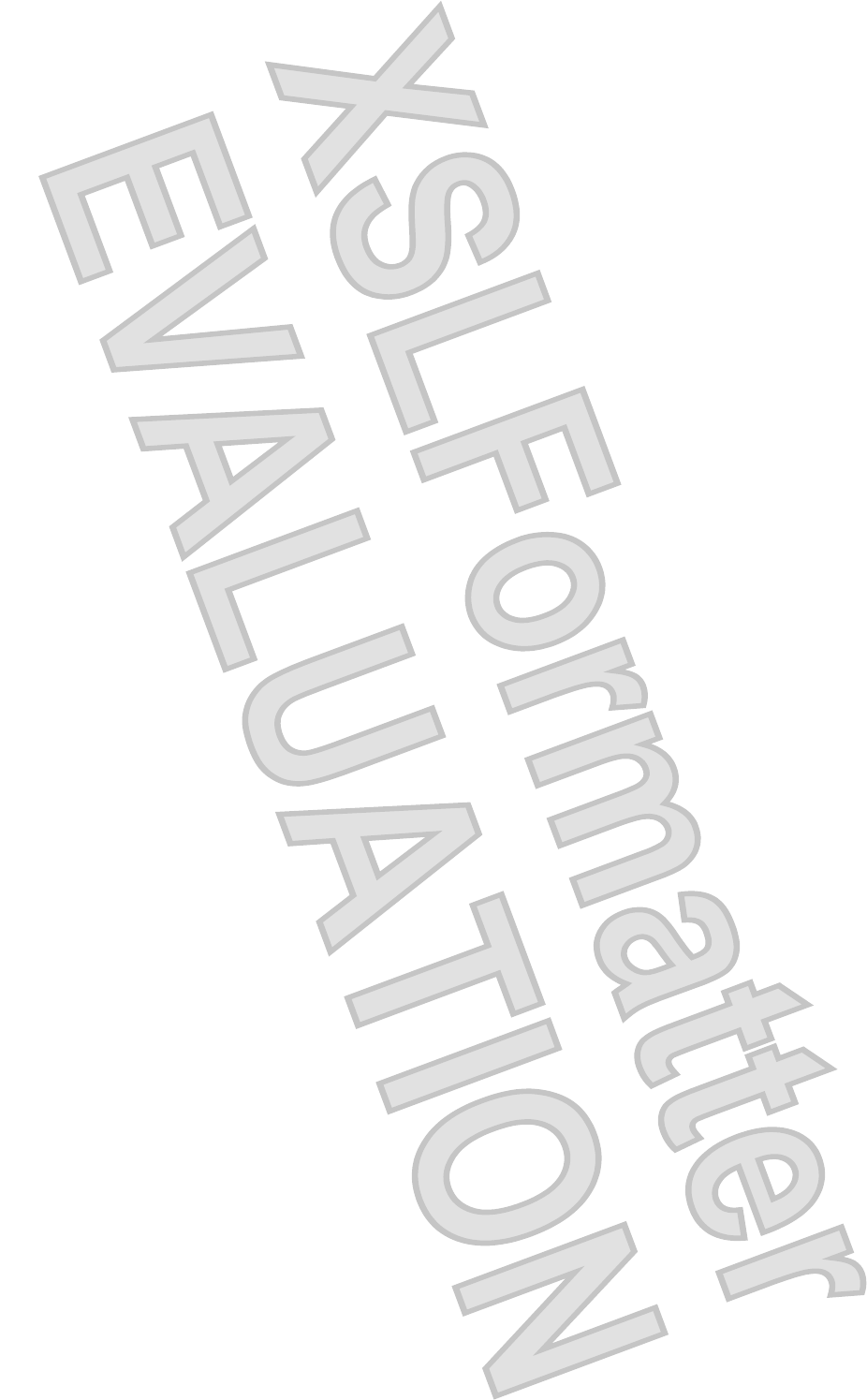
HP ENVY 15 User Guide
Antenna House XSL Formatter (Evaluation) http://www.antennahouse.com/

© Copyright 2009 Hewlett-Packard
Development Company, L.P.
Intel is a trademark of Intel Corporation in the
U.S. and other countries. Microsoft and
Windows are U.S. registered trademarks of
Microsoft Corporation. Bluetooth is a
trademark owned by its proprietor and used
by Hewlett-Packard Company under license.
SD Logo is a trademark of its proprietor.
The information contained herein is subject
to change without notice. The only
warranties for HP products and services are
set forth in the express warranty statements
accompanying such products and services.
Nothing herein should be construed as
constituting an additional warranty. HP shall
not be liable for technical or editorial errors
or omissions contained herein.
Second Edition: December 2009
First Edition: September 2009
Document Part Number: 572050-002
Product notice
This user guide describes features that are
common to most models. Some features
may not be available on your computer.
Antenna House XSL Formatter (Evaluation) http://www.antennahouse.com/
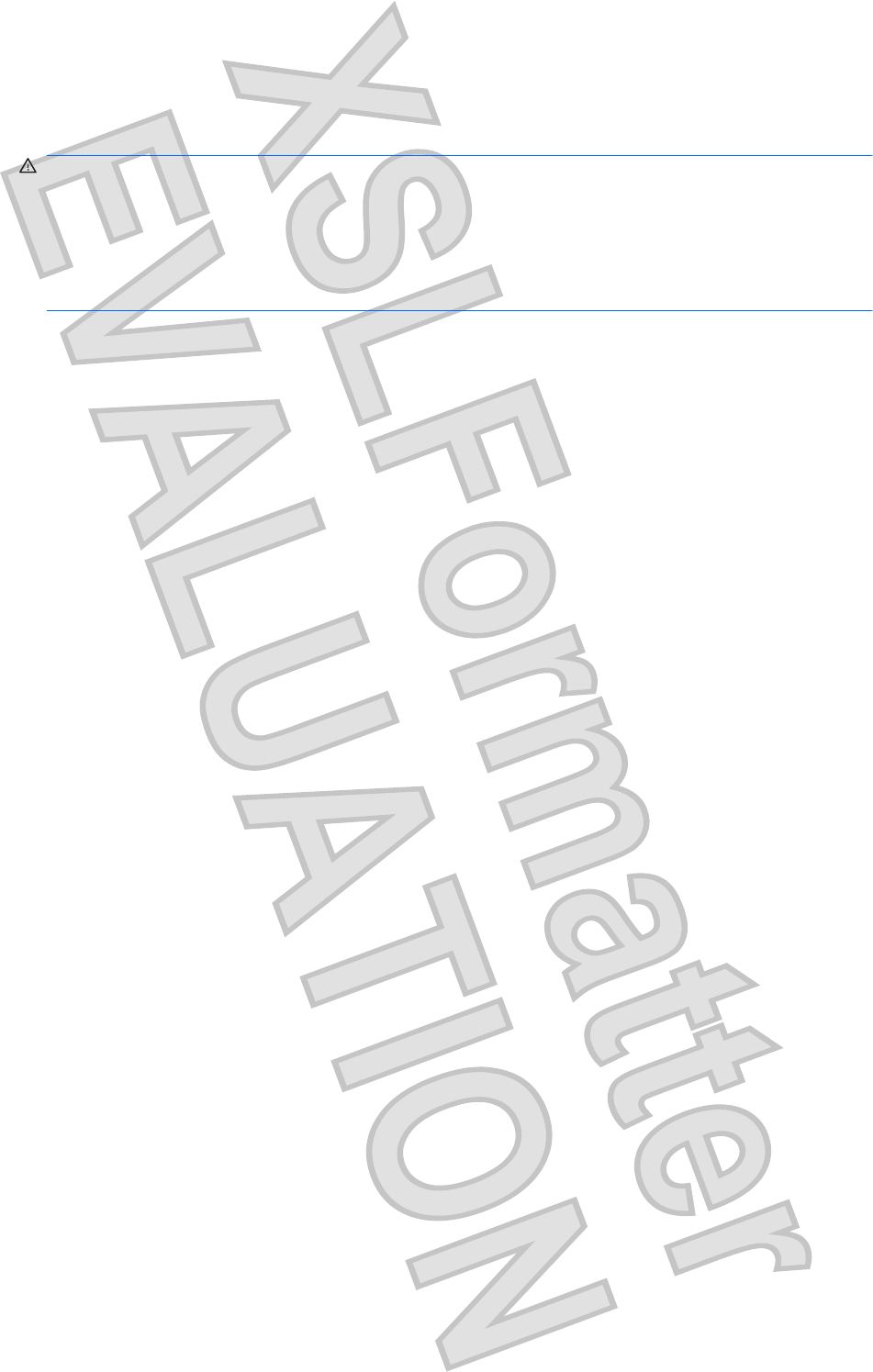
Safety warning notice
WARNING! To reduce the possibility of heat-related injuries or of overheating the computer, do not
place the computer directly on your lap or obstruct the computer air vents. Use the computer only on a
hard, flat surface. Do not allow another hard surface, such as an adjoining optional printer, or a soft
surface, such as pillows or rugs or clothing, to block airflow. Also, do not allow the AC adapter to contact
the skin or a soft surface, such as pillows or rugs or clothing, during operation. The computer and the
AC adapter comply with the user-accessible surface temperature limits defined by the International
Standard for Safety of Information Technology Equipment (IEC 60950).
iii
Antenna House XSL Formatter (Evaluation) http://www.antennahouse.com/

iv Safety warning notice
Antenna House XSL Formatter (Evaluation) http://www.antennahouse.com/

Table of contents
1 Notebook tour
Identifying hardware ............................................................................................................................. 2
Components ......................................................................................................................................... 3
Top components .................................................................................................................. 3
TouchPad ............................................................................................................ 3
TouchPad buttons ............................................................................................... 3
Lights ................................................................................................................... 4
Button ................................................................................................................. 5
Keys .................................................................................................................... 6
Front components ................................................................................................................ 7
Right-side components ........................................................................................................ 7
Left-side components .......................................................................................................... 8
Bottom components ............................................................................................................. 9
Display components .......................................................................................................... 10
Wireless antennas ............................................................................................................. 10
Additional hardware components ...................................................................................... 11
Labels ................................................................................................................................................. 12
2 Using HP QuickWeb software (select models only)
3 Wireless and local area network
Using wireless devices ....................................................................................................................... 15
Identifying wireless and network status icons .................................................................... 15
Using the wireless controls ................................................................................................ 16
Using the wireless key ....................................................................................................... 16
Using Wireless Assistant software ..................................................................................... 17
Using operating system controls ........................................................................................ 17
Using a WLAN .................................................................................................................................... 18
Setting up a WLAN ............................................................................................................ 18
Protecting your WLAN ....................................................................................................... 18
Connecting to a WLAN ...................................................................................................... 19
Roaming to another network .............................................................................................. 20
Using Bluetooth wireless devices ....................................................................................................... 21
Bluetooth and Internet Connection Sharing (ICS) ............................................................. 21
v
Antenna House XSL Formatter (Evaluation) http://www.antennahouse.com/

Troubleshooting wireless connection problems ................................................................................. 22
Cannot connect to a preferred network ............................................................................. 22
Network icon for WLAN is not displayed ............................................................................ 22
Current WLAN network security codes are unavailable .................................................... 22
WLAN connection is very weak ......................................................................................... 23
Cannot connect to the wireless router ............................................................................... 23
Connecting to a local area network (LAN) .......................................................................................... 24
4 Pointing devices and keyboard
Using pointing devices ....................................................................................................................... 26
Setting pointing device preferences ................................................................................... 26
Using the TouchPad .......................................................................................................... 26
Using TouchPad gestures ................................................................................. 26
Scrolling ............................................................................................ 26
Pinching ............................................................................................ 27
Rotating ............................................................................................ 27
Using the action keys ......................................................................................................................... 29
Using the hotkeys ............................................................................................................................... 31
Cleaning the TouchPad and keyboard ............................................................................................... 32
5 Multimedia
Multimedia features ............................................................................................................................ 34
Adjusting the volume ......................................................................................................... 34
Using the media activity keys ............................................................................................ 34
Multimedia software ........................................................................................................................... 36
Using HP MediaSmart software ......................................................................................... 36
Using multimedia software ................................................................................................. 36
Installing multimedia software from a disc ......................................................................... 37
Audio .................................................................................................................................................. 38
Connecting external audio devices .................................................................................... 38
Checking your audio functions ........................................................................................... 38
Using Beats Audio ............................................................................................................. 39
Identifying Beats Audio icons ............................................................................ 40
Video .................................................................................................................................................. 41
Connecting an external monitor or projector ..................................................................... 41
Connecting an HDMI device .............................................................................................. 42
Configuring audio for HDMI ............................................................................... 43
Webcam ............................................................................................................................................. 44
Webcam tips ...................................................................................................................... 44
Adjusting webcam properties ............................................................................................. 44
Using the ambient light sensor .......................................................................................................... 46
Using adaptive brightness ................................................................................................. 46
Using the webcam IR light ................................................................................................. 46
vi
Antenna House XSL Formatter (Evaluation) http://www.antennahouse.com/

6 Power management
Setting power devices ........................................................................................................................ 49
Using power-saving states ................................................................................................. 49
Initiating and exiting Sleep ................................................................................ 49
Initiating and exiting Hibernation ....................................................................... 49
Conserving power .............................................................................................................. 50
Using the battery meter ..................................................................................................... 50
Using power plans ............................................................................................................. 51
Viewing the current power plan ......................................................................... 51
Selecting a different power plan ........................................................................ 51
Customizing power plans .................................................................................. 51
Setting password protection on wakeup ............................................................................ 51
Using external AC power .................................................................................................................... 52
Connecting AC power ........................................................................................................ 52
Testing an AC adapter ....................................................................................................... 53
Using battery power ........................................................................................................................... 54
Identifying batteries ............................................................................................................ 54
Finding battery information in Help and Support ............................................................... 54
Using Battery Check .......................................................................................................... 54
Displaying the remaining battery charge ........................................................................... 55
Removing or inserting the primary battery ......................................................................... 55
Charging a battery ............................................................................................................. 56
Maximizing battery discharge time .................................................................................... 57
Managing low battery levels .............................................................................................. 57
Identifying low battery levels ............................................................................. 57
Resolving a low battery level ............................................................................. 58
Resolving a low battery level when external power is available ....... 58
Resolving a low battery level when a charged battery is
available ........................................................................................... 58
Resolving a low battery level when no power source is
available ........................................................................................... 58
Resolving a low battery level when the computer cannot exit
Hibernation ....................................................................................... 58
Using the accessory battery (select models only) ............................................................. 58
Identifying the accessory battery components .................................................. 59
Inserting or removing an accessory battery ...................................................... 59
Battery charging and discharging sequence .................................................... 61
Calibrating a battery ........................................................................................................... 61
Storing a battery ................................................................................................................ 62
Disposing of a used battery ............................................................................................... 62
Replacing the battery ......................................................................................................... 62
Shutting down the computer ............................................................................................................... 63
vii
Antenna House XSL Formatter (Evaluation) http://www.antennahouse.com/

7 Drives and external devices
Drives ................................................................................................................................................. 65
Identifying installed drives .................................................................................................. 65
Handling drives .................................................................................................................. 65
Improving hard drive performance ..................................................................................... 65
Using Disk Defragmenter .................................................................................. 65
Using Disk Cleanup ........................................................................................... 66
Using HP ProtectSmart Hard Drive Protection (select models only) ................................. 66
Identifying HP ProtectSmart Hard Drive Protection status ................................ 66
Managing power with a parked hard drive ........................................................ 67
Using HP ProtectSmart Hard Drive Protection software ................................... 67
Using external drives ......................................................................................................... 68
Connecting optional external drives .................................................................. 68
Using the external optical drive (select models only) ......................................................... 68
Removing an optical disc when the disc tray will not open ............................... 69
Sharing optical drives ........................................................................................................ 69
External devices ................................................................................................................................. 71
Using a USB device ........................................................................................................... 71
Connecting a USB device ................................................................................. 71
Removing a USB device ................................................................................... 71
Using an eSATA device ..................................................................................................... 72
Connecting an eSATA device ........................................................................... 72
Removing an eSATA device ............................................................................. 72
Using Digital Media Slot cards ........................................................................................... 73
Inserting a digital card ....................................................................................... 73
Removing a digital card ..................................................................................... 74
8 Memory modules
Adding or replacing a memory module in single-slot models ............................................................. 76
Adding or replacing a memory module in double-slot models ............................................................ 79
9 Security
Protecting the computer ..................................................................................................................... 84
Using passwords ................................................................................................................................ 85
Setting passwords in Windows .......................................................................................... 85
Setting passwords in Setup Utility ..................................................................................... 86
Administrator password ..................................................................................... 86
Managing an administrator password ............................................... 87
Entering an administrator password ................................................. 87
Power-on password .......................................................................................... 87
Managing a power-on password ...................................................... 88
Entering a power-on password ......................................................... 88
Using antivirus software ..................................................................................................................... 89
viii
Antenna House XSL Formatter (Evaluation) http://www.antennahouse.com/

Using firewall software ....................................................................................................................... 90
Installing critical security updates ....................................................................................................... 91
Installing an optional security cable .................................................................................................... 92
Appendix A Setup Utility (BIOS)
Starting Setup Utility ........................................................................................................................... 94
Using Setup Utility .............................................................................................................................. 95
Changing the language of Setup Utility ............................................................................. 95
Navigating and selecting in Setup Utility ............................................................................ 95
Displaying system information ........................................................................................... 96
Restoring default settings in Setup Utility .......................................................................... 96
Exiting Setup Utility ............................................................................................................ 96
Setup Utility menus ............................................................................................................................ 98
Main menu ......................................................................................................................... 98
Security menu .................................................................................................................... 98
System Configuration menu .............................................................................................. 98
Diagnostics menu .............................................................................................................. 99
Updating the BIOS ........................................................................................................................... 100
Updating the BIOS ........................................................................................................... 100
Determining the BIOS version ......................................................................... 100
Downloading a BIOS update ........................................................................... 100
Appendix B Backup and recovery
Creating recovery discs .................................................................................................................... 103
Backing up your information ............................................................................................................. 104
Using Windows Backup and Restore .............................................................................. 104
Using system restore points ............................................................................................ 105
When to create restore points ......................................................................... 105
Create a system restore point ......................................................................... 105
Restore to a previous date and time ............................................................... 105
Performing a recovery ...................................................................................................................... 106
Recovering using the recovery discs ............................................................................... 106
Recovering using the dedicated recovery partition (select models only) ......................... 106
Appendix C RAID 0 (select models only)
Disabling RAID 0 .............................................................................................................................. 108
Index ................................................................................................................................................................. 109
ix
Antenna House XSL Formatter (Evaluation) http://www.antennahouse.com/

x
Antenna House XSL Formatter (Evaluation) http://www.antennahouse.com/

1 Notebook tour
1
Antenna House XSL Formatter (Evaluation) http://www.antennahouse.com/
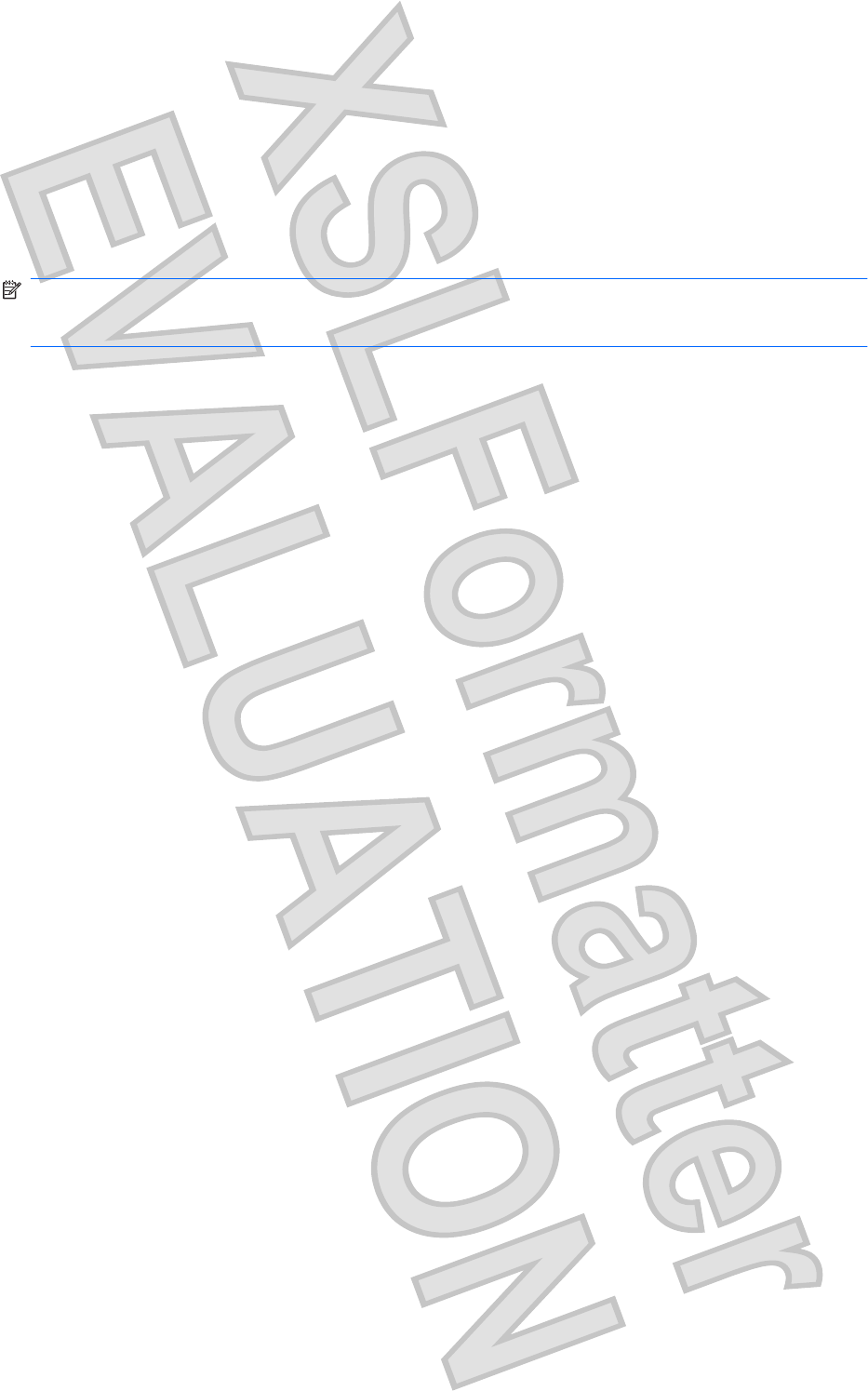
Identifying hardware
To see a list of hardware installed in the computer:
⊡Select Start > Control Panel > System and Security. Then in the System area, click Device
Manager.
You can also add hardware or modify device configurations using Device Manager.
NOTE: Windows® includes the User Account Control feature to improve the security of your computer.
You may be prompted for your permission or password for tasks such as installing applications, running
utilities, or changing Windows settings. Refer to Help and Support for more information.
2 Chapter 1 Notebook tour
Antenna House XSL Formatter (Evaluation) http://www.antennahouse.com/
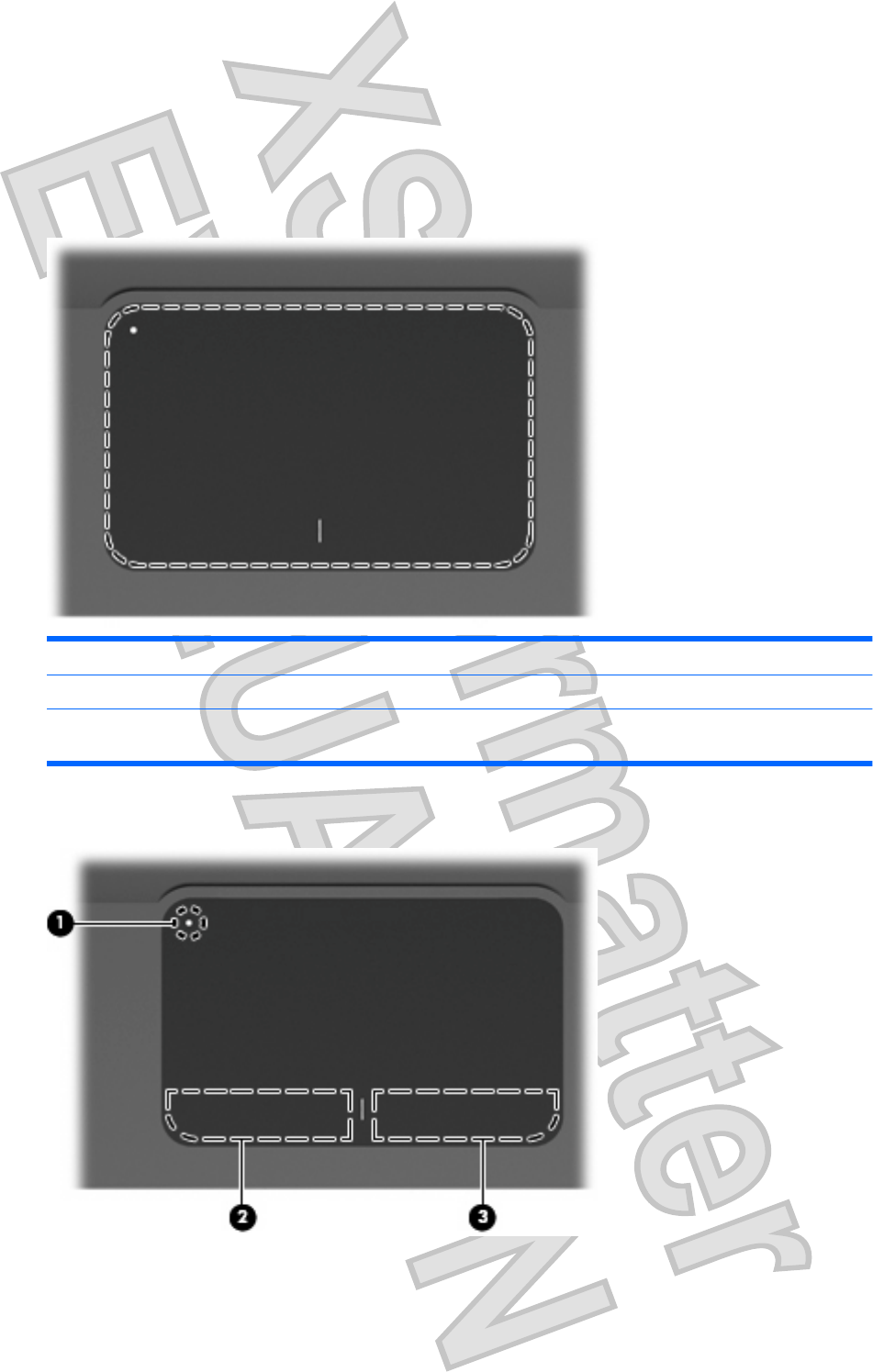
Components
Top components
TouchPad
Component Description
TouchPad* Moves the pointer and selects or activates items on the screen.
*This table describes factory settings. To view and change pointing device preferences, select Start > Devices and Printers.
Then, right-click the device representing your computer, and select Mouse settings.
TouchPad buttons
Components 3
Antenna House XSL Formatter (Evaluation) http://www.antennahouse.com/
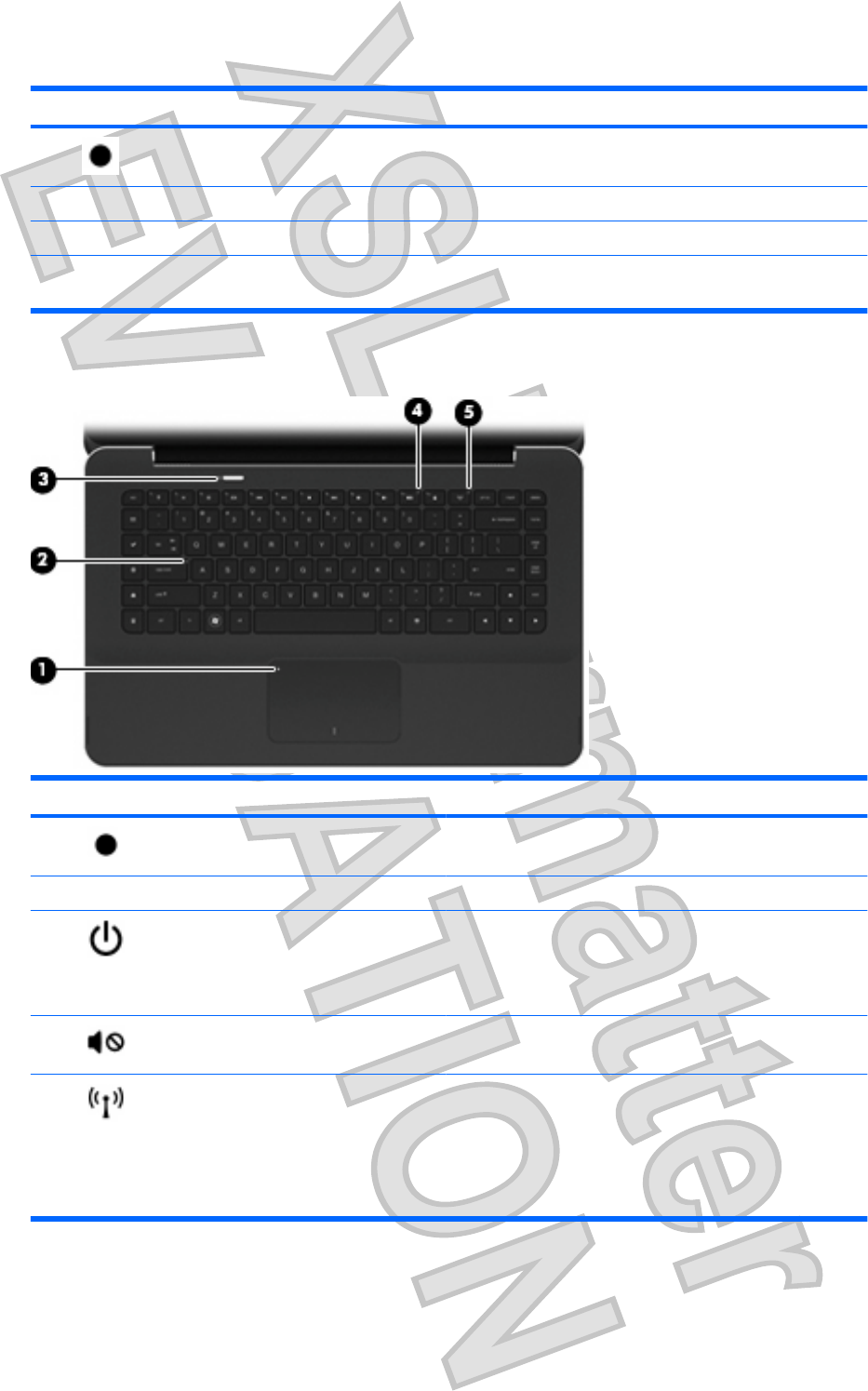
Component Description
(1) TouchPad on/off button Turns the TouchPad on and off. Lightly press the button and hold
for several seconds to turn the TouchPad on and off.
(2) Left TouchPad button* Functions like the left button on an external mouse.
(3) Right TouchPad button* Functions like the right button on an external mouse.
*This table describes factory settings. To view and change pointing device preferences, select Start > Devices and Printers.
Then, right-click the device representing your computer, and select Mouse settings.
Lights
Component Description
(1) TouchPad light Amber: The TouchPad is disabled.
(2) Caps lock light White: Caps lock is on.
(3) Power light łWhite: The computer is on.
łBlinking white: The computer is in the Sleep state.
łOff: The computer is off or in Hibernation.
(4) Mute light Amber: Computer sound is off.
(5) Wireless light łOff: An integrated wireless device, such as a wireless local
area network (WLAN) device and/or a Bluetooth® device,
is on.
NOTE: Wireless devices are enabled at the factory.
łAmber: All wireless devices are off.
4 Chapter 1 Notebook tour
Antenna House XSL Formatter (Evaluation) http://www.antennahouse.com/
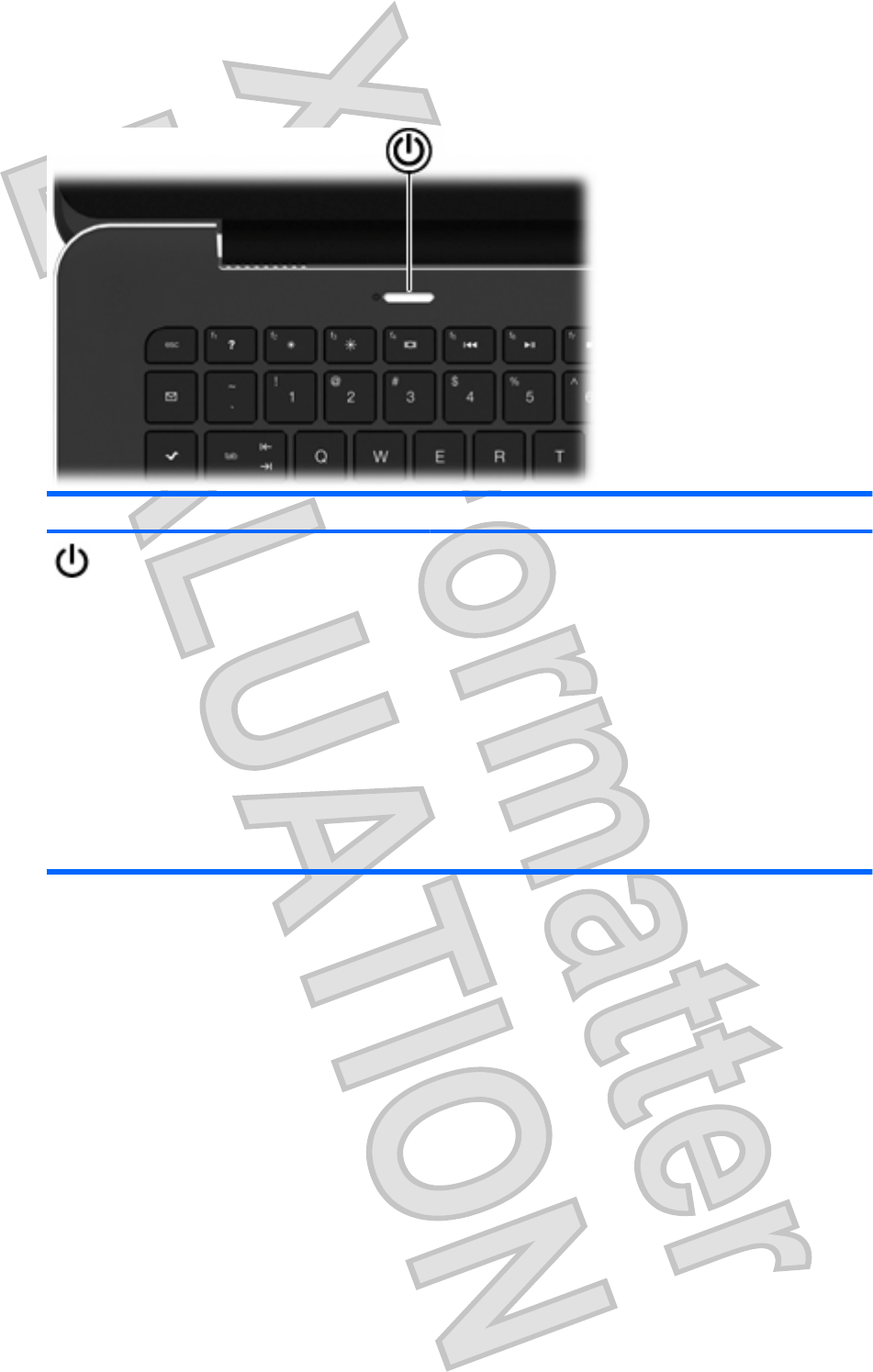
Button
Component Description
Power button łWhen the computer is off, press the button to turn on the
computer.
łWhen the computer is on, press the button briefly to initiate
Sleep.
łWhen the computer is in the Sleep state, press the button
briefly to exit Sleep.
łWhen the computer is in Hibernation, press the button briefly
to exit Hibernation.
If the computer has stopped responding and Windows® shutdown
procedures are ineffective, press and hold the power button for at
least 5 seconds to turn off the computer.
To learn more about your power settings, select Start > Control
Panel > System and Security > Power Options.
Components 5
Antenna House XSL Formatter (Evaluation) http://www.antennahouse.com/
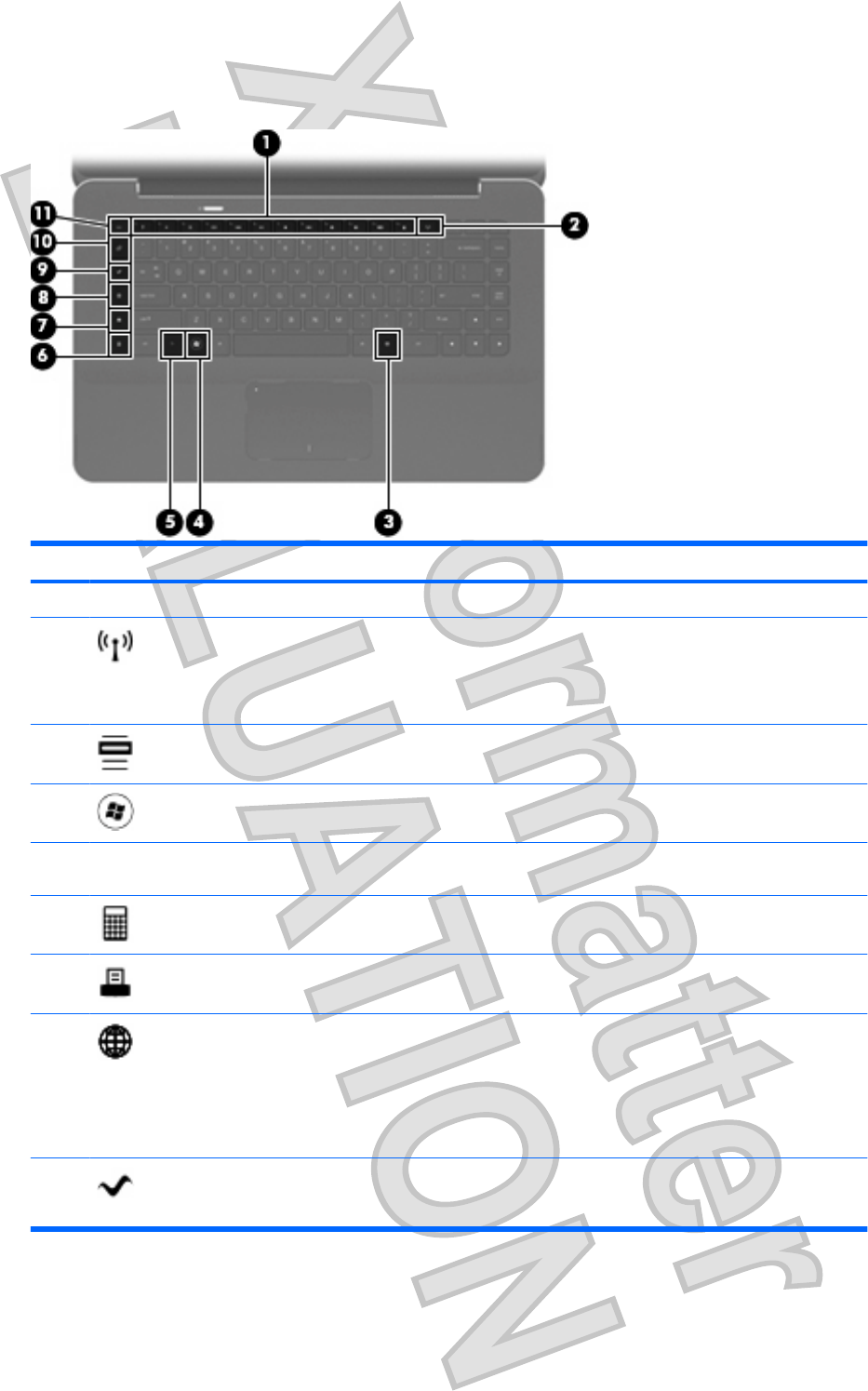
Keys
Component Description
(1) Action keys Execute frequently used system functions.
(2) wireless key Turns the wireless feature on or off.
NOTE: This key does not establish a wireless connection. To
establish a wireless connection, a wireless network must also be
set up.
(3) Windows application key Displays a shortcut menu for items beneath the cursor.
(4) Windows logo key Displays the Windows Start menu.
(5) fn key Executes frequently used system functions when pressed in
combination with a function key or the esc key.
(6) calculator key Opens the Windows calculator function.
(7) print options key Opens the Print Options window of the active Windows
application.
(8) Web key Opens a Web browser.
NOTE: Until you have set up your Internet or network services,
the Web key opens the Windows Internet Connection Wizard. After
you have set up your Internet or network services and your Web
browser home page, you can press the Web key to quickly access
your home page and the Internet.
(9) Media Launch key Opens HP MediaSmart. HP MediaSmart turns your computer into
a mobile entertainment center. You can enjoy music and movies
and manage and edit your photo collections.
6 Chapter 1 Notebook tour
Antenna House XSL Formatter (Evaluation) http://www.antennahouse.com/
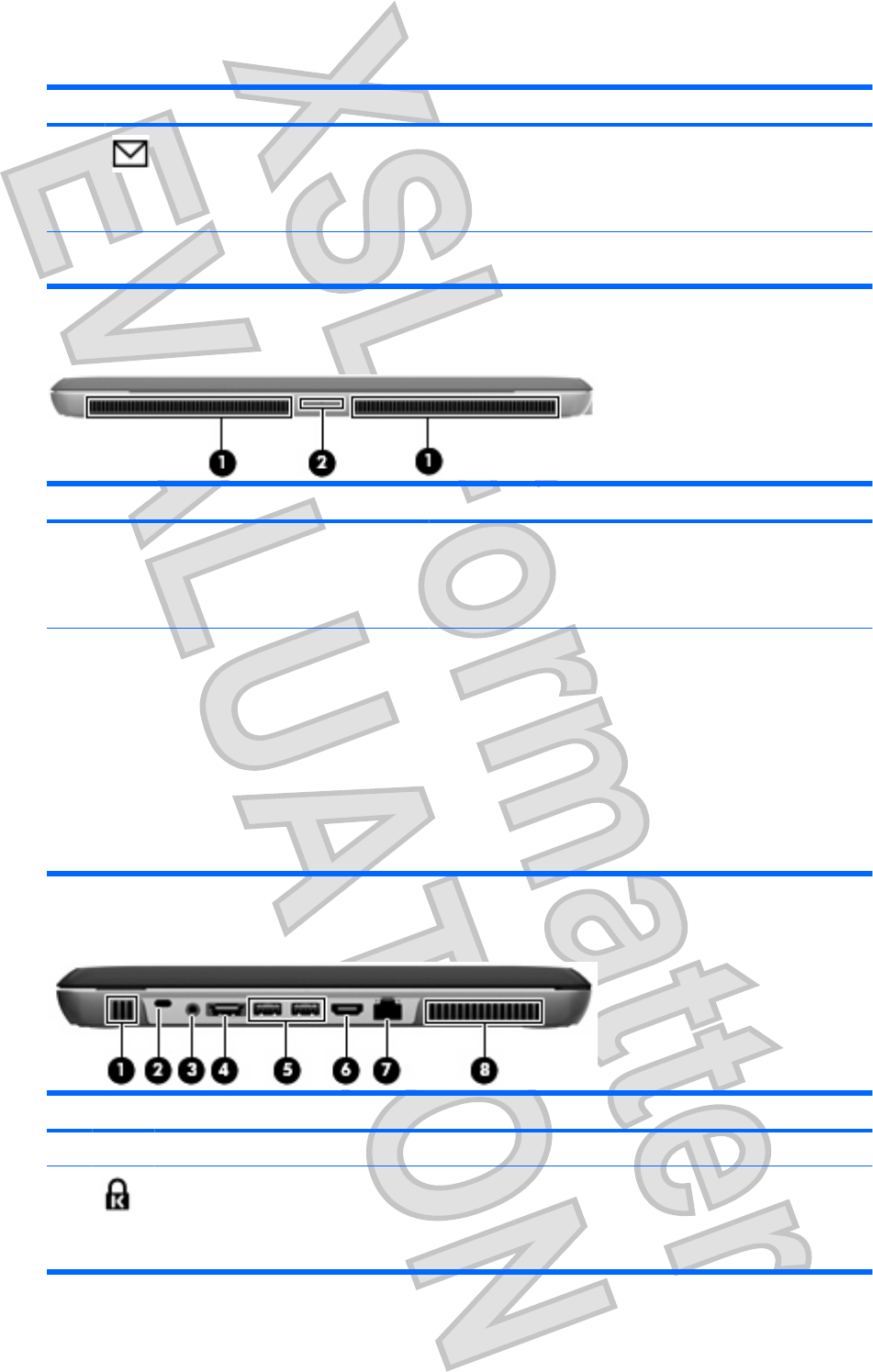
Component Description
(10) mail key Opens your default e-mail program.
NOTE: The first time you press the mail key, you may be
prompted to set up your e-mail account. After you have set up your
e-mail, you can press the mail key to quickly access your e-mail.
(11) esc key Displays system information when pressed in combination with the
fn key.
Front components
Component Description
(1) Vents (2) Enables airflow to cool internal components.
NOTE: The computer fan starts up automatically to cool internal
components and prevent overheating. It is normal for the internal
fan to cycle on and off during routine operation.
(2) Digital Media Slot Supports the following digital card formats:
łMultiMediaCard
łMicro MultiMediaCard (adapter required)
łMultiMediaCard Plus
łSecure Digital Memory Card
łMicro Secure Digital Memory Card (adapter required)
łSecure Digital High Capacity Memory Card
Right-side components
Component Description
(1) Speaker Produces sound.
(2) Security cable slot Attaches an optional security cable to the computer.
NOTE: The security cable is designed to act as a deterrent,
but it may not prevent the computer from being mishandled or
stolen.
Components 7
Antenna House XSL Formatter (Evaluation) http://www.antennahouse.com/
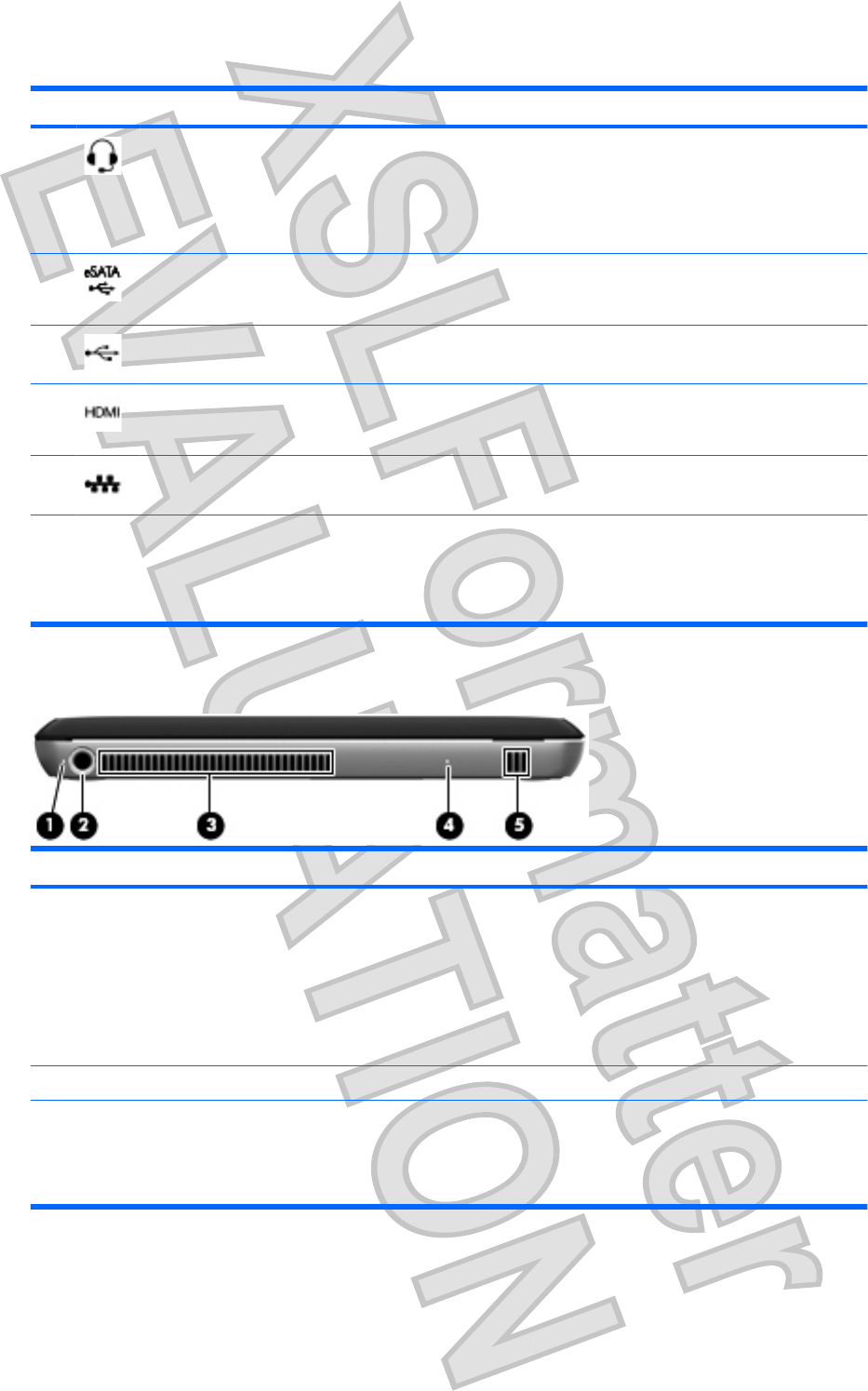
Component Description
(3) Audio-out (headphone) jack/Audio-in
(microphone) jack
Produces sound when connected to optional powered stereo
speakers, headphones, earbuds, a headset, or television
audio. Also connects an optional headset microphone.
NOTE: When a device is connected to the jack, the device
speakers are disabled.
(4) eSATA/USB port Connects a high-performance eSATA component, such as an
eSATA external hard drive, or connects an optional USB
device.
(5) USB ports (2) Connect optional USB devices.
(6) HDMI port Connects an optional video or audio device, such as a high-
definition television, or any compatible digital or audio
component.
(7) RJ-45 (network) jack Connects a network cable.
(8) Vent Enables airflow to cool internal components.
NOTE: The computer fan starts up automatically to cool
internal components and prevent overheating. It is normal for
the internal fan to cycle on and off during routine operation.
Left-side components
Component Description
(1) Battery light łOff: The computer is running on battery power.
łBlinking amber: The battery has reached a low battery level,
a critical battery level, or there is a battery error.
łAmber: A battery is charging.
łWhite: The computer is connected to external power and the
battery is fully charged.
(2) Power connector Connects an AC adapter.
(3) Vent Enables airflow to cool internal components.
NOTE: The computer fan starts up automatically to cool internal
components and prevent overheating. It is normal for the internal
fan to cycle on and off during routine operation.
8 Chapter 1 Notebook tour
Antenna House XSL Formatter (Evaluation) http://www.antennahouse.com/
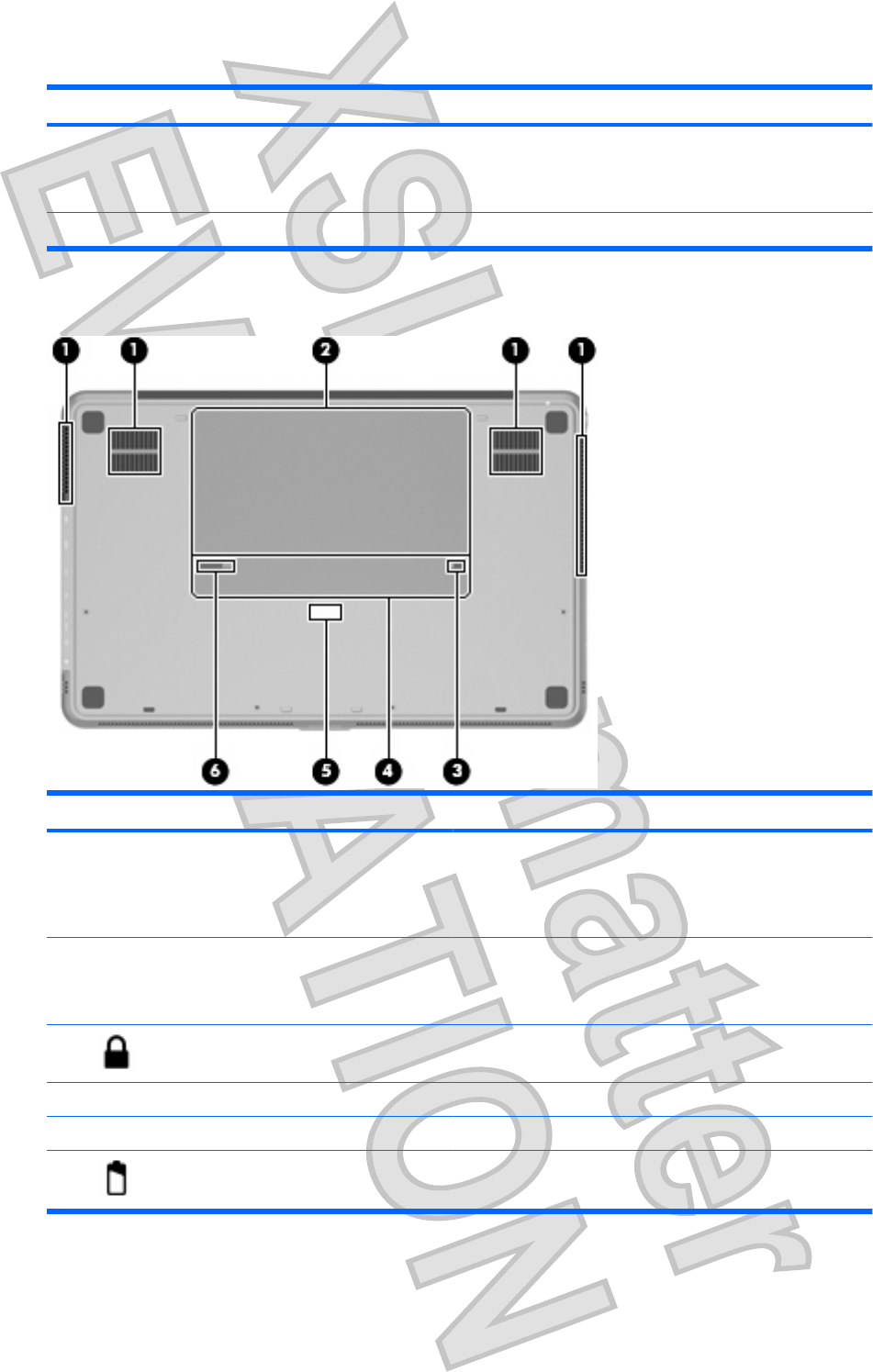
Component Description
(4) Drive light łBlinking white: The hard drive is being accessed.
łAmber (select models only): HP ProtectSmart Hard Drive
Protection has temporarily parked the hard drive.
(5) Speaker Produces sound.
Bottom components
Component Description
(1) Vents (4) Enable airflow to cool internal components.
NOTE: The computer fan starts up automatically to cool
internal components and prevent overheating. It is normal for
the internal fan to cycle on and off during routine operation.
(2) Battery bay Holds the primary battery.
NOTE: The primary battery is preinstalled in the battery bay
at the factory.
(3) Battery lock Locks the primary battery inside the battery bay.
(4) Memory module compartment Holds the memory modules.
(5) Accessory battery connector Connects an optional accessory battery.
(6) Battery release latch Releases the primary battery from the battery bay.
Components 9
Antenna House XSL Formatter (Evaluation) http://www.antennahouse.com/
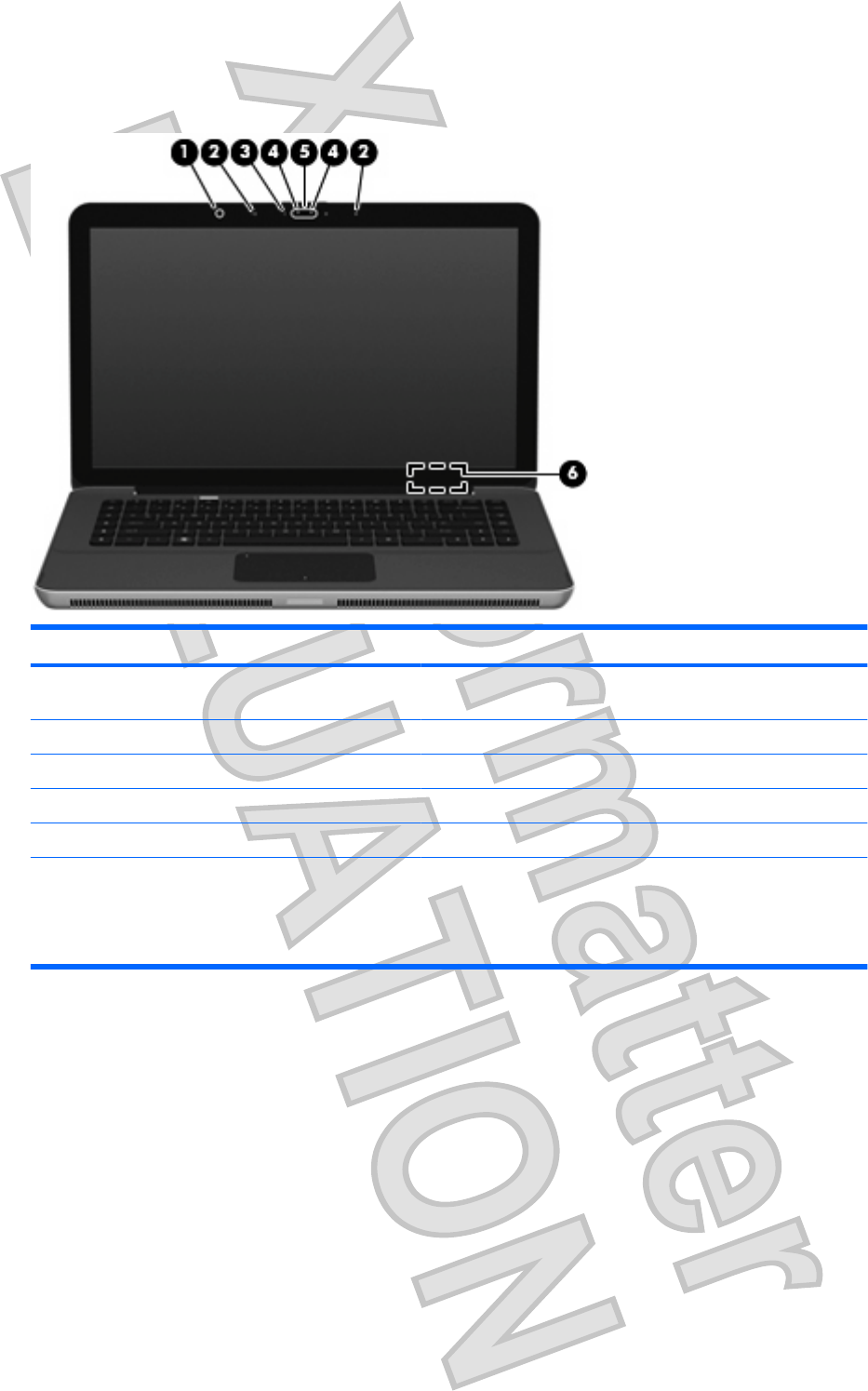
Display components
Component Description
(1) Ambient light sensor Adjusts the screen brightness levels automatically, based on
surrounding lighting conditions.
(2) Internal microphones (2) Record sound.
(3) Webcam light On: The webcam is in use.
(4) Webcam infrared (IR) light Improves the webcam picture quality in low-light conditions.
(5) Webcam Records video and captures still photographs.
(6) Internal display switch Turns off the display and initiates Sleep if the display is closed while
the power is on.
NOTE: The internal display switch is not visible from the outside
of the computer.
Wireless antennas
The computer has 2 antennas that send and receive signals from one or more wireless devices. These
antennas are not visible from the outside of the computer.
10 Chapter 1 Notebook tour
Antenna House XSL Formatter (Evaluation) http://www.antennahouse.com/
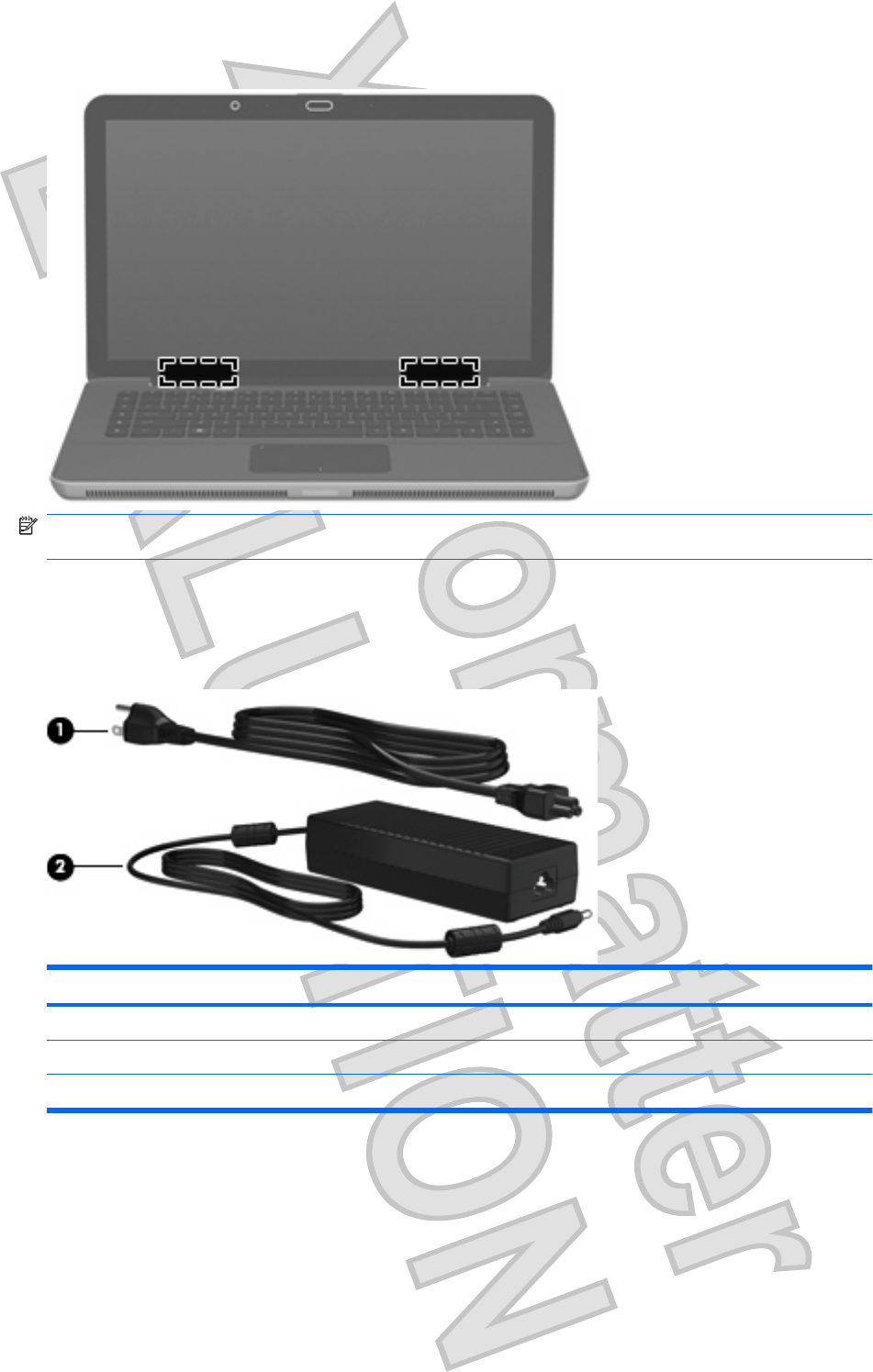
NOTE: For optimal transmission, keep the areas immediately around the antennas free from
obstructions.
To see wireless regulatory notices, refer to the section of the Regulatory, Safety and Environmental
Notices that applies to your country or region. These notices are located in Help and Support.
Additional hardware components
Component Description
(1) Power cord* Connects the AC adapter.
(2) AC adapter Converts AC power to DC power.
*Power cords vary in appearance by region and country.
Components 11
Antenna House XSL Formatter (Evaluation) http://www.antennahouse.com/
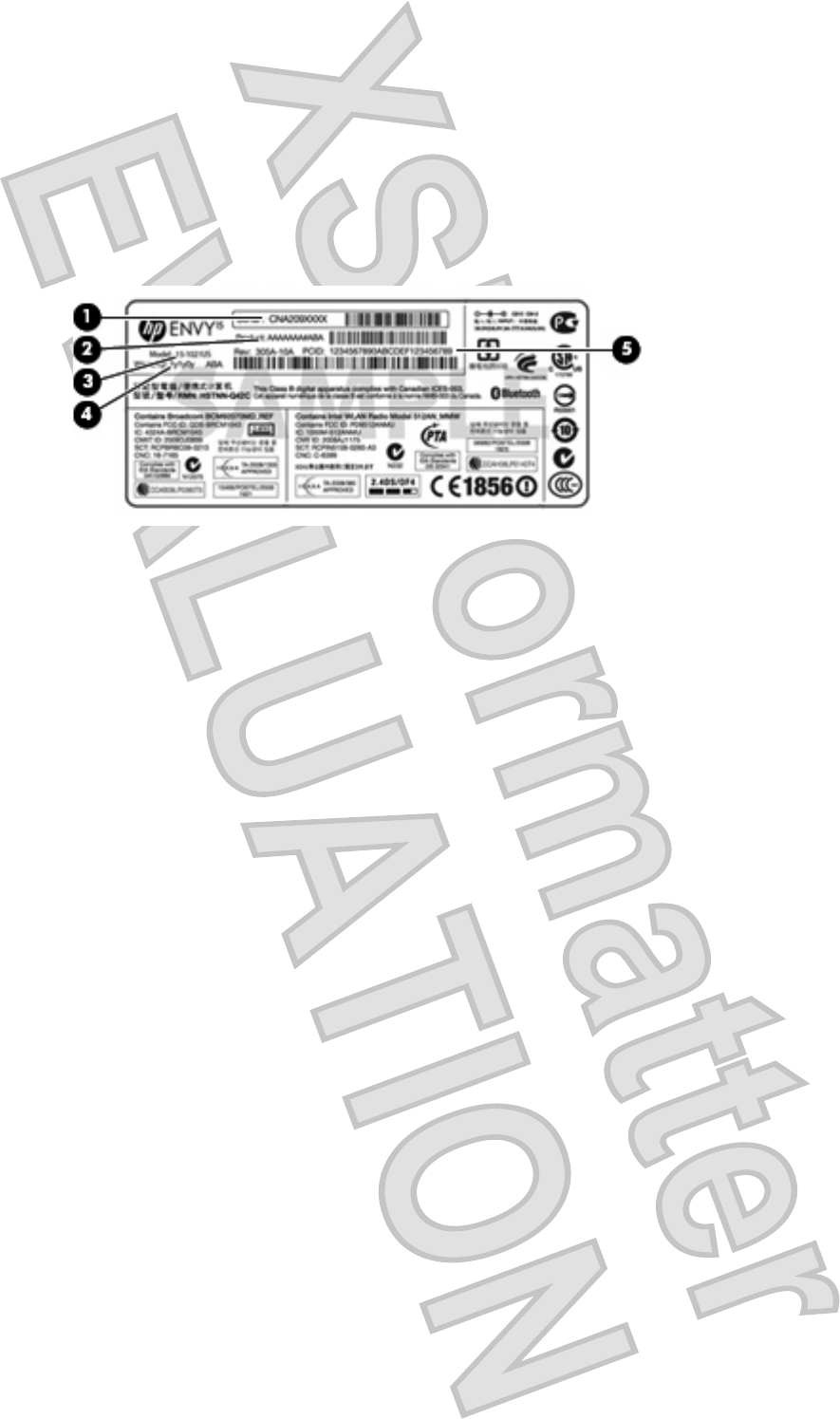
Labels
The labels affixed to the computer provide information you may need when you troubleshoot system
problems or travel internationally with the computer.
łService tag—Provides important information including the following:
The service tag is located inside the battery bay.
ŃSerial number (s/n) (1). This is an alphanumeric identifier that is unique to each product.
ŃProduct name (2). This is the product name affixed to the front of your notebook.
ŃModel description (3). This is the alphanumeric identifier you use to locate documents, drivers,
and support for your notebook.
ŃWarranty period (4). This number describes the duration (in years) of the warranty period for
this computer.
ŃPart number/Product number (p/n) (5). This number provides specific information about the
product's hardware components. The part number helps a service technician to determine
what components and parts are needed.
Have this information available when you contact technical support.
łMicrosoft® Certificate of Authenticity—Contains the Windows® Product Key. You may need the
Product Key to update or troubleshoot the operating system. This certificate is affixed to the bottom
of the computer.
łRegulatory label—Provides regulatory information about the computer. The regulatory label is
affixed inside the battery bay.
łWireless certification label(s)—Provide information about optional wireless devices and the
approval markings of some of the countries or regions in which the devices have been approved
for use. An optional device may be a wireless local area network (WLAN) device or an optional
Bluetooth® device. If your computer model includes one or more wireless devices, one or more
certification labels are included with your computer. You may need this information when traveling
internationally. Wireless certification labels are affixed inside the battery bay.
12 Chapter 1 Notebook tour
Antenna House XSL Formatter (Evaluation) http://www.antennahouse.com/
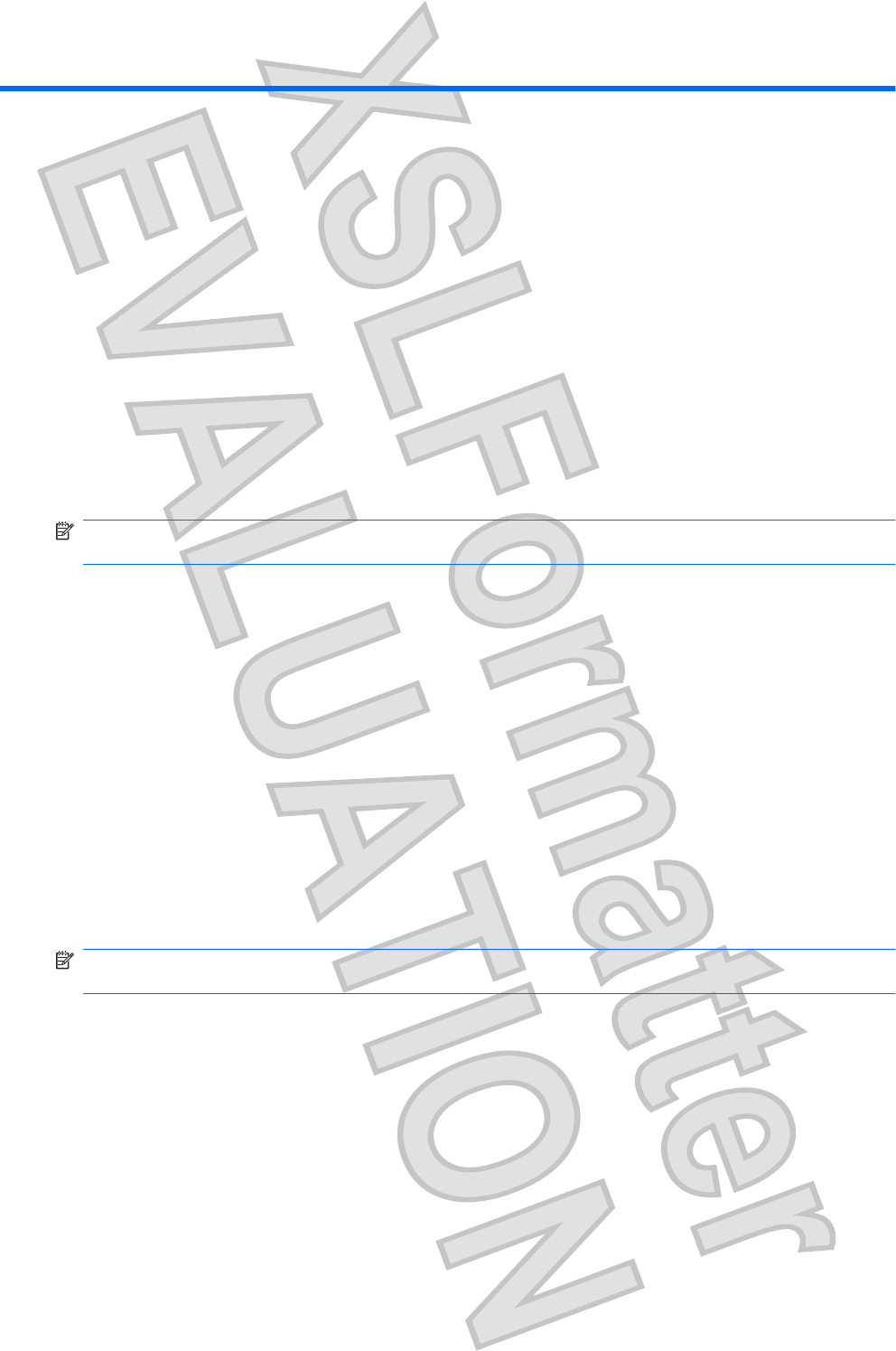
2 Using HP QuickWeb software (select
models only)
HP QuickWeb software is an optional, instant-on environment that is separate from the Windows
operating system. This allows you to rapidly access certain applications without the need to start the
operating system. You will enjoy this feature if you browse the Internet, view and send e-mail, view digital
photos, listen to music, or keep in touch through instant messages or Skype. QuickWeb is ready to go
within seconds of pressing the power button.
NOTE: On computers with two solid-state drives (SSDs), QuickWeb is supported on select models
only.
QuickWeb includes the following features:
łWeb browser—Search and browse the Internet and create links to your favorite Web sites.
łMusic player—Listen to your favorite music and create playlists.
łPhoto viewer—Browse through photos, create albums, and view slide shows.
łSkype—Skype is a voice-over-Internet protocol (VoIP) that lets you communicate free of charge
with other Skype users. With Skype, you can have a conference call or a video chat with one or
more people at a time. You can also make long-distance phone calls to land lines.
łChat—Chat with friends on multiple Instant Messaging programs, such as AOL Instant Messenger,
Google Talk, MSN, Windows Live! Messenger, or Yahoo Messenger.
łWeb calendar—Display, edit, and organize your schedule.
łWeb mail—View and send e-mail.
NOTE: For information on using QuickWeb, refer to the HP ENVY 15 User Manual. This guide is
located on the Secure Digital (SD) Memory Card that came with your computer.
13
Antenna House XSL Formatter (Evaluation) http://www.antennahouse.com/
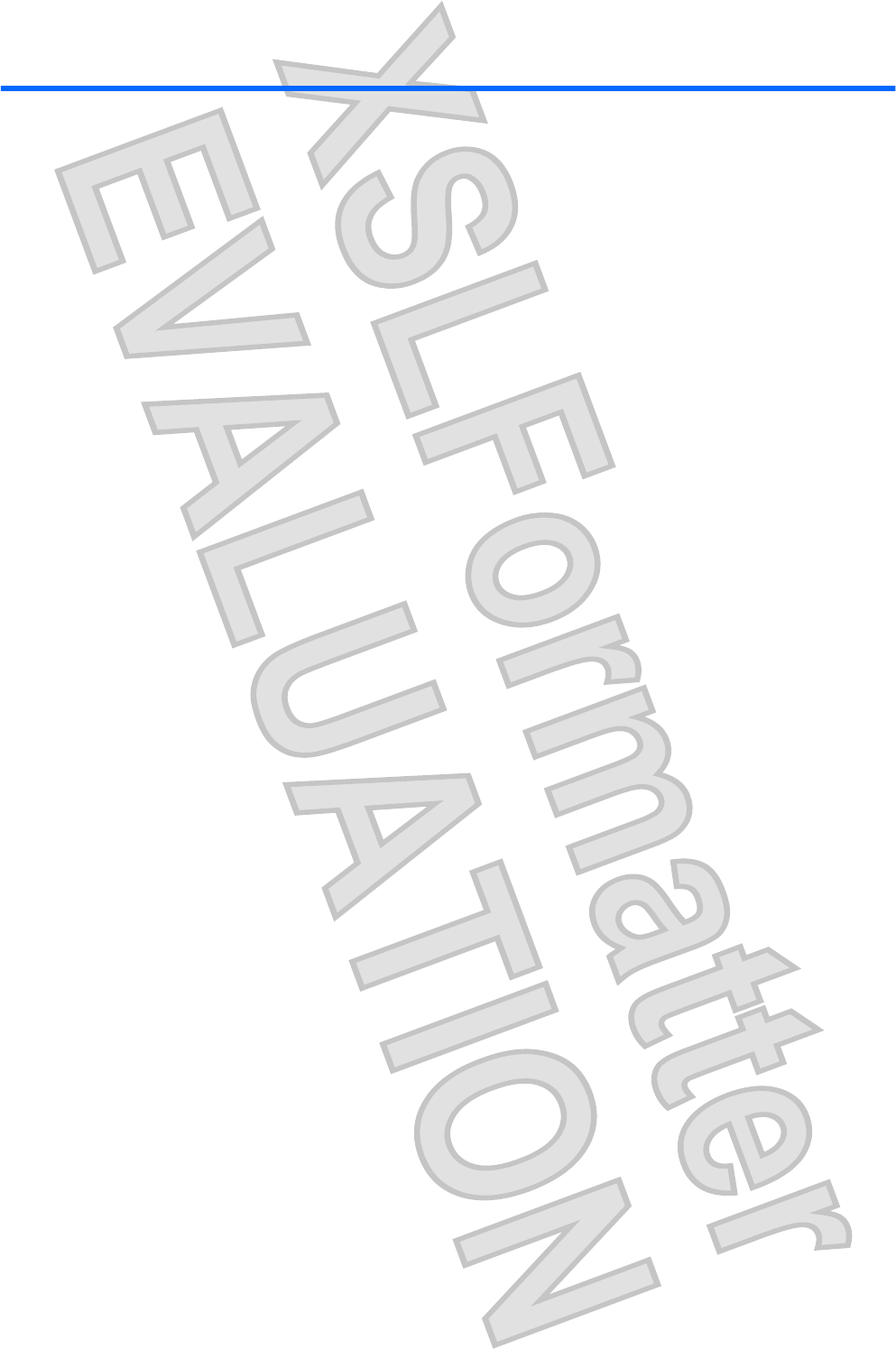
3 Wireless and local area network
14 Chapter 3 Wireless and local area network
Antenna House XSL Formatter (Evaluation) http://www.antennahouse.com/
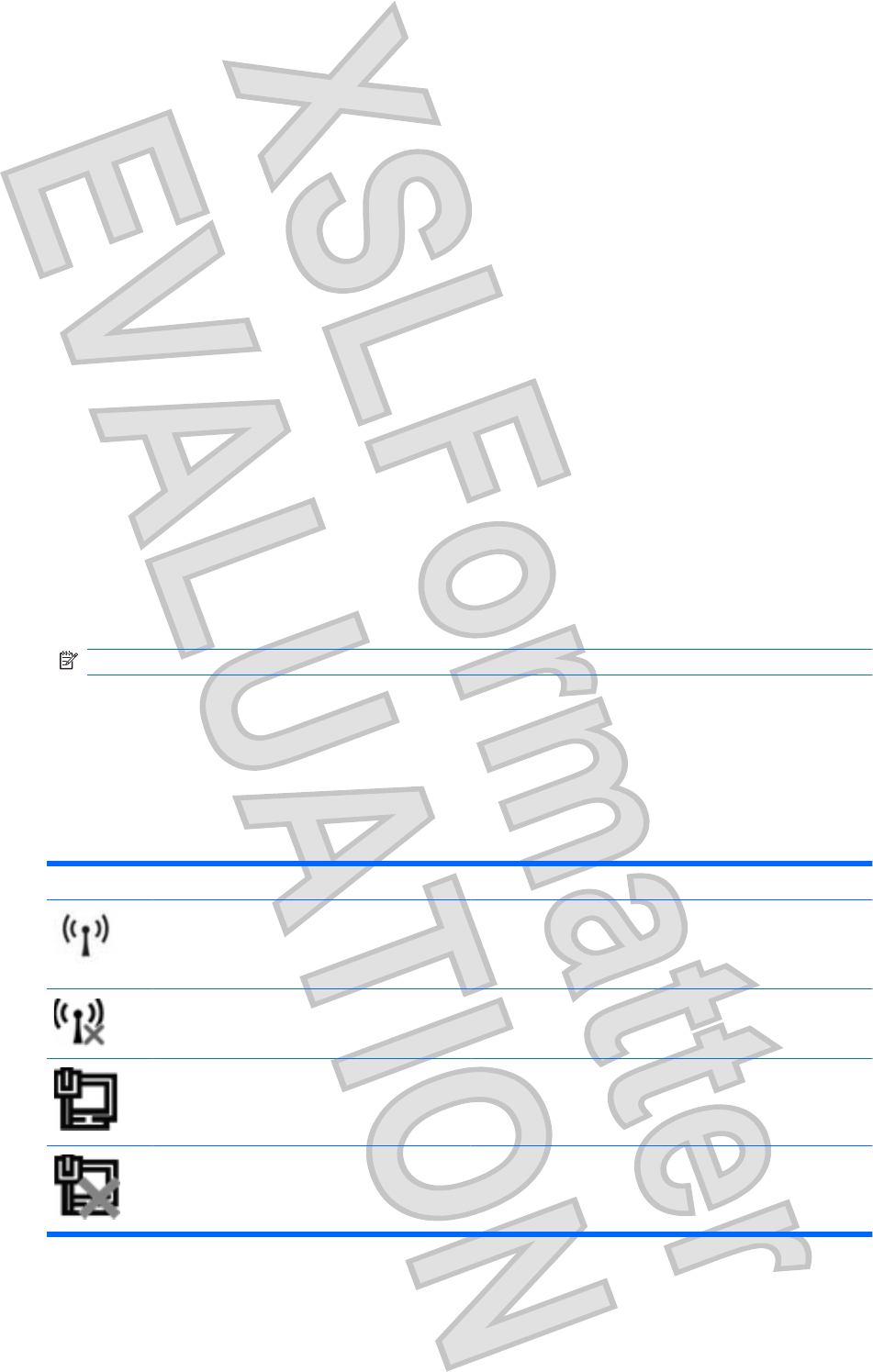
Using wireless devices
Wireless technology transfers data across radio waves instead of wires. Your computer may be
equipped with one or more of the following wireless devices:
łWireless local area network (WLAN) device—Connects the computer to wireless local area
networks (commonly referred to as Wi-Fi networks, wireless LANs, or WLANs) in corporate offices,
your home, and public places such as airports, restaurants, coffee shops, hotels, and universities.
In a WLAN, each mobile wireless device communicates with a wireless router or a wireless access
point.
łBluetooth® device—Creates a personal area network (PAN) to connect to other Bluetooth-enabled
devices such as computers, phones, printers, headsets, speakers, and cameras. In a PAN, each
device communicates directly with other devices, and devices must be relatively close together—
typically within 10 meters (approximately 33 feet) of each other.
Computers with WLAN devices support one or more of the following IEEE industry standards:
ł802.11b, the first popular standard, supports data rates of up to 11 Mbps and operates at a
frequency of 2.4 GHz.
ł802.11g supports data rates of up to 54 Mbps and operates at a frequency of 2.4 GHz. An 802.11g
WLAN device is backward compatible with 802.11b devices, so they can operate on the same
network.
ł802.11a supports data rates of up to 54 Mbps and operates at a frequency of 5 GHz.
NOTE: 802.11a is not compatible with 802.11b and 802.11g.
ł802.11n supports data rates of up to 450 Mbps and may operate at 2.4 GHz or 5 GHz, making it
backward compatible with 802.11a, b, and g.
For more information on wireless technology, refer to the information and Web site links provided in
Help and Support.
Identifying wireless and network status icons
Icon Name Description
Wireless (connected) Identifies the location of the wireless light and the wireless
key on the computer. Also identifies the Wireless Assistant
software on the computer and indicates that one or more of
the wireless devices are on.
Wireless (disconnected) Identifies the Wireless Assistant software on the computer
and indicates that all of the wireless devices are off.
Wired network (connected) Indicates that one or more network drivers on your computer
are installed and one or more network devices are connected
to the network.
Wired network (disabled/disconnected) Indicates that one or more of your network drivers are
installed, all network devices or all wireless devices are
disabled in Windows Control Panel, and no network devices
are connected to a wired network.
Using wireless devices 15
Antenna House XSL Formatter (Evaluation) http://www.antennahouse.com/
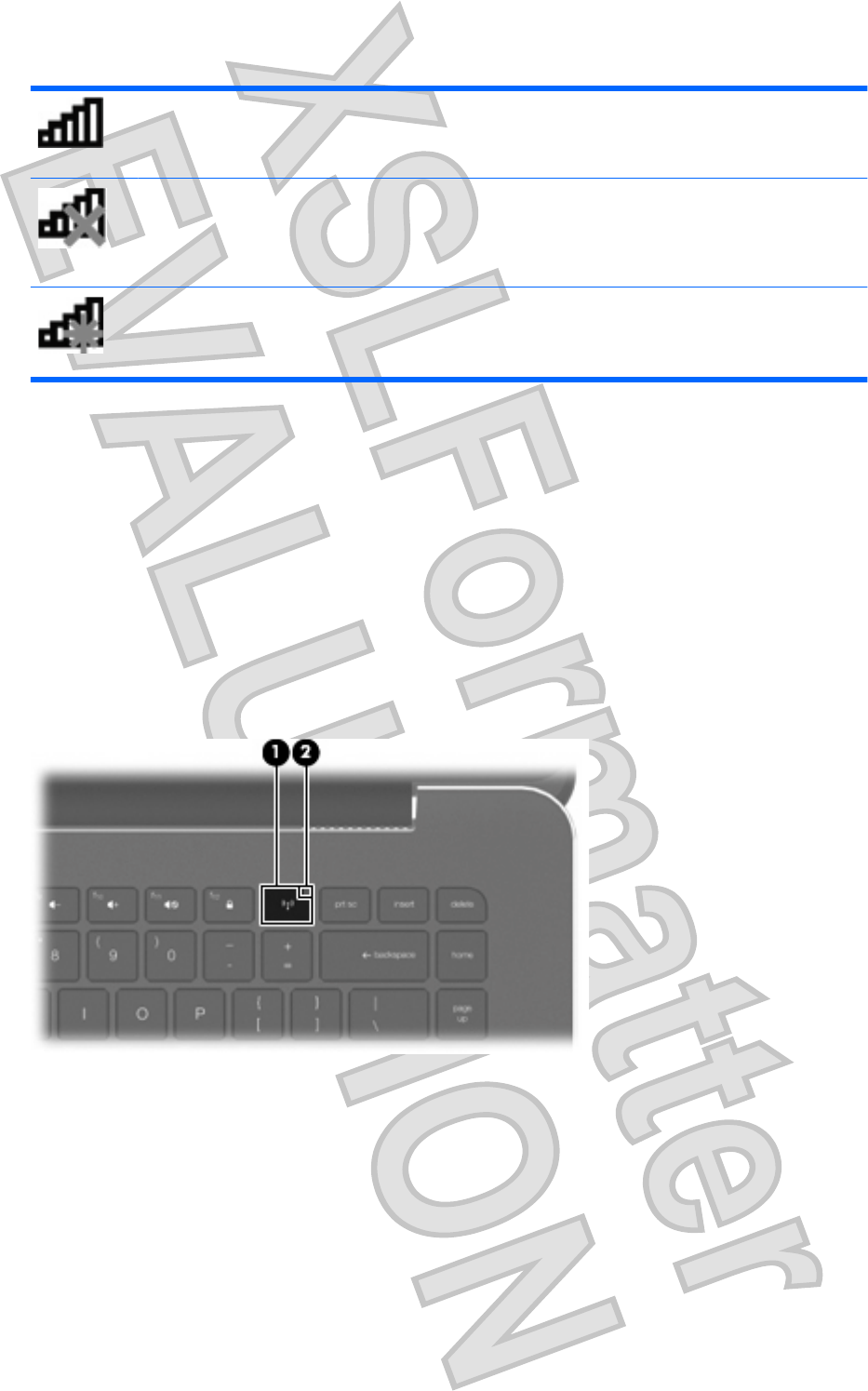
Network (connected) Indicates that one or more of your network drivers are
installed, one or more network devices are connected to a
wireless network, and one or more network devices may be
connected to a wired network.
Network (disabled/disconnected) Indicates that one or more of your network drivers are
installed, no wireless connections are available or all wireless
network devices are disabled by the wireless button or
Wireless Assistant, and no network devices are connected
to a wired network.
Network (disconnected) Indicates that one or more of your network drivers are
installed and wireless connections are available, but no
network devices are connected to a wired or wireless
network.
Using the wireless controls
You can control the wireless devices in your computer using these features:
łwireless key
łWireless Assistant software
łOperating system controls
Using the wireless key
The computer has a wireless key (1), one or more wireless devices, and one wireless light (2). All of the
wireless devices on your computer are enabled at the factory.
If the wireless light is amber, all wireless devices are off. If the wireless light is off, all wireless devices
are on.
The wireless light indicates the overall power state of your wireless devices, not the status of individual
devices. Press the wireless key to turn the wireless devices off or on.
Because the wireless devices are enabled at the factory, you can use the wireless key to turn on or turn
off the wireless devices simultaneously. Individual wireless devices can be controlled through Wireless
Assistant software.
16 Chapter 3 Wireless and local area network
Antenna House XSL Formatter (Evaluation) http://www.antennahouse.com/
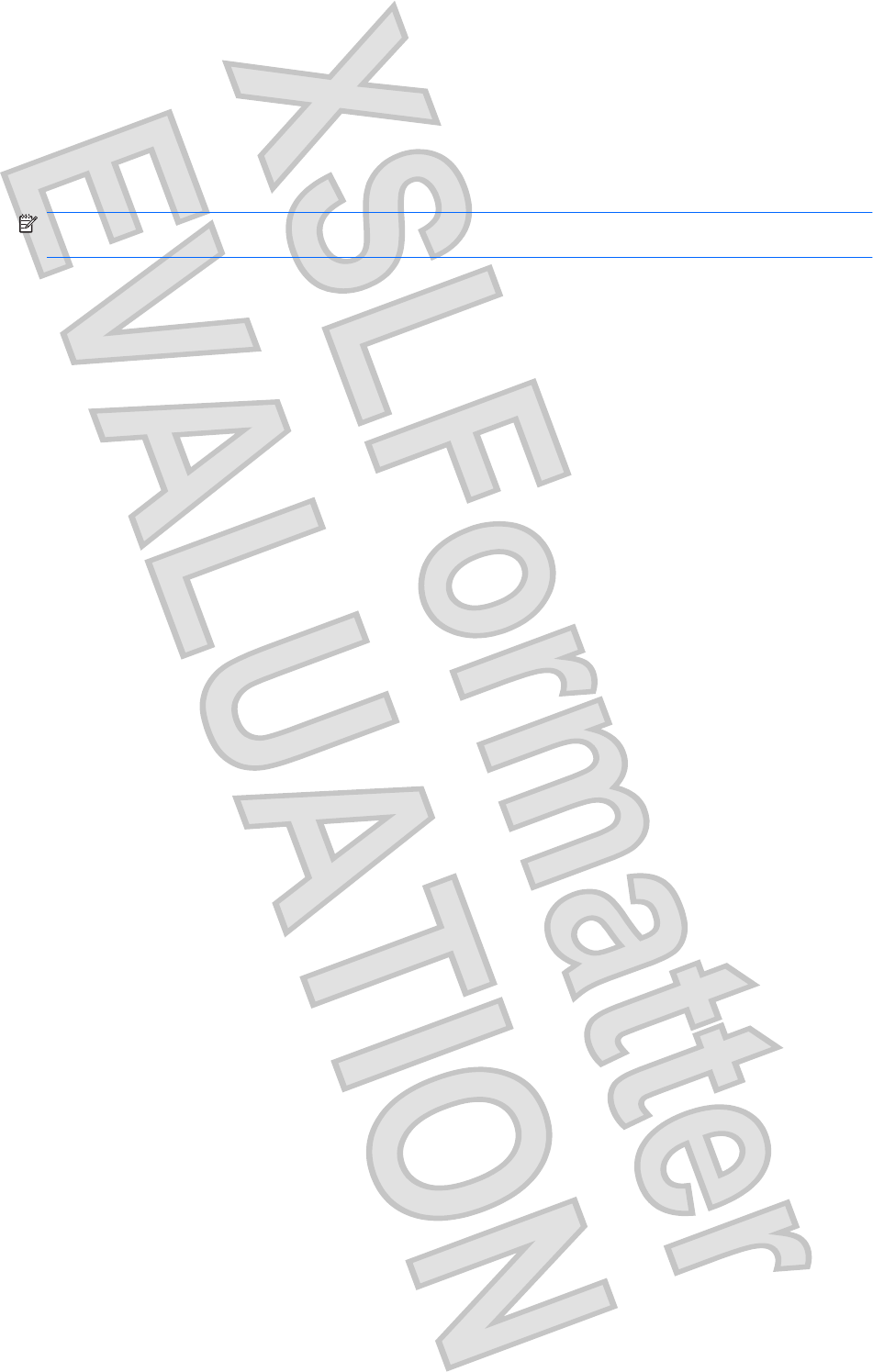
Using Wireless Assistant software
A wireless device can be turned on or off using the Wireless Assistant software. If a wireless device is
disabled in Setup Utility, it must be reenabled in Setup Utility before it can be turned on or off using
Wireless Assistant.
NOTE: Enabling or turning on a wireless device does not automatically connect the computer to a
network or a Bluetooth-enabled device.
To view the state of the wireless devices, click the Show hidden icons icon, the arrow at the left of the
notification area, and position the mouse pointer over the wireless icon.
If the wireless icon is not displayed in the notification area, complete the following steps to change
Wireless Assistant properties:
1. Select Start > Control Panel > Hardware and Sound > Windows Mobility Center.
2. Click the wireless icon in the Wireless Assistant tile, which is located in the bottom row of Windows®
Mobility Center.
3. Click Properties.
4. Select the check box next to HP Wireless Assistant icon in notification area.
5. Click Apply.
6. Click Close.
For more information, refer to the Wireless Assistant software Help:
1. Open Wireless Assistant by clicking the wireless icon in Windows Mobility Center.
2. Click the Help button.
Using operating system controls
Some operating systems also offer a way to manage integrated wireless devices and the wireless
connection. For example, Windows provides the Network and Sharing Center that allows you to set up
a connection or network, connect to a network, manage wireless networks, and diagnose and repair
network problems.
To access the Network and Sharing Center, select Start > Control Panel > Network and Internet >
Network and Sharing Center.
For more information, select Start > Help and Support.
Using wireless devices 17
Antenna House XSL Formatter (Evaluation) http://www.antennahouse.com/
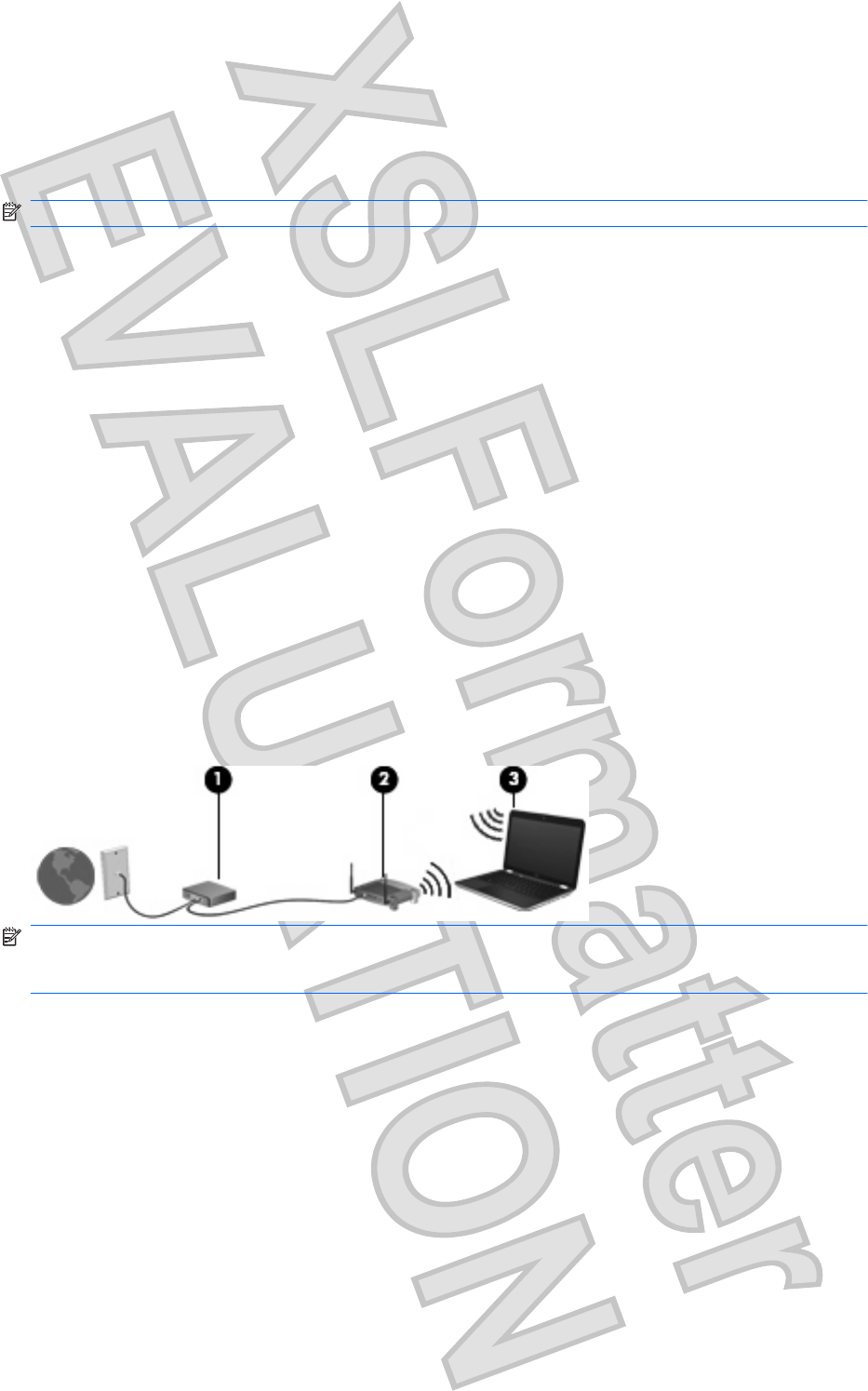
Using a WLAN
With a WLAN device, you can access a wireless local area network (WLAN), which is composed of other
computers and accessories that are linked by a wireless router or a wireless access point.
NOTE: The terms wireless router and wireless access point are often used interchangeably.
łA large-scale WLAN, such as a corporate or public WLAN, typically uses wireless access points
that can accommodate a large number of computers and accessories and can separate critical
network functions.
łA home or small office WLAN typically uses a wireless router, which allows several wireless and
wired computers to share an Internet connection, a printer, and files without requiring additional
pieces of hardware or software.
To use the WLAN device in your computer, you must connect to a WLAN infrastructure (provided through
a service provider or a public or corporate network).
Setting up a WLAN
To set up a WLAN and connect to the Internet, you need the following equipment:
łA broadband modem (either DSL or cable) (1) and high-speed Internet service purchased from an
Internet service provider (ISP)
łA wireless router (purchased separately) (2)
łThe wireless computer (3)
The following illustration shows an example of a wireless network installation that is connected to the
Internet.
NOTE: When setting up a wireless connection, be sure that your computer and wireless router are
synchronized. To synchronize your computer and wireless router, turn your computer and wireless
router off and then back on.
As your network grows, additional wireless and wired computers can be connected to the network to
access the Internet.
For help in setting up your WLAN, refer to the information provided by your router manufacturer or your
ISP.
Protecting your WLAN
Because the WLAN standard was designed with only limited security capabilities—basically to foil casual
eavesdropping rather than more powerful forms of attack—it is essential to understand that WLANs are
vulnerable to well-known and well-documented security weaknesses.
WLANs in public areas, or “hotspots,” like coffee shops and airports may not provide any security. New
technologies are being developed by wireless manufacturers and hotspot service providers that make
18 Chapter 3 Wireless and local area network
Antenna House XSL Formatter (Evaluation) http://www.antennahouse.com/

the public environment more secure and anonymous. If you are concerned about the security of your
computer in a hotspot, limit your network activities to noncritical e-mail and basic Internet surfing.
When you set up a WLAN or access an existing WLAN, always enable security features to protect your
network from unauthorized access. The common security levels are Wi-Fi Protected Access (WPA)-
Personal and Wired Equivalent Privacy (WEP). Because wireless radio signals travel outside the
network, other WLAN devices can pick up unprotected signals and either connect to your network
(uninvited) or capture information being sent across it. However, you can take precautions to protect
your WLAN:
łUse a wireless transmitter with built-in security
Many wireless base stations, gateways, or routers provide built-in security features such as
wireless security protocols and firewalls. With the correct wireless transmitter, you can protect your
network from the most common wireless security risks.
łWork behind a firewall
A firewall is a barrier that checks both data and requests for data that are sent to your network,
and discards any suspicious items. Firewalls are available in many varieties, both software and
hardware. Some networks use a combination of both types.
łUse wireless encryption
A variety of sophisticated encryption protocols is available for your WLAN. Find the solution that
works best for your network security:
ŃWired Equivalent Privacy (WEP) is a wireless security protocol that encodes or encrypts all
network data before it is transmitted using a WEP key. Usually, you can allow the network to
assign the WEP key. Alternatively, you can set up your own key, generate a different key, or
choose other advanced options. Without the correct key, others will not be able to use the
WLAN.
ŃWPA (Wi-Fi Protected Access), like WEP, uses security settings to encrypt and decrypt data
that is transmitted over the network. However, instead of using one static security key for
encryptions as WEP does, WPA uses “temporal key integrity protocol” (TKIP) to dynamically
generate a new key for every packet. It also generates different sets of keys for each computer
on the network.
Connecting to a WLAN
To connect to the WLAN, follow these steps:
1. Be sure that the WLAN device is on (wireless light is off). If the wireless light is amber, press the
wireless key.
2. Click the network icon in the notification area, at the far right of the taskbar.
3. Select your WLAN from the list.
4. Click Connect.
If the network is a security-enabled WLAN, you are prompted to enter a network security key, which
is a security code. Type the code, and then click Connect to complete the connection.
NOTE: If no WLANs are listed, you are out of range of a wireless router or access point.
Using a WLAN 19
Antenna House XSL Formatter (Evaluation) http://www.antennahouse.com/

NOTE: If you do not see the network you want to connect to, Open Network and Sharing
Center, and then click Set up a new connection or network. A list of options is displayed. You
can choose to manually search for and connect to a network or to create a new network connection.
After the connection is made, place the mouse pointer over the network icon in the notification area, at
the far right of the taskbar, to verify the name and status of the connection.
NOTE: The functional range (how far your wireless signals travel) depends on WLAN implementation,
router manufacturer, and interference from other electronic devices or structural barriers such as walls
and floors.
More information about using a WLAN is available through the following resources:
łInformation from your ISP and the user guides included with your wireless router and other WLAN
equipment
łInformation and Web site links provided in Help and Support
For a list of public WLANs near you, contact your ISP or search the Web. Web sites that list public
WLANs include Cisco Internet Mobile Office Wireless Locations, Hotspotlist, and Geektools. Check with
each public WLAN location for cost and connection requirements.
For additional information on connecting your computer to a corporate WLAN, contact your network
administrator or IT department.
Roaming to another network
When you move your computer within range of another WLAN, Windows attempts to connect to that
network. If the attempt is successful, your computer is automatically connected to the new network. If
Windows does not recognize the new network, follow the same procedure you used initially to connect
to your WLAN.
20 Chapter 3 Wireless and local area network
Antenna House XSL Formatter (Evaluation) http://www.antennahouse.com/

Using Bluetooth wireless devices
A Bluetooth device provides short-range wireless communications that replace the physical cable
connections that traditionally link electronic devices such as the following:
łComputers (desktop, notebook, PDA)
łPhones (cellular, cordless, smart phone)
łImaging devices (printer, camera)
łAudio devices (headset, speakers)
Bluetooth devices provide peer-to-peer capability that allows you to set up a personal area network
(PAN) of Bluetooth devices. For information on configuring and using Bluetooth devices, refer to the
Bluetooth software Help.
Bluetooth and Internet Connection Sharing (ICS)
HP does not recommend setting up one computer with Bluetooth as a host and using it as a gateway
through which other computers may connect to the Internet. When two or more computers are connected
using Bluetooth, and Internet Connection Sharing (ICS) is enabled on one of the computers, the other
computers may not be able to connect to the Internet using the Bluetooth network.
The strength of Bluetooth is in synchronizing information transfers between your computer and wireless
devices including cellular phones, printers, cameras, and PDAs. The inability to consistently connect
two or more computers to share the Internet through Bluetooth is a limitation of Bluetooth and the
Windows operating system.
Using Bluetooth wireless devices 21
Antenna House XSL Formatter (Evaluation) http://www.antennahouse.com/

Troubleshooting wireless connection problems
Some possible causes for wireless connection problems include the following:
łNetwork configuration (SSID or security) has been changed.
łWireless device is not installed correctly or has been disabled.
łWireless device or router hardware has failed.
łWireless device encountered interference from other devices.
Cannot connect to a preferred network
Windows can automatically repair a corrupted WLAN connection:
łIf there is a network icon in the notification area, at the far right of the taskbar, right-click the icon,
and then click Diagnose and repair from the menu.
Windows resets your network device and attempts to reconnect to one of the preferred networks.
łIf there is no network icon in the notification area, follow these steps:
1. Select Start > Control Panel > Network and Internet > Network and Sharing Center.
2. Click Troubleshoot problems and select the network you wish to repair.
Network icon for WLAN is not displayed
If the network icon is not displayed in the notification area after you configure the WLAN, the software
driver is either missing or corrupted. A Windows “Device not Found” error message may also be
displayed. The driver must be reinstalled.
Get the latest version of the WLAN device software and drivers for your computer from the HP Web site
at http://www.hp.com:
1. Open your Web browser and go to http://www.hp.com/support.
2. Select your country or region.
3. Click the option for software and driver downloads, and then type your computer model number in
the search box.
4. Press enter, and then follow the on-screen instructions.
Current WLAN network security codes are unavailable
If you are prompted for a network key or a name (SSID) when connecting to a WLAN, the network is
protected by security. You must have the current codes to make a connection on a secure network. The
SSID and network key are alphanumeric codes that you enter into your computer to identify your
computer to the network.
łFor a network connected to your personal wireless router, review the router user guide for
instructions on setting up the same codes on both the router and the WLAN device.
łFor a private network, such as a network in an office or at a public Internet chat room, contact the
network administrator to obtain the codes, and then enter the codes when prompted to do so.
22 Chapter 3 Wireless and local area network
Antenna House XSL Formatter (Evaluation) http://www.antennahouse.com/
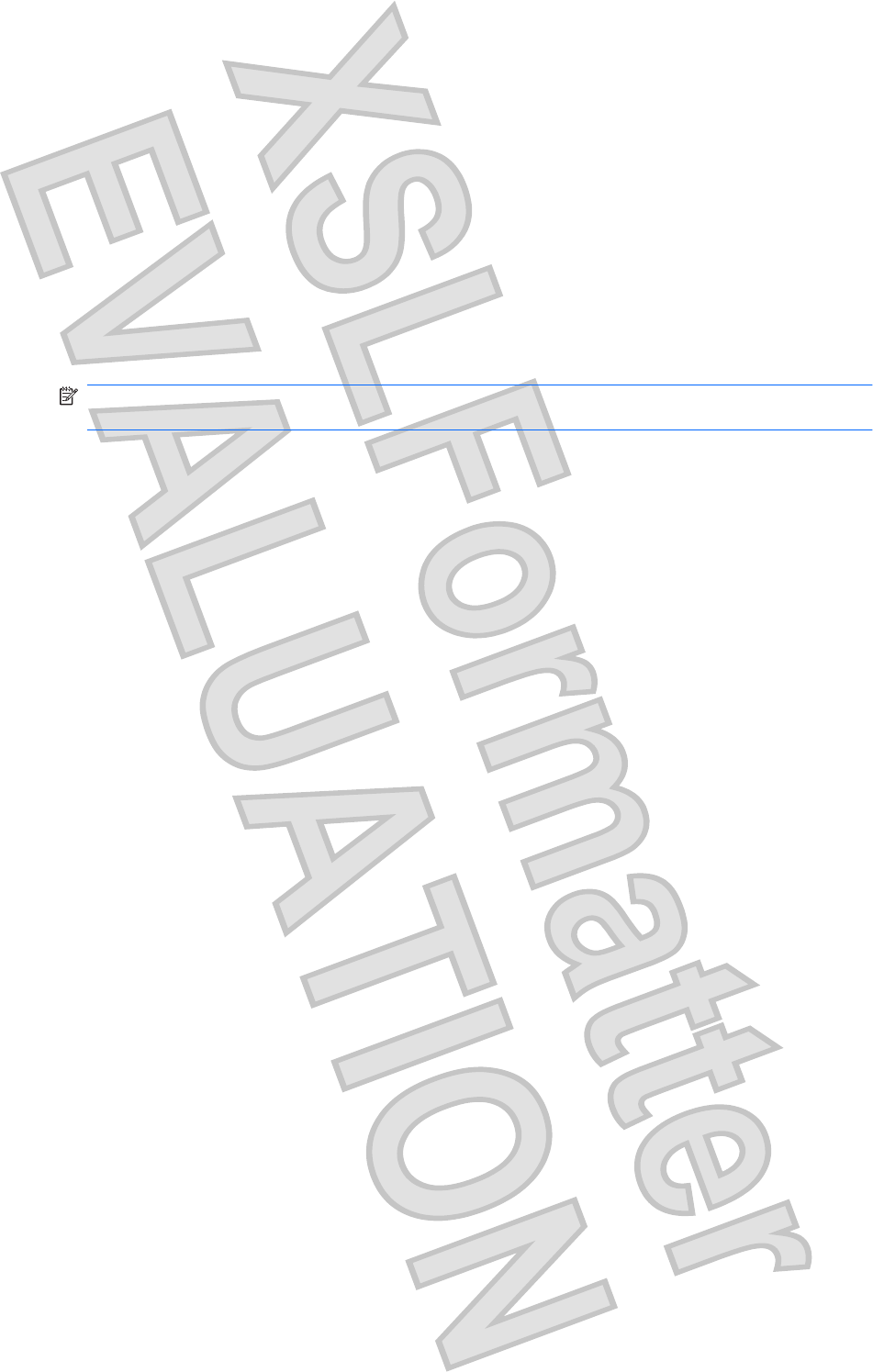
Some networks change the SSID or network keys used in their routers or access points on a regular
basis to improve security. You must change the corresponding code in your computer accordingly.
If you are provided with new wireless network keys and SSID for a network, and if you have previously
connected to that network, follow these steps to connect to the network:
1. Select Start > Control Panel > Network and Internet > Network and Sharing Center.
2. Click Manage wireless networks in the left panel.
A list showing the available WLANs is displayed. If you are in a hotspot where several WLANs are
active, several will be displayed.
3. Select the network in the list, right-click the network, and then click Properties.
NOTE: If the network you want is not listed, check with the network administrator to be sure that
the router or access point is operating.
4. Click the Security tab and enter the correct wireless encryption data into the Network security
key box.
5. Click OK to save these settings.
WLAN connection is very weak
If the connection is very weak, or if your computer cannot make a connection to a WLAN, minimize
interference from other devices, as follows:
łMove your computer closer to the wireless router or access point.
łTemporarily disconnect devices such as a microwave, cordless phone, or cellular phone to be sure
that other wireless devices are not interfering.
If the connection does not improve, try forcing the device to reestablish all connection values:
1. Select Start > Control Panel > Network and Internet > Network and Sharing Center.
2. Click Manage wireless networks in the left pane.
A list showing the available WLANs is displayed. If you are in a hotspot where several WLANs are
active, several will be displayed.
3. Click a network, and then click Remove.
Cannot connect to the wireless router
If you are trying to connect to the wireless router and are unsuccessful, reset the wireless router by
removing power from the router for 10 to 15 seconds.
If the computer still cannot make a connection to a WLAN, restart the wireless router. For details, refer
to the router manufacturer's instructions.
Troubleshooting wireless connection problems 23
Antenna House XSL Formatter (Evaluation) http://www.antennahouse.com/
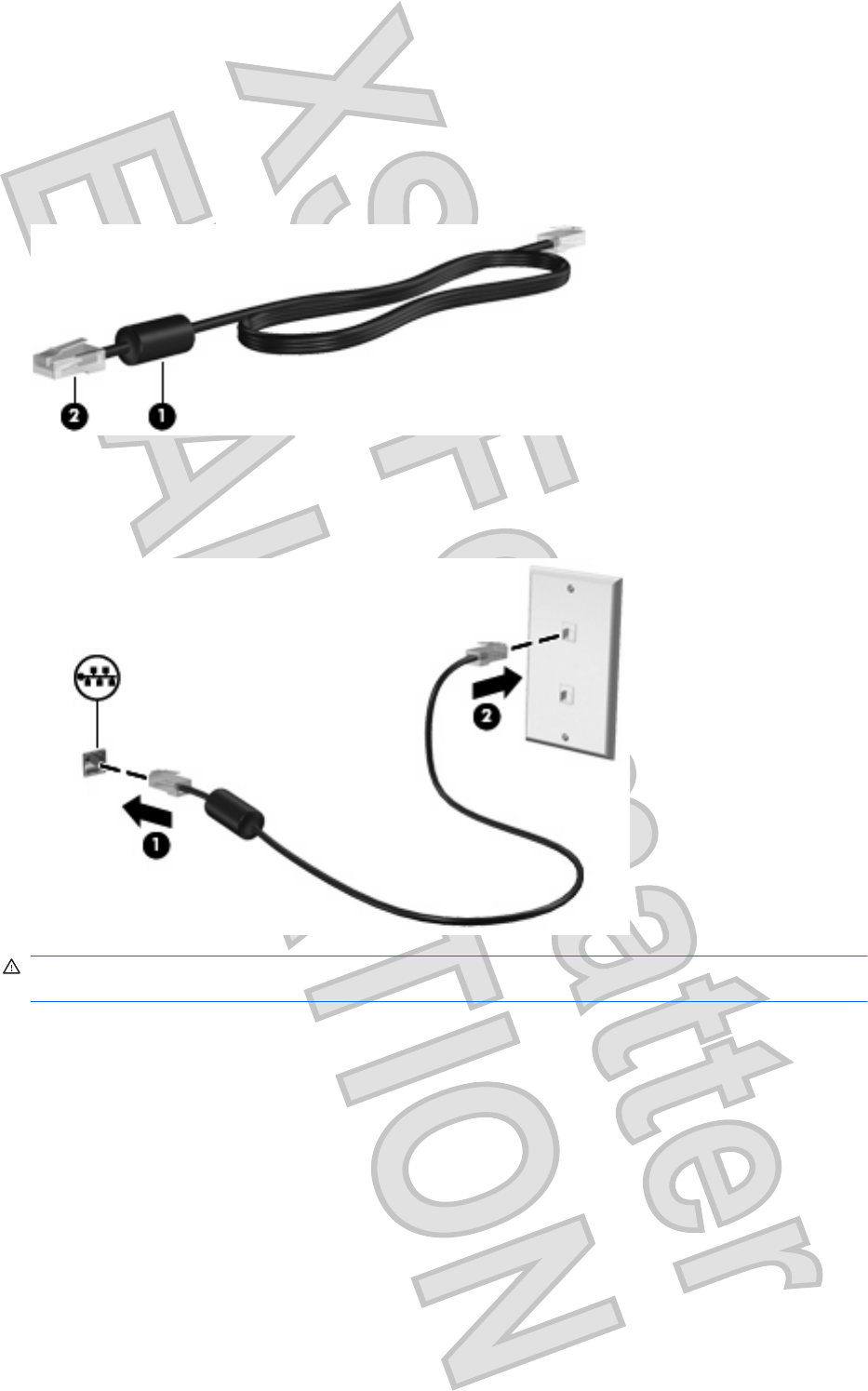
Connecting to a local area network (LAN)
Connecting to a local area network (LAN) requires an 8-pin, RJ-45 network cable (purchased
separately). If the network cable contains noise suppression circuitry (1), which prevents interference
from TV and radio reception, orient the circuitry end of the cable (2) toward the computer.
To connect to a LAN:
1. Plug the network cable into the network jack (1) on the computer.
2. Plug the other end of the network cable into a network wall jack (2).
WARNING! To reduce the risk of electric shock, fire, or damage to the equipment, do not plug a modem
cable or telephone cable into an RJ-45 (network) jack.
24 Chapter 3 Wireless and local area network
Antenna House XSL Formatter (Evaluation) http://www.antennahouse.com/

4 Pointing devices and keyboard
25
Antenna House XSL Formatter (Evaluation) http://www.antennahouse.com/
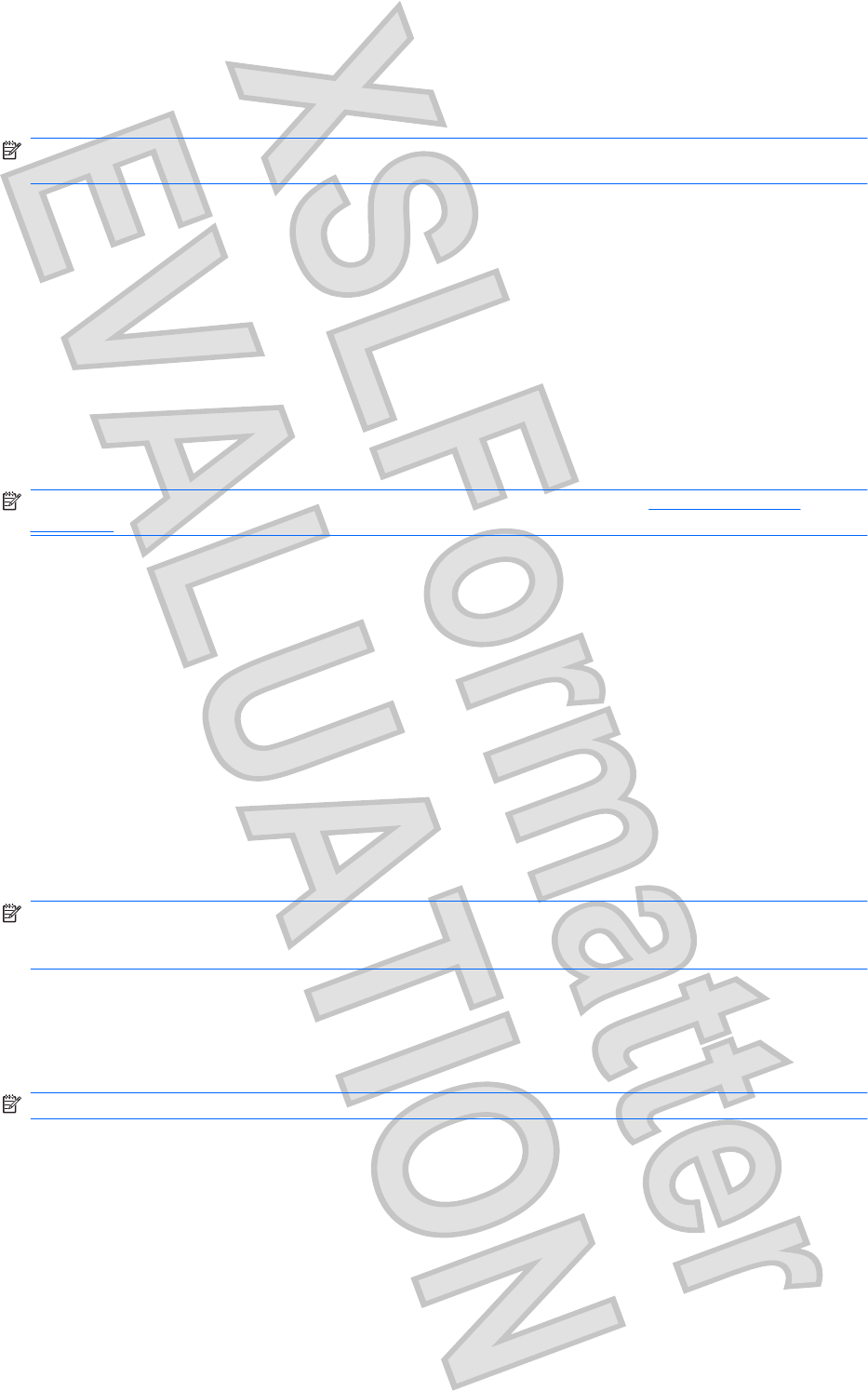
Using pointing devices
NOTE: In addition to the TouchPad, you can also connect an external USB mouse to one of the USB
ports on the computer.
Setting pointing device preferences
Use Mouse Properties in Windows® to customize settings for pointing devices, such as button
configuration, click speed, and pointer options.
To access Mouse Properties, select Start > Devices and Printers. Then, right-click the device
representing your computer, and select Mouse settings.
Using the TouchPad
To move the pointer, slide one finger across the TouchPad surface in the direction you want the pointer
to go. Use the left and right TouchPad buttons like the corresponding buttons on an external mouse.
NOTE: For information on identifying the TouchPad components, refer to TouchPad buttons
on page 3.
Using TouchPad gestures
The TouchPad supports a variety of TouchPad gestures. To activate the TouchPad gestures, place two
fingers on the TouchPad as described in the following sections.
The TouchPad gestures described in this section are enabled at the factory. To disable or reenable
these gestures:
1. Double-click on the Synaptics icon in the notification area, at the far right of the taskbar, and then
click the Device Settings tab.
2. Select the device, and then click Settings.
3. Select the checkbox to disable or reenable the TouchPad gesture.
4. Click Apply, and then click OK.
NOTE: Your computer also supports additional TouchPad features that are disabled at the factory. To
view and enable these features, click the Synaptics icon in the notification area, at the far right of the
taskbar, and then click the Device Settings tab. Select the device, and then click Settings.
Scrolling
Scrolling is useful for moving up or down on a page or image. To scroll, place two fingers on the
TouchPad and drag them across the TouchPad in an up, down, left, or right motion.
NOTE: Scrolling speed is controlled by finger speed.
26 Chapter 4 Pointing devices and keyboard
Antenna House XSL Formatter (Evaluation) http://www.antennahouse.com/
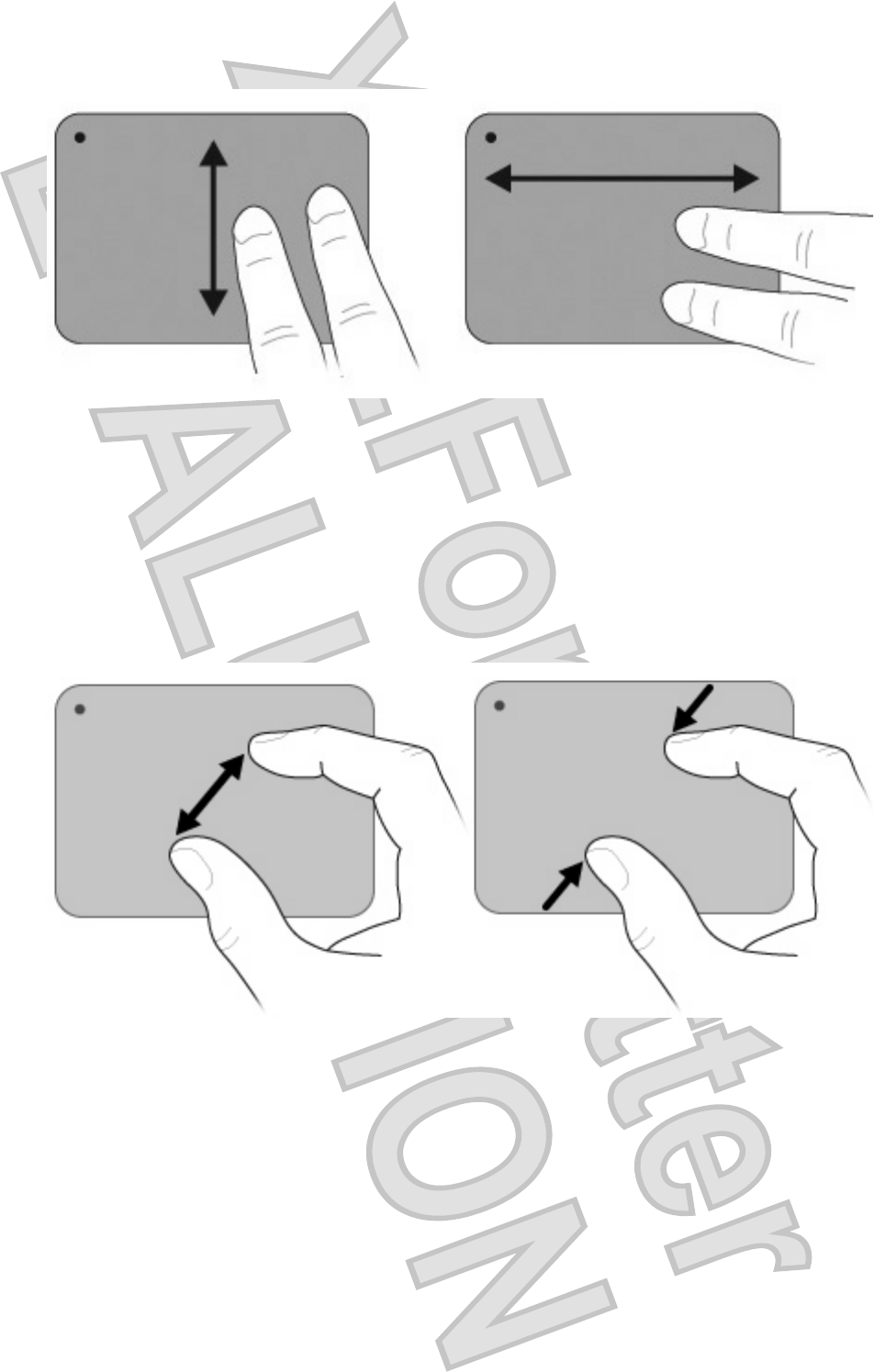
Pinching
Pinching allows you to zoom in or out on items such as PDFs, images, and photos.
To pinch:
łZoom in by holding two fingers together on the TouchPad, and then pull the fingers apart to increase
an object's size.
łZoom out by holding two fingers apart on the TouchPad, and then pull the fingers together to
decrease an object's size.
Rotating
Rotating allows you rotate items such as photos and pages. To rotate, anchor your thumb on the
TouchPad, and then move your forefinger in a semicircular motion around your thumb.
Using pointing devices 27
Antenna House XSL Formatter (Evaluation) http://www.antennahouse.com/
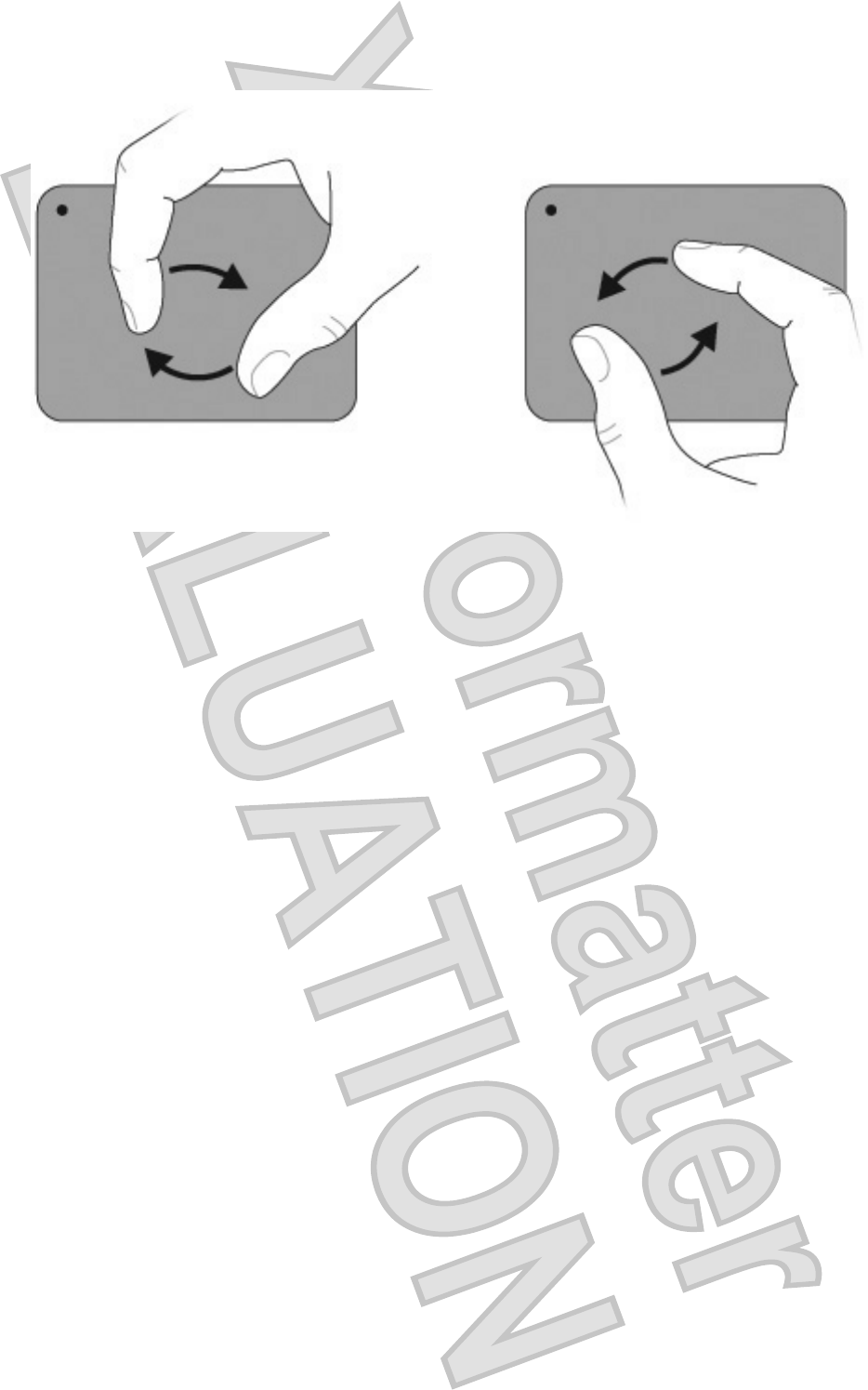
28 Chapter 4 Pointing devices and keyboard
Antenna House XSL Formatter (Evaluation) http://www.antennahouse.com/
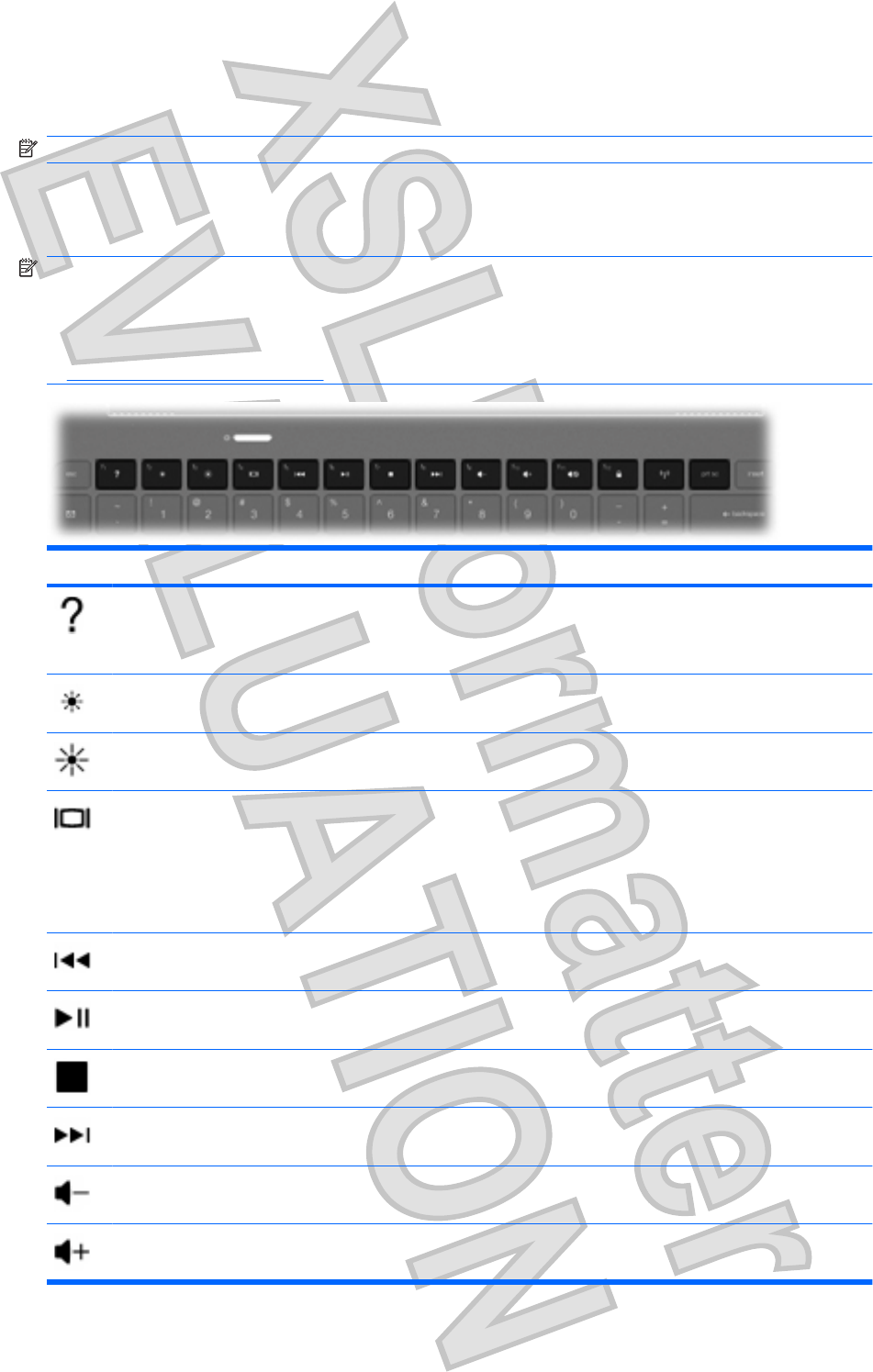
Using the action keys
NOTE: Some action keys are not available in QuickWeb.
Action keys are customized actions that are assigned to specific keys on the keyboard.
To use an action key, press and hold this key to activate the assigned function.
NOTE: Depending on the application you are using, pressing fn and one of the action keys will open
a specific shortcut menu within that application.
NOTE: The action key feature is enabled at the factory. You can disable this feature in Setup Utility
(BIOS) to require pressing the fn key and one of the action keys to activate the assigned function. Refer
to Setup Utility (BIOS) on page 93 for additional information.
Icon Description
Opens Help and Support, which provides information about your Windows operating system and computer, answers
to questions and tutorials, and updates to your computer.
Help and Support also provides automated troubleshooting and links to support specialists.
Decreases the screen brightness level incrementally when you hold down this key.
Increases the screen brightness level incrementally when you hold down this key.
Switches the screen image among display devices connected to the system. For example, if a monitor is connected
to the computer, pressing this key alternates the screen image from computer display to monitor display to
simultaneous display on both the computer and the monitor.
Most external monitors receive video information from the computer using the external VGA video standard. The
switch screen image key can also alternate images among other devices that are receiving video information from
the computer.
Plays the previous track of a CD or the previous section of a DVD or a BD.
Plays, pauses, or resumes an audio CD, a DVD, or a BD.
Stops audio playback of a CD, a DVD, or a BD.
Plays the next track of an audio CD or the next section of a DVD or a BD.
Decreases speaker sound incrementally when you hold down this key.
Increases speaker sound incrementally when you hold down this key.
Using the action keys 29
Antenna House XSL Formatter (Evaluation) http://www.antennahouse.com/
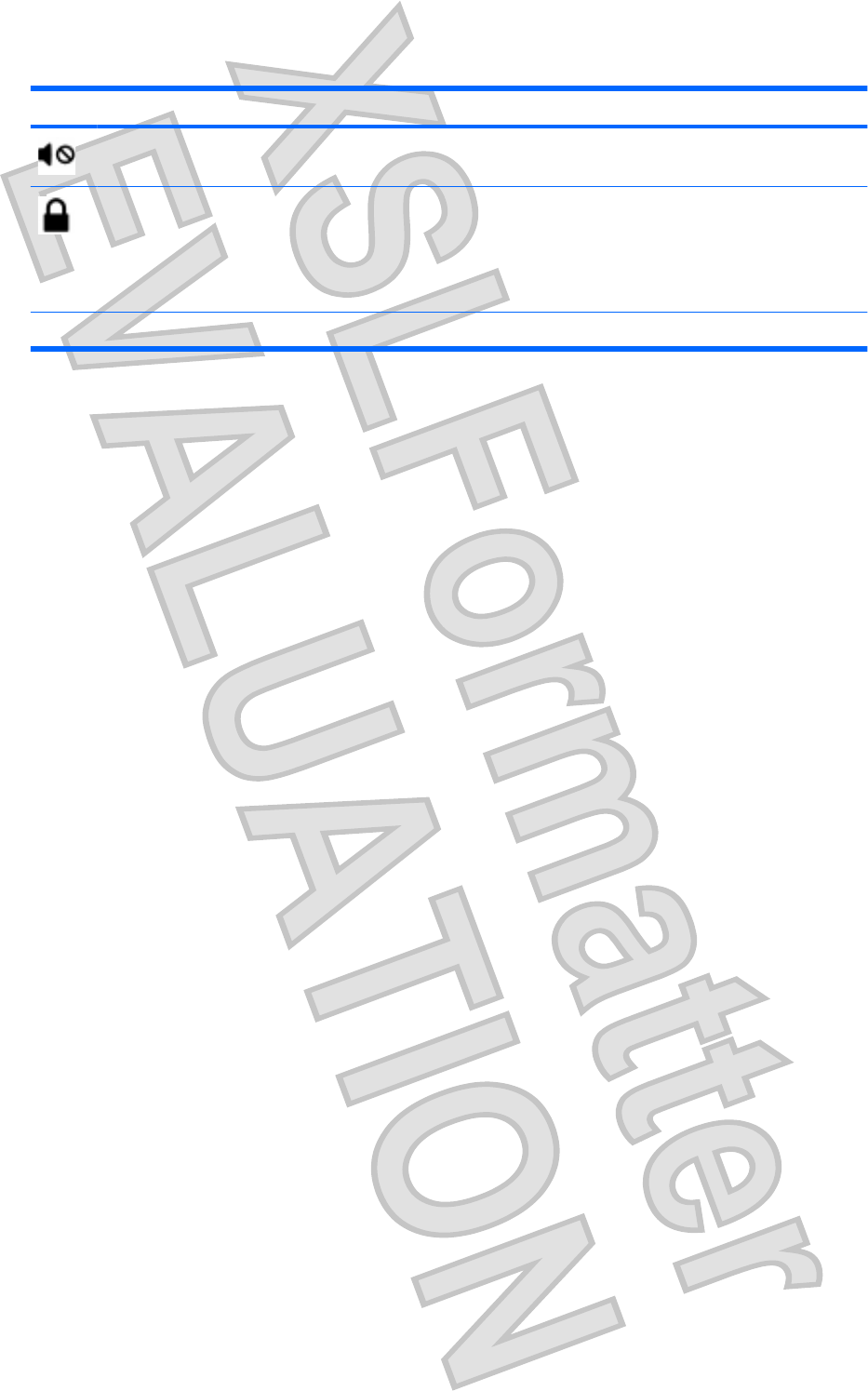
Icon Description
Mutes or restores speaker sound.
Initiates the QuickLock security feature. QuickLock protects your information by displaying the operating system Log
On window. While the Log On window is displayed, the computer cannot be accessed until a Windows user password
or a Windows administrator password is entered.
NOTE: Before you can use QuickLock, you must set a Windows user password or a Windows administrator
password. For instructions, refer to Help and Support.
prt sc Takes a snapshot or picture of your computer screen and copies it to the clipboard.
30 Chapter 4 Pointing devices and keyboard
Antenna House XSL Formatter (Evaluation) http://www.antennahouse.com/
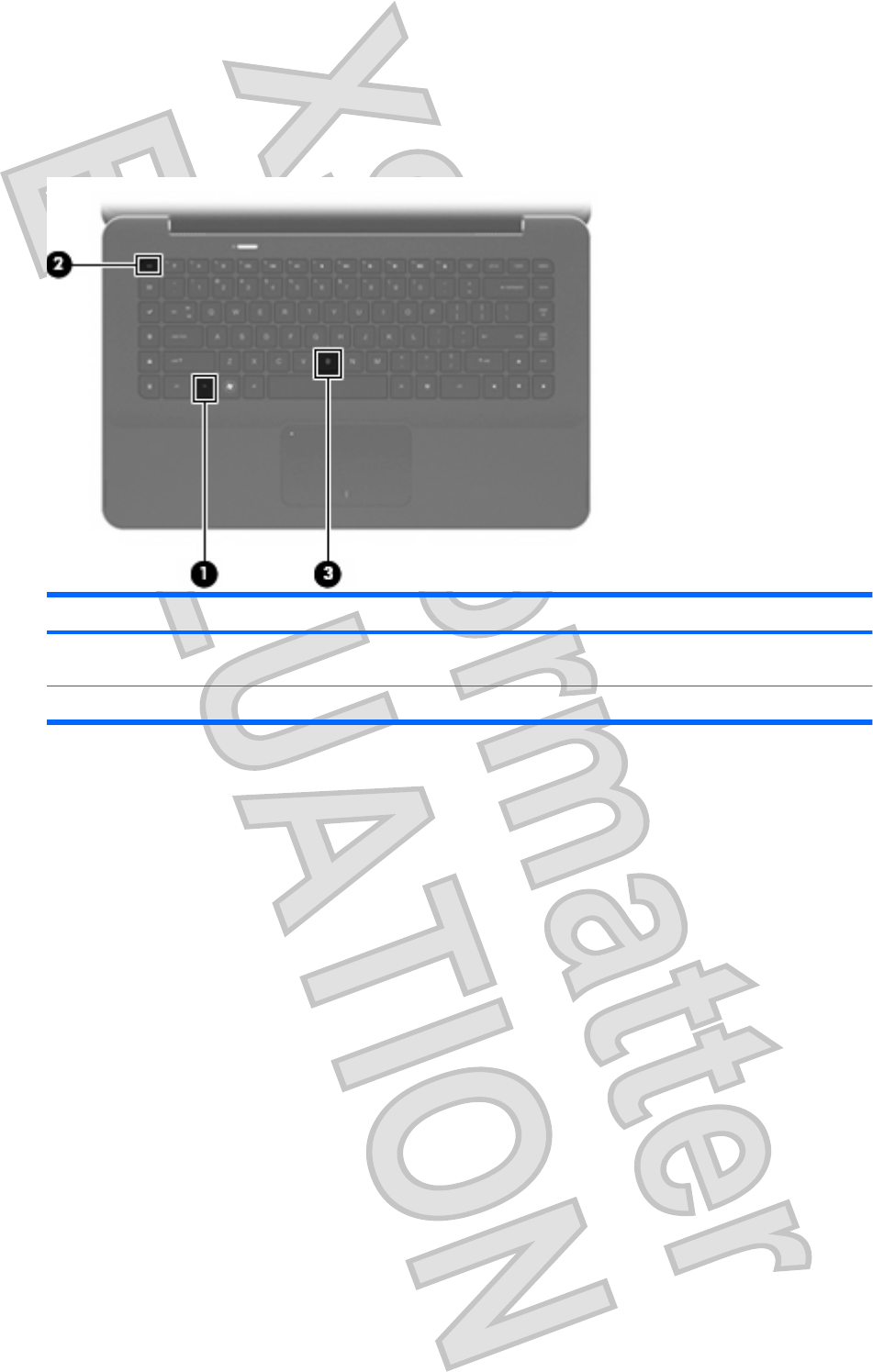
Using the hotkeys
Hotkeys are combinations of the fn key (1) and either the esc key (2) or the b key (3).
Function Hotkey Description
Display system information. fn+esc Displays information about system hardware components and the system
BIOS version number.
Control the bass settings. fn+b Increases or decreases the bass settings with the Beats Audio feature.
To use a hotkey command, follow either of these steps:
łBriefly press the fn key, and then briefly press the second key of the hotkey command.
– or –
łPress and hold down the fn key, briefly press the second key of the hotkey command, and then
release both keys at the same time.
Using the hotkeys 31
Antenna House XSL Formatter (Evaluation) http://www.antennahouse.com/
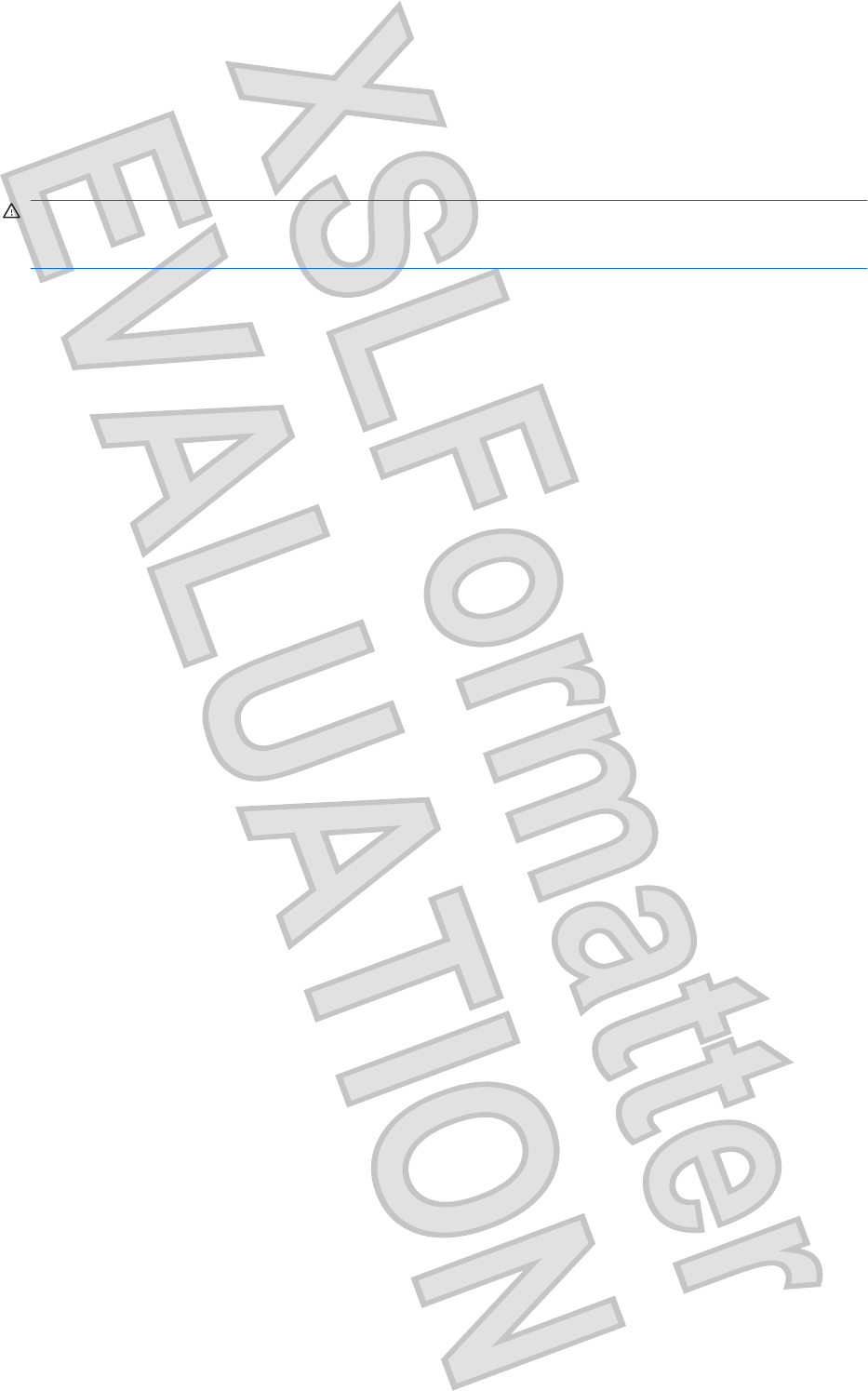
Cleaning the TouchPad and keyboard
Dirt and grease on the TouchPad can cause the pointer to jump around on the screen. To avoid this,
clean the TouchPad with a damp cloth, and wash your hands frequently when using the computer.
WARNING! To reduce the risk of electric shock or damage to internal components, do not use a
vacuum cleaner attachment to clean the keyboard. A vacuum cleaner can deposit household debris on
the keyboard surface.
Clean the keyboard regularly to prevent keys from sticking and to remove dust, lint, and particles that
can become trapped beneath the keys. A can of compressed air with a straw extension can be used to
blow air around and under the keys to loosen and remove debris.
32 Chapter 4 Pointing devices and keyboard
Antenna House XSL Formatter (Evaluation) http://www.antennahouse.com/

5Multimedia
33
Antenna House XSL Formatter (Evaluation) http://www.antennahouse.com/
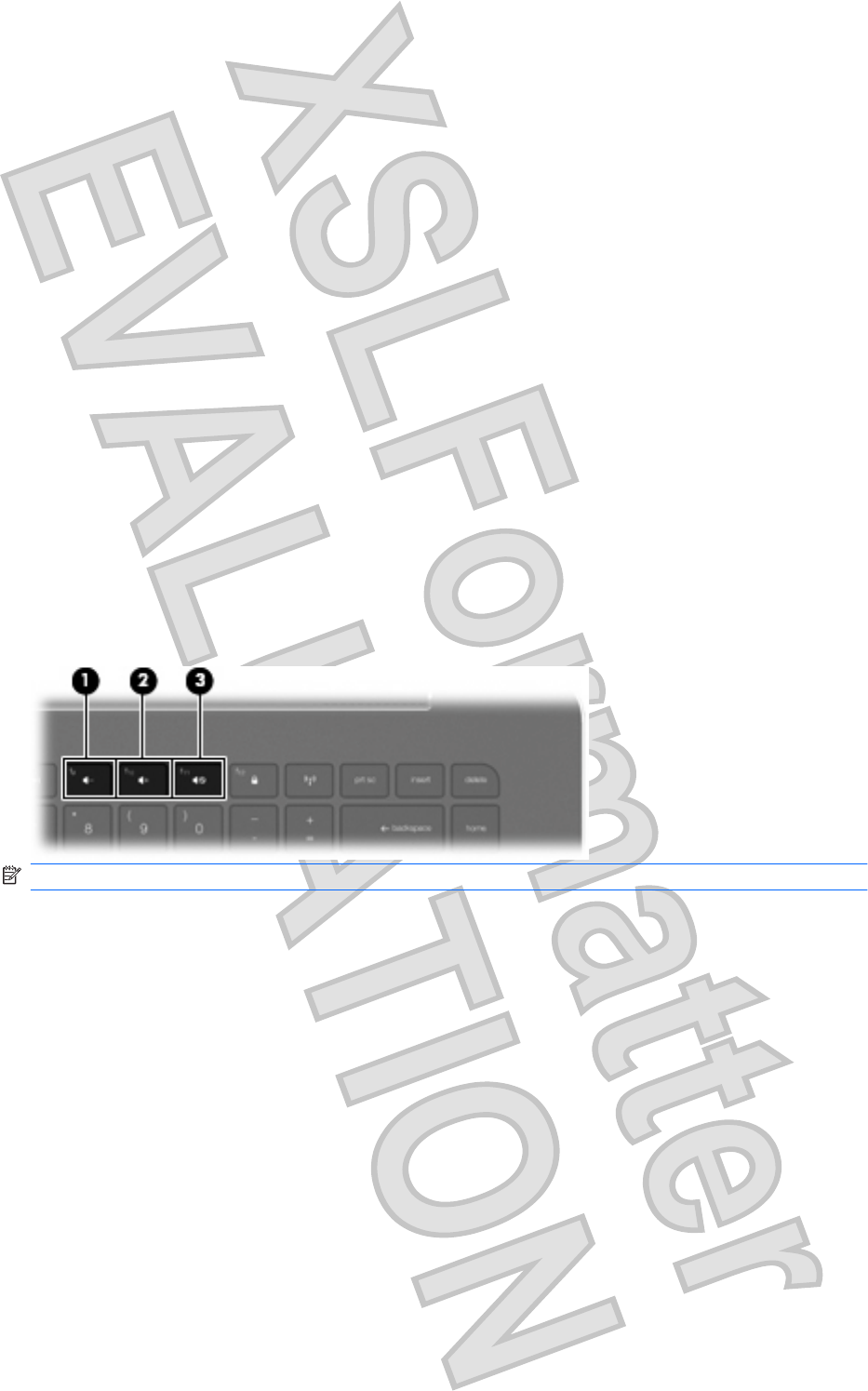
Multimedia features
Your computer includes multimedia features that allow you to listen to music, watch movies, and view
pictures. Your computer may include the following multimedia components:
łIntegrated speakers for listening to music
łIntegrated microphones for recording your own audio
łIntegrated webcam that allows you to capture and share video
łPreinstalled multimedia software that allows you to play and manage your music, movies, and
pictures
łMultimedia keys that provide fast access to multimedia tasks
The following sections explain how to use the multimedia components included with your computer.
Adjusting the volume
You can adjust the volume using the computer volume keys.
łTo decrease volume, press the volume down key (1).
łTo increase volume, press the volume up key (2).
łTo mute or restore volume, press the volume mute key (3).
NOTE: Volume can also be controlled through the Windows operating system and some programs.
Using the media activity keys
The media activity keys control the play of an audio CD or a DVD or BD that is inserted into an external
optical drive (purchased separately).
łWhen an audio CD or a DVD is not playing, press the play/pause key (2) to play the disc.
łWhen an audio CD or a DVD is playing, use the following keys:
ŃTo play the previous track of an audio CD or the previous chapter of a DVD, press the previous
track key (1).
ŃTo pause or resume playing the disc, press play/pause key (2).
ŃTo stop the disc, press the stop key (3).
ŃTo play the next track of an audio CD or the next chapter of a DVD, press the next track key
(4).
34 Chapter 5 Multimedia
Antenna House XSL Formatter (Evaluation) http://www.antennahouse.com/
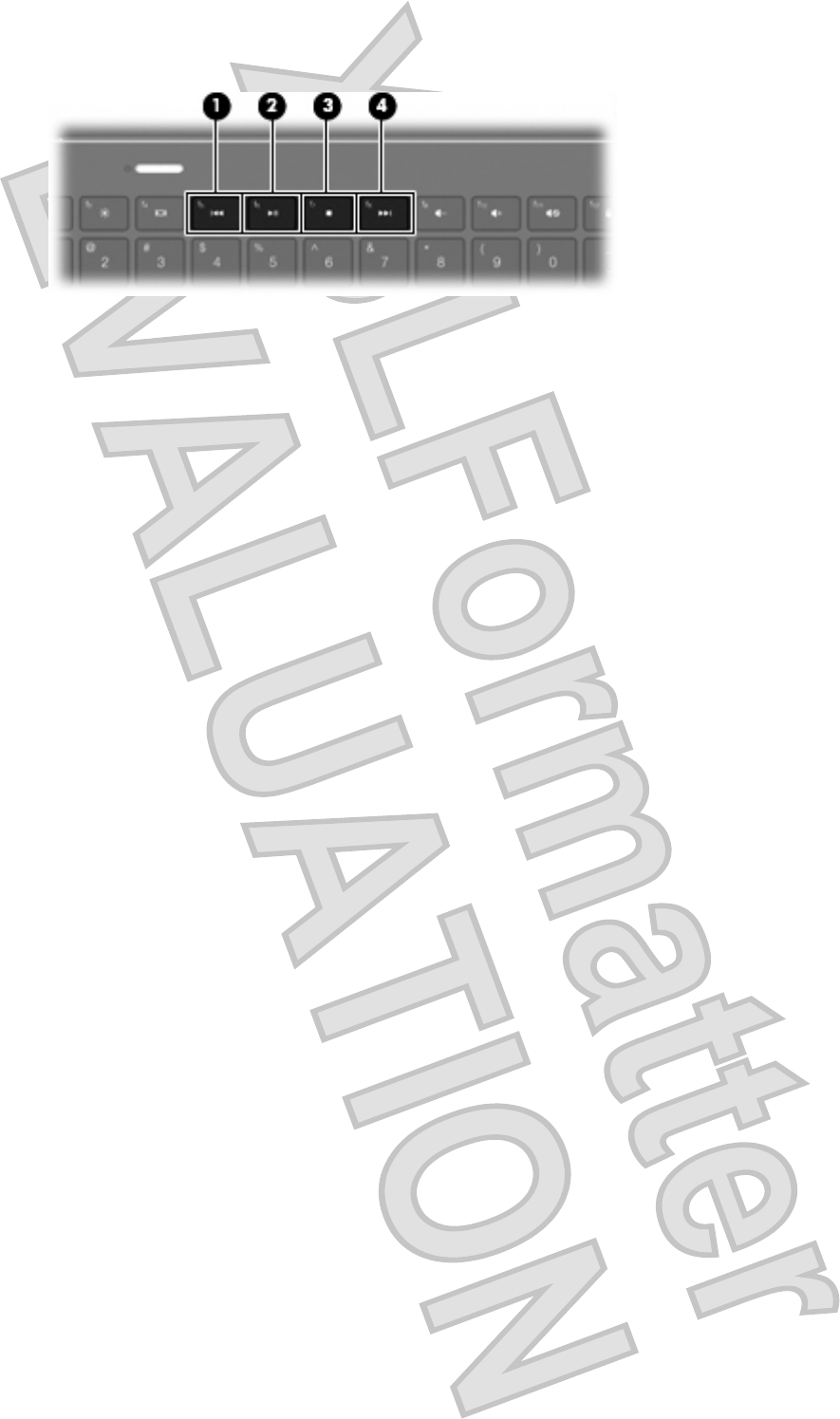
Multimedia features 35
Antenna House XSL Formatter (Evaluation) http://www.antennahouse.com/

Multimedia software
The computer includes preinstalled multimedia software.
If you have an external optical drive (purchased separately), you can also perform the following
multimedia tasks:
łPlaying digital media, including audio and video CDs, audio and video DVDs
łCreating or copying data CDs
łCreating, editing, and burning audio CDs
łCreating, editing, and burning a video or movie to a DVD or video CD
Using HP MediaSmart software
HP MediaSmart turns your computer into a mobile entertainment center. With MediaSmart, you can
enjoy music and DVD and BD movies. You can also manage and edit your photo collections.
MediaSmart includes the following features:
łPlaylist upload support:
ŃUpload your MediaSmart photo playlists to Internet photo albums, such as Snapfish.
ŃUpload your MediaSmart video playlists to YouTube.
ŃExport your MediaSmart playlist to the CyberLink DVD Suite.
łPandora Internet radio (North America only)—Listen to music selected just for you, streamed from
the Internet.
To start MediaSmart:
⊡Select Start > All Programs > HP > HP MediaSmart.
– or –
⊡Press the media launch key on the keyboard.
For more information on using MediaSmart, select Start > Help and Support.
Using multimedia software
⊡Select Start > All Programs, and then open the multimedia program you want to use. For example,
if you want to use Windows Media Player to play an audio CD, click Windows Media Player.
– or –
1. Insert a disc into an external optical drive (purchased separately).
An AutoPlay dialog box opens.
2. Click a multimedia task from the list, and then choose the software you want to use for that task.
36 Chapter 5 Multimedia
Antenna House XSL Formatter (Evaluation) http://www.antennahouse.com/
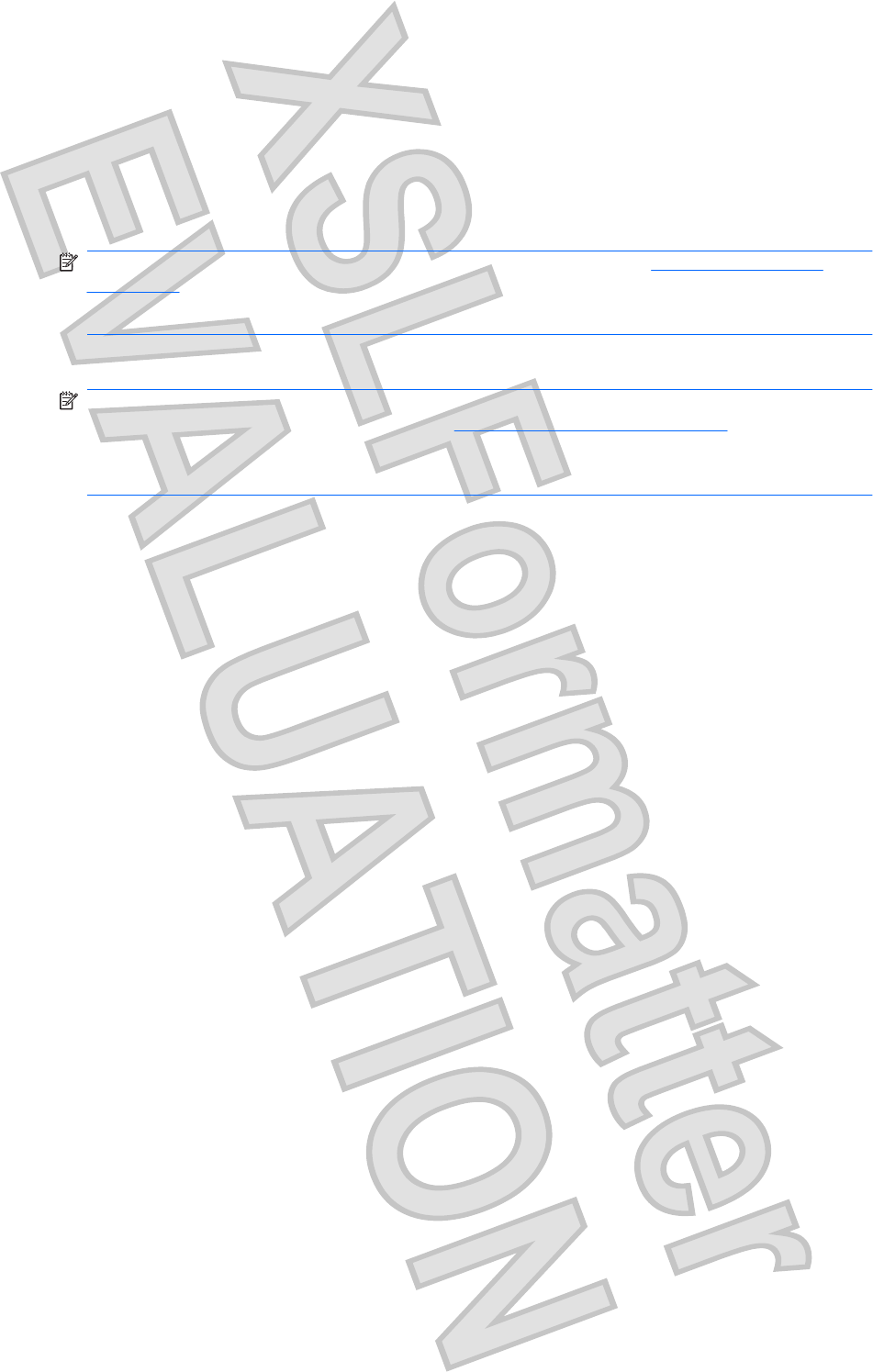
Installing multimedia software from a disc
Although your computer does not have an integrated optical drive, you can easily access software, as
well as install applications and access data in either of the following ways:
łConnect an external optical drive (purchased separately) to one of the USB ports on your
computer.
NOTE: For additional information on external optical drives, refer to Using external drives
on page 68.
NOTE: Select computer models ship with an external optical drive.
łShare the optical drive that is connected to another computer on your network.
NOTE: You must have a network set up in order to share an optical drive. For additional
information on sharing optical drives, refer to Sharing optical drives on page 69.
NOTE: Some discs, such as DVD movies and game discs, may be copy-protected and therefore
unusable through DVD or CD sharing.
Multimedia software 37
Antenna House XSL Formatter (Evaluation) http://www.antennahouse.com/
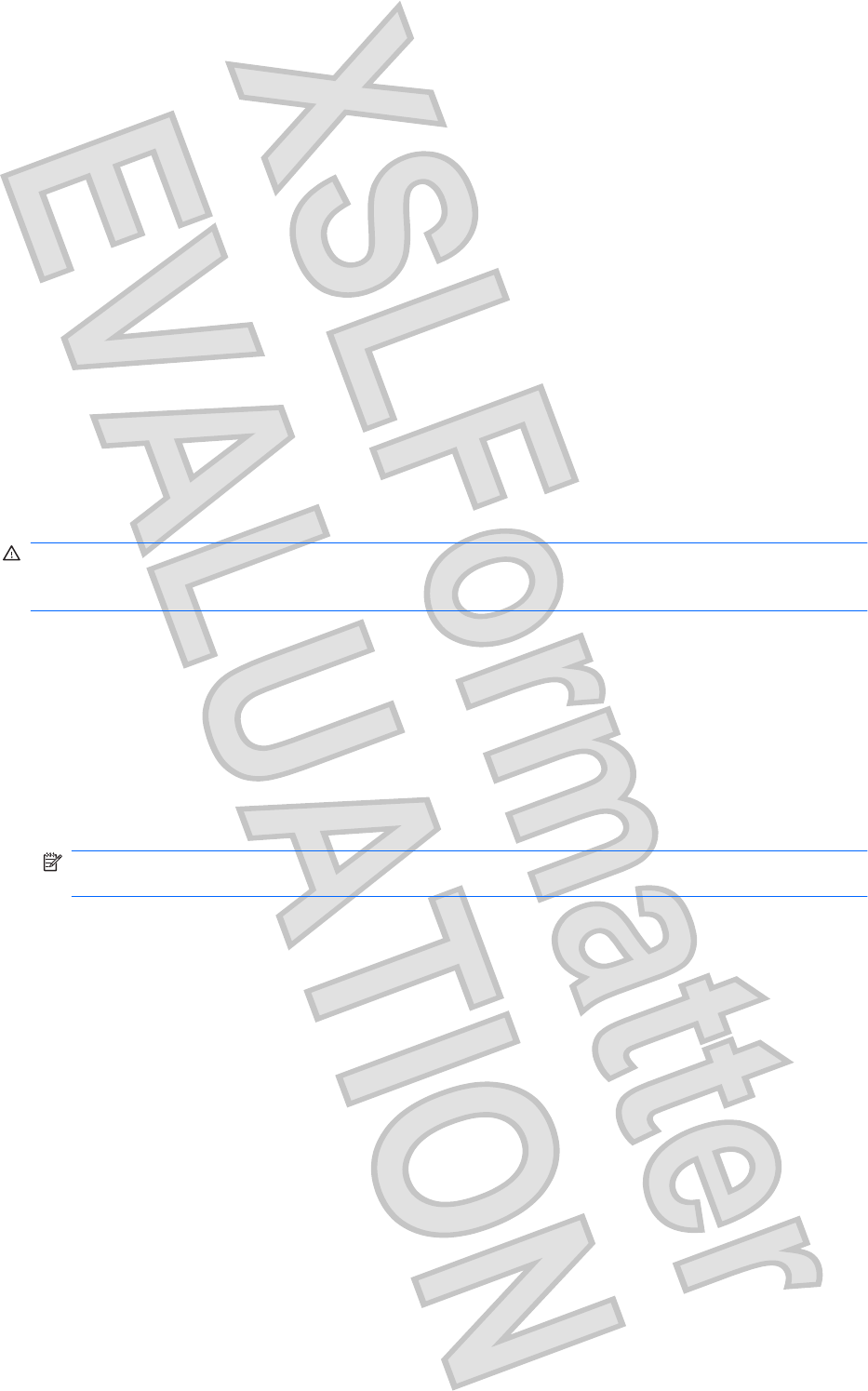
Audio
Your computer enables you to use a variety of audio features:
łPlay music using your computer speakers and/or connected external speakers
łControl the bass with the Beats Audio feature (fn+b)
łRecord sound using the internal microphone or connect an external microphone
łDownload music from the Internet
łCreate multimedia presentations using audio and images
łTransmit sound and images with instant messaging programs
łStream radio programs
łCreate (burn) audio CDs with an optional optical drive
Connecting external audio devices
WARNING! To reduce the risk of personal injury, adjust the volume before putting on headphones,
earbuds, or a headset. For additional safety information, refer to the Regulatory, Safety and
Environmental Notices.
To connect external devices such as external speakers, headphones, earbuds, a headset, television
audio, or a headset microphone, refer to the information provided with the device. For best results,
remember the following tips:
łBe sure that the device cable has a 4-conductor connector that supports both audio-out
(headphone) and audio-in (microphone).
łBe sure that the device cable is securely connected to the correct jack on your computer.
łBe sure to install any drivers required by the external device.
NOTE: A driver is a required program that acts like a translator between the device and the
programs that use the device.
Checking your audio functions
To check the system sound on your computer, follow these steps:
1. Select Start > Control Panel.
2. Click Hardware and Sound.
3. Click Sound.
4. When the Sound window opens, click the Sounds tab. Under Program Events, select any sound
event, such as a beep or alarm, and click the Test button.
You should hear sound through the speakers or through connected headphones.
38 Chapter 5 Multimedia
Antenna House XSL Formatter (Evaluation) http://www.antennahouse.com/
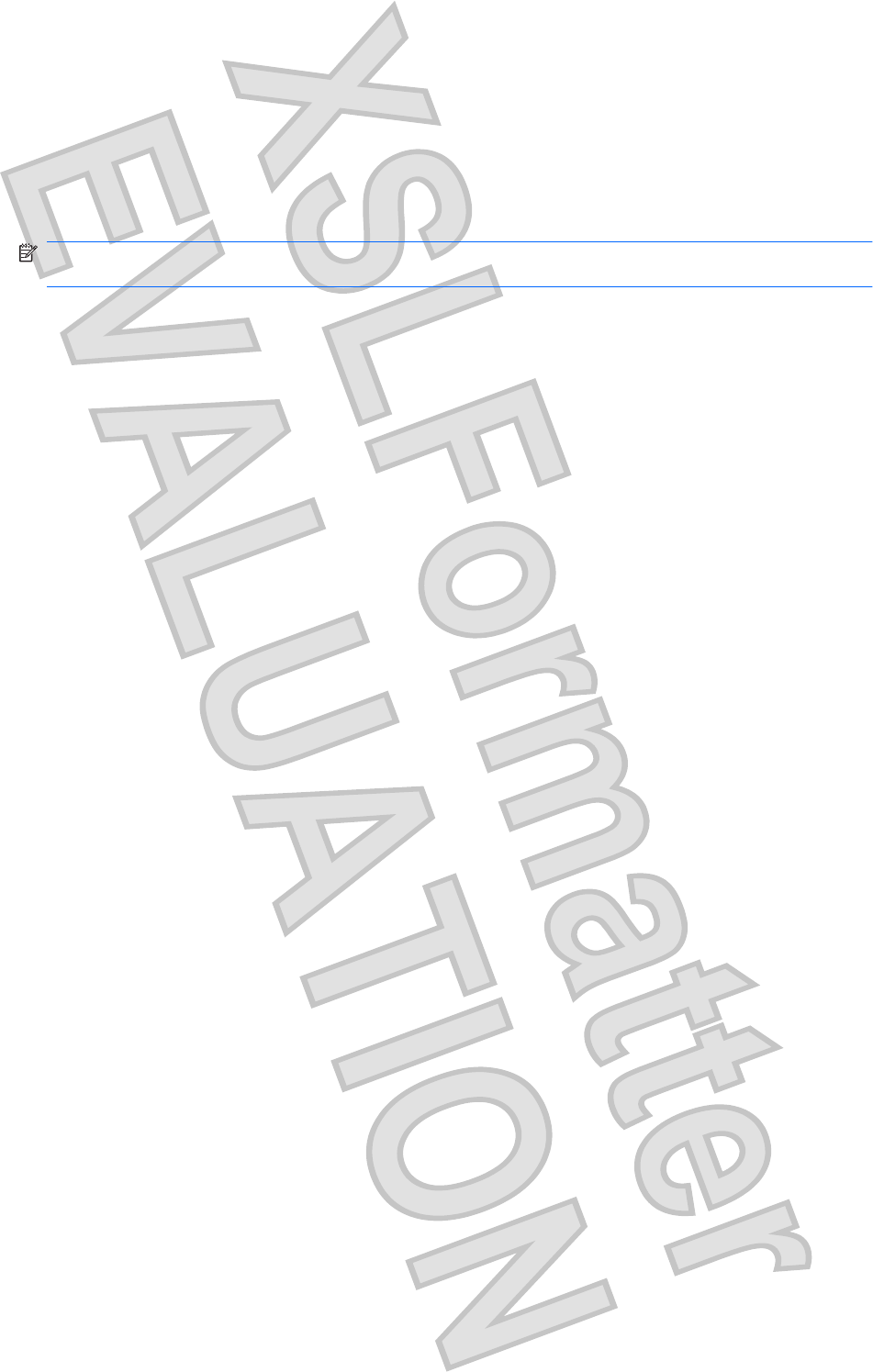
To check the record functions of the computer, follow these steps:
1. Select Start > All Programs > Accessories > Sound Recorder.
2. Click Start Recording and speak into the microphone. Save the file to your desktop.
3. Open Windows Media Player or MediaSmart and play back the sound.
NOTE: For best results when recording, speak directly into the microphone and record sound in a
setting free of background noise.
To confirm or change the audio settings on your computer, select Start > Control Panel > Hardware
and Sound > Sound.
Using Beats Audio
Beats Audio is an enhanced audio profile that provides a deep controlled bass while maintaining a clear
sound. Beats Audio is enabled by default.
⊡
⊡
To increase or decrease the Beats Audio bass settings, press fn+b.
You can also view and control the bass settings through the Windows operating system. Select Start
> Control Panel > Sound > Speakers and Headphone Properties to view and control the bass
properties.
Audio 39
Antenna House XSL Formatter (Evaluation) http://www.antennahouse.com/
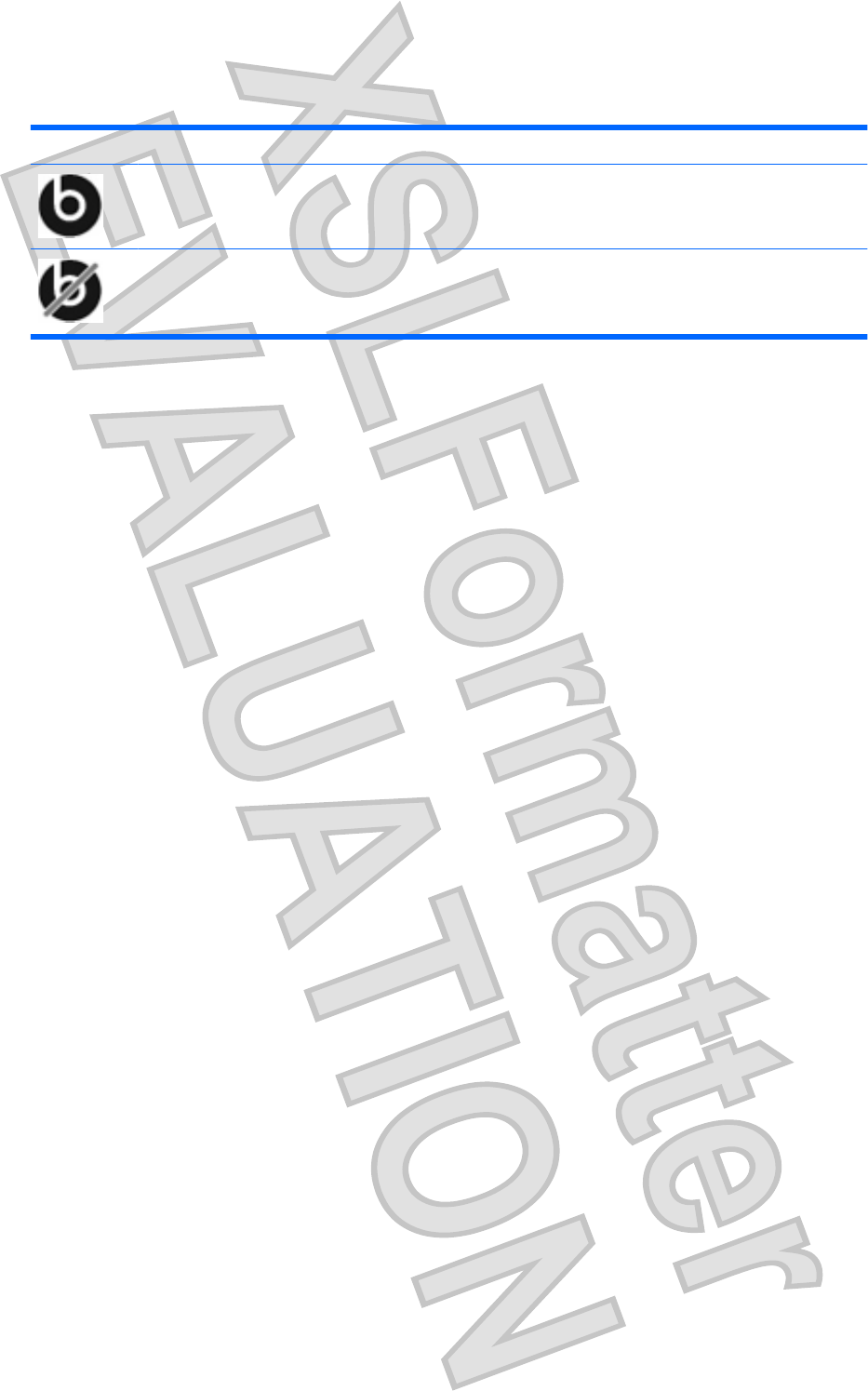
Identifying Beats Audio icons
Icon Name Description
Beats Audio (connected) Indicates that Beats Audio is enabled.
Beats Audio (disconnected) Indicates that Beats Audio is disabled.
40 Chapter 5 Multimedia
Antenna House XSL Formatter (Evaluation) http://www.antennahouse.com/

Video
Your computer enables you to use a variety of video features:
łWatch movies
łPlay games over the Internet
łEdit pictures and video and create presentations
łConnect external video devices
łWatch TV over the Internet
Connecting an external monitor or projector
To connect an external display such as a monitor or projector to the computer, connect the HP HDMI
to VGA Display Adapter (select models only) to the HDMI port on the computer.
The HP HDMI to VGA Display Adapter supports the following resolutions:
ł800 × 600
ł1024 × 768
ł1280 × 720
ł1280 × 800
ł1280 × 1024
ł1400 × 1050
ł1440 × 900
ł1600 × 1200
ł1680 × 1050
ł1920 × 1080
Video 41
Antenna House XSL Formatter (Evaluation) http://www.antennahouse.com/
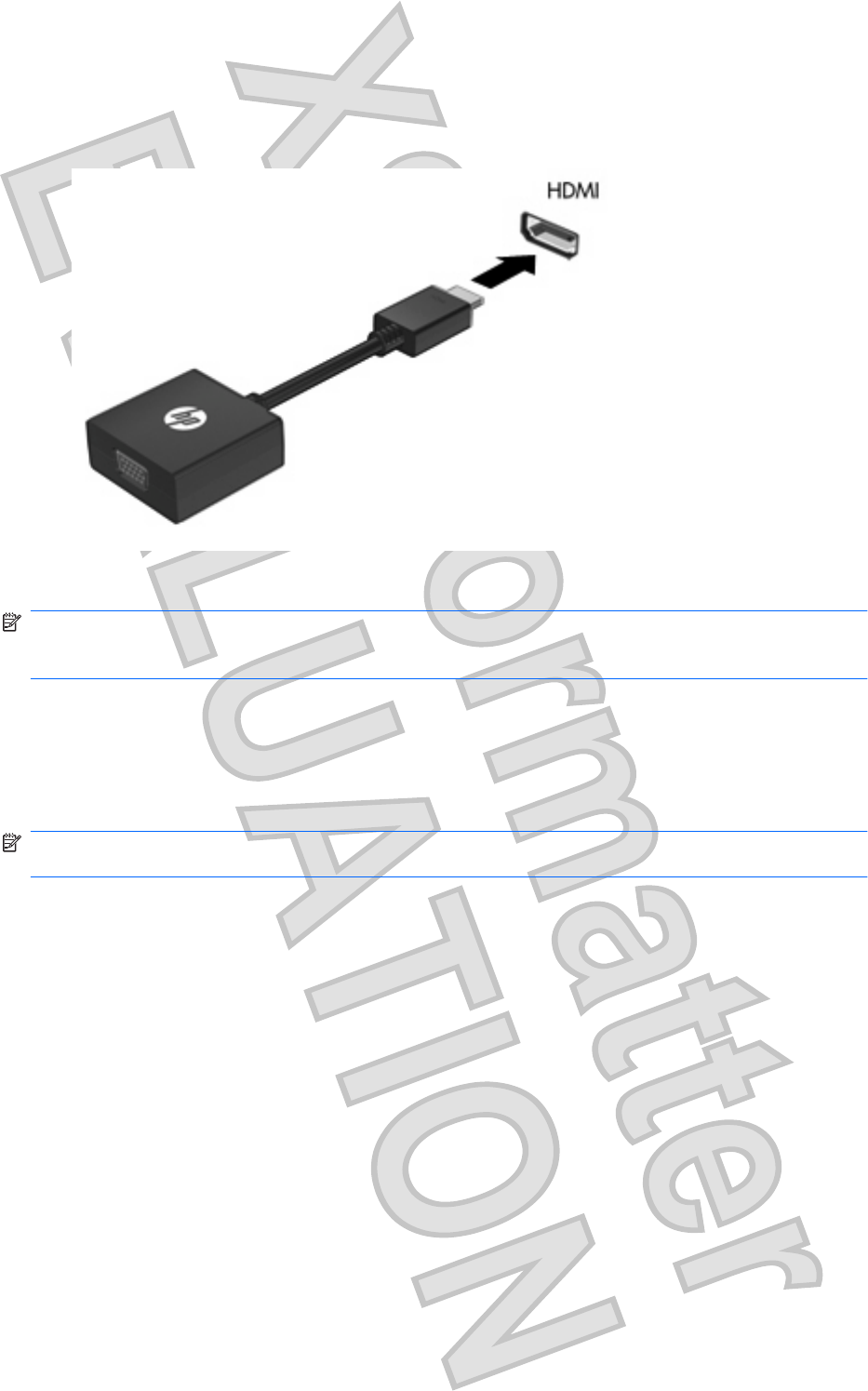
To connect an external monitor or projector using the HDMI to VGA Display Adapter, follow these steps:
1. Connect the HDMI to VGA Display Adapter to the HDMI port on the computer.
2. Connect an external monitor or projector to the other end of the adapter.
NOTE: If a properly connected external display device does not display an image, press the switch
screen image key to transfer the image to the device. Repeatedly pressing the switch screen image key
alternates the screen image between the computer display and the device.
Connecting an HDMI device
The computer includes an HDMI (High Definition Multimedia Interface) port. The HDMI port connects
the computer to an optional video or audio device, such as a high-definition television, or any compatible
digital or audio component.
NOTE: To transmit video signals through the HDMI port, you need an HDMI cable (purchased
separately).
The computer can support one HDMI device connected to the HDMI port, while simultaneously
supporting an image on the computer display or any other supported external display.
42 Chapter 5 Multimedia
Antenna House XSL Formatter (Evaluation) http://www.antennahouse.com/
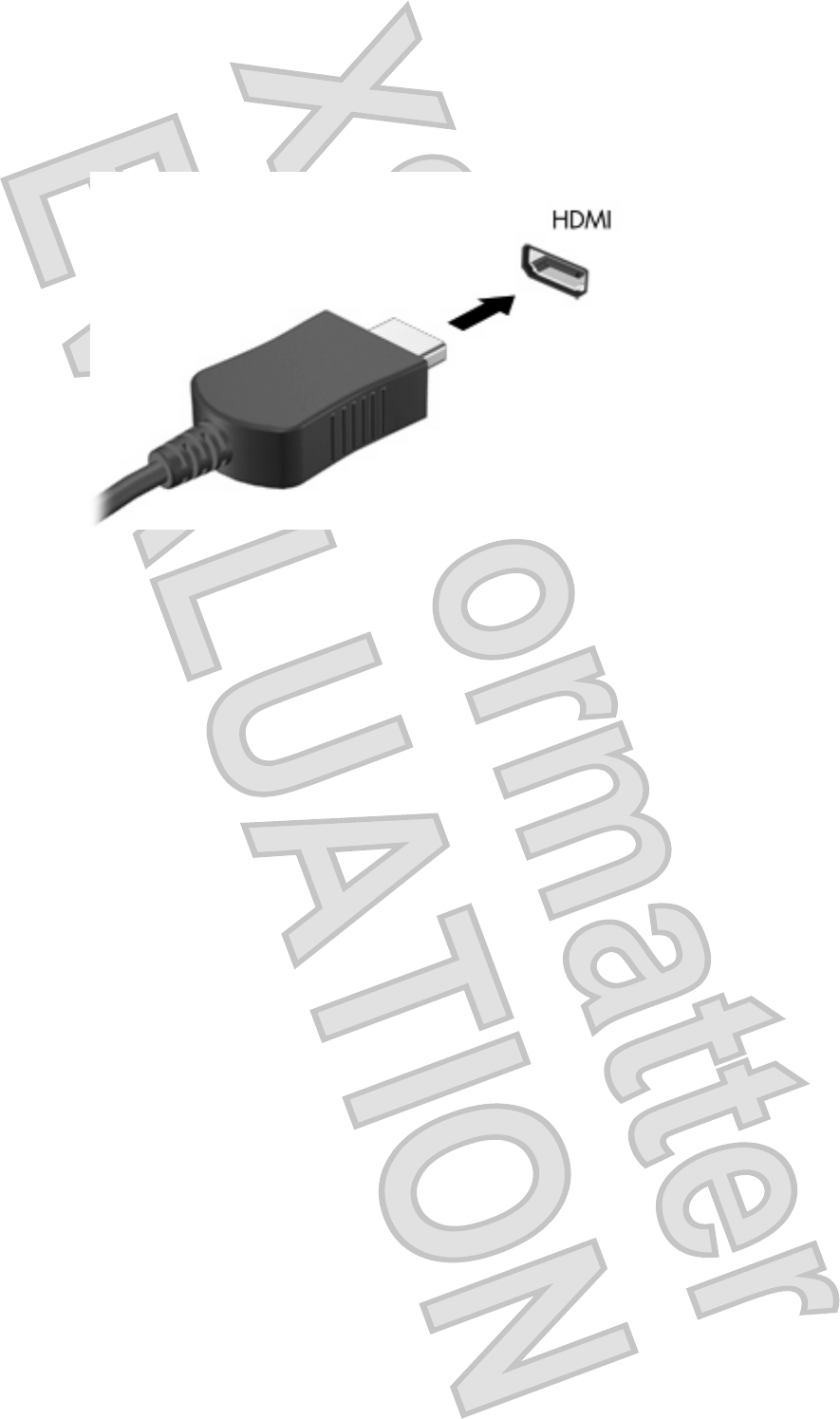
To connect a video or audio device to the HDMI port:
1. Connect one end of the HDMI cable to the HDMI port on the computer.
2. Connect the other end of the cable to the video device, according to the device manufacturer’s
instructions.
3. Press the switch screen image key on the computer to switch the image between the display
devices connected to the computer.
Configuring audio for HDMI
To configure HDMI audio, first connect an audio or video device, such as a high-definition TV, to the
HDMI port on your computer. Then configure the default audio playback device as follows:
1. Right-click the Speakers icon in the notification area, at the far right of the taskbar, and then click
Playback devices.
2. On the Playback tab, click either Digital Output or Digital Output Device (HDMI).
3. Click Set Default, and then click OK.
To return audio to the computer speakers, follow these steps:
1. Right-click the Speakers icon in the notification area, at the far right of the taskbar, and then click
Playback devices.
2. On the Playback tab, click Speakers.
3. Click Set Default, and then click OK.
Video 43
Antenna House XSL Formatter (Evaluation) http://www.antennahouse.com/
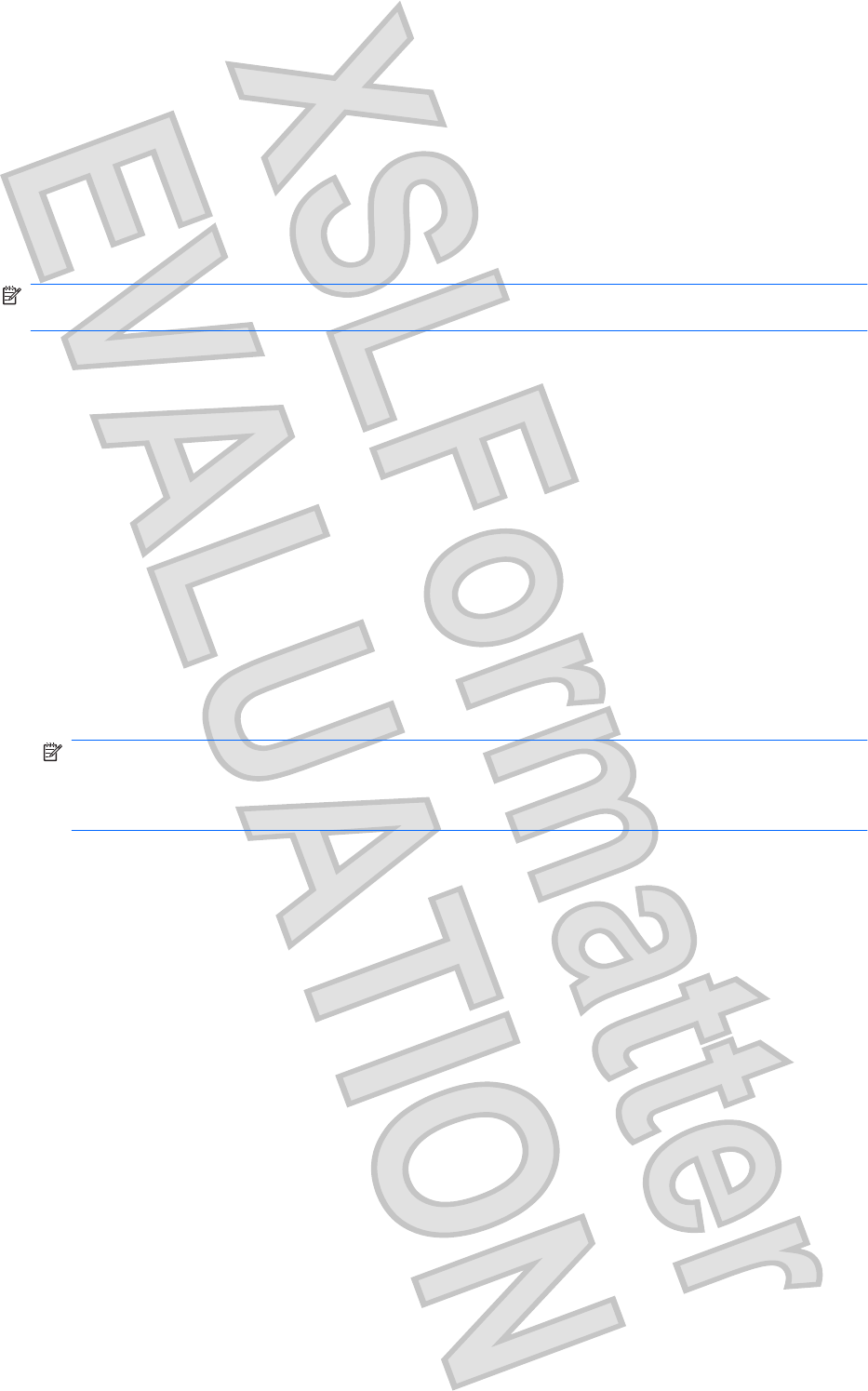
Webcam
Your computer includes an integrated webcam, located at the top of the display. With the preinstalled
software, you can use the webcam to take a photo or record a video. You can preview the photo or video
recording, and save it on your computer hard drive.
To use the webcam, select Start > All Programs > HP > HP MediaSmart > HP MediaSmart
Webcam.
NOTE: For more information on using HP MediaSmart, select Start > Help and Support, and type
MediaSmart in the Search box.
The webcam software enables you to experiment with the following features:
łCapturing and sharing video
łStreaming video with instant message software
łTaking still photos
Webcam tips
For optimum performance, observe the following guidelines while using the integrated webcam:
łBe sure that you have the latest version of an instant message program before attempting a video
conversation.
łYour integrated webcam may not work properly across some network firewalls. If you are having
trouble viewing or sending video to someone on another LAN or outside your network firewall,
contact your Internet service provider for assistance.
NOTE: If you are having trouble viewing or sending multimedia files to someone on another LAN
or outside your network firewall, temporarily disable the firewall, perform the task you want to
perform, and then reenable the firewall. To permanently resolve the problem, reconfigure the
firewall as necessary, and adjust the policies and settings of other intrusion detection systems.
łWhenever possible, place bright light sources behind the webcam and out of the picture area.
Adjusting webcam properties
You can adjust webcam properties using the Properties dialog box, which is accessible from various
programs that use the integrated camera, usually from a configuration, settings, or properties menu:
łBrightness—Controls the amount of light that is incorporated into the image. A higher brightness
setting creates a brighter image; a lower brightness setting creates a darker image.
łContrast—Controls the difference between lighter and darker areas on the image. A higher
contrast setting intensifies the image; a lower contrast setting maintains more of the original
information’s dynamic range but leads to a flatter image.
łHue—Controls the aspect of color that distinguishes it from another color (what makes a color red,
green, or blue). Hue is distinct from saturation, which measures the intensity of the hue.
łSaturation—Controls the strength of color in the final image. A higher saturation setting creates a
bolder image; a lower saturation setting creates a more subtle image.
łSharpness—Controls the definition of edges in an image. A higher sharpness setting creates a
more defined image; a lower sharpness setting creates a softer image.
44 Chapter 5 Multimedia
Antenna House XSL Formatter (Evaluation) http://www.antennahouse.com/

łGamma—Controls the contrast affecting the mid-level grays or midtones of an image. Adjusting
the gamma of an image allows you to change the brightness values of the middle range of gray
tones without dramatically altering the shadows and highlights. A lower gamma setting makes
grays look black, and makes dark colors even darker.
łBacklight Comp—Compensates in cases where a subject with a large amount of background light
would otherwise be obscured by blooming or silhouetting.
For more information about using the webcam, select Start > Help and Support.
Webcam 45
Antenna House XSL Formatter (Evaluation) http://www.antennahouse.com/
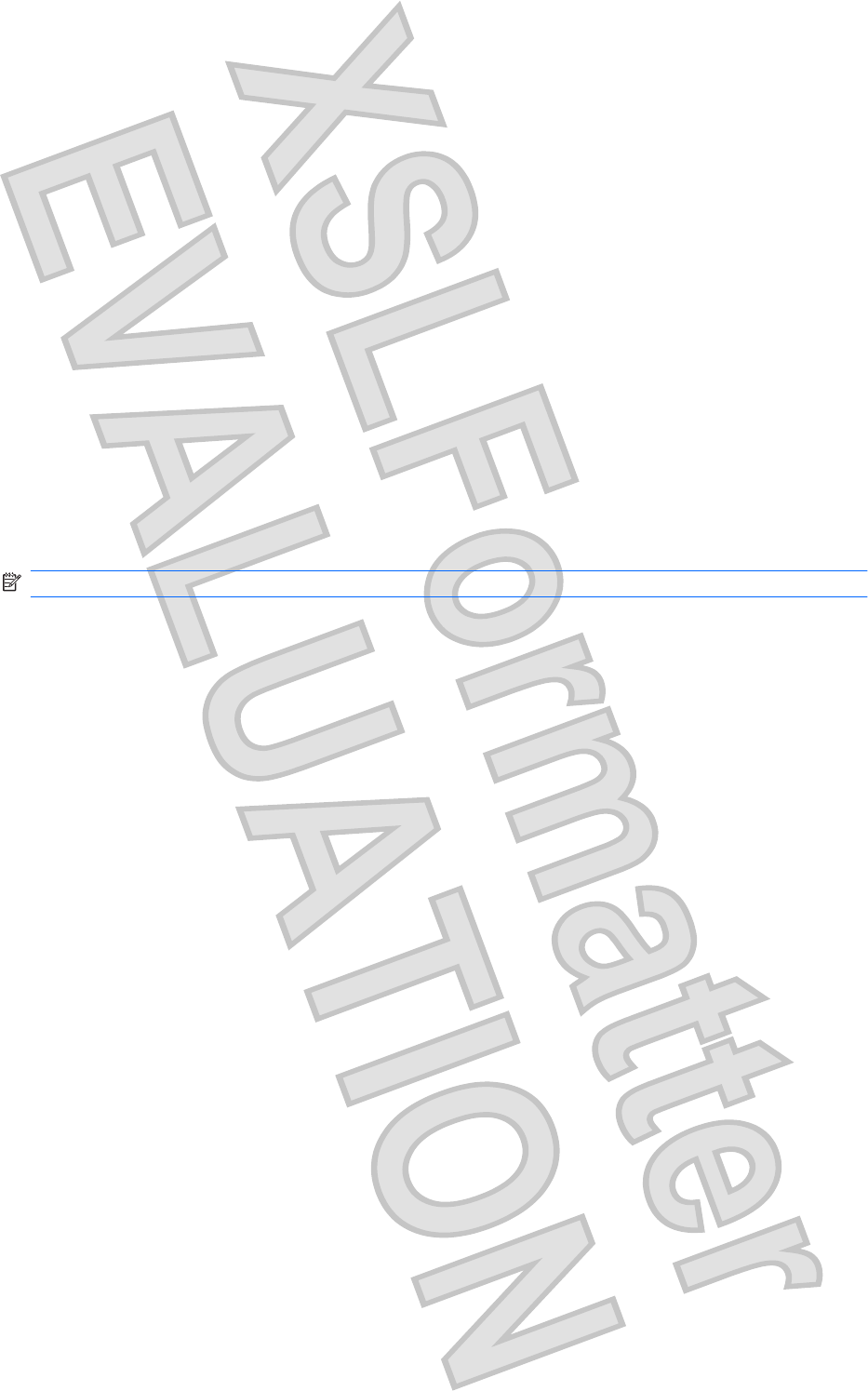
Using the ambient light sensor
The ambient light sensor (ALS) controls the display brightness and the webcam lighting in low-light
conditions. The ambient light sensor includes the following features:
łAdaptive brightness
łWebcam infrared (IR) light
The ambient light sensor is enabled by default. To disable or reenable the ambient light sensor:
1. Select Start > Control Panel > Hardware and Sound > Location and Other Sensors.
2. Select the Microsoft Windows ALS Device check box.
Using adaptive brightness
Adaptive brightness automatically adjusts the screen brightness when the lighting conditions change.
In low-light conditions, adaptive brightness automatically decreases the display brightness. As
surrounding light increases, the display brightness level increases accordingly.
Adaptive brightness is enabled by default. To disable or reenable adaptive brightness:
NOTE: The ambient light sensor must be enabled to use the adaptive brightness feature.
1. Select Start > Control Panel > System and Security > Power Options.
2. Click Change plan setting, and then click Change advanced power settings.
3. Click the plus sign next to Display, and then click the plus sign next to Enable adaptive
brightness.
4. Change the settings as needed, and then click Apply.
5. Click OK.
Using the webcam IR light
The webcam IR light improves the webcam picture quality in low-light conditions. The webcam IR light
turns on automatically when lighting conditions are very low. When the light conditions return to normal,
the webcam IR light turns off automatically.
The webcam IR light behaves in the following ways:
łNormal lighting conditions—There will be no low light compensation and the webcam IR light will
not be activated.
łLow light conditions—The Low Light Compensation function is activated and the picture quality
improves.
łExtreme low light or zero light conditions—The webcam IR light is activated. This allows the
webcam to operate in dark environments. Pictures are in black and white.
The webcam IR light is enabled by default. To disable or reenable the webcam IR light:
1. Select Start > All Programs > HP > HP MediaSmart > HP MediaSmart Webcam.
2. In HP MediaSmart Webcam, select Settings > Display > Advanced Settings, and then click the
Camera Control tab.
46 Chapter 5 Multimedia
Antenna House XSL Formatter (Evaluation) http://www.antennahouse.com/

3. Select the Low Light Compensation check box, and then click Apply.
4. Click OK.
NOTE: The webcam IR light is also available on other webcam programs. Refer to the software
Help for additional information.
Using the ambient light sensor 47
Antenna House XSL Formatter (Evaluation) http://www.antennahouse.com/
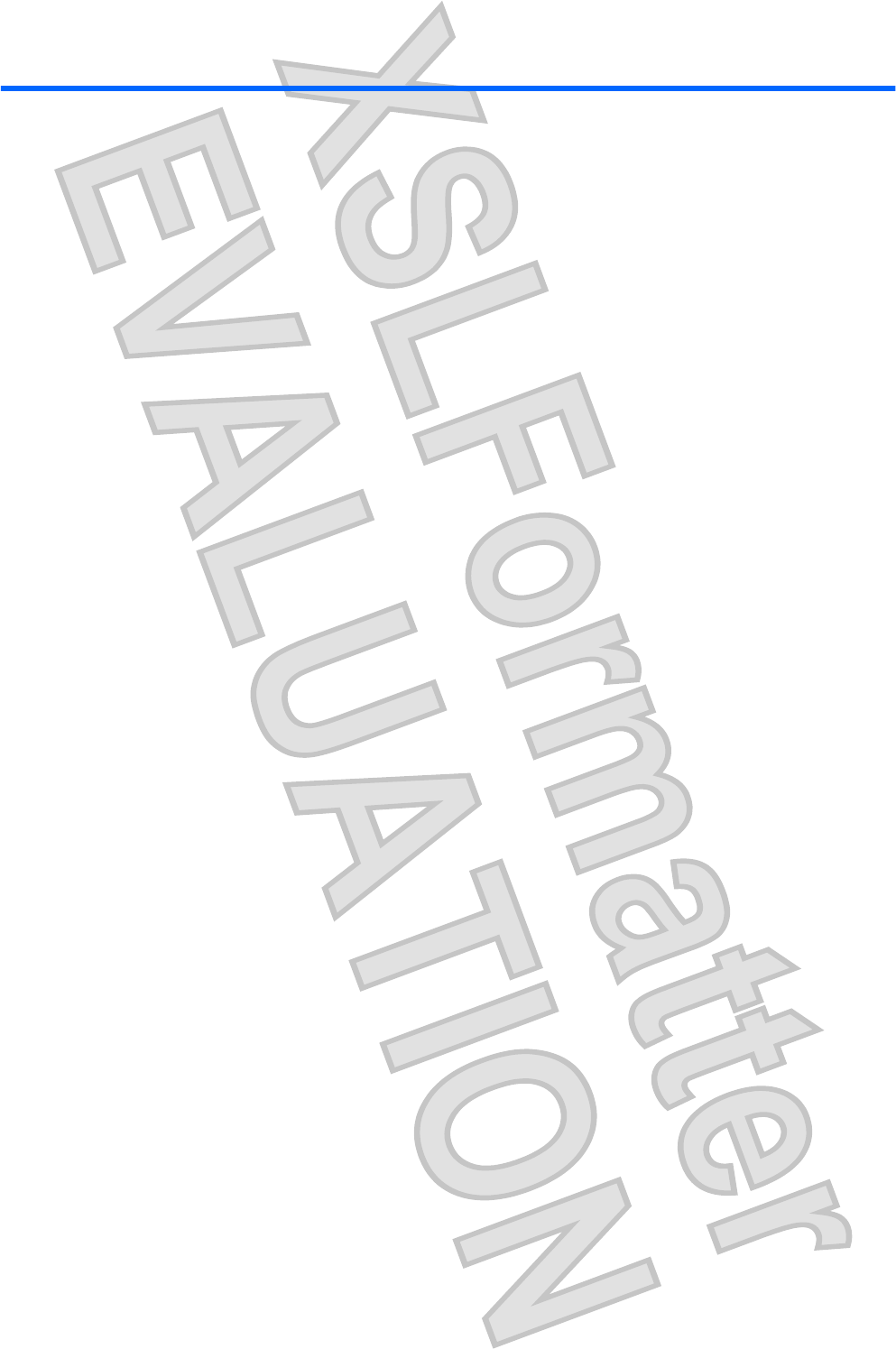
6 Power management
48 Chapter 6 Power management
Antenna House XSL Formatter (Evaluation) http://www.antennahouse.com/
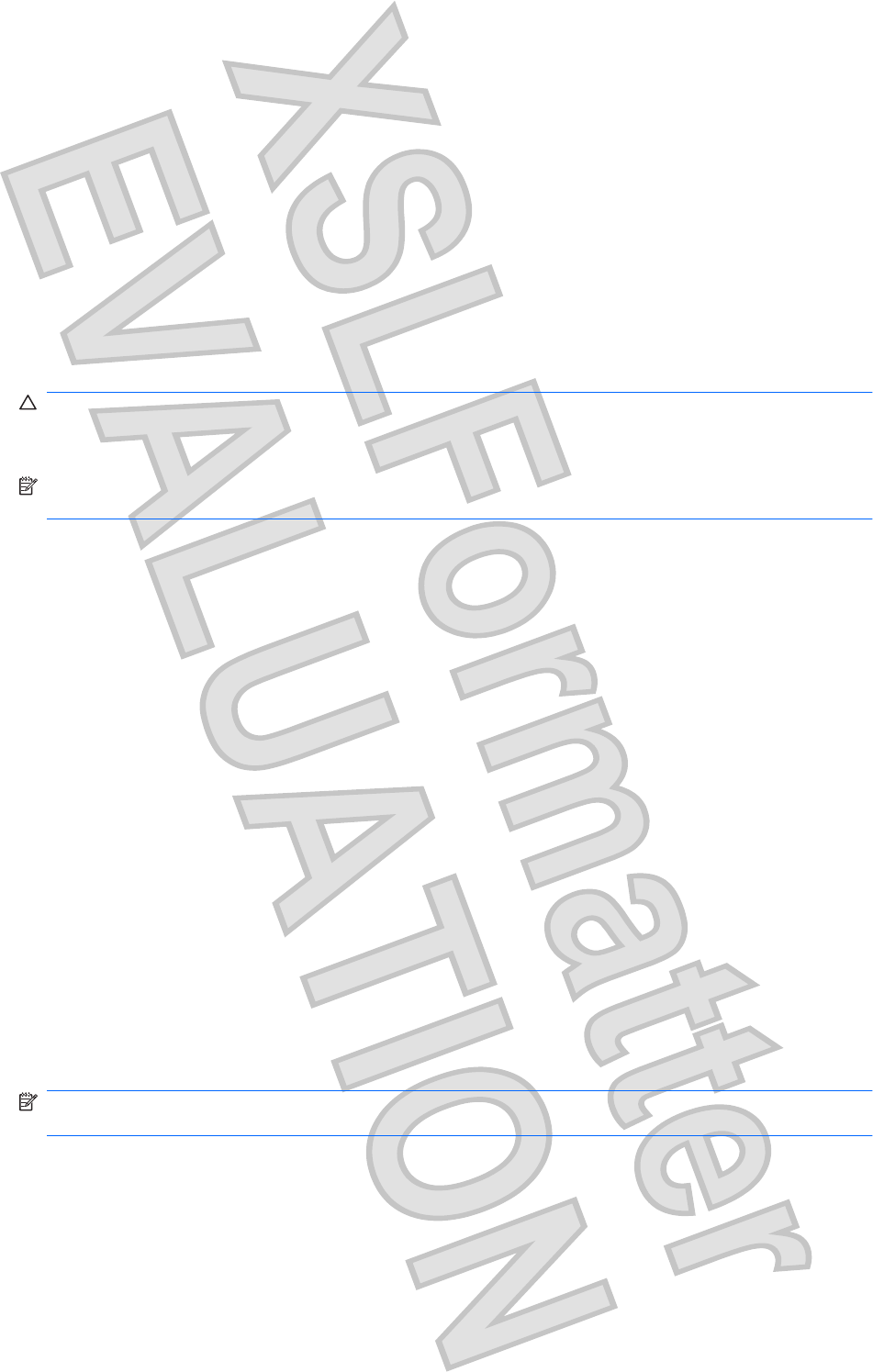
Setting power devices
Using power-saving states
The computer has two power-saving states enabled at the factory: Sleep and Hibernation.
When Sleep is initiated, the power light blinks and the screen clears. Your work is saved to memory,
letting you exit Sleep faster than exiting Hibernation. If the computer is in the Sleep state for an extended
period or if the battery reaches a critical battery level while in the Sleep state, the computer initiates
Hibernation.
When Hibernation is initiated, your work is saved to a hibernation file on the hard drive and the computer
turns off.
CAUTION: To prevent possible audio and video degradation, loss of audio or video playback
functionality, or loss of information, do not initiate Sleep or Hibernation while reading from or writing to
a disc or an external media card.
NOTE: You cannot initiate any type of networking connection or perform any computer functions while
the computer is in the Sleep state or in Hibernation.
Initiating and exiting Sleep
The system is set at the factory to initiate Sleep after 15 minutes of inactivity when running on battery
power and 30 minutes of inactivity when running on external power.
Power settings and timeouts can be changed using Power Options in Windows® Control Panel.
With the computer on, you can initiate Sleep in any of the following ways:
łBriefly press the power button.
łClose the display.
łClick Start, click the arrow next to the Shut down button, and then click Sleep.
You can exit Sleep in any of the following ways:
łBriefly press the power button.
łIf the display is closed, open the display.
łPress a key on the keyboard.
łActivate the TouchPad.
When the computer exits Sleep, the power light turns on and your work returns to the screen where you
stopped working.
NOTE: If you have set a password to be required on wakeup, you must enter your Windows password
before your work will return to the screen.
Initiating and exiting Hibernation
The system is set at the factory to initiate Hibernation after 1,080 minutes (18 hours) of inactivity when
running on battery power, 1,080 minutes (18 hours) of inactivity when running on external power, or
when the battery reaches a critical battery level.
Setting power devices 49
Antenna House XSL Formatter (Evaluation) http://www.antennahouse.com/
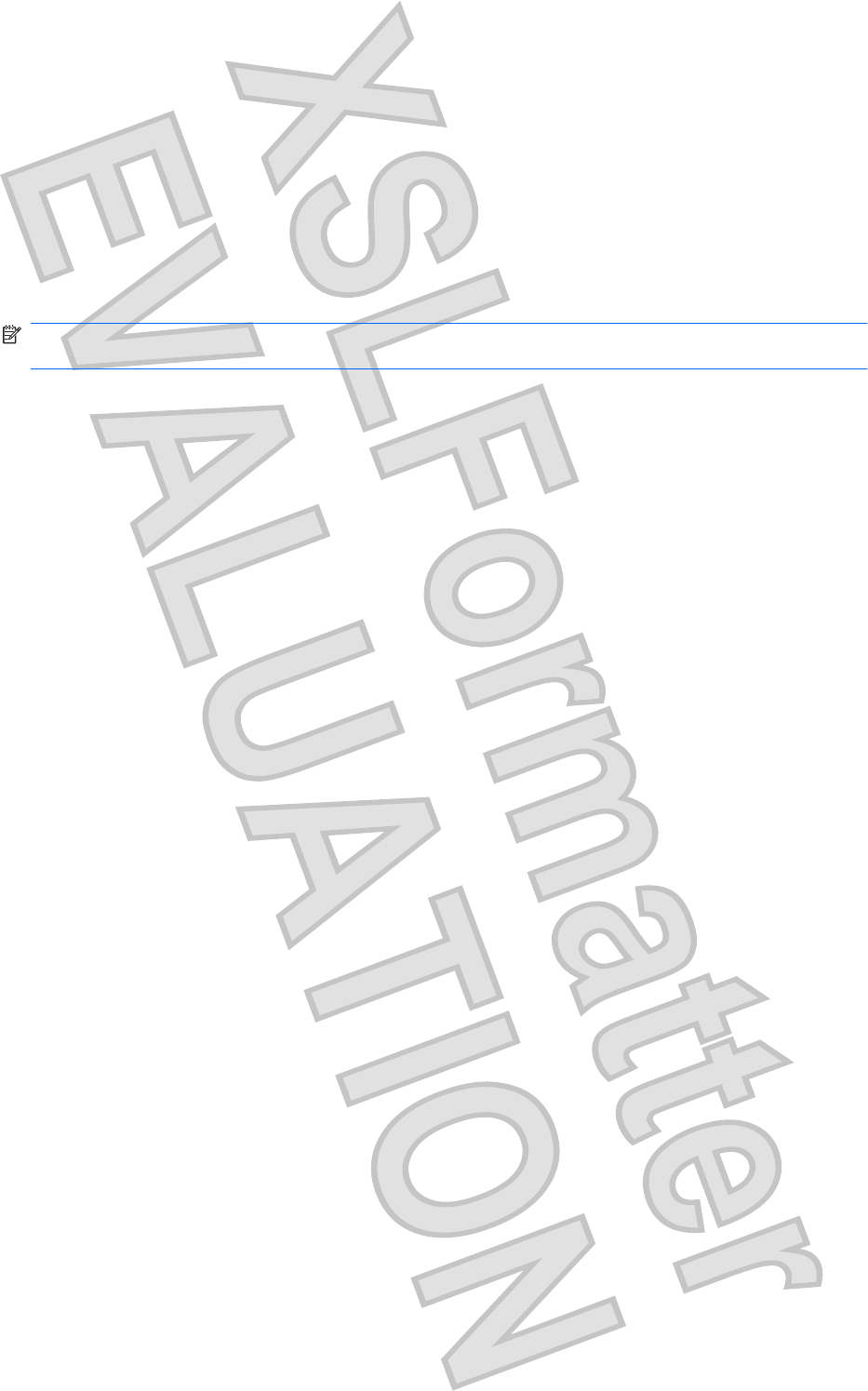
Power settings and timeouts can be changed using Power Options in Windows Control Panel.
To initiate Hibernation:
⊡Click Start, click the arrow next to the Shut down button, and then click Hibernate.
To exit Hibernation:
⊡Briefly press the power button.
The power light turns on and your work returns to the screen where you stopped working.
NOTE: If you have set a password to be required on wakeup, you must enter your Windows password
before your work will return to the screen.
Conserving power
łSelect the Power saver power plan through Power Options under System and Security in
Windows Control Panel.
łTurn off wireless and local area network (LAN) connections and exit modem applications when you
are not using them.
łDisconnect external devices that are not plugged into an external power source, when you are not
using them.
łStop, disable, or remove any external media cards that you are not using.
łUse the screen brightness keys to adjust screen brightness as needed.
łIf you leave your work, initiate Sleep or Hibernation, or shut down the computer.
Using the battery meter
The battery meter is located in the notification area, at the far right of the taskbar. The battery meter
allows you to quickly access power settings, view remaining battery charge, and select a different power
plan.
łTo display the percentage of remaining battery charge and the current power plan, move the pointer
over the battery meter icon.
łTo access Power Options, or to change the power plan, click the battery meter icon and select an
item from the list.
Different battery meter icons indicate whether the computer is running on battery or external power. The
icon also displays a message if the battery has reached a low battery level, critical battery level, or
reserve battery level.
To hide or display the battery meter icon:
1. Right-click the Show hidden icons icon (the arrow at the left side of the notification area).
2. Click Customize notification icons.
3. Under Behaviors, select Show icon and notifications for the Power icon.
4. Click OK.
50 Chapter 6 Power management
Antenna House XSL Formatter (Evaluation) http://www.antennahouse.com/
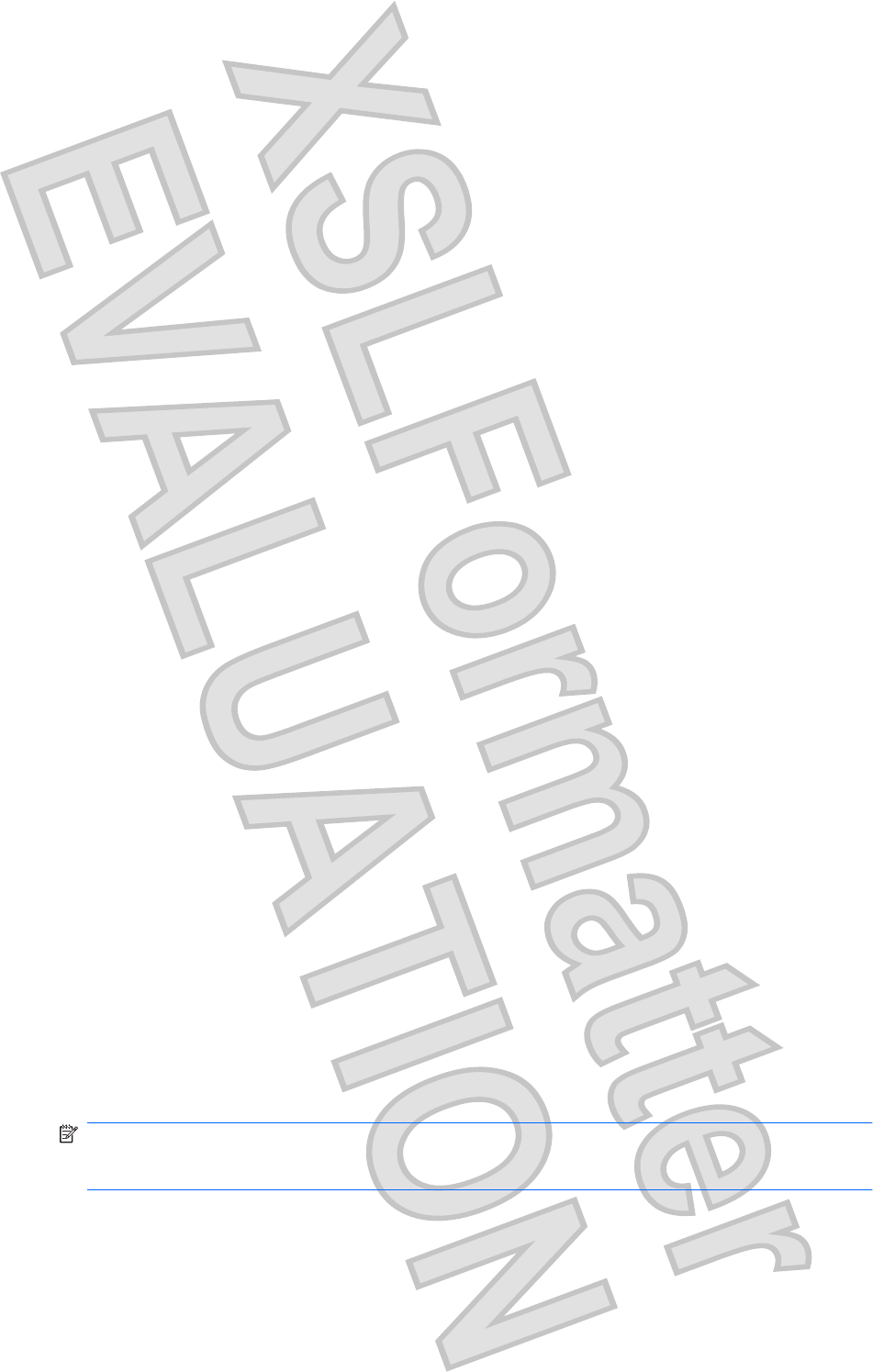
Using power plans
A power plan is a collection of system settings that manages how the computer uses power. Power
plans can help you conserve power or maximize performance.
You can change power plan settings or create your own power plan.
Viewing the current power plan
⊡Click the battery meter icon in the notification area, at the far right of the taskbar.
– or –
Select Start > Control Panel > System and Security > Power Options.
Selecting a different power plan
⊡Click the battery meter icon in the notification area, and then select a power plan from the list.
– or –
Select Start > Control Panel > System and Security > Power Options, and then select a power
plan from the list.
Customizing power plans
1. Click the battery meter icon in the notification area and then click More power options.
– or –
Select Start > Control Panel > System and Security > Power Options.
2. Select a power plan, and then click Change plan settings.
3. Change the settings as needed.
4. To change additional settings, click Change advanced power settings and make your changes.
Setting password protection on wakeup
To set the computer to prompt for a password when the computer exits Sleep or Hibernation, follow
these steps:
1. Select Start > Control Panel > System and Security > Power Options.
2. In the left pane, click Require a password on wakeup.
3. Click Change Settings that are currently unavailable.
4. Click Require a password (recommended).
NOTE: If you need to create a user account password or change your current user account
password, click Create or change your user account password, and then follow the on-screen
instructions. If you do not need to create or change a user account password, go to step 5.
5. Click Save changes.
Setting power devices 51
Antenna House XSL Formatter (Evaluation) http://www.antennahouse.com/
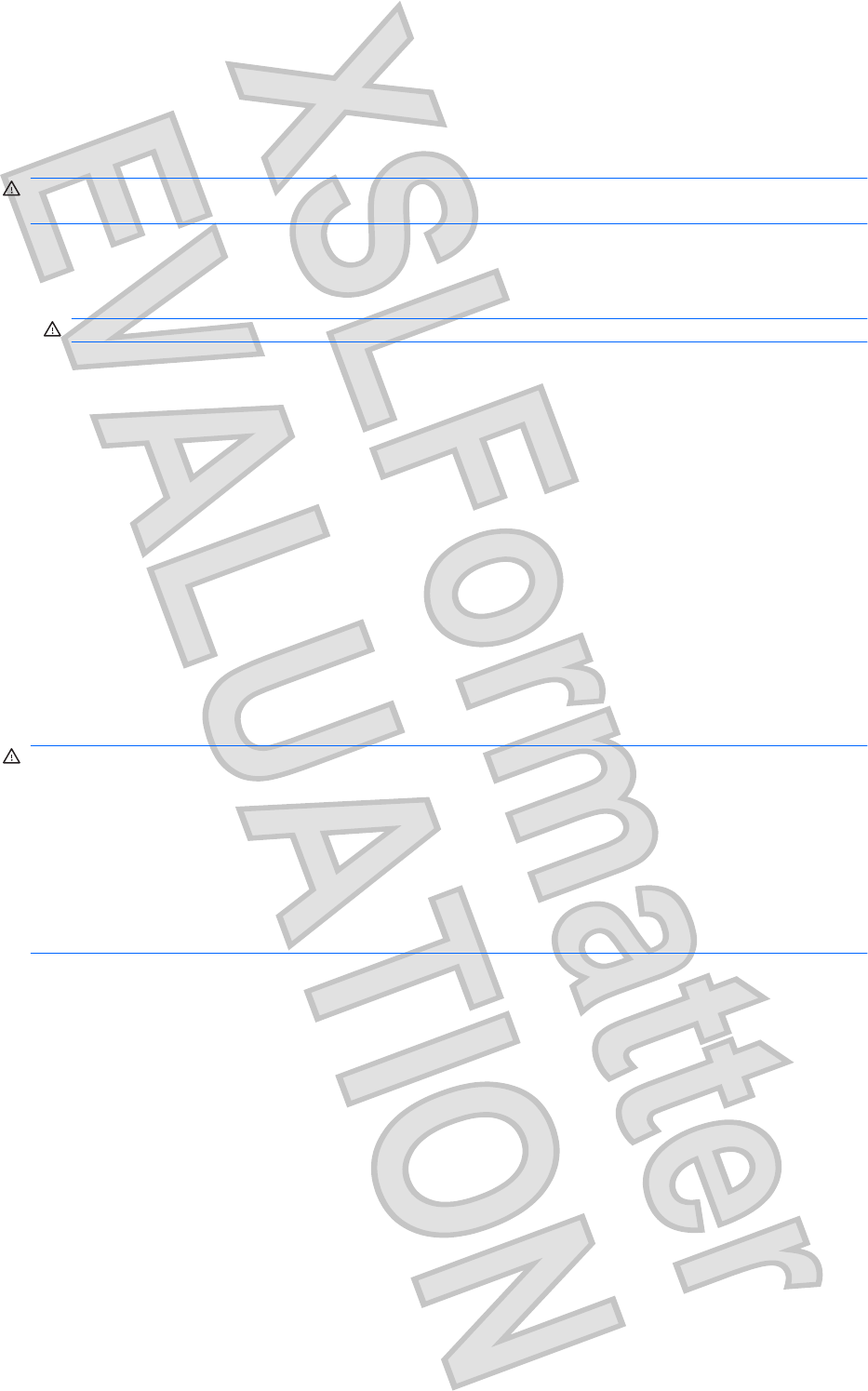
Using external AC power
External AC power is supplied through an approved AC adapter.
WARNING! To reduce potential safety issues, use only the AC adapter provided with the computer,
a replacement AC adapter provided by HP, or a compatible AC adapter purchased from HP.
Connect the computer to external AC power under any of the following conditions:
łWhen you are charging or calibrating a battery
WARNING! Do not charge the computer battery while you are onboard aircraft.
łWhen you are installing or modifying system software
łWhen you are writing information to an optional external CD or DVD
When you connect the computer to external AC power, the following events occur:
łThe battery begins to charge.
łIf the computer is turned on, the battery meter icon in the notification area changes appearance.
When you disconnect external AC power, the following events occur:
łThe computer switches to battery power.
łThe display brightness is automatically decreased to save battery life. To increase display
brightness, press the increase display brightness key or reconnect the AC adapter.
Connecting AC power
WARNING! To reduce the risk of electric shock or damage to the equipment:
Plug the power cord into an AC outlet that is easily accessible at all times.
Disconnect power from the computer by unplugging the power cord from the AC outlet (not by
unplugging the power cord from the computer).
If provided with a 3-pin attachment plug on the power cord, plug the cord into a grounded (earthed) 3-
pin outlet. Do not disable the power cord grounding pin, for example, by attaching a 2-pin adapter. The
grounding pin is an important safety feature.
To connect the computer to external AC power:
1. Plug the adapter into the power connector (1) on the computer.
2. Plug the power cord into the adapter (2).
52 Chapter 6 Power management
Antenna House XSL Formatter (Evaluation) http://www.antennahouse.com/

3. Plug the other end of the power cord into an AC outlet (3).
Testing an AC adapter
Test the AC adapter if the computer exhibits any of the following symptoms when it is connected to AC
power:
łThe computer will not turn on.
łThe display does not turn on.
łThe power light is off.
To test the AC adapter:
1. Remove the battery from the computer.
2. Connect the AC adapter to the computer, and then plug it into an AC outlet.
3. Turn on the computer.
łIf the power light turns on, the AC adapter is working properly.
łIf the power light remains off, the AC adapter is not functioning and should be replaced.
Contact technical support for information on obtaining a replacement AC power adapter. Select Start
> Help and Support > Get assistance.
Using external AC power 53
Antenna House XSL Formatter (Evaluation) http://www.antennahouse.com/
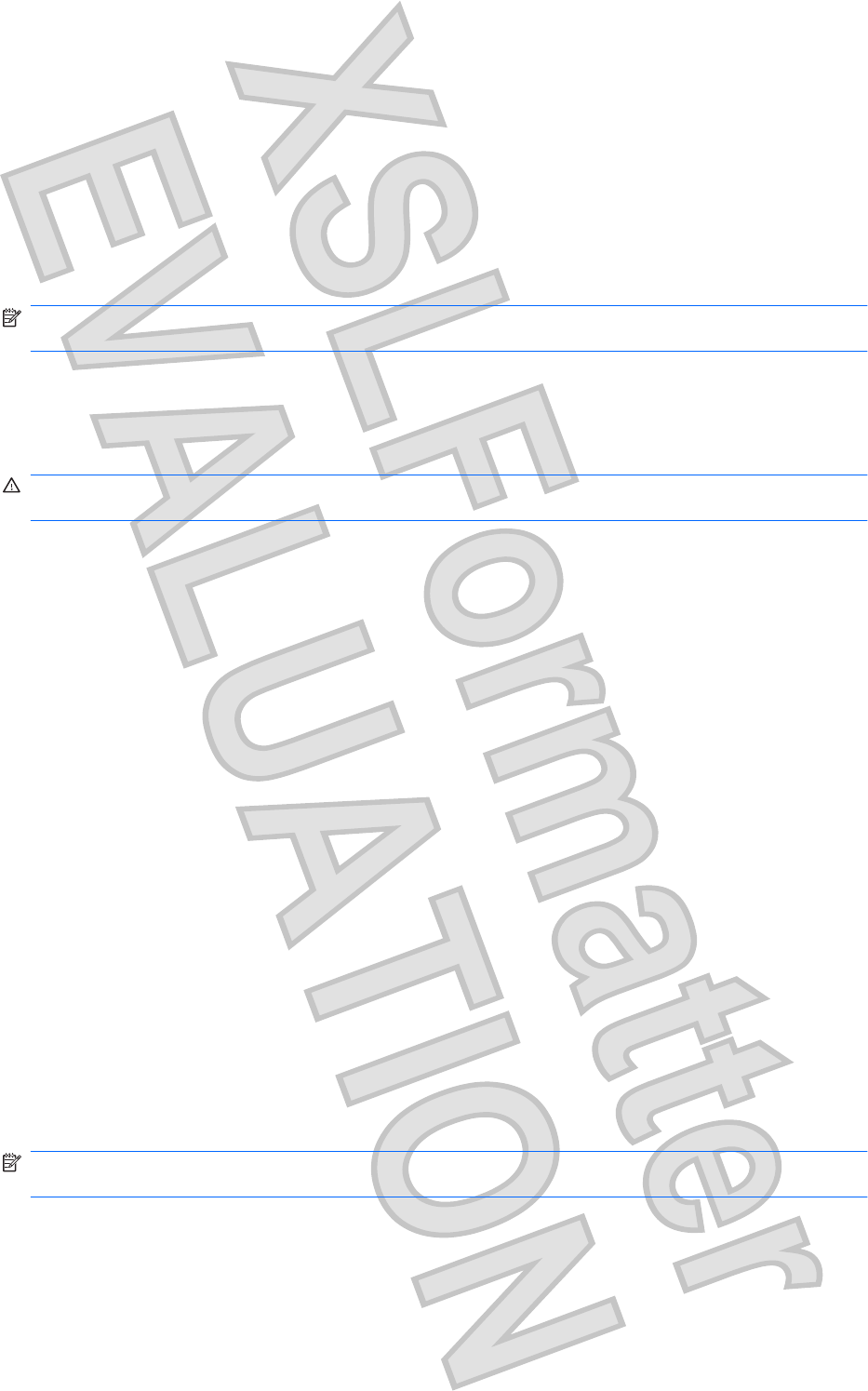
Using battery power
When a charged battery is in the computer and the computer is not plugged into external power, the
computer runs on battery power. When the computer is plugged into external AC power, the computer
runs on AC power.
If the computer contains a charged battery and is running on external AC power supplied through the
AC adapter, the computer switches to battery power if the AC adapter is disconnected from the
computer.
NOTE: The display brightness is decreased to save battery life when you disconnect AC power. To
increase display brightness, press the increase screen brightness key or reconnect the AC adapter.
You can keep a battery in the computer or in storage, depending on how you work. Keeping the battery
in the computer whenever the computer is plugged into AC power charges the battery and also protects
your work in case of a power outage. However, a battery in the computer slowly discharges when the
computer is off and unplugged from external power.
WARNING! To reduce potential safety issues, use only the battery provided with the computer, a
replacement battery provided by HP, or a compatible battery purchased from HP.
Computer battery life varies, depending on power management settings, programs running on the
computer, display brightness, external devices connected to the computer, and other factors.
Identifying batteries
The computer can support 2 batteries:
łOne lithium-ion primary battery is included with the computer and is installed at the factory.
łAn optional accessory battery (purchased separately) can be attached to the bottom of the
computer in addition to the primary battery.
Finding battery information in Help and Support
Help and Support provides the following tools and information about the battery:
łBattery Check tool to test battery performance
łInformation on calibration, power management, and proper care and storage to maximize battery
life
łInformation on battery types, specifications, life cycles, and capacity
To access battery information:
⊡
⊡
Select Start > Help and Support > Learn > Power Plans: Frequently Asked Questions.
Using Battery Check
NOTE: Battery Check can be performed only on the primary battery. Remove any additional batteries
before performing Battery Check
Help and Support provides information on the status of the battery installed in the computer.
54 Chapter 6 Power management
Antenna House XSL Formatter (Evaluation) http://www.antennahouse.com/
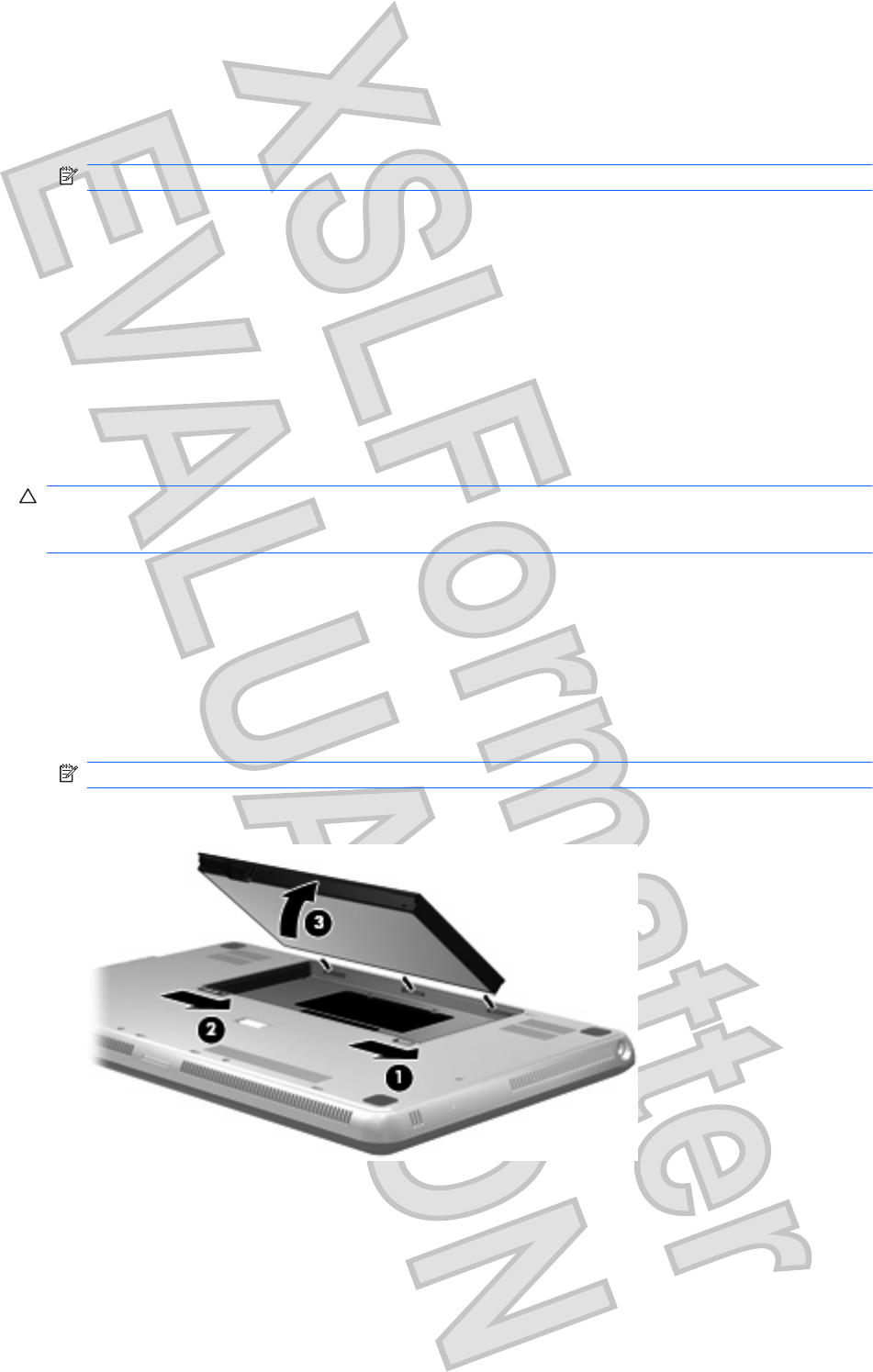
To run Battery Check:
1. Connect the AC adapter to the computer.
NOTE: The computer must be connected to external power for Battery Check to function properly.
2. Select Start > Help and Support > Troubleshoot > Power, Thermal and Mechanical.
3. Click the Power tab, and then click Battery Check.
Battery Check examines the battery and its cells to see if they are functioning properly, and then reports
the results of the examination.
Displaying the remaining battery charge
⊡
⊡
Move the pointer over the battery meter icon in the notification area, at the far right of the taskbar.
Removing or inserting the primary battery
CAUTION: Removing a battery that is the sole power source can cause loss of information. To prevent
loss of information, initiate Hibernation or shut down the computer through Windows before removing
the battery.
To remove the primary battery:
1. Shut down the computer and close the display.
2. Turn the computer upside down on a flat surface.
3. Slide the battery lock (1) to the right to unlock the battery.
4. Slide the battery release latch (2) to the right to release the battery.
NOTE: The battery release latch automatically returns to its original position.
5. Raise the battery and remove it from the battery bay (3).
To insert the primary battery:
1. Shut down the computer and close the display.
2. Turn the computer upside down on a flat surface.
Using battery power 55
Antenna House XSL Formatter (Evaluation) http://www.antennahouse.com/

3. Align the tabs on the battery with the notches on the outer edge of the battery bay (1) and lower
the battery into the battery bay until it is seated (2).
4. Slide the battery lock (3) to lock the battery into place.
Charging a battery
WARNING! Do not charge the computer battery while you are onboard aircraft.
The battery charges whenever the computer is plugged into external power through an AC adapter or
an optional power adapter.
The battery charges whether the computer is off or in use, but it charges faster when the computer is
off.
Charging may take longer if a battery is new, has been unused for 2 weeks or more, or is much warmer
or cooler than room temperature.
To prolong battery life and optimize the accuracy of battery charge displays, follow these
recommendations:
łIf you are charging a new battery, charge it fully before turning on the computer.
łCharge the battery until the battery light turns white.
NOTE: If the computer is on while the battery is charging, the battery meter in the notification
area may show 100 percent charge before the battery is fully charged.
łAllow the battery to discharge below 5 percent of a full charge through normal use before charging
it.
łIf the battery has been unused for one month or more, calibrate the battery instead of simply
charging it.
The battery light on the computer displays the following charge status:
łOff: The computer is running on battery power.
łBlinking amber: The battery has reached a low battery level, a critical battery level, or there is a
battery error.
56 Chapter 6 Power management
Antenna House XSL Formatter (Evaluation) http://www.antennahouse.com/
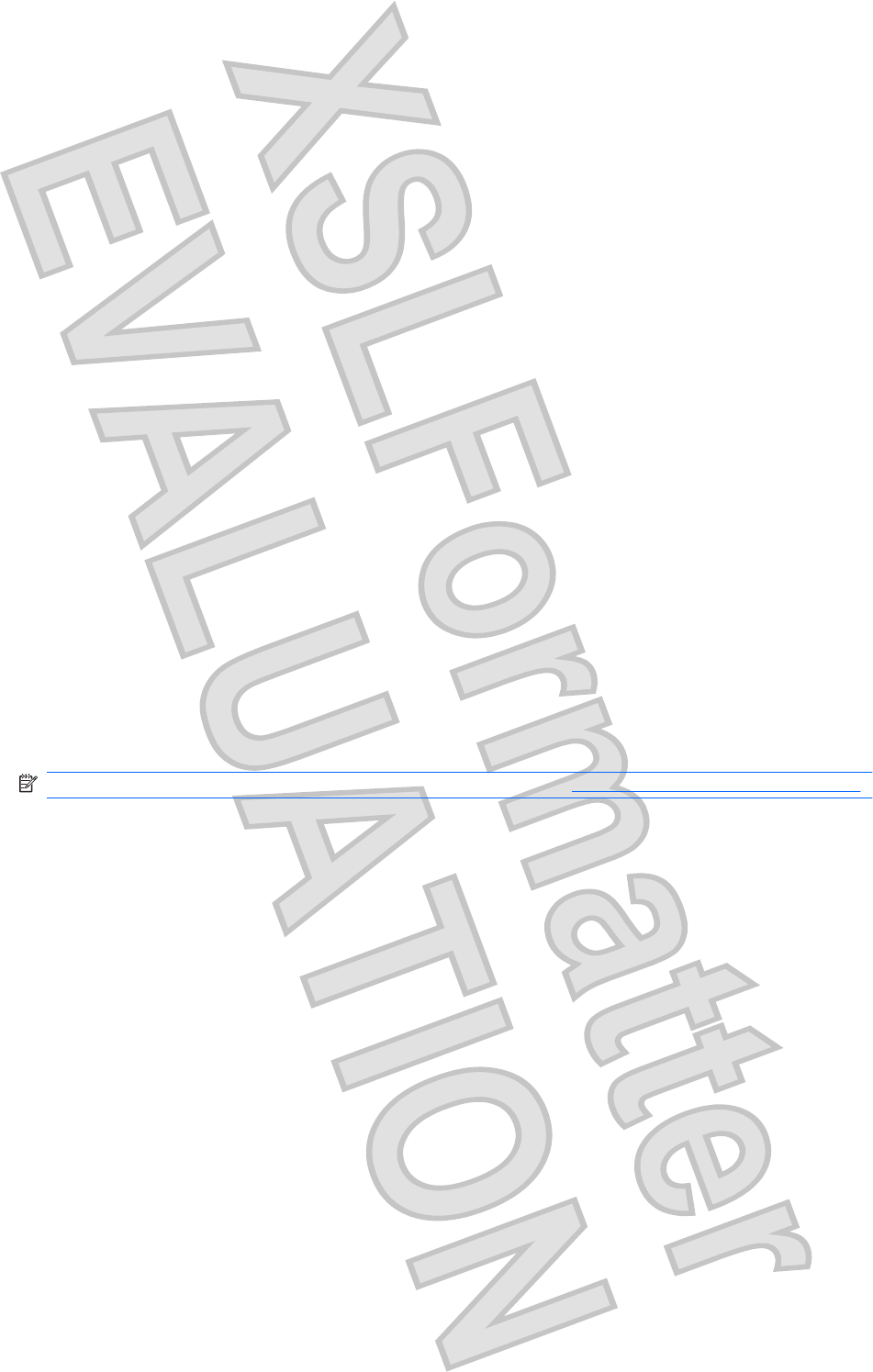
łAmber: The battery is charging.
łWhite: The computer is connected to external power and the battery is fully charged.
Maximizing battery discharge time
Battery discharge time varies depending on the features you use while on battery power. Maximum
discharge time gradually shortens, as the battery storage capacity naturally degrades.
Tips for maximizing battery discharge time:
łLower the brightness on the display.
łCheck the Power saver setting in Power Options.
łRemove the battery from the computer when it is not being used or charged.
łStore the battery in a cool, dry location.
Managing low battery levels
The information in this section describes the alerts and system responses set at the factory. Some low-
battery alerts and system responses can be changed using Power Options in Windows Control Panel.
Preferences set using Power Options do not affect lights.
Identifying low battery levels
When a battery that is the sole power source for the computer reaches a low or critical battery level, the
battery meter icon in the notification area shows a low or critical battery notification.
When the battery reaches a critical battery level, a notification appears above the battery meter icon
that shows how much battery charge remains.
NOTE: For additional information on the battery meter, refer to Using the battery meter on page 50.
The computer takes the following actions for a critical battery level:
łIf Hibernation is enabled and the computer is on or in the Sleep state, the computer initiates
Hibernation.
łIf Hibernation is disabled and the computer is on or in the Sleep state, the computer remains briefly
in the Sleep state, and then shuts down and loses any unsaved information.
Using battery power 57
Antenna House XSL Formatter (Evaluation) http://www.antennahouse.com/
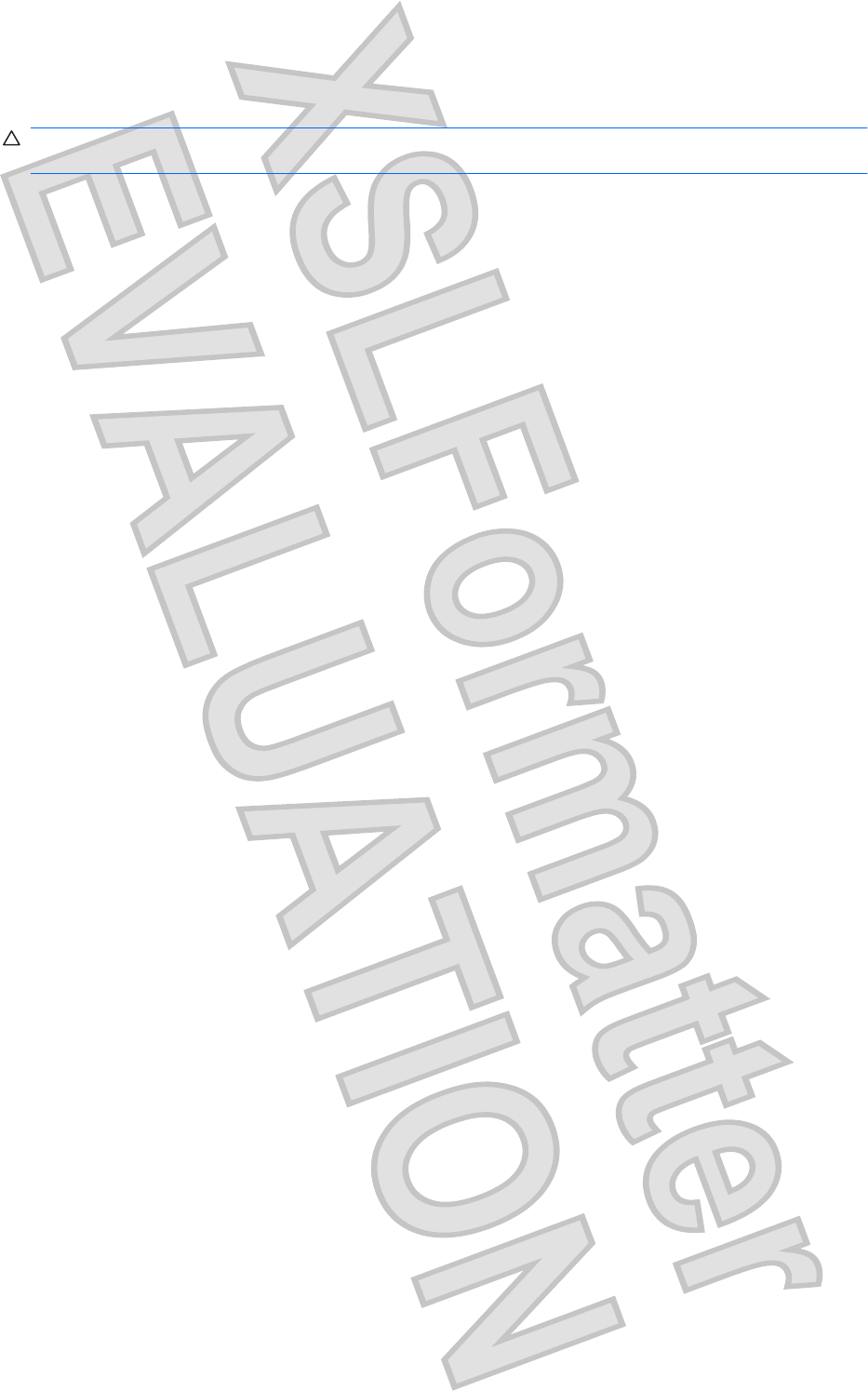
Resolving a low battery level
CAUTION: To reduce the risk of losing information when the computer reaches a critical battery level
and has initiated Hibernation, do not restore power until the power light turns off.
Resolving a low battery level when external power is available
⊡
⊡
Connect one of the following devices:
łAC adapter
łOptional power adapter purchased as an accessory from HP
Resolving a low battery level when a charged battery is available
1. Turn off the computer or initiate Hibernation.
2. Remove the discharged battery, and then insert a charged battery.
3. Turn on the computer.
Resolving a low battery level when no power source is available
⊡Initiate Hibernation.
– or –
Save your work and shut down the computer.
Resolving a low battery level when the computer cannot exit Hibernation
When the computer lacks sufficient power to exit Hibernation, follow these steps:
1. Insert a charged battery or plug the computer into external power.
2. Exit Hibernation by pressing the power button.
Using the accessory battery (select models only)
An accessory battery can add hours of battery life to your computer.
58 Chapter 6 Power management
Antenna House XSL Formatter (Evaluation) http://www.antennahouse.com/
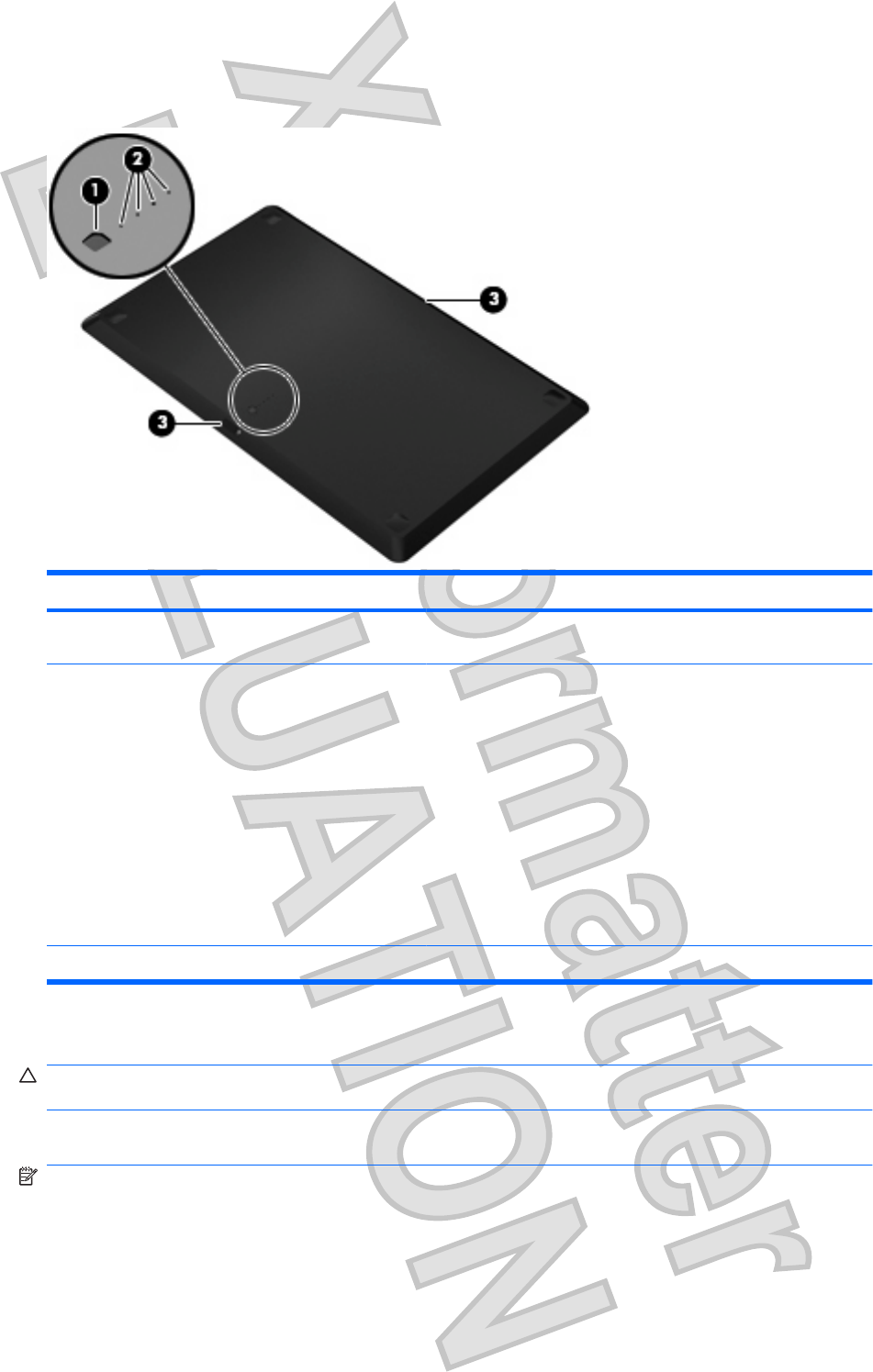
Identifying the accessory battery components
Component Description
(1) Battery fuel gauge When pressed, the battery fuel gauge checks the amount of
available battery charge.
(2) Battery charge lights Show the percentage of available battery power.
łBlinking: The accessory battery has reached a low battery
level.
łOne light on: The accessory battery has 25 percent remaining
battery charge.
łTwo lights on: The accessory battery has 50 percent remaining
battery charge.
łThree lights on: The accessory battery has 75 percent
remaining battery charge.
łFour lights on: The accessory battery is fully charged.
(3) Battery release latches Release the battery from the bottom of the computer.
Inserting or removing an accessory battery
CAUTION: Removing a battery that is the sole power source can cause loss of information. To prevent
loss of information, save your work before removing the battery.
To insert the accessory battery:
NOTE: When you install the accessory for the first time, be sure to remove the protective cover on the
accessory battery connector.
Using battery power 59
Antenna House XSL Formatter (Evaluation) http://www.antennahouse.com/
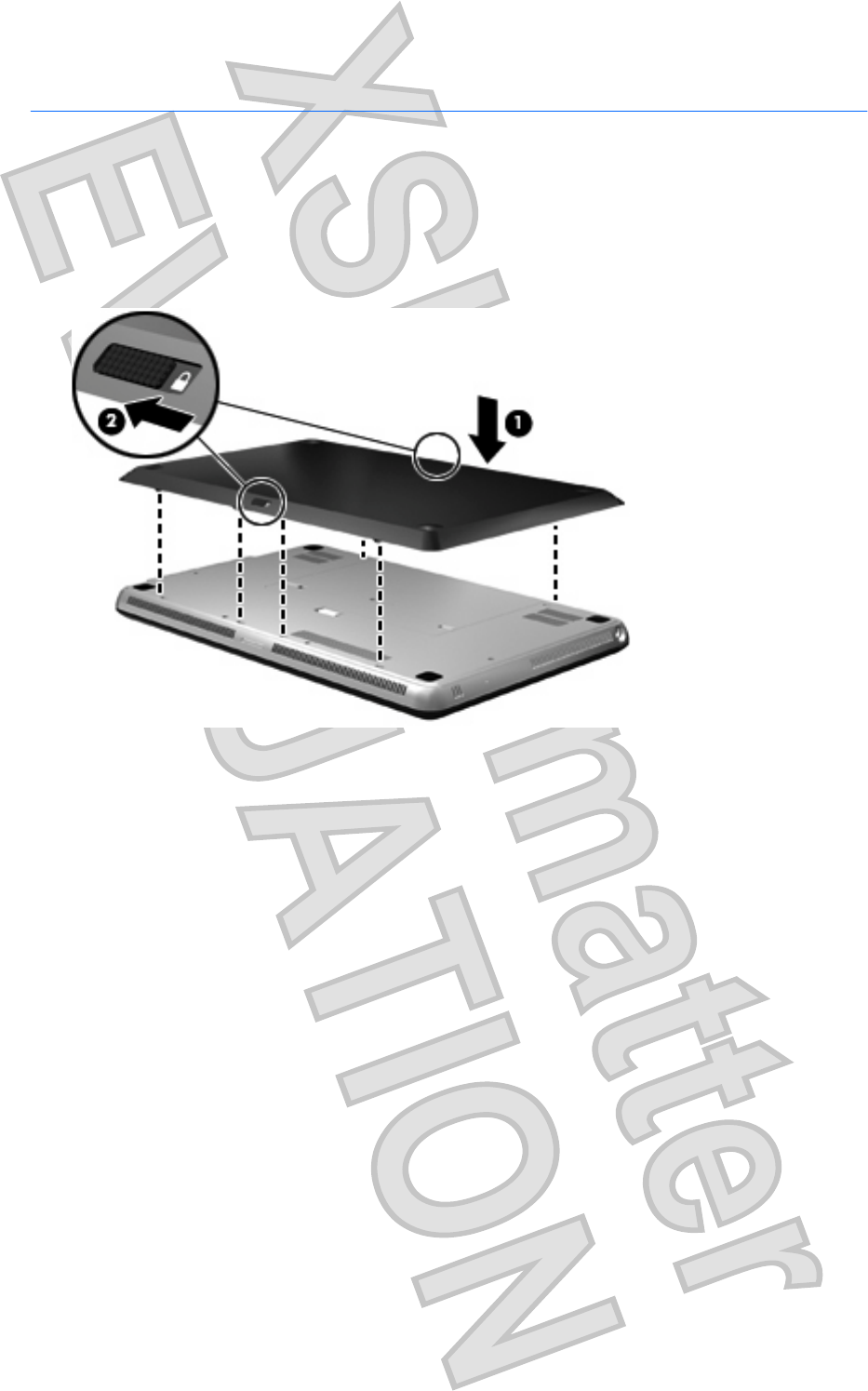
NOTE: It is not necessary to turn off the computer before inserting or removing the accessory battery.
1. Turn the computer upside down on a flat surface, with the battery bay toward you.
2. Align the accessory battery with the bottom of the computer, with the battery fuel gauge toward
you.
3. Press the accessory battery down until it is seated (1).
4. Slide the battery release latches (2) to lock the accessory battery into place on the computer.
To remove the accessory battery:
1. Turn the computer upside down on a flat surface.
2. Slide the battery release latches (1) to release the accessory battery.
60 Chapter 6 Power management
Antenna House XSL Formatter (Evaluation) http://www.antennahouse.com/
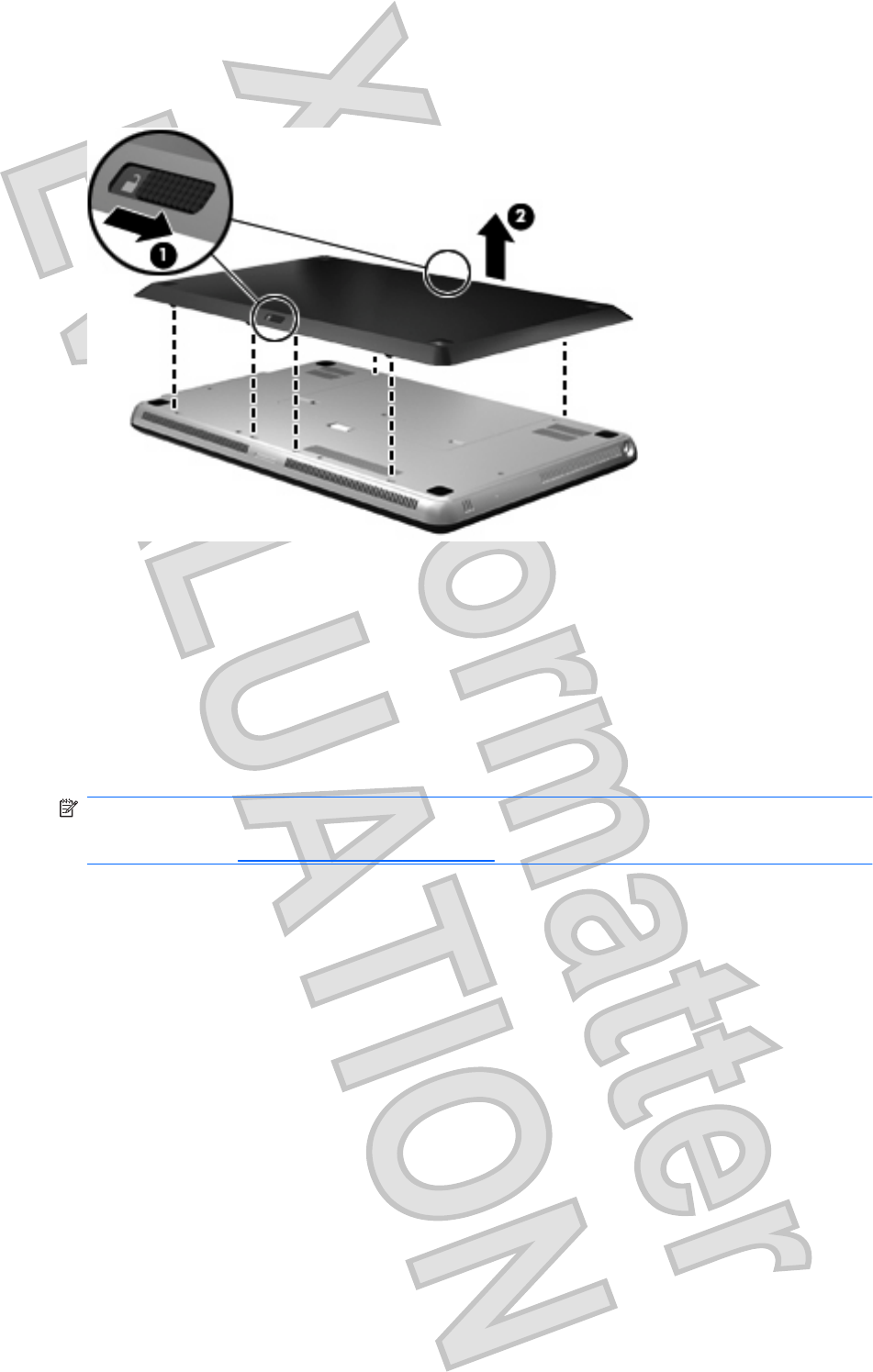
3. Lift the accessory battery from the bottom of the computer (2).
Battery charging and discharging sequence
Battery charging and discharging sequence varies when both the primary battery and optional accessory
battery are installed.
łThe computer supports Fast Charge Mode (enabled at the factory). When both batteries are
charging, the primary battery will charge to 90 percent before the accessory battery begins
charging. Charging is then switched to the accessory battery. When the accessory battery reaches
90 percent, the primary battery will then charge to 100 percent. After the primary battery is
completely charged, the accessory battery will charge to 100 percent.
NOTE: Fast Charge Mode can be disabled in Setup Utility (BIOS). If Fast Charge Mode is
disabled, the primary battery will charge to 100 percent before the accessory battery begins
charging. Refer to Setup Utility (BIOS) on page 93 for additional information.
łWhen the accessory battery reaches a critical battery level, battery power is transferred to the
primary battery.
łThe accessory battery will discharge before the primary battery discharges.
łWhen the accessory battery is removed from the computer, battery power is transferred to the
primary battery.
łWhen the accessory battery is inserted in the computer, battery power is transferred to the
accessory battery.
Calibrating a battery
To maximize battery performance, you should calibrate a battery under the following conditions:
łWhen battery charge displays seem inaccurate
łWhen you observe a significant change in battery run time
Using battery power 61
Antenna House XSL Formatter (Evaluation) http://www.antennahouse.com/
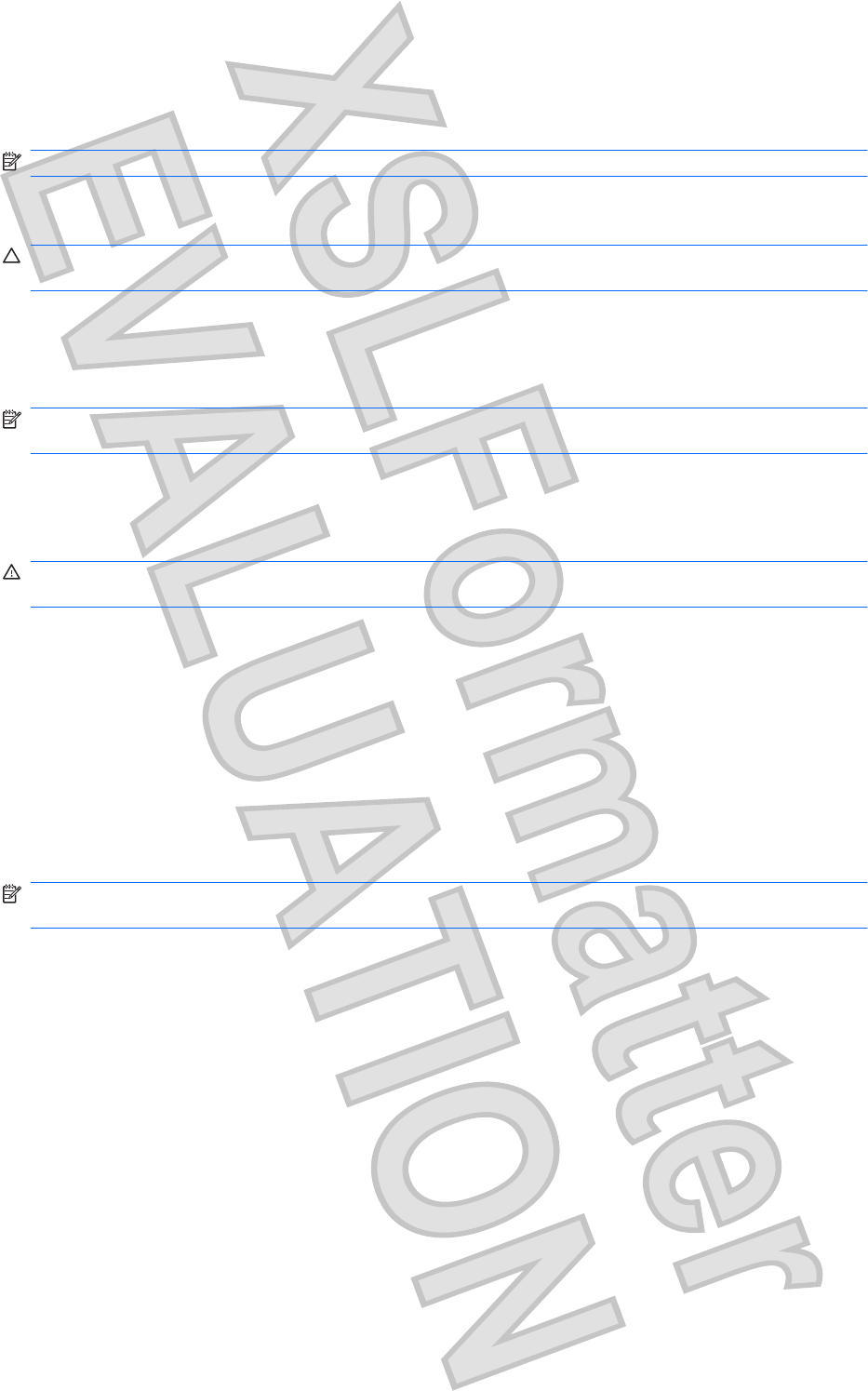
Even if a battery is heavily used, it should not need to be calibrated more than once a month. It is also
not necessary to calibrate a new battery.
NOTE: To calibrate a battery and for additional information, select Start > Help and Support.
Storing a battery
CAUTION: To prevent damage to a battery, do not expose it to high temperatures for extended periods
of time.
If a computer will be unused and unplugged from external power for more than 2 weeks, remove the
battery and store it separately.
To prolong the charge of a stored battery, place it in a cool, dry place.
NOTE: A stored battery should be checked every 6 months. If the capacity is less than 50 percent,
recharge the battery before returning it to storage.
Calibrate a battery before using it if it has been stored for one month or more.
Disposing of a used battery
WARNING! To reduce the risk of fire or burns, do not disassemble, crush, or puncture; do not short
external contacts; do not dispose of in fire or water.
Refer to the Regulatory, Safety and Environmental Notices for proper battery disposal.
Replacing the battery
Computer battery life varies, depending on power management settings, programs running on the
computer, display brightness, external devices connected to the computer, and other factors.
Battery Check notifies you to replace the battery when an internal cell is not charging properly, or when
the battery storage capacity has reached a “weak” condition. A message refers you to the HP Web site
for more information about ordering a replacement battery. If the battery is possibly covered by an HP
warranty, instructions include a warranty ID.
NOTE: To ensure that you always have battery power when you need it, HP recommends purchasing
a new battery when the storage capacity indicator turns green-yellow.
62 Chapter 6 Power management
Antenna House XSL Formatter (Evaluation) http://www.antennahouse.com/
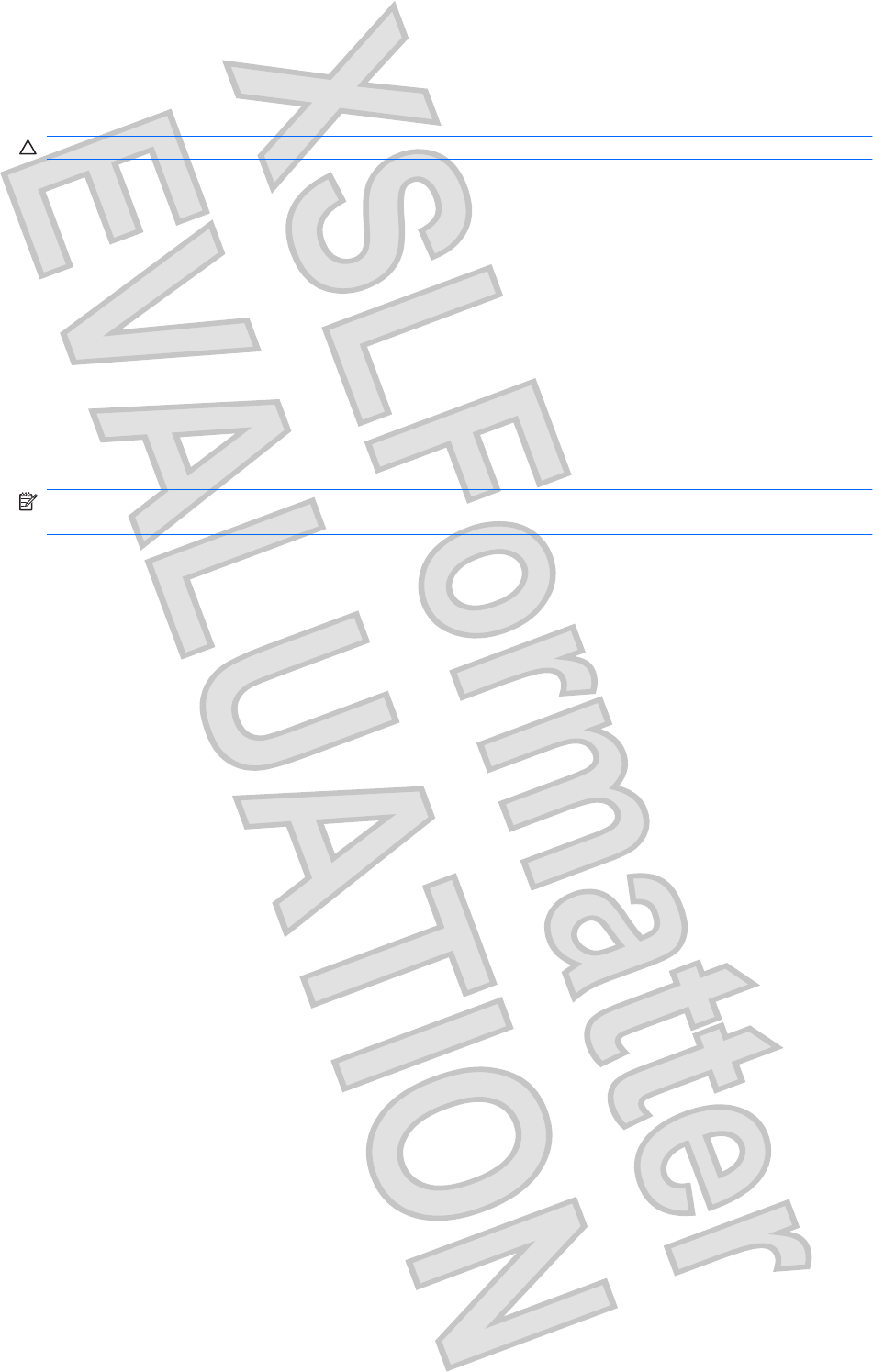
Shutting down the computer
CAUTION: Unsaved information will be lost when the computer is shut down.
The Shut down command closes all open programs, including the operating system, and then turns off
the display and computer.
Shut down the computer under any of the following conditions:
łWhen you need to replace the battery or access components inside the computer
łWhen you are connecting an external hardware device that does not connect to a USB port
łWhen the computer will be unused and disconnected from external power for an extended period
Although you can shut down the computer with the power button, the recommended procedure is to use
the Windows Shut down command.
To shut down the computer:
NOTE: If the computer is in the Sleep state or in Hibernation, you must first exit Sleep or Hibernation
before shutdown is possible.
1. Save your work and close all open programs.
2. Click Start.
3. Click Shut down.
If the computer is unresponsive and you are unable to use the preceding shutdown procedures, try the
following emergency procedures in the sequence provided:
łPress ctrl+alt+delete, and then click the Power button.
łPress and hold the power button for at least 5 seconds.
łDisconnect the computer from external power and remove the battery.
Shutting down the computer 63
Antenna House XSL Formatter (Evaluation) http://www.antennahouse.com/
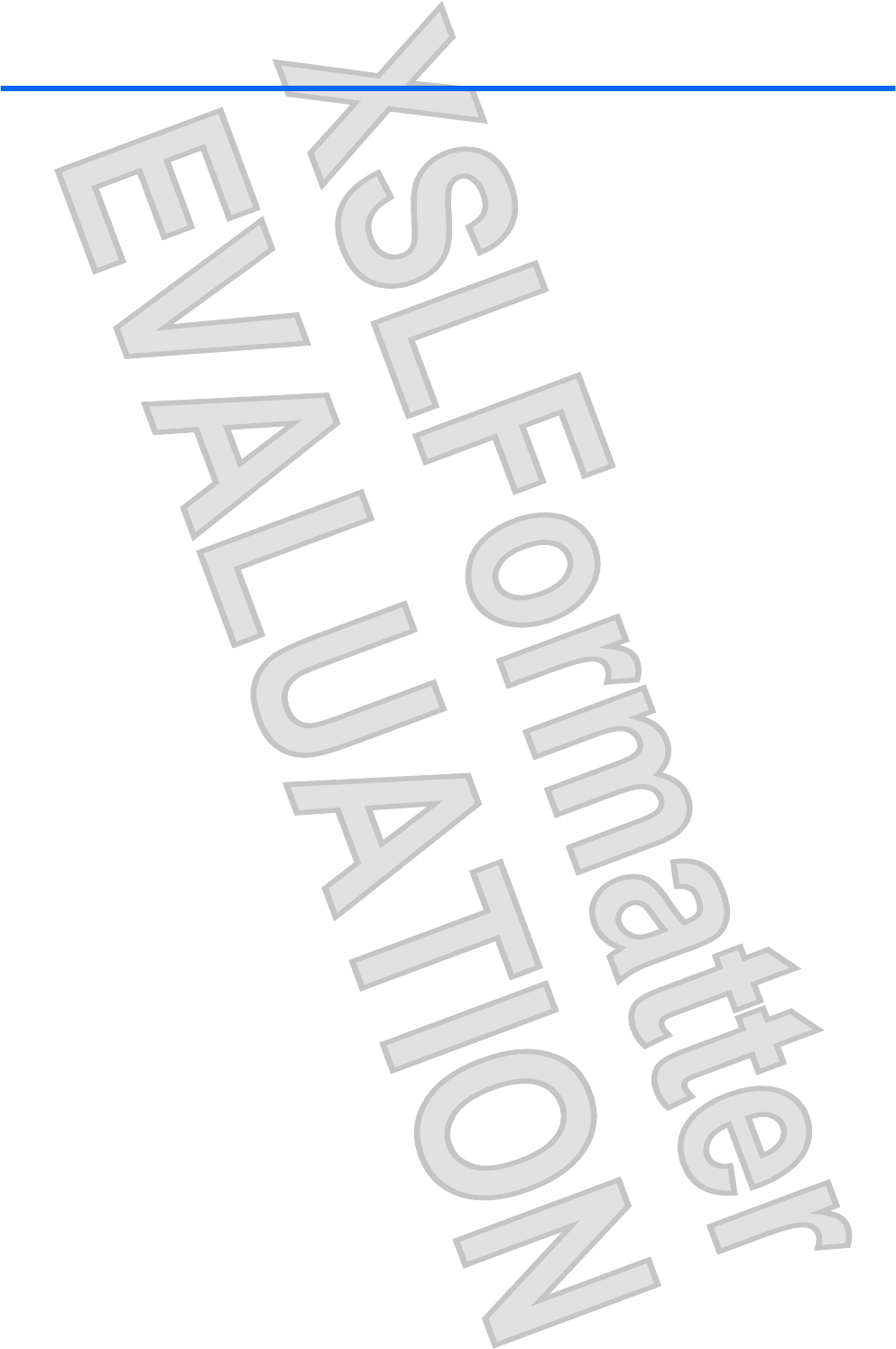
7 Drives and external devices
64 Chapter 7 Drives and external devices
Antenna House XSL Formatter (Evaluation) http://www.antennahouse.com/
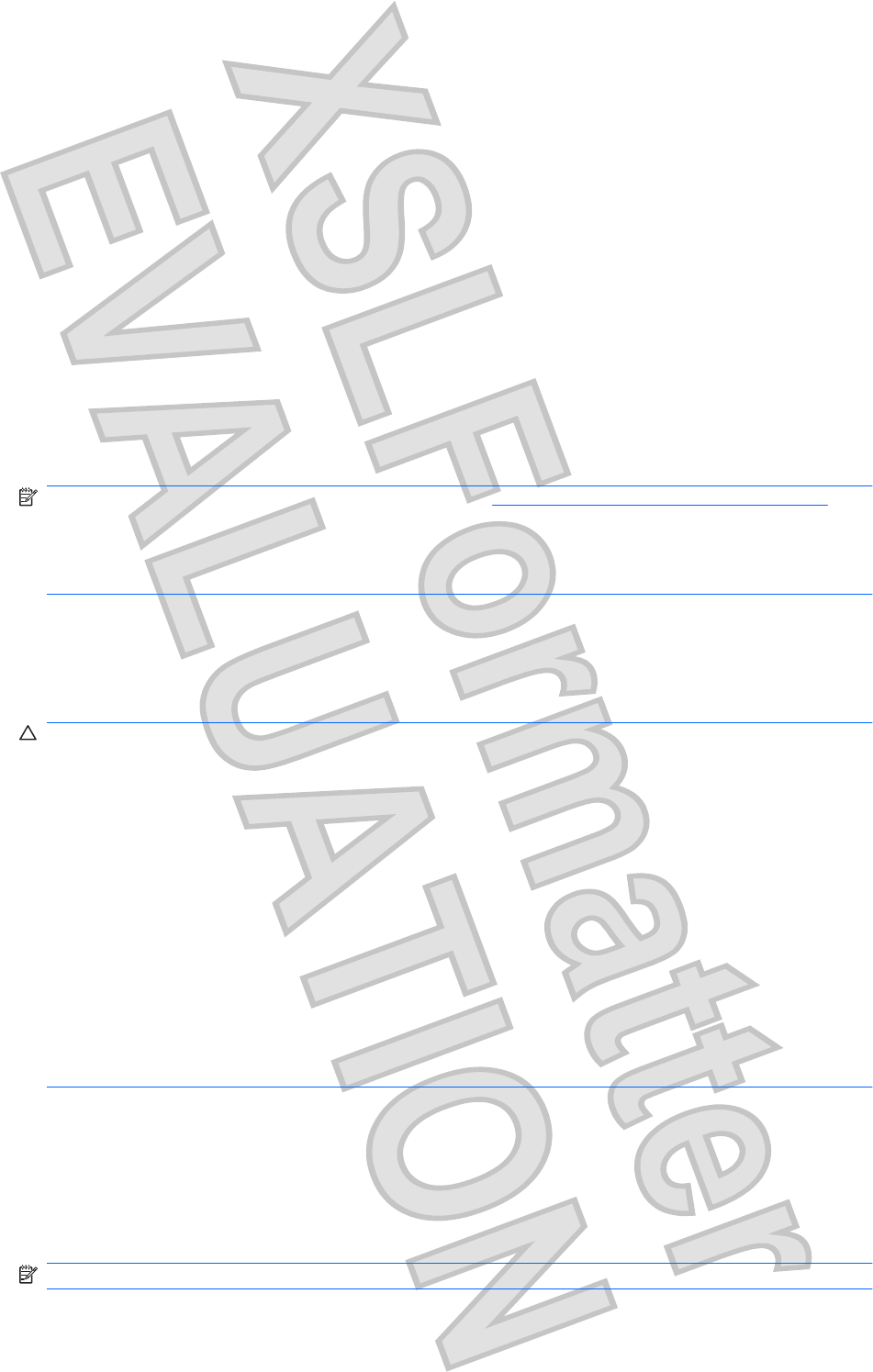
Drives
Identifying installed drives
Your computer includes a hard drive (with a rotating disc) or a solid-state drive (SSD) with solid-state
memory. Because it has no moving parts, an SSD does not generate as much heat as a hard drive.
Select computer models can support up to two drives. To view the drives installed on the computer,
select Start > Computer.
Computers with two SSDs installed will ship in a RAID 0 configuration. To view the two SSDs and RAID
0 configuration:
1. Turn on or restart the computer.
2. When the POST screen opens, press ctrl+I to enter the configuration utility.
3. Under Disk/Volume Information, RAID 0 (Stripe) and the two SSDs will be listed.
NOTE: For additional information on RAID 0, refer to RAID 0 (select models only) on page 107.
NOTE: Windows® includes the User Account Control feature to improve the security of your computer.
You may be prompted for your permission or password for tasks such as installing applications, running
utilities, or changing Windows settings. Refer to Help and Support for more information.
Handling drives
Drives are fragile computer components that must be handled with care. Refer to the following cautions
before handling drives. Additional cautions are included with the procedures to which they apply.
CAUTION: To reduce the risk of damage to the computer, damage to a drive, or loss of information,
observe these precautions:
Before you move a computer that is connected to an external hard drive, initiate Sleep and allow the
screen to clear, or properly disconnect the external hard drive.
Handle a drive carefully; do not drop a drive or place items on it.
When the battery is the only source of power, be sure that the battery is sufficiently charged before
writing to media.
Avoid exposing a drive to temperature or humidity extremes.
Avoid exposing a drive to liquids. Do not spray the drive with cleaning products.
Avoid exposing a drive to magnetic fields. Security devices with magnetic fields include airport walk-
through devices and security wands. The airport security devices that check carry-on luggage, such as
conveyor belts, use X-rays instead of magnetism and will not damage a drive.
Improving hard drive performance
Using Disk Defragmenter
As you use the computer, files on the hard drive become fragmented. Disk Defragmenter consolidates
the fragmented files and folders on the hard drive so that the system can run more efficiently.
NOTE: It is not necessary to run Disk Defragmenter on solid-state drives.
Drives 65
Antenna House XSL Formatter (Evaluation) http://www.antennahouse.com/
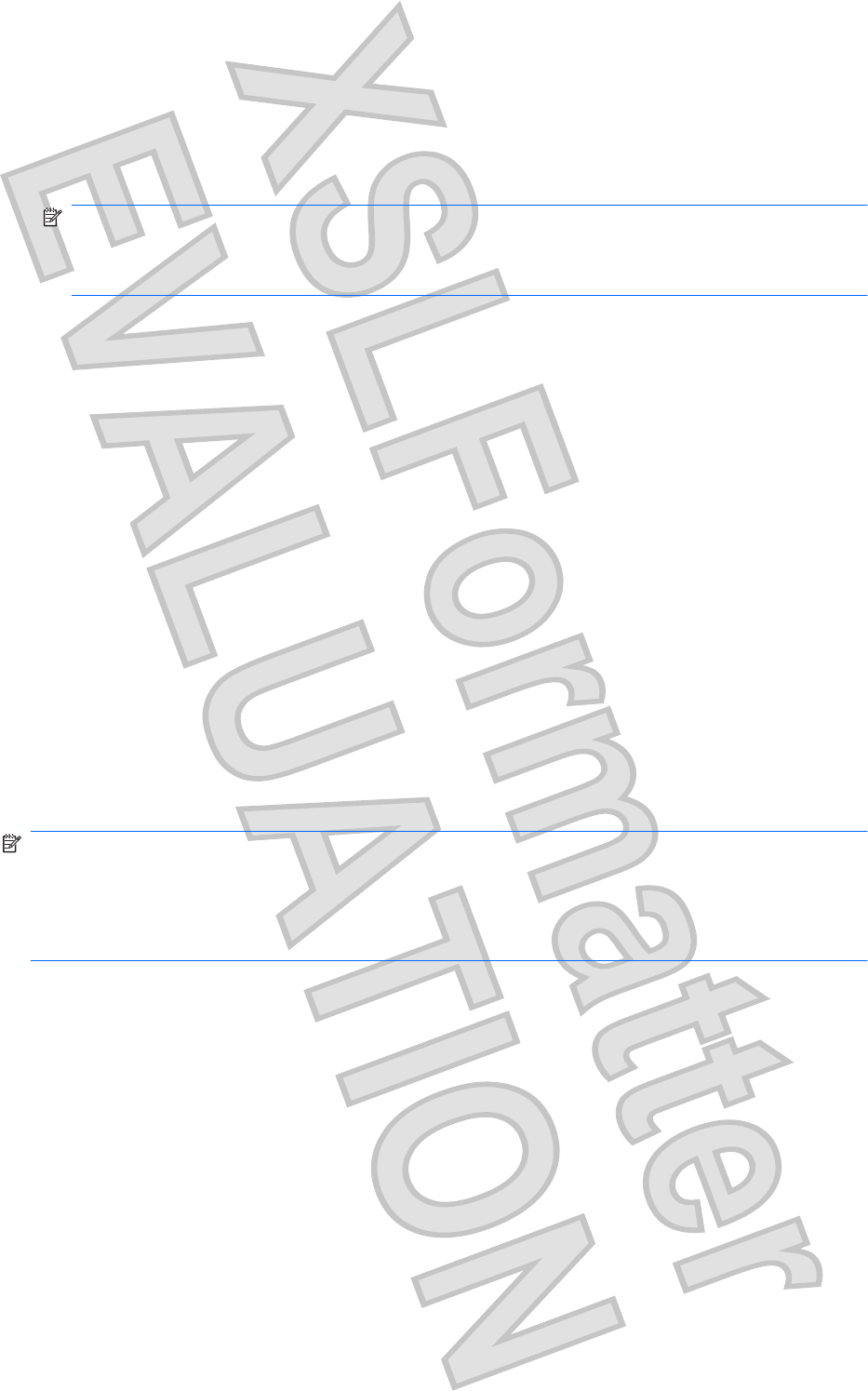
To run Disk Defragmenter:
1. Select Start > All Programs > Accessories > System Tools > Disk Defragmenter.
2. Click Defragment disk.
NOTE: Windows® includes the User Account Control feature to improve the security of your
computer. You may be prompted for your permission or password for tasks such as installing
applications, running utilities, or changing Windows settings. Refer to Help and Support for more
information.
For additional information, access the Disk Defragmenter software Help.
Using Disk Cleanup
Disk Cleanup searches the hard drive for unnecessary files that you can safely delete to free up disk
space and help the computer to run more efficiently.
To run Disk Cleanup:
1. Select Start > All Programs > Accessories > System Tools > Disk Cleanup.
2. Follow the on-screen instructions.
Using HP ProtectSmart Hard Drive Protection (select models only)
HP ProtectSmart Hard Drive Protection protects a hard drive by parking the drive and halting data
requests under either of the following conditions:
łYou drop the computer.
łYou move the computer with the display closed while the computer is running on battery power.
A short time after the end of one of these events, HP ProtectSmart Hard Drive Protection returns the
hard drive to normal operation.
NOTE: Because solid-state drives (SSD) lack moving parts, HP ProtectSmart Hard Drive Protection
is unnecessary.
NOTE: Hard drives in the primary hard drive bay or in the secondary hard drive bay are protected by
HP ProtectSmart Hard Drive Protection. Hard drives connected to USB ports are not covered by HP
ProtectSmart Hard Drive Protection.
For more information, refer to the HP ProtectSmart Hard Drive Protection software Help.
Identifying HP ProtectSmart Hard Drive Protection status
The drive light on the computer changes to an amber color to show that a drive in the primary hard drive
bay or a drive in the secondary hard drive bay (select models only) is parked. To determine whether
drives are currently protected or whether a drive is parked, select Start > Control Panel > Hardware
and Sound > Windows Mobility Center:
łIf the software is enabled, a green check mark is superimposed over the hard drive icon.
łIf the software is disabled, a red X is superimposed over the hard drive icon.
łIf the drives are parked, a yellow moon is superimposed over the hard drive icon.
66 Chapter 7 Drives and external devices
Antenna House XSL Formatter (Evaluation) http://www.antennahouse.com/
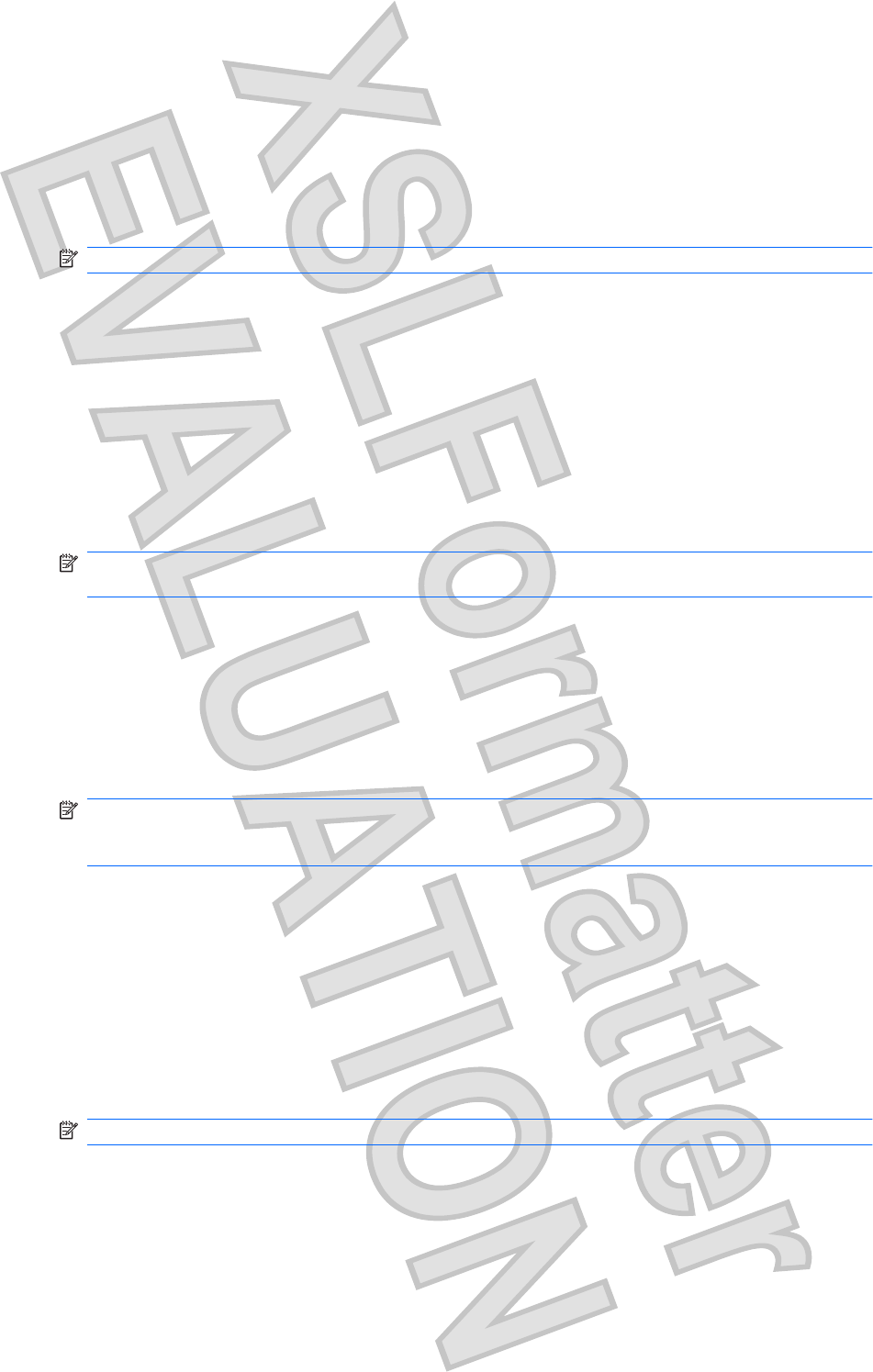
The icon in the Mobility Center may not show the most up-to-date status for the drive. For immediate
updates after a change in status, you need to enable the notification area icon.
To enable the notification area icon:
1. Select Start > Control Panel > Hardware and Sound > HP ProtectSmart Hard Drive
Protection.
NOTE: If prompted by User Account Control, click Yes.
2. On the Icon in System Tray row, click Show.
3. Click OK.
Managing power with a parked hard drive
If HP ProtectSmart Hard Drive Protection has parked the drive, the computer will behave in the following
ways:
łThe computer will not shut down.
łThe computer will not initiate Sleep or Hibernation, except as described in the following Note.
NOTE: If the computer is running on battery power and reaches a critical battery level, HP
ProtectSmart Hard Drive Protection allows the computer to initiate Hibernation.
Before you move the computer, HP recommends that you either shut it down or initiate Sleep or
Hibernation.
Using HP ProtectSmart Hard Drive Protection software
The HP ProtectSmart Hard Drive Protection software enables you to perform the following tasks:
łEnable and disable HP ProtectSmart Hard Drive Protection.
NOTE: Depending on your user privileges, you may not be able to enable or disable HP
ProtectSmart Hard Drive Protection. Additionally, members of an Administrator group can change
the privileges for non-Administrator users.
łDetermine whether a drive in the system is supported.
To open the software and change settings, follow these steps:
1. In Mobility Center, click the hard drive icon to open the HP ProtectSmart Hard Drive Protection
window.
– or –
Select Start > Control Panel > Hardware and Sound > HP ProtectSmart Hard Drive
Protection.
NOTE: If prompted by User Account Control, click Yes.
2. Click the appropriate button to change settings.
3. Click OK.
Drives 67
Antenna House XSL Formatter (Evaluation) http://www.antennahouse.com/
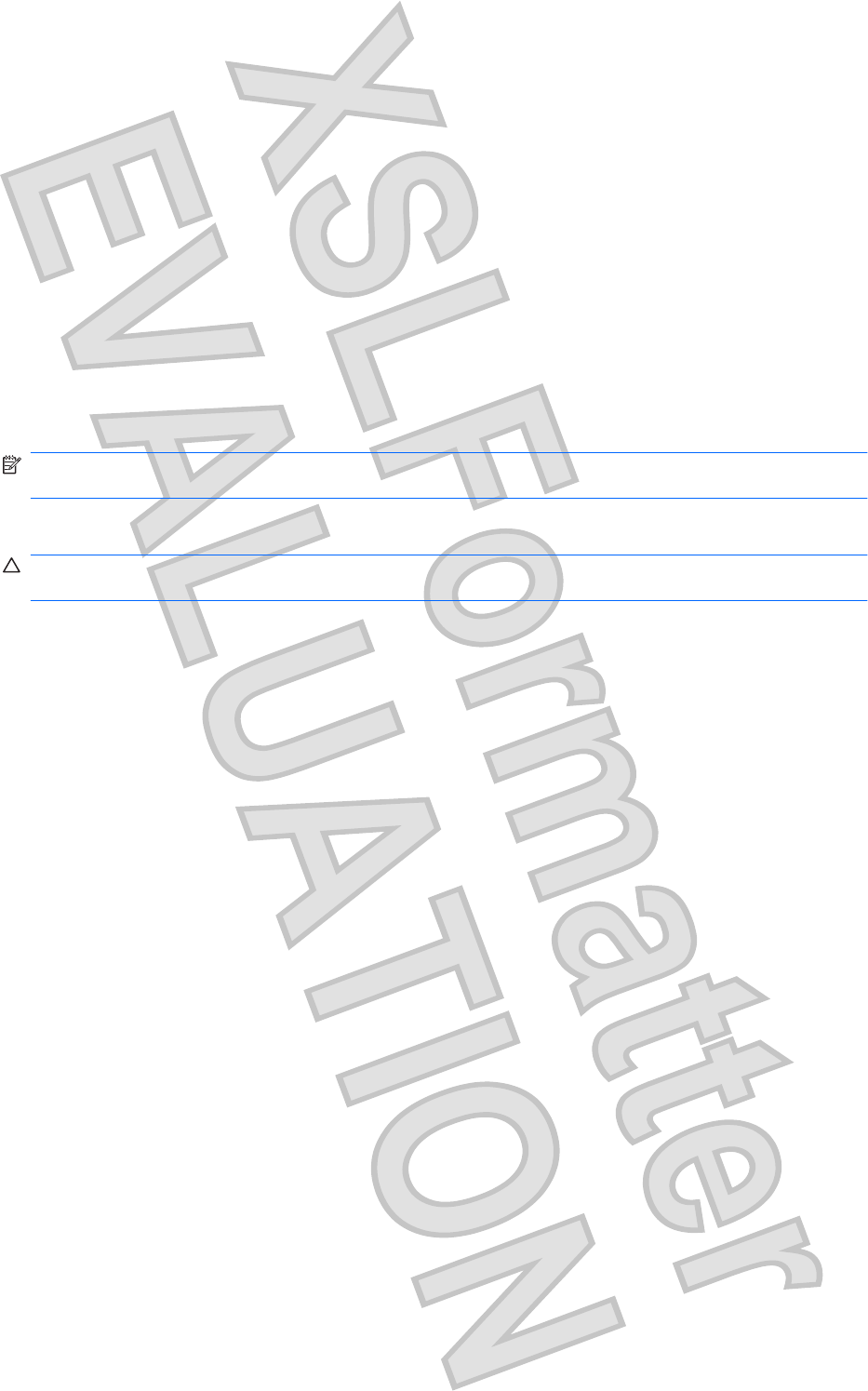
Using external drives
Removable external drives expand your options for storing and accessing information.
USB drives include the following types:
ł1.44-megabyte diskette drive
łHard drive module (a hard drive with an adapter attached)
łDVD-ROM Drive
łDVD±RW SuperMulti Double-Layer (DL) Drive
łBlu-ray ROM DVD±R/RW SuperMulti Double-Layer (DL) Drive
Connecting optional external drives
NOTE: For more information about required software and drivers, or to learn which computer port to
use, refer to the manufacturer's instructions.
To connect an external drive to the computer:
CAUTION: To reduce the risk of damage to the equipment when connecting a powered drive, be sure
that the drive is turned off and the AC power cord is unplugged.
1. Connect the drive to the computer.
2. If you are connecting a powered drive, plug the device power cord into a grounded AC outlet.
3. Turn on the drive.
To disconnect an unpowered external drive, turn off the drive, and then disconnect it from the computer.
To disconnect a powered external drive, turn off the drive, disconnect it from the computer, and then
unplug the AC power cord.
Using the external optical drive (select models only)
Select computer models ship with an external optical drive. An external optical drive connects to a USB
port on the computer and enables you to read data discs, play music, and watch movies. If your external
optical drive includes a Blu-ray Disc (BD) drive, also known as a BD, you can also watch high-definition
video from discs.
You may have one of the following types of drives:
łDVD±RW SuperMulti Double-Layer (DL) Drive
łBlu-ray ROM DVD±R/RW SuperMulti Double-Layer (DL) Drive
The external optical drive can be either a tray load or slot load drive. The optical drive also contains two
additional USB ports.
68 Chapter 7 Drives and external devices
Antenna House XSL Formatter (Evaluation) http://www.antennahouse.com/
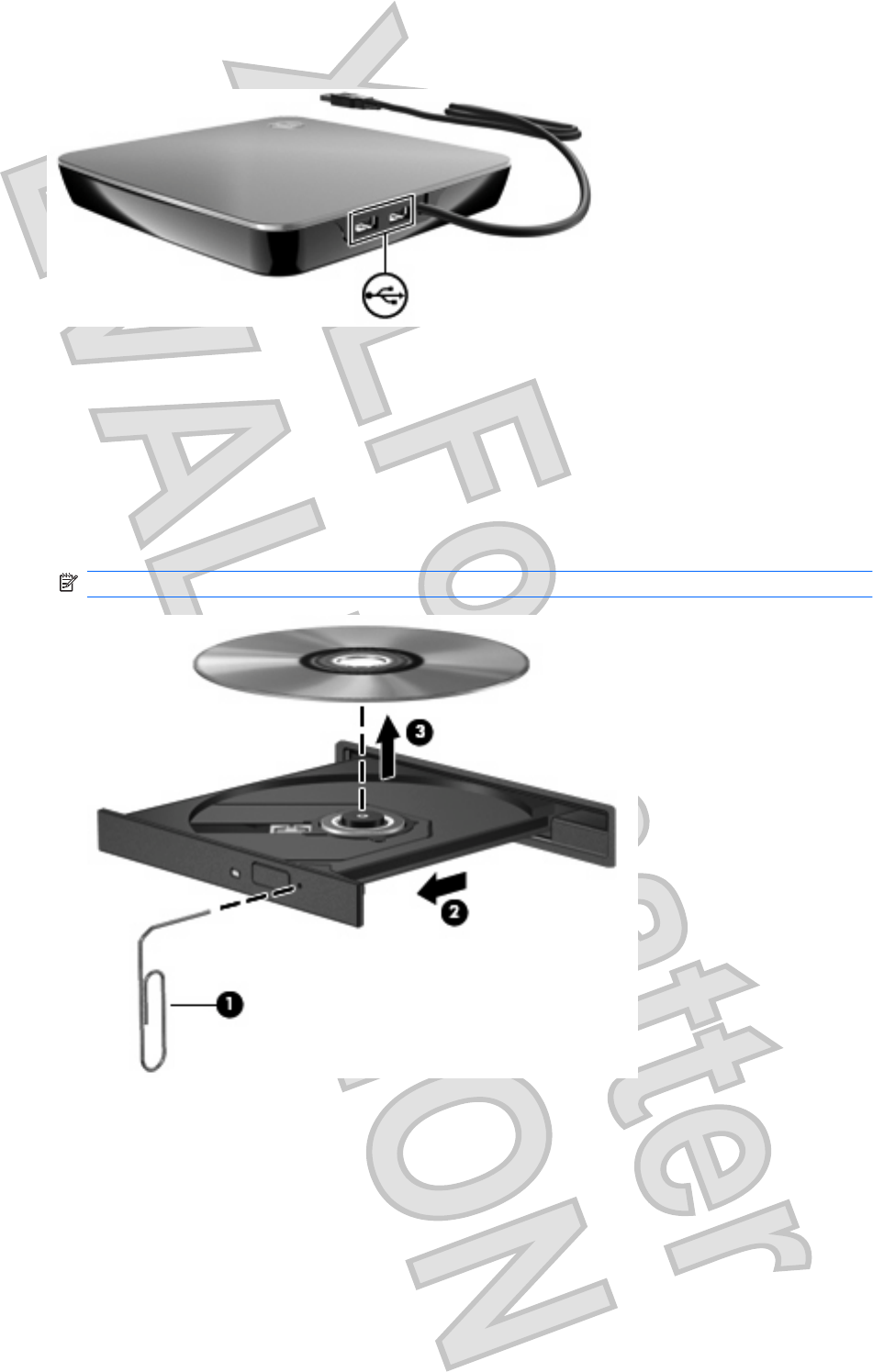
Removing an optical disc when the disc tray will not open
If your optical drive is a tray load drive and the disc tray does not open, follow these steps:
1. Insert the end of a paper clip (1) into the release access in the front bezel of the drive.
2. Press in gently on the paper clip until the tray is released, and then pull out the tray (2) until it stops.
3. Remove the disc (3) from the tray by gently pressing down on the spindle while lifting the outer
edges of the disc. Hold the disc by the edges and avoid touching the flat surfaces.
NOTE: If the tray is not fully accessible, tilt the disc carefully as you remove it.
4. Close the disc tray and place the disc in a protective case.
Sharing optical drives
Although your computer does not have an integrated optical drive, you can easily access software, install
applications, and access data by sharing an optical drive connected to another computer in your network.
Sharing drives is a feature of the Windows operating system that allows a drive on one computer to be
accessible to other computers on the same network.
Drives 69
Antenna House XSL Formatter (Evaluation) http://www.antennahouse.com/
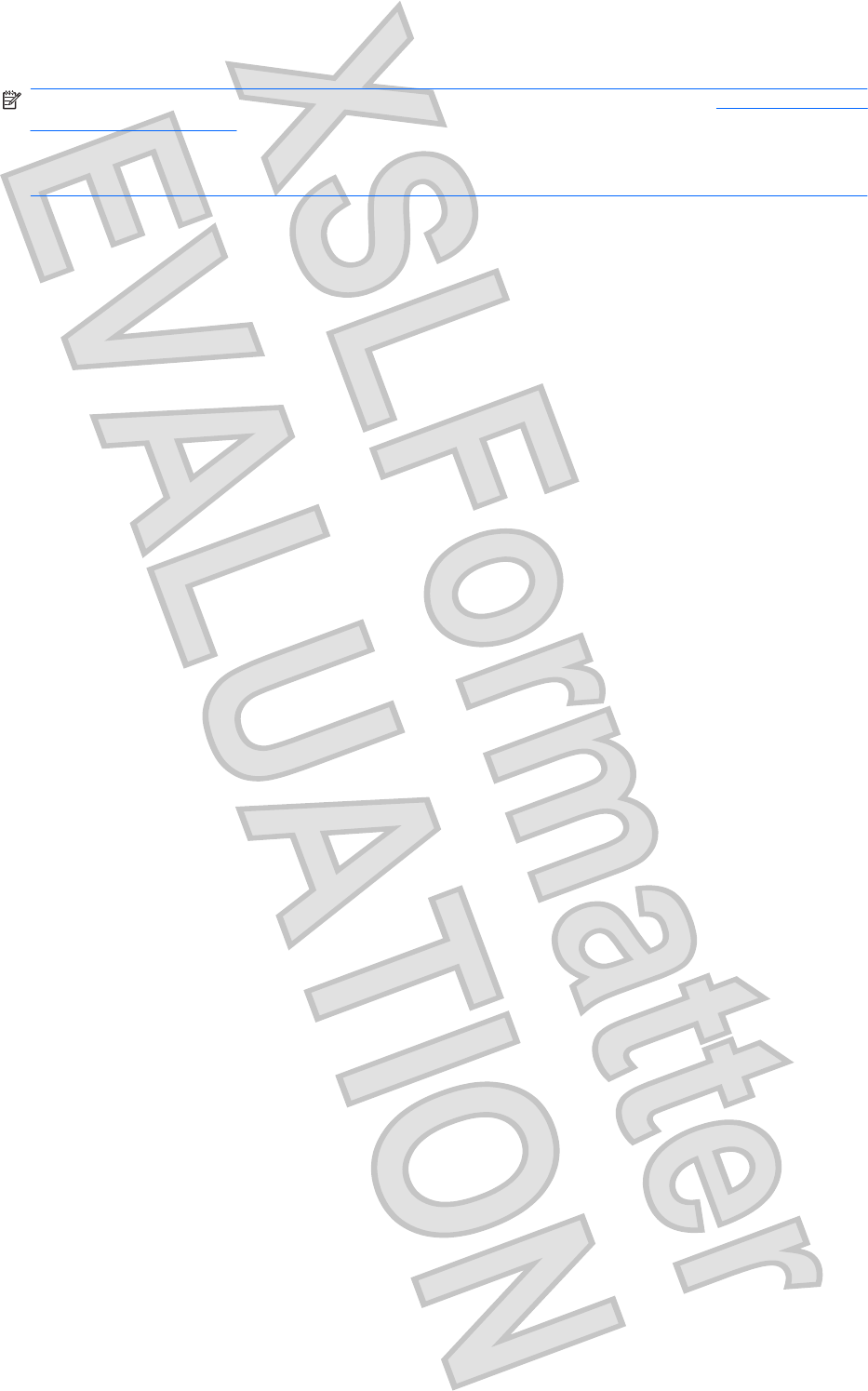
NOTE: You must have a network set up in order to share an optical drive; refer to Wireless and local
area network on page 14 for additional information on setting up a network.
NOTE: Some discs, such as DVD movies and game discs, may be copy-protected and therefore
unusable through DVD or CD sharing.
To share an optical drive:
1. From the computer with the optical drive you are sharing, select Start > Computer.
2. Right-click the optical drive you want to share, and click Properties.
3. Select the Sharing tab > Advanced Sharing.
4. Select the Share this folder check box.
5. Type a name for the optical drive in Share name.
6. Click Apply, and then click OK.
7. To view the shared optical drive on your computer, select Start > Control Panel > Network and
Sharing Center > View computers and devices.
70 Chapter 7 Drives and external devices
Antenna House XSL Formatter (Evaluation) http://www.antennahouse.com/
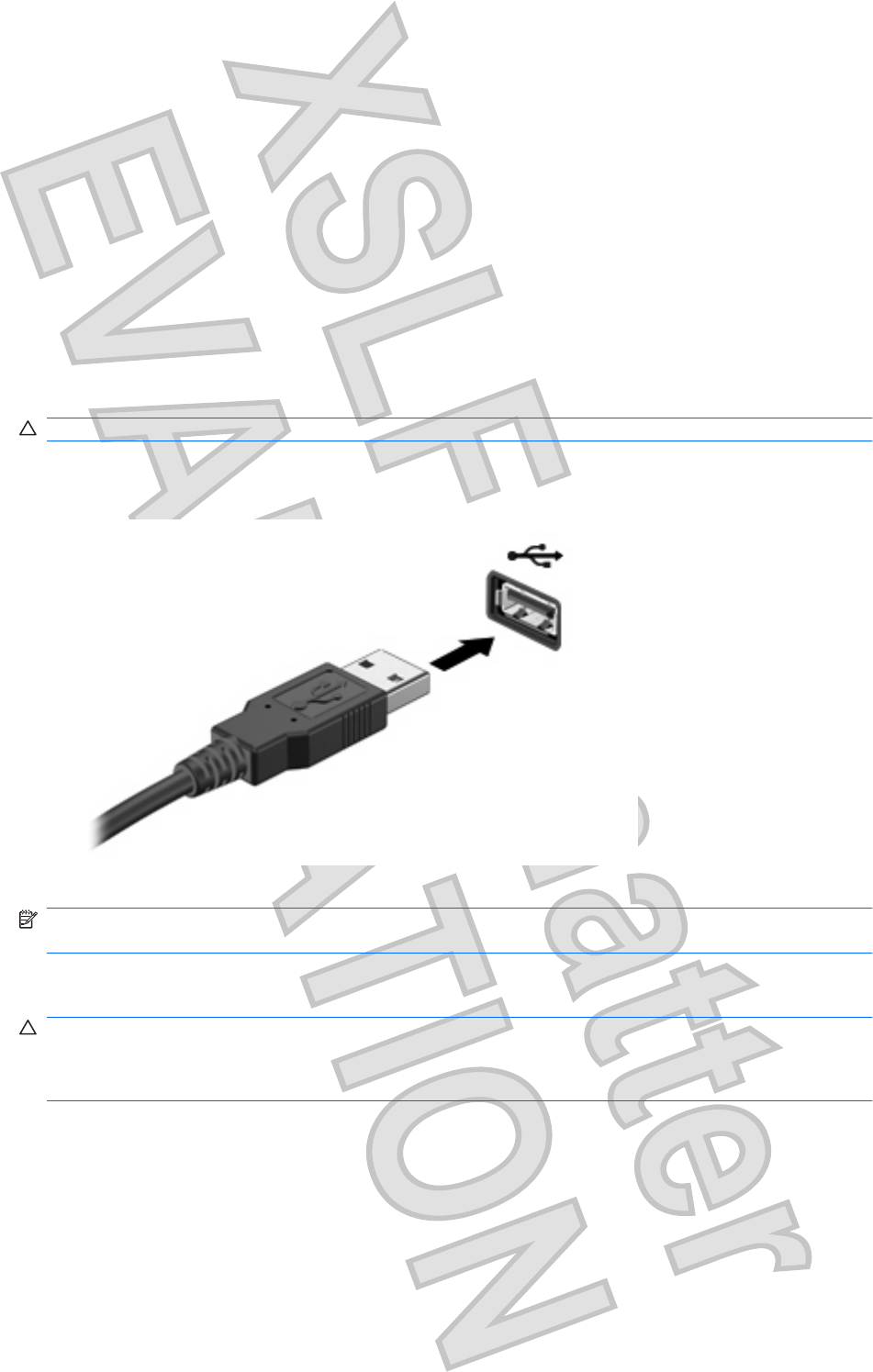
External devices
Using a USB device
A USB port connects an optional external device, such as a USB keyboard, mouse, drive, printer,
scanner, or hub, to the computer.
Some USB devices may require additional support software, which is usually included with the device.
For more information about device-specific software, refer to the manufacturer's instructions.
The computer has 2 USB ports, which support USB 1.0, USB 1.1, USB 2.0 devices. Select models also
support USB 3.0 devices. To add more USB ports, connect an optional hub.
Connecting a USB device
CAUTION: To prevent damage to a USB connector, use minimal force to connect a USB device.
⊡
⊡
To connect a USB device to the computer, connect the USB cable for the device to the USB
port.
You will hear a sound when the device has been detected.
NOTE: The first time you connect a USB device, the "Installing device driver software" message is
displayed in the notification area, at the far right of the taskbar.
Removing a USB device
CAUTION: To prevent loss of information or an unresponsive system, use the following procedure to
safely remove the USB device.
CAUTION: To prevent damage to a USB connector, do not pull on the cable to remove the USB device.
External devices 71
Antenna House XSL Formatter (Evaluation) http://www.antennahouse.com/
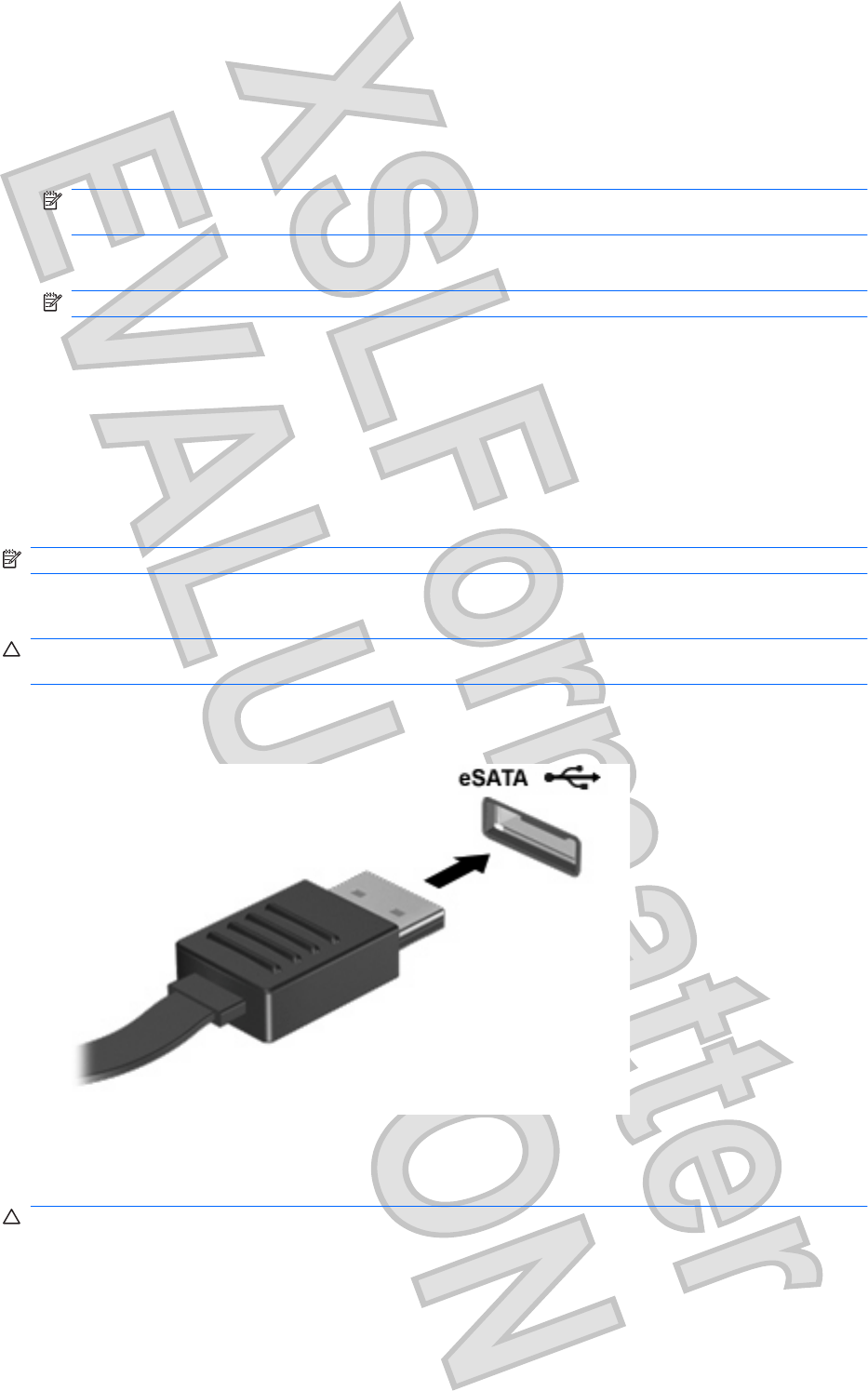
To remove a USB device:
1. Click the Safely Remove Hardware and Eject Media icon in the notification area, at the far right
of the taskbar.
NOTE: To display the Safely Remove Hardware and Eject Media icon, click the Show hidden
icons icon (the arrow at the left of the notification area).
2. Click the name of the device in the list.
NOTE: You are prompted that it is safe to remove the hardware device.
3. Remove the device.
Using an eSATA device
An eSATA port connects an optional high-performance eSATA component, such as an eSATA external
hard drive.
Some eSATA devices may require additional support software, which is usually included with the device.
For more information about device-specific software, refer to the manufacturer's instructions.
NOTE: The eSATA port also supports an optional USB device.
Connecting an eSATA device
CAUTION: To prevent damage to an eSATA port connector, use minimal force to connect an eSATA
device.
⊡
⊡
To connect an eSATA device to the computer, connect the eSATA cable for the device to the
eSATA port.
You will hear a sound when the device has been detected.
Removing an eSATA device
CAUTION: To prevent loss of information or an unresponsive system, use the following procedure to
safely remove the device.
72 Chapter 7 Drives and external devices
Antenna House XSL Formatter (Evaluation) http://www.antennahouse.com/
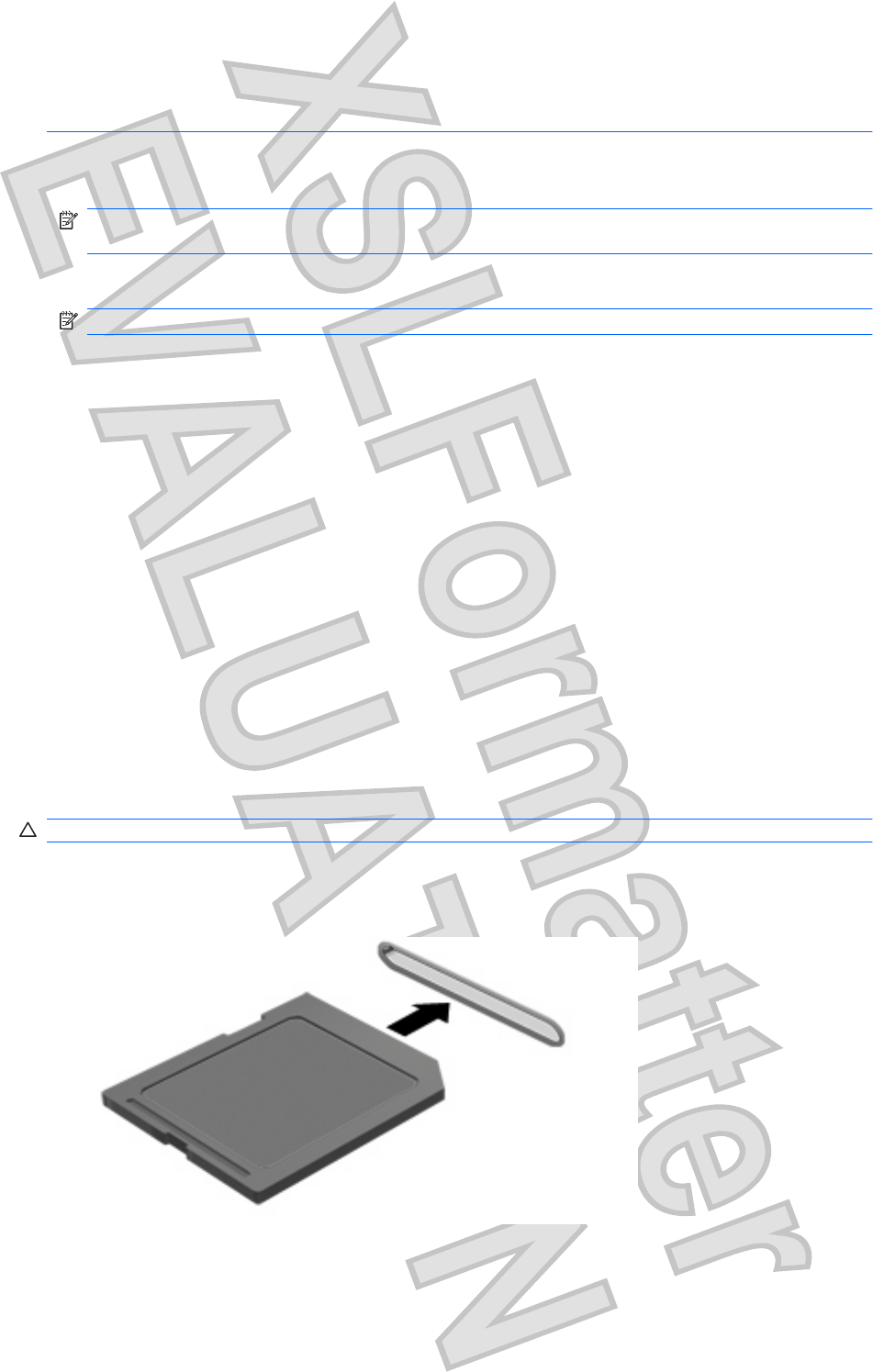
CAUTION: To prevent damage to an eSATA connector, do not pull on the cable to remove the eSATA
device.
1. Click the Safely Remove Hardware and Eject Media icon in the notification area, at the far right
of the taskbar.
NOTE: To display the Safely Remove Hardware and Eject Media icon, click the Show hidden
icons icon (the arrow at the left of the notification area).
2. Click the name of the device in the list.
NOTE: You are prompted that it is safe to remove the hardware device.
3. Remove the device.
Using Digital Media Slot cards
Optional digital cards provide secure data storage and convenient data sharing. These cards are often
used with digital media–equipped cameras and PDAs as well as with other computers.
The Digital Media Slot supports the following digital card formats:
łMultiMediaCard
łMicro MultiMediaCard (adapter required)
łMultiMediaCard Plus
łSecure Digital Memory Card
łMicro Secure Digital Memory Card (adapter required)
łSecure Digital High Capacity Memory Card
Inserting a digital card
CAUTION: To prevent damage to the digital card connectors, use minimal force to insert a digital card.
1. Hold the digital card label-side up, with the connectors facing the computer.
2. Insert the card into the Digital Media Slot, and then push in on the card until it is firmly seated.
You will hear a sound when the device has been detected, and a menu of options may be displayed.
External devices 73
Antenna House XSL Formatter (Evaluation) http://www.antennahouse.com/
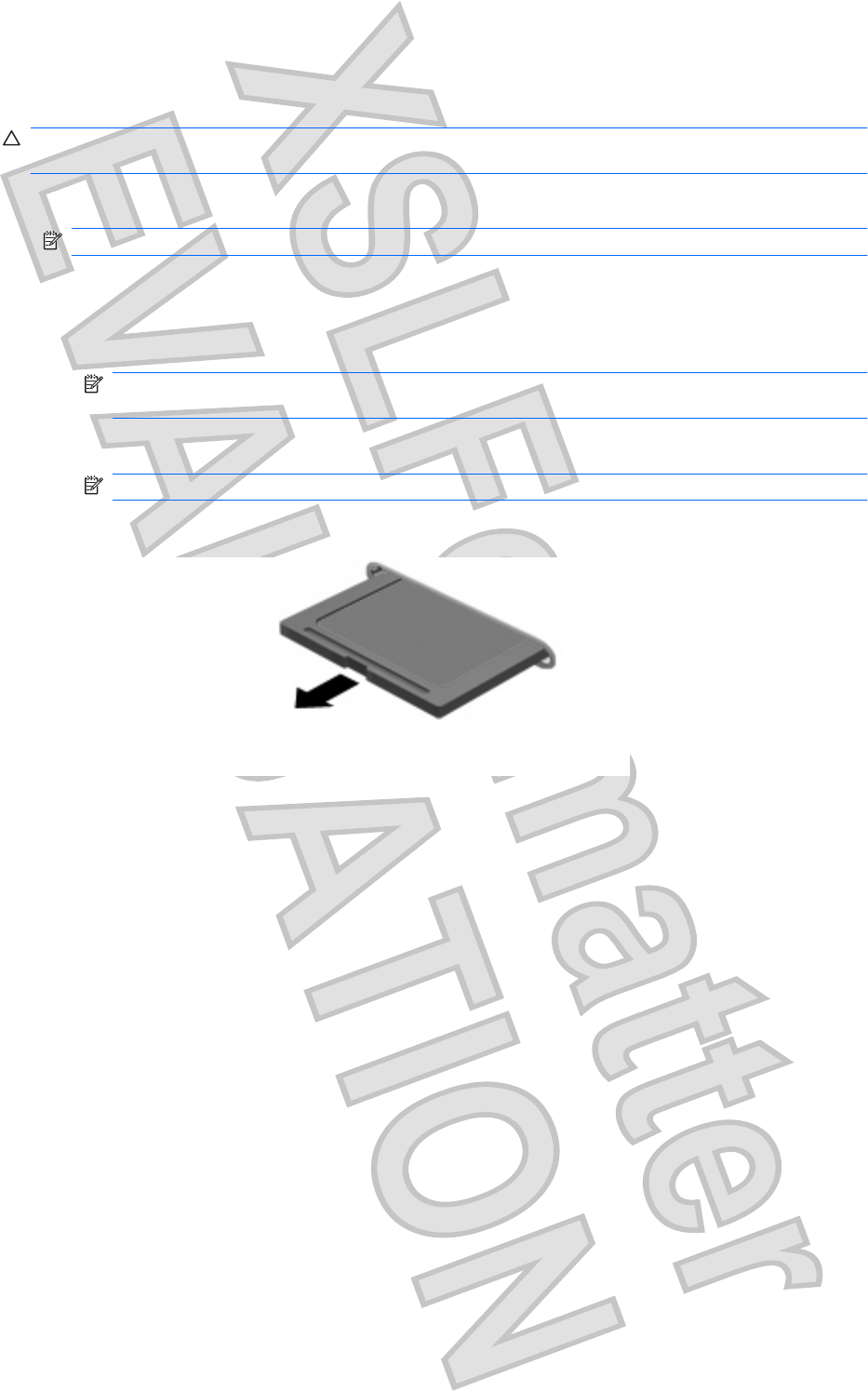
Removing a digital card
CAUTION: To prevent loss of data or an unresponsive system, use the following procedure to safely
remove the digital card.
1. Save your information and close all programs associated with the digital card.
NOTE: To stop a data transfer, click Cancel in the operating system Copying window.
2. To remove a digital card:
a. Click the Safely Remove Hardware and Eject Media icon in the notification area, at the far
right of the taskbar.
NOTE: To display the Safely Remove Hardware and Eject Media icon, click the Show
hidden icons icon (the arrow at the left of the notification area).
b. Click the name of the digital card in the list.
NOTE: You are prompted that it is safe to remove the hardware device.
3. Pull the digital card from the slot.
74 Chapter 7 Drives and external devices
Antenna House XSL Formatter (Evaluation) http://www.antennahouse.com/
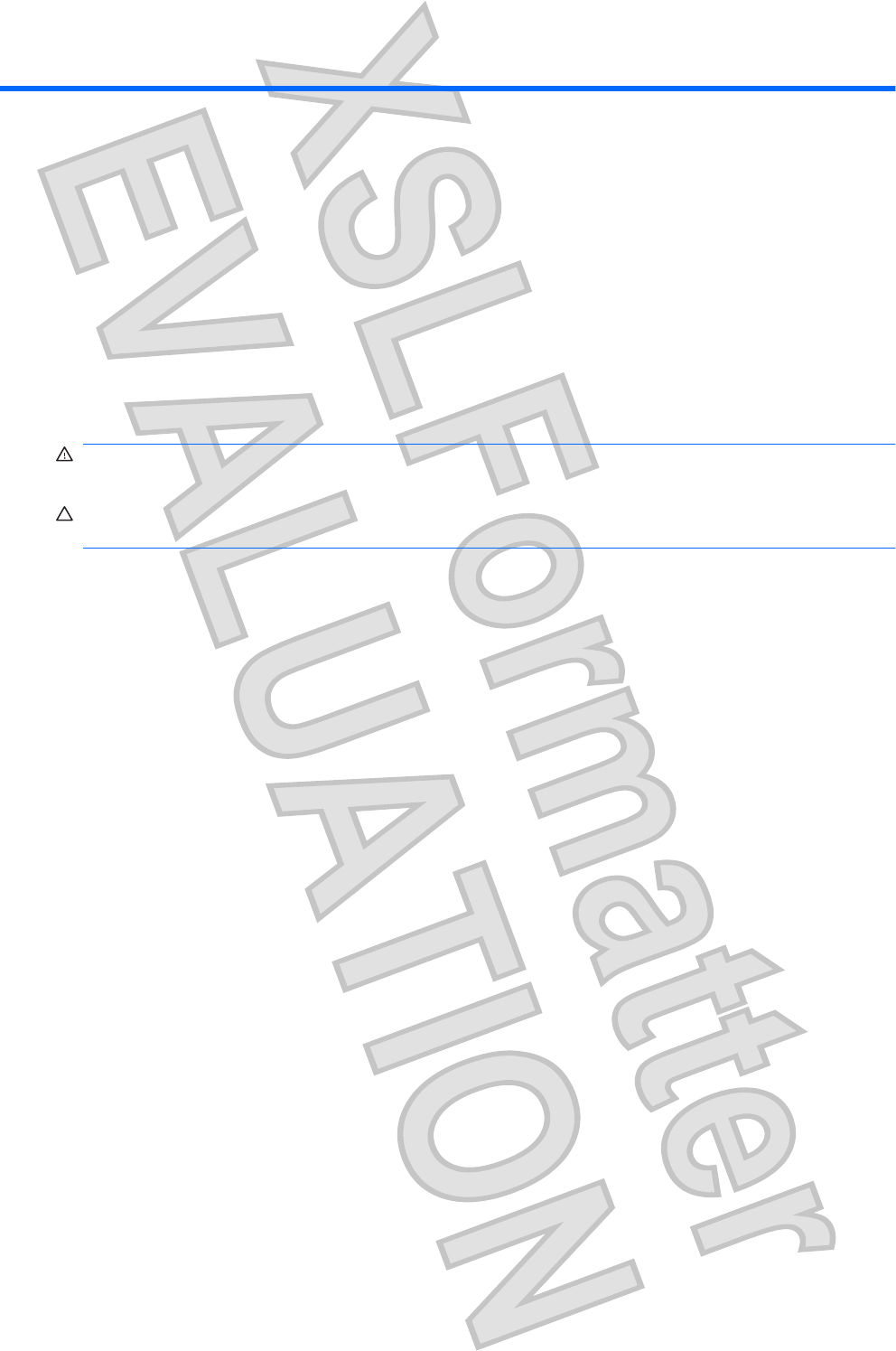
8 Memory modules
Depending on the computer model, your computer has either one or two memory module slots. The
memory module slots are located on the bottom of the computer. The memory capacity of the computer
can be upgraded by adding a memory module or replacing the existing memory module in one of the
memory module slots.
WARNING! To reduce the risk of electric shock and damage to the equipment, unplug the power cord
and remove all batteries before installing a memory module.
CAUTION: Electrostatic discharge (ESD) can damage electronic components. Before beginning any
procedure, touch a grounded metal object to be sure that you are discharged of static electricity.
75
Antenna House XSL Formatter (Evaluation) http://www.antennahouse.com/
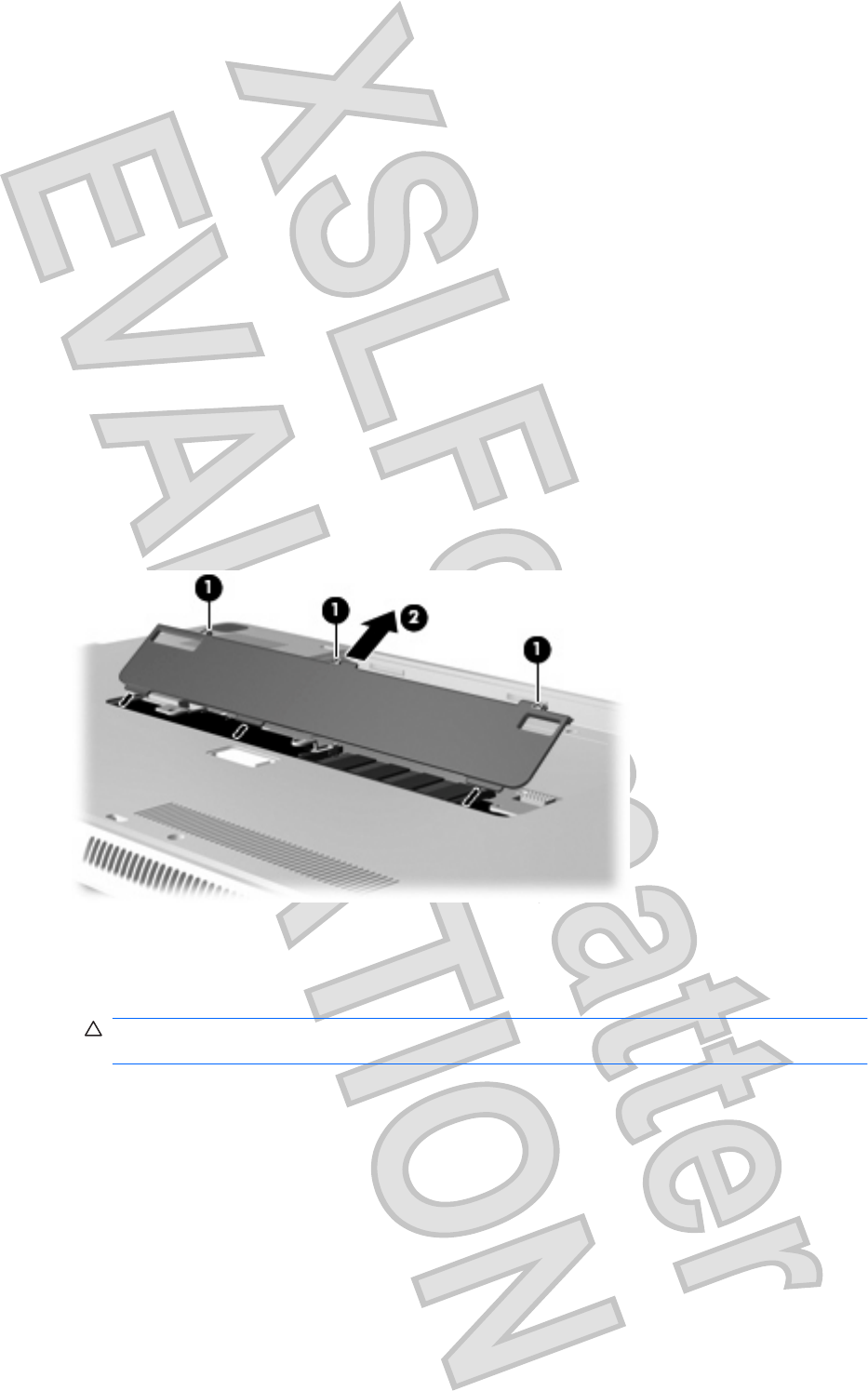
Adding or replacing a memory module in single-slot
models
To add or replace a memory module:
1. Save your work.
2. Shut down the computer and close the display.
If you are not sure whether the computer is off or in Hibernation, turn the computer on by briefly
pressing the power button. Then shut down the computer through the operating system.
3. Disconnect all external devices connected to the computer.
4. Unplug the power cord from the AC outlet.
5. Turn the computer upside down on a flat surface.
6. Remove the battery from the computer.
7. Loosen the memory module compartment cover screws (1) and lift the memory module
compartment cover (2) away from the computer.
8. Remove a memory module in the memory module slot:
a. Pull away the retention clips (1) on each side of the memory module.
CAUTION: To prevent damage to the memory module, hold the memory module by the
edges only. Do not touch the components on the memory module.
76 Chapter 8 Memory modules
Antenna House XSL Formatter (Evaluation) http://www.antennahouse.com/
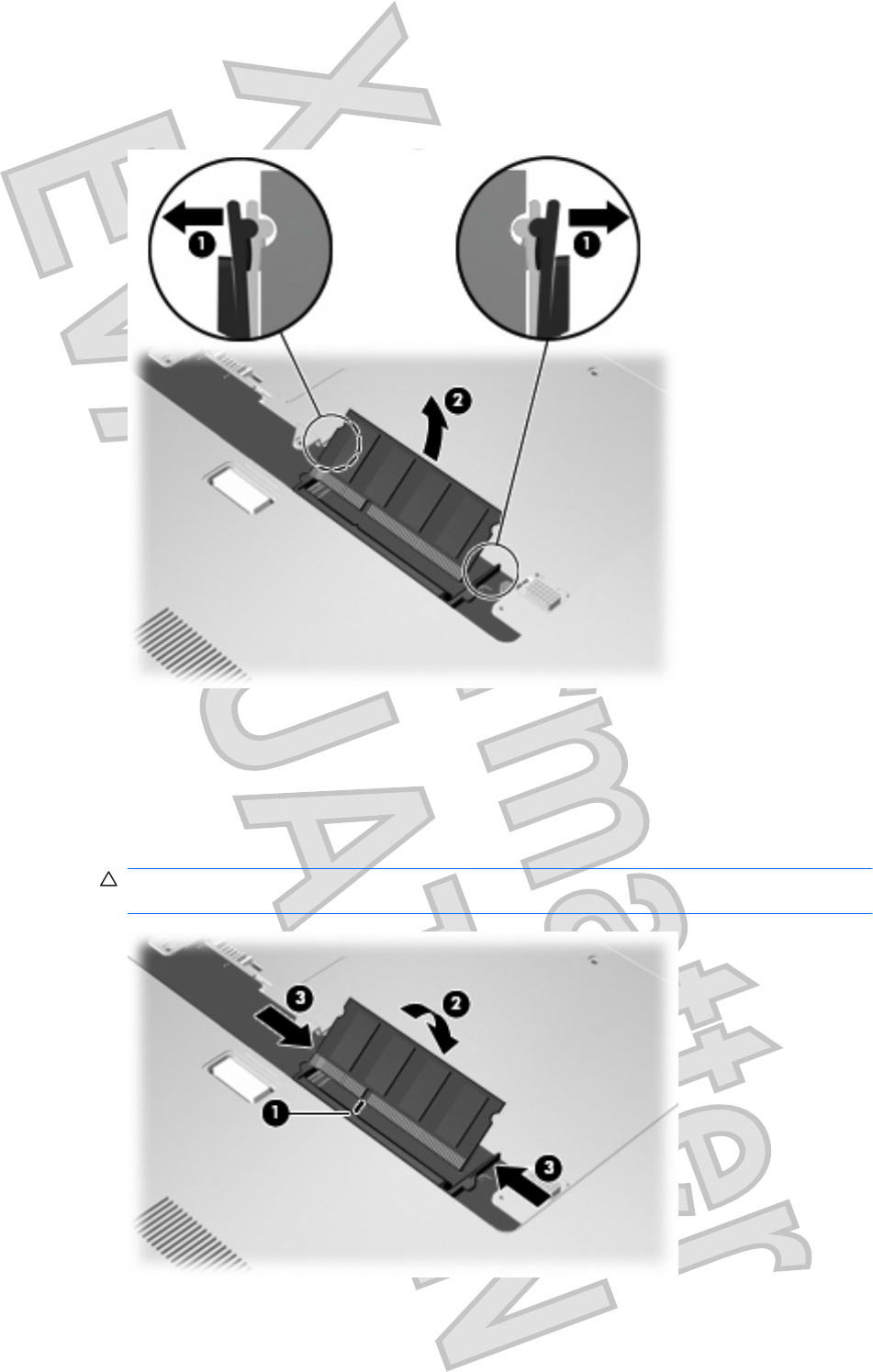
b. Grasp the edge of the memory module (2), gently rotate the module up, and then pull it out
of the memory module slot.
To protect the memory module after removal, place it in an electrostatic-safe container.
9. Insert a memory module in the memory module slot:
a. Align the notched edge (1) of the memory module with the tab in the top memory module slot.
b. Insert the memory module into the memory module slot and rotate the module downward
(2) until it is seated and the retention clips (3) snap into place.
CAUTION: To prevent damage to the memory module, hold the memory module by the
edges only. Do not touch the components on the memory module.
Adding or replacing a memory module in single-slot models 77
Antenna House XSL Formatter (Evaluation) http://www.antennahouse.com/
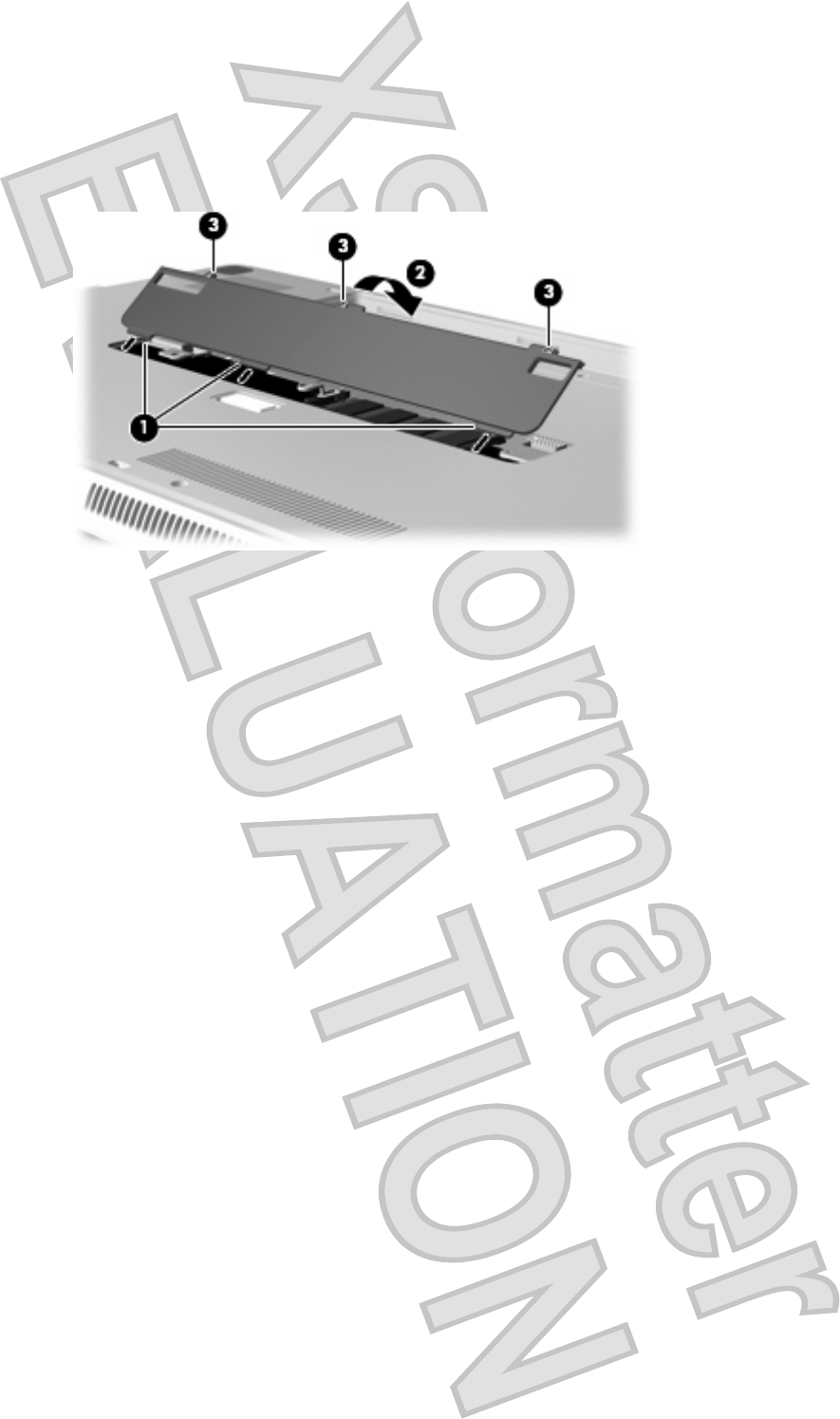
10. Align the tabs (1) on the memory module compartment cover with the notches on the computer.
11. Close the cover (2).
12. Tighten the memory module compartment cover screws (3).
13. Replace the battery.
14. Turn the computer right-side up, and then reconnect external power and external devices.
15. Turn on the computer.
78 Chapter 8 Memory modules
Antenna House XSL Formatter (Evaluation) http://www.antennahouse.com/
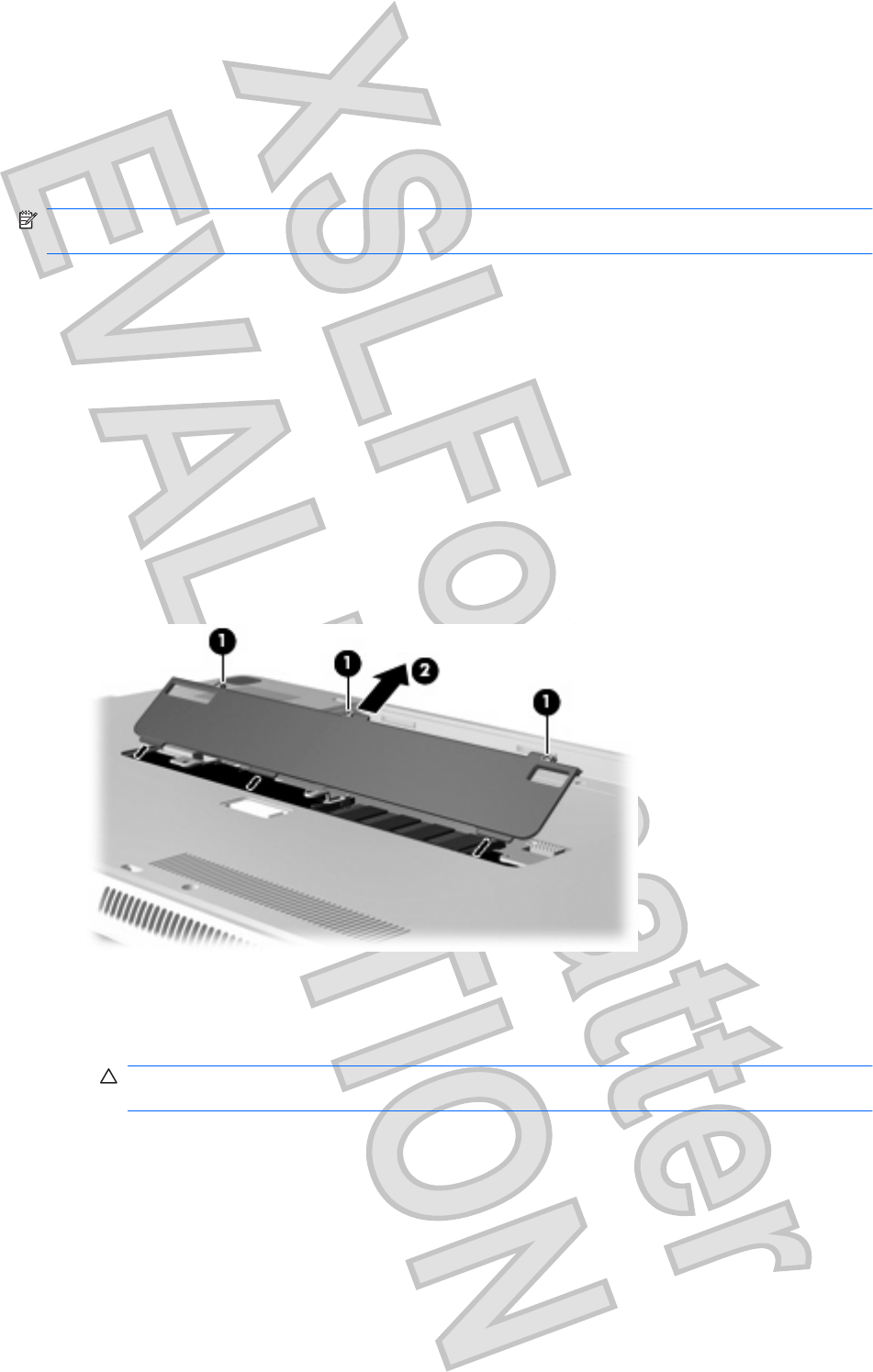
Adding or replacing a memory module in double-slot
models
To add or replace a memory module:
NOTE: If you are inserting only one memory module, you must insert it in the top memory module slot
or the computer will not recognize the memory module.
1. Save your work.
2. Shut down the computer and close the display.
If you are not sure whether the computer is off or in Hibernation, turn the computer on by briefly
pressing the power button. Then shut down the computer through the operating system.
3. Disconnect all external devices connected to the computer.
4. Unplug the power cord from the AC outlet.
5. Turn the computer upside down on a flat surface.
6. Remove the battery from the computer.
7. Loosen the memory module compartment cover screws (1) and lift the memory module
compartment cover (2) away from the computer.
8. Remove a memory module in the top memory module slot:
a. Pull away the retention clips (1) on each side of the memory module.
CAUTION: To prevent damage to the memory module, hold the memory module by the
edges only. Do not touch the components on the memory module.
Adding or replacing a memory module in double-slot models 79
Antenna House XSL Formatter (Evaluation) http://www.antennahouse.com/
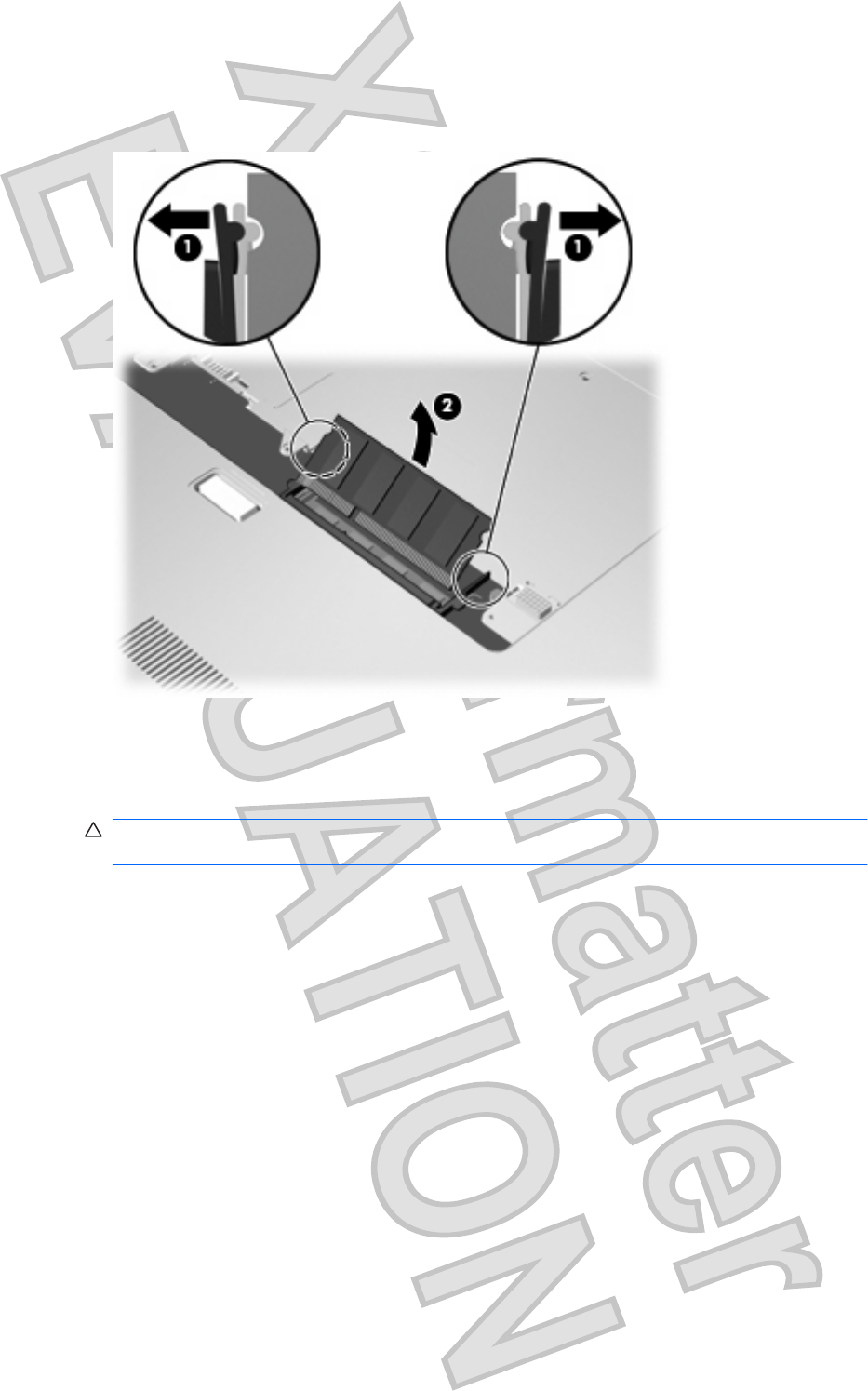
b. Grasp the edge of the memory module (2), and gently rotate the module up and pull it out of
the memory module slot.
To protect the memory module after removal, place it in an electrostatic-safe container.
9. Remove a memory module in the bottom memory module slot:
a. Pull away the retention clips (1) on each side of the memory module.
CAUTION: To prevent damage to the memory module, hold the memory module by the
edges only. Do not touch the components on the memory module.
80 Chapter 8 Memory modules
Antenna House XSL Formatter (Evaluation) http://www.antennahouse.com/
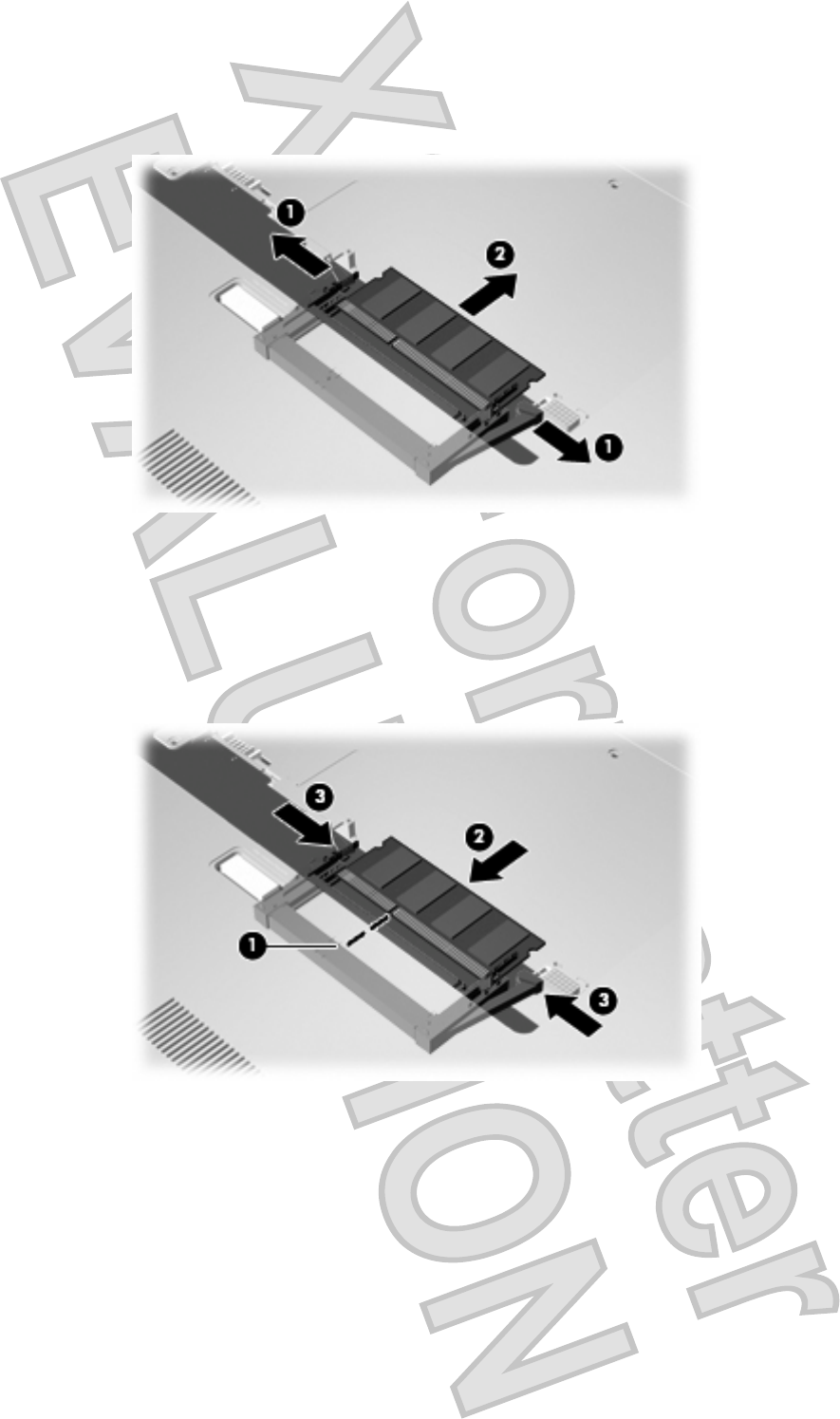
b. Grasp the edge of the memory module (2), and gently pull the module out of the memory
module slot.
To protect the memory module after removal, place it in an electrostatic-safe container.
10. Insert a memory module in the bottom memory module slot:
a. Align the notched edge (1) of the memory module with the tab in the bottom memory module
slot.
b. Insert the memory module firmly into the bottom memory module slot (2) until it is seated and
the retention clips (3) automatically snap into place.
11. Insert a memory module in the top memory module slot:
a. Align the notched edge (1) of the memory module with the tab in the top memory module slot.
Adding or replacing a memory module in double-slot models 81
Antenna House XSL Formatter (Evaluation) http://www.antennahouse.com/
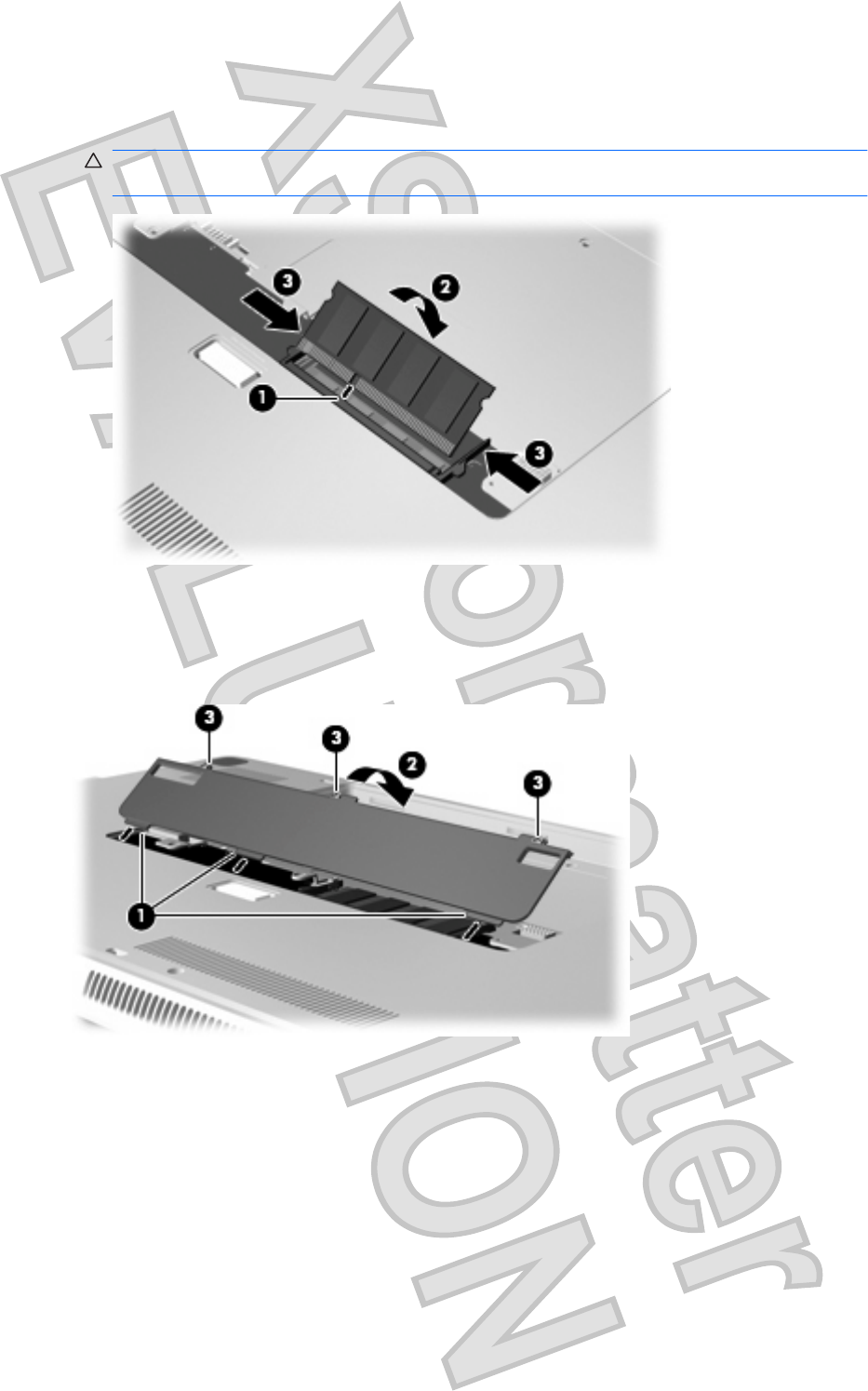
b. Insert the memory module into the top memory module slot and rotate the module downward
(2) until it is seated and the retention clips (3) snap into place.
CAUTION: To prevent damage to the memory module, hold the memory module by the
edges only. Do not touch the components on the memory module.
12. Align the tabs (1) on the memory module compartment cover with the notches on the computer.
13. Close the cover (2).
14. Tighten the memory module compartment cover screws (3).
15. Replace the battery.
16. Turn the computer right-side up, and then reconnect external power and external devices.
17. Turn on the computer.
82 Chapter 8 Memory modules
Antenna House XSL Formatter (Evaluation) http://www.antennahouse.com/

9Security
83
Antenna House XSL Formatter (Evaluation) http://www.antennahouse.com/
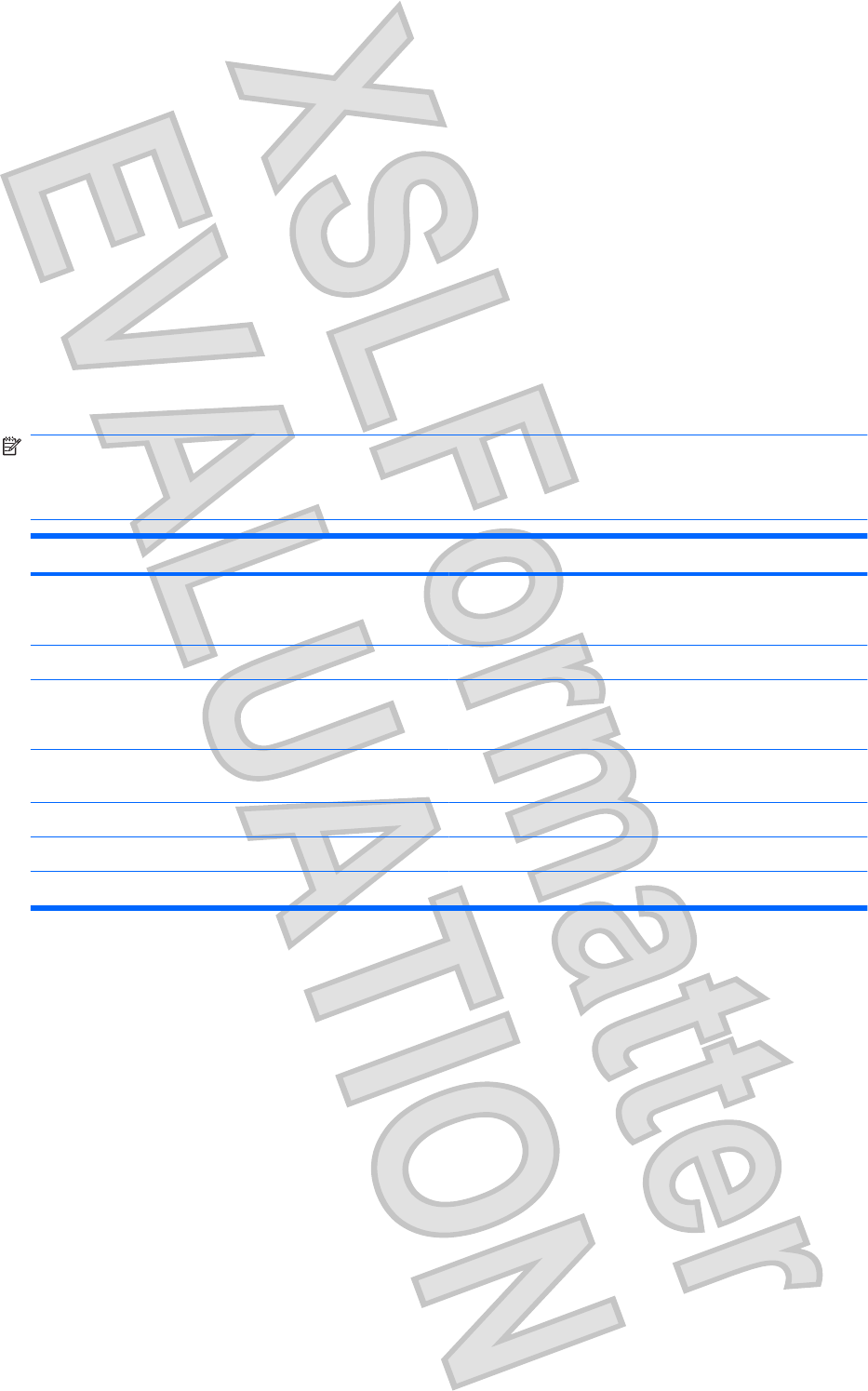
Protecting the computer
Standard security features provided by the Windows® operating system and the non-Windows Setup
Utility can protect your personal settings and data from a variety of risks.
Follow the procedures in this guide to use the following features:
łPasswords
łAntivirus software
łFirewall software
łCritical security updates
łOptional security cable
NOTE: Security solutions are designed to act as deterrents, but they may not deter software attacks
or prevent the computer from being mishandled or stolen.
NOTE: Before you send your computer for service, remove all password settings.
Computer risk Security feature
Unauthorized use of the computer łQuickLock
łPower-on password
Computer viruses Norton Internet Security software
Unauthorized access to data łFirewall software
łWindows updates
Unauthorized access to Setup Utility, BIOS settings, and other
system identification information
Administrator password
Ongoing or future threats to the computer Critical security updates from Microsoft
Unauthorized access to a Windows user account User password
Unauthorized removal of the computer Security cable slot (used with an optional security cable)
84 Chapter 9 Security
Antenna House XSL Formatter (Evaluation) http://www.antennahouse.com/
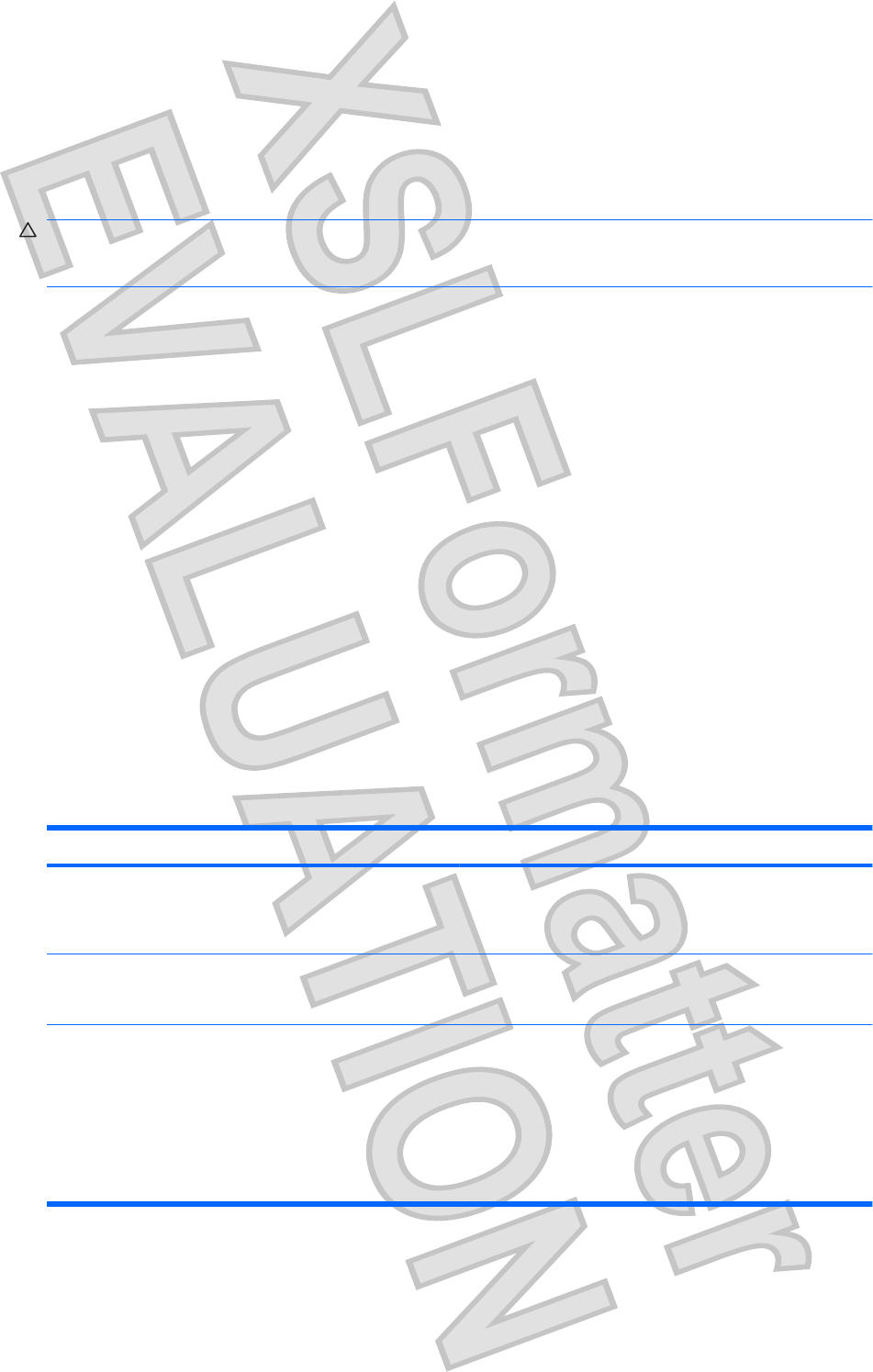
Using passwords
A password is a group of characters that you choose to secure your computer information. Several types
of passwords can be set, depending on how you want to control access to your information. Passwords
can be set in Windows or in the non-Windows Setup Utility preinstalled on the computer.
CAUTION: To prevent being locked out of the computer, record each password you set. Because
most passwords are not displayed as they are set, changed, or deleted, it is essential to record each
password immediately and store it in a secure place.
You can use the same password for a Setup Utility feature and for a Windows security feature. You can
also use the same password for more than one Setup Utility feature.
Use the following guidelines when setting a password in Setup Utility:
łA password can be any combination of up to 8 letters and numbers and is case sensitive.
łA password set in Setup Utility must be entered at a Setup Utility prompt. A password set
in Windows must be entered at a Windows prompt.
Use the following tips for creating and saving passwords:
łWhen creating passwords, follow requirements set by the program.
łWrite down your passwords and store them in a secure place away from the computer.
łDo not store passwords in a file on the computer.
łDo not use your name or other personal information that could be easily discovered by an outsider.
The following sections list Windows and Setup Utility passwords and describe their functions. For
additional information about Windows passwords, such as screen-saver passwords, select Start > Help
and Support.
Setting passwords in Windows
Password Function
Administrator password Protects administrator-level access to computer contents.
NOTE: This password cannot be used to access Setup Utility
contents.
User password Protects access to a Windows user account. It also protects
access to the computer contents and must be entered when
you exit Sleep or Hibernation.
QuickLock Protects the computer by requiring a password to be entered
in the Windows Log On dialog box before you access the
computer. After you set a user or administrator password,
follow these steps:
1. Initiate QuickLock by pressing the QuickLock key.
2. Exit QuickLock by entering your Windows user or
administrator password.
Using passwords 85
Antenna House XSL Formatter (Evaluation) http://www.antennahouse.com/
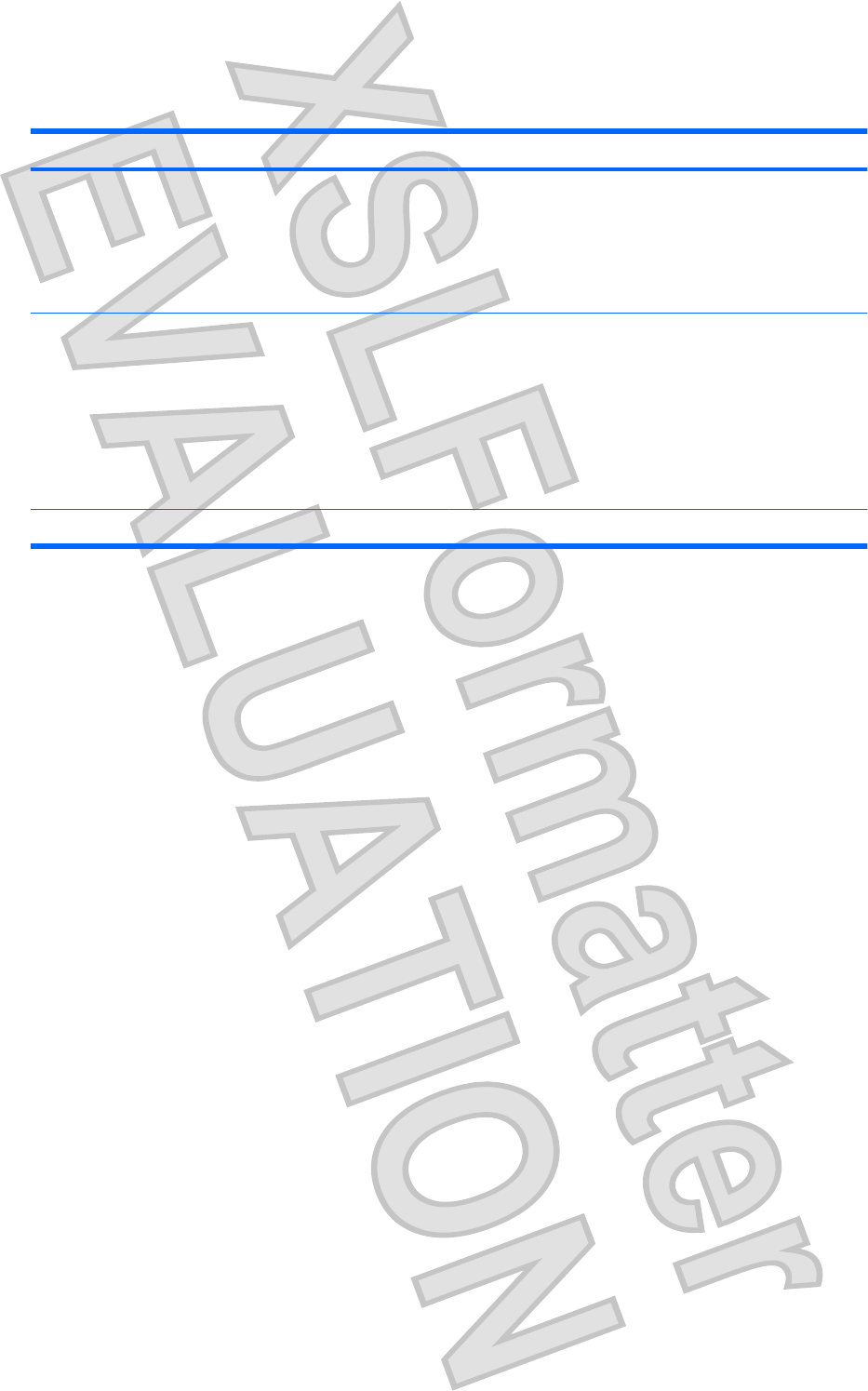
Setting passwords in Setup Utility
Password Function
Administrator password* łProtects access to Setup Utility.
łAfter this password is set, it must be entered each time
you access Setup Utility.
CAUTION: If you forget your administrator password, you
cannot access Setup Utility.
Power-on password* łProtects access to the computer contents.
łAfter this password is set, it must be entered each time
you turn on or restart the computer, or exit Hibernation.
CAUTION: If you forget your power-on password, you
cannot turn on or restart the computer, or exit Hibernation.
NOTE: The administrator password can be used in place of
the power-on password.
*For details about each of these passwords, refer to the following topics.
Administrator password
Your administrator password protects the configuration settings and system identification information in
Setup Utility. After this password is set, you must enter it each time you access Setup Utility.
Your administrator password is not interchangeable with an administrator password set in Windows,
nor is it displayed as it is set, entered, changed, or deleted. Be sure that you record your password and
store it in a safe place.
If you enter the administrator password at the first password check before the “Press the ESC key for
Startup Menu” message is displayed, you do not have to enter it again to access Setup Utility.
If you enter the power-on password at the first password check before the “Press the ESC key for Startup
Menu” message is displayed, you must enter the administrator password to access Setup Utility.
86 Chapter 9 Security
Antenna House XSL Formatter (Evaluation) http://www.antennahouse.com/

Managing an administrator password
To set, change, or delete this password, follow these steps:
1. Open Setup Utility by turning on or restarting the computer. While the “Press the ESC key for
Startup Menu” message is displayed in the lower-left corner of the screen, press f10.
– or –
Open Setup Utility by turning on or restarting the computer. While the “Press the ESC key for
Startup Menu” message is displayed in the lower-left corner of the screen, press esc. When the
Startup Menu is displayed, press f10.
2. Use the arrow keys to select Security > Set Administrator Password, and then press enter.
łTo set an administrator password, type your password in the Enter New Password and
Confirm New Password fields, and then press enter.
łTo change an administrator password, type your current password in the Enter Current
Password field, type a new password in the Enter New Password and Confirm New
Password fields, and then press enter.
łTo delete an administrator password, type your current password in the Enter Password field,
and then press enter 4 times.
3. To save your changes and exit Setup Utility, use the arrow keys to select Exit > Exit Saving
Changes.
Your changes go into effect when the computer restarts.
Entering an administrator password
At the Enter Password prompt, type your administrator password, and then press enter. After 3
unsuccessful attempts to enter the administrator password, you must restart the computer and try again.
Power-on password
Your power-on password prevents unauthorized use of the computer. After this password is set, it must
be entered each time you turn on or restart the computer, or exit Hibernation. A power-on password is
not displayed as it is set, entered, changed, or deleted.
Using passwords 87
Antenna House XSL Formatter (Evaluation) http://www.antennahouse.com/

Managing a power-on password
To set, change, or delete this password, follow these steps:
1. Open Setup Utility by turning on or restarting the computer. While the “Press the ESC key for
Startup Menu” message is displayed in the lower-left corner of the screen, press f10.
– or –
Open Setup Utility by turning on or restarting the computer. While the “Press the ESC key for
Startup Menu” message is displayed in the lower-left corner of the screen, press esc. When the
Startup Menu is displayed, press f10.
2. Use the arrow keys to select Security > Set Power-On Password, and then press enter.
łTo set a power-on password, type your password in the Enter New Password and Confirm
New Password fields, and then press enter.
łTo change a power-on password, type your current password in the Enter Current
Password field, type a new password in the Enter New Password and Confirm New
Password fields, and then press enter.
łTo delete a power-on password, type your current password in the Enter Current
Password field, and then press enter 4 times.
3. To save your changes and exit Setup Utility, use the arrow keys to select Exit > Exit Saving
Changes.
Your changes go into effect when the computer restarts.
Entering a power-on password
At the Enter Password prompt, type your password, and then press enter. After 3 unsuccessful attempts
to enter the password, you must restart the computer and try again.
88 Chapter 9 Security
Antenna House XSL Formatter (Evaluation) http://www.antennahouse.com/

Using antivirus software
When you use the computer to access e-mail, a network, or the Internet, you expose it to computer
viruses. Computer viruses can disable the operating system, programs, or utilities, or cause them to
function abnormally.
Antivirus software can detect most viruses, destroy them, and in most cases, repair any damage they
have caused. To provide ongoing protection against newly discovered viruses, antivirus software must
be kept up to date.
Norton Internet Security, an antivirus program, is preinstalled on the computer. The software includes
60 days of free updates. It is strongly recommended that you protect the computer against new viruses
beyond 60 days by purchasing extended update service. Instructions for using and updating Norton
Internet Security software and for purchasing extended update service are provided within the program.
To view and access Norton Internet Security, select Start > All Programs > Norton Internet
Security.
For more information about computer viruses, type viruses in the Search box in Help and Support.
Using antivirus software 89
Antenna House XSL Formatter (Evaluation) http://www.antennahouse.com/
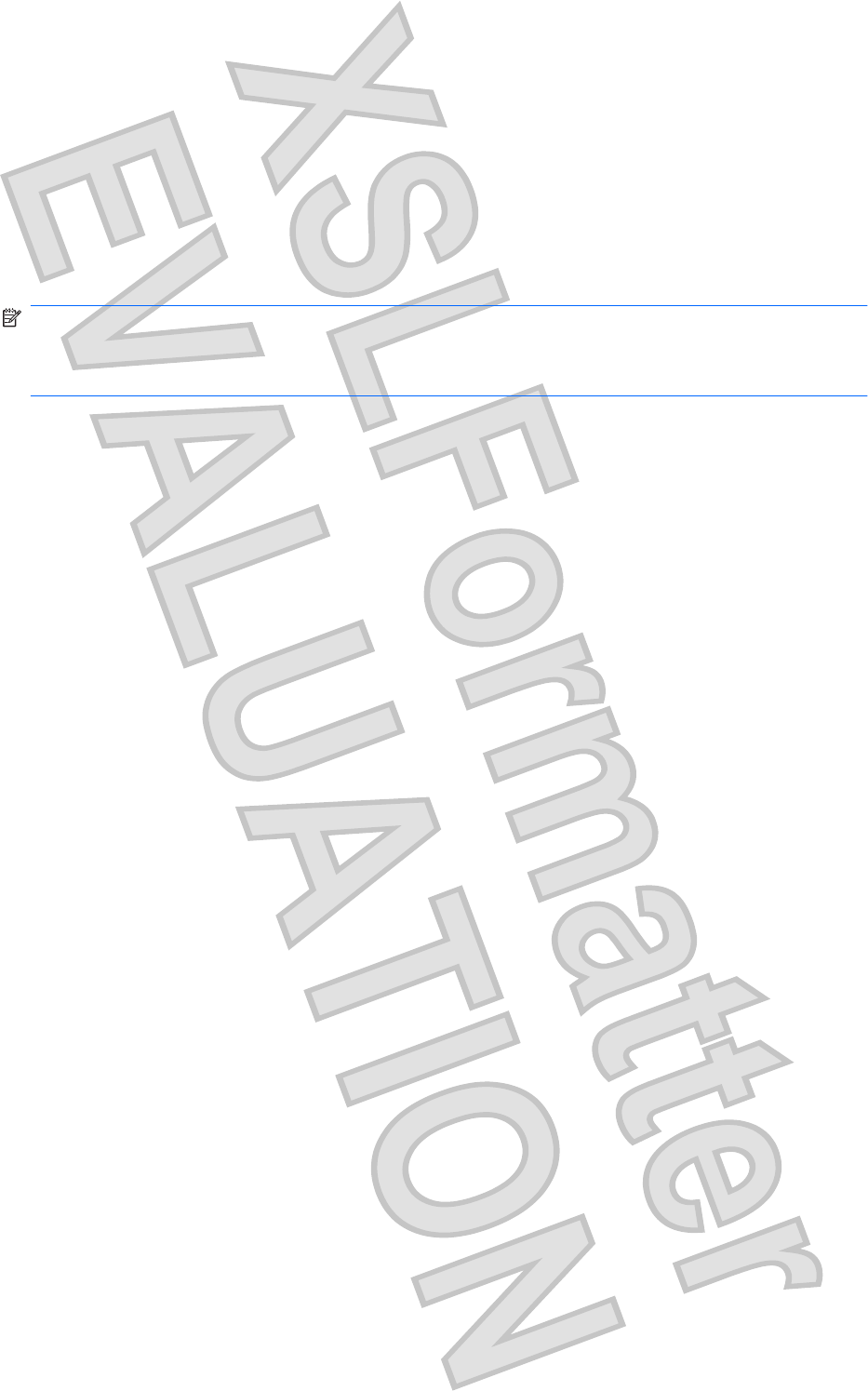
Using firewall software
When you use the computer for e-mail, network, or Internet access, unauthorized persons may be able
to gain access to the computer, your personal files, and information about you. Use the firewall software
preinstalled on the computer to protect your privacy.
Firewall features include logging and reporting of network activity, and automatic monitoring of all
incoming and outgoing traffic. Refer to the firewall user guide or contact your firewall manufacturer for
more information.
NOTE: Under some circumstances a firewall can block access to Internet games, interfere with printer
or file sharing on a network, or block authorized e-mail attachments. To temporarily resolve the problem,
disable the firewall, perform the task that you want to perform, and then reenable the firewall. To
permanently resolve the problem, reconfigure the firewall.
90 Chapter 9 Security
Antenna House XSL Formatter (Evaluation) http://www.antennahouse.com/
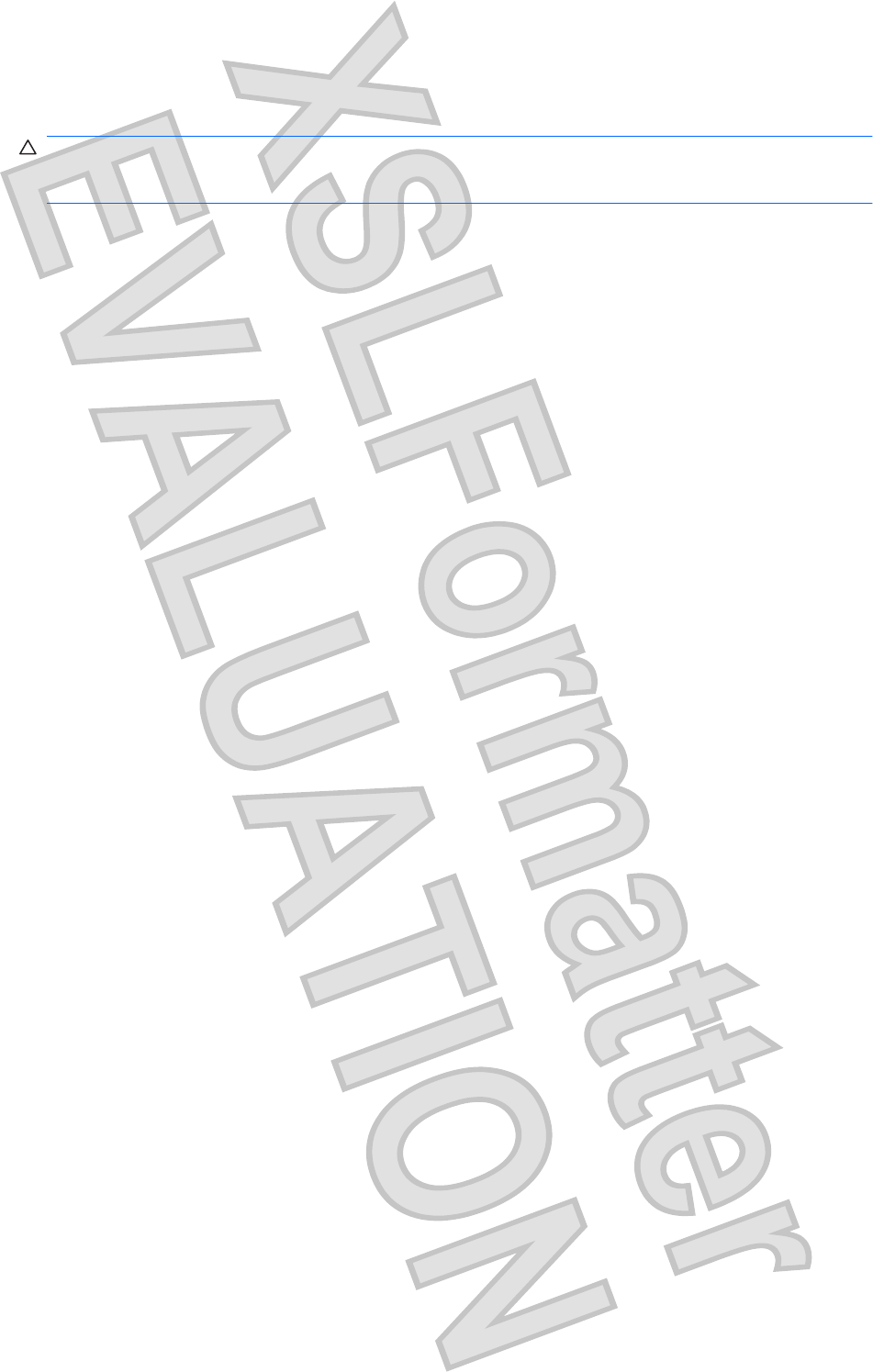
Installing critical security updates
CAUTION: Microsoft sends alerts regarding critical updates. To protect the computer from security
breaches and computer viruses, install all critical updates from Microsoft as soon as you receive an
alert.
Updates to the operating system and other software may have become available after the computer
was shipped. To be sure that all available updates are installed on the computer, observe these
guidelines:
łRun Windows Update as soon as possible after you set up your computer. Use the update link at
Start > All Programs > Windows Update.
łRun Windows Update monthly thereafter.
łObtain updates to Windows and other Microsoft® programs, as they are released, from the
Microsoft Web site and through the updates link in Help and Support.
Installing critical security updates 91
Antenna House XSL Formatter (Evaluation) http://www.antennahouse.com/
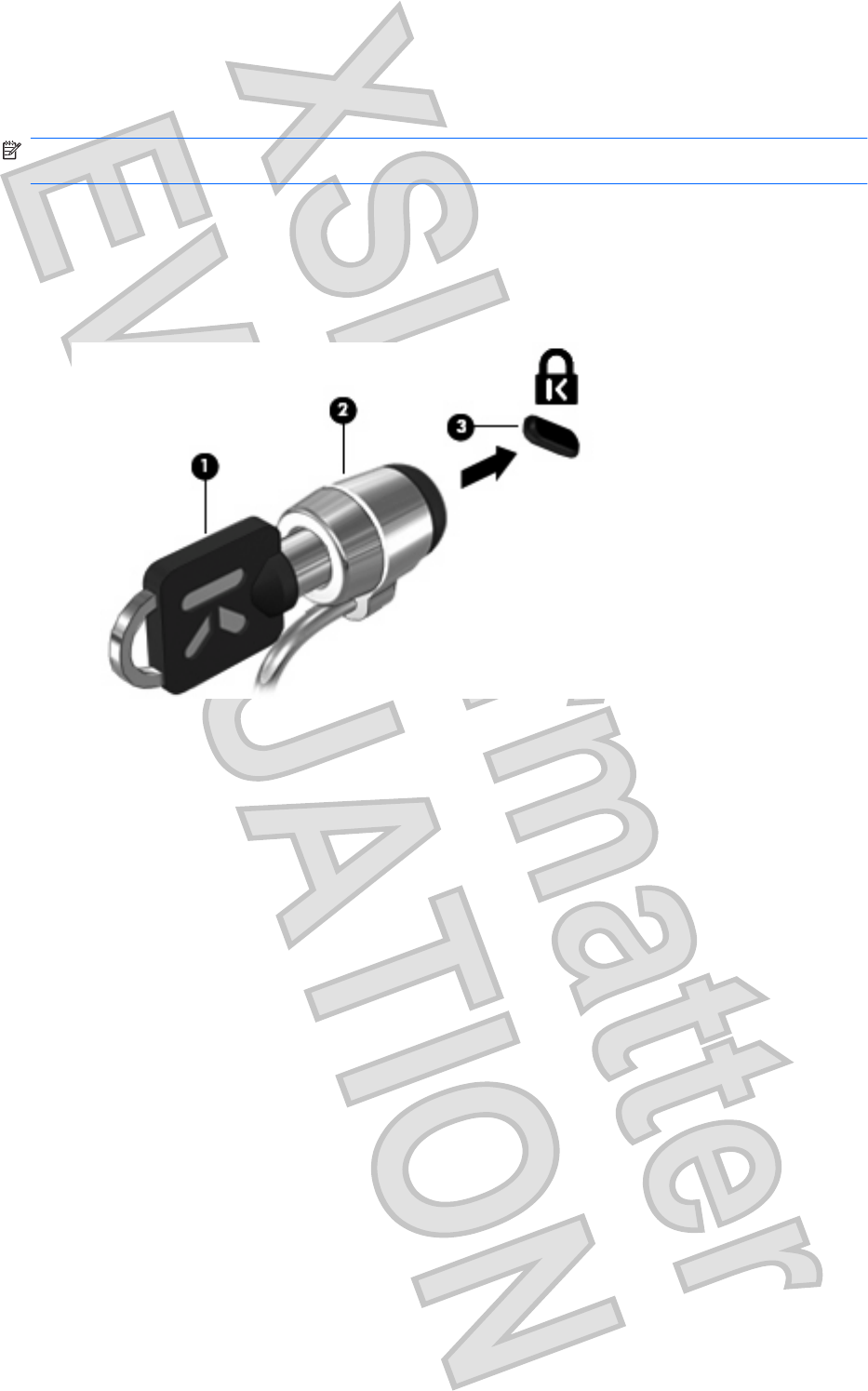
Installing an optional security cable
NOTE: A security cable is designed to act as a deterrent, but it may not prevent the computer from
being mishandled or stolen.
1. Loop the security cable around a secured object.
2. Insert the key (1) into the cable lock (2).
3. Insert the cable lock into the security cable slot on the computer (3), and then lock the cable lock
with the key.
4. Remove the key and keep it in a safe place.
92 Chapter 9 Security
Antenna House XSL Formatter (Evaluation) http://www.antennahouse.com/

A Setup Utility (BIOS)
93
Antenna House XSL Formatter (Evaluation) http://www.antennahouse.com/

Starting Setup Utility
Setup Utility is a ROM-based information and customization utility that can be used even when your
Windows® operating system is not working.
The utility reports information about the computer and provides settings for startup, security, and other
preferences.
To start Setup Utility:
⊡Open Setup Utility by turning on or restarting the computer. While the “Press the ESC key for
Startup Menu” message is displayed in the lower-left corner of the screen, press f10.
– or –
1. Open Setup Utility by turning on or restarting the computer. While the “Press the ESC key for
Startup Menu” message is displayed in the lower-left corner of the screen, press esc.
2. When the Startup Menu is displayed, press f10.
94 Appendix A Setup Utility (BIOS)
Antenna House XSL Formatter (Evaluation) http://www.antennahouse.com/

Using Setup Utility
Changing the language of Setup Utility
The following procedure explains how to change the language of Setup Utility. If Setup Utility is not
already running, begin at step 1. If Setup Utility is already running, begin at step 2.
1. Open Setup Utility by turning on or restarting the computer. While the “Press the ESC key for
Startup Menu” message is displayed in the lower-left corner of the screen, press f10.
– or –
Open Setup Utility by turning on or restarting the computer. While the “Press the ESC key for
Startup Menu” message is displayed in the lower-left corner of the screen, press esc. When the
Startup Menu is displayed, press f10.
2. Use the arrow keys to select System Configuration > Language, and then press enter.
3. Use the arrow keys to select a language, and then press enter.
4. When a confirmation prompt with your language selected is displayed, press enter.
5. To save your change and exit Setup Utility, use the arrow keys to select Exit > Exit Saving
Changes, and then press enter.
Your change goes into effect immediately.
Navigating and selecting in Setup Utility
Because Setup Utility is not Windows based, it does not support the TouchPad. Navigation and selection
are by keystroke.
łTo choose a menu or a menu item, use the arrow keys.
łTo choose an item in a list or to toggle a field, for example an Enable/Disable field, use either the
arrow keys or f5 or f6.
łTo select an item, press enter.
łTo close a text box or return to the menu display, press esc.
łTo display additional navigation and selection information while Setup Utility is open, press f1.
Using Setup Utility 95
Antenna House XSL Formatter (Evaluation) http://www.antennahouse.com/
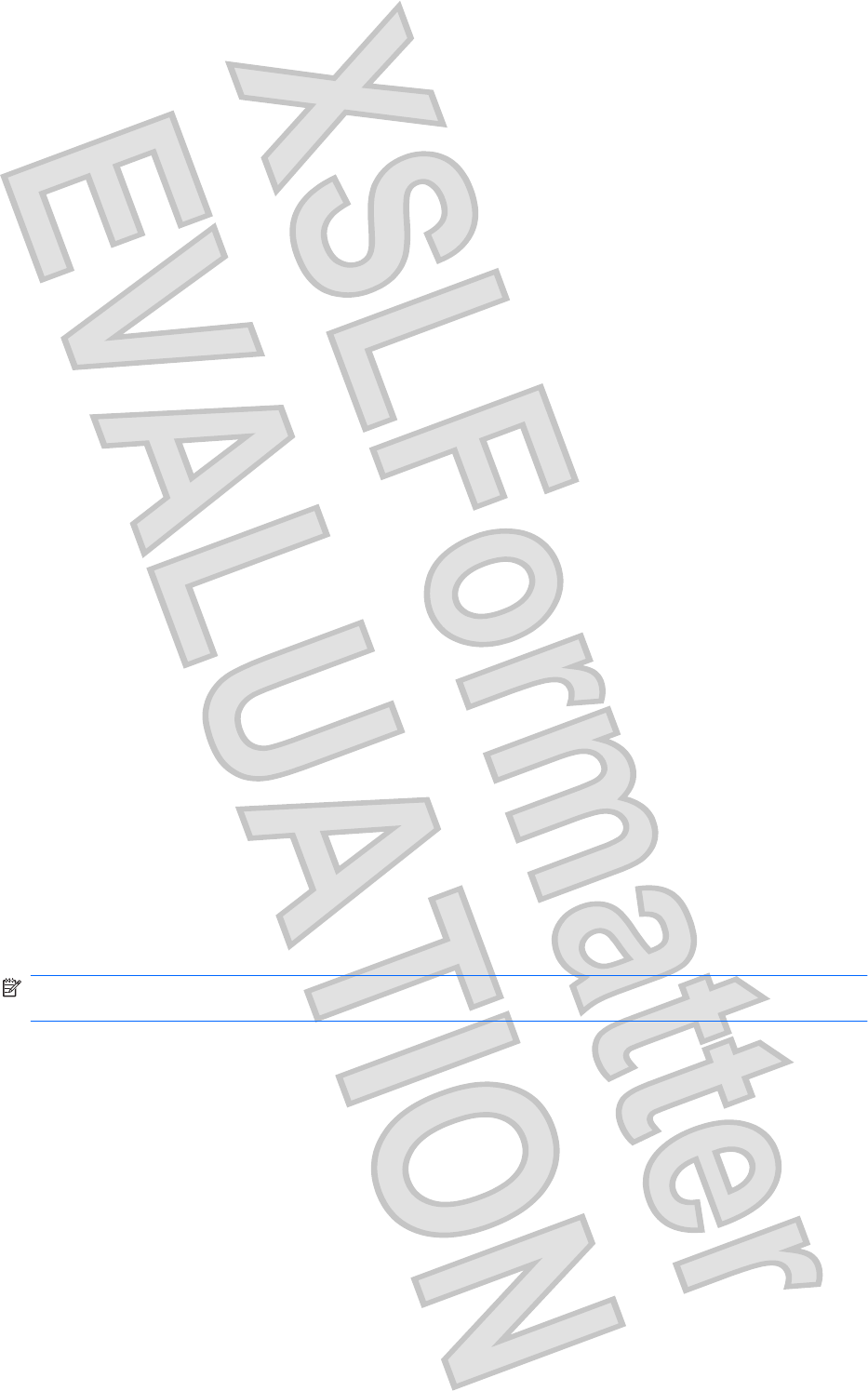
Displaying system information
The following procedure explains how to display system information in Setup Utility. If Setup Utility is
not open, begin at step 1. If Setup Utility is open, begin at step 2.
1. Open Setup Utility by turning on or restarting the computer. While the “Press the ESC key for
Startup Menu” message is displayed in the lower-left corner of the screen, press f10.
– or –
Open Setup Utility by turning on or restarting the computer. While the “Press the ESC key for
Startup Menu” message is displayed in the lower-left corner of the screen, press esc. When the
Startup Menu is displayed, press f10.
2. Select the Main menu. System information such as the system time and date, and identification
information about the computer is displayed.
3. To exit Setup Utility without changing any settings, use the arrow keys to select Exit > Exit
Discarding Changes, and then press enter.
Restoring default settings in Setup Utility
The following procedure explains how to restore the Setup Utility default settings. If Setup Utility is not
already running, begin at step 1. If Setup Utility is already running, begin at step 2.
1. Open Setup Utility by turning on or restarting the computer. While the “Press the ESC key for
Startup Menu” message is displayed in the lower-left corner of the screen, press f10.
– or –
Open Setup Utility by turning on or restarting the computer. While the “Press the ESC key for
Startup Menu” message is displayed in the lower-left corner of the screen, press esc. When the
Startup Menu is displayed, press f10.
2. Use the arrow keys to select Exit > Load Setup Defaults, and then press enter.
3. When the Setup Confirmation is displayed, press enter.
4. To save your change and exit Setup Utility, use the arrow keys to select Exit > Exit Saving
Changes, and then press enter.
The Setup Utility default settings go into effect when the computer restarts.
NOTE: Your password, security, and language settings are not changed when you restore the factory
default settings.
Exiting Setup Utility
You can exit Setup Utility with or without saving changes.
łTo exit Setup Utility and save your changes from the current session:
If the Setup Utility menus are not visible, press esc to return to the menu display. Then use the
arrow keys to select Exit > Exit Saving Changes, and then press enter.
łTo exit Setup Utility without saving your changes from the current session:
If the Setup Utility menus are not visible, press esc to return to the menu display. Then use the
arrow keys to select Exit > Exit Discarding Changes, and then press enter.
96 Appendix A Setup Utility (BIOS)
Antenna House XSL Formatter (Evaluation) http://www.antennahouse.com/

After either choice, the computer restarts in Windows.
Using Setup Utility 97
Antenna House XSL Formatter (Evaluation) http://www.antennahouse.com/

Setup Utility menus
The menu tables in this section provide an overview of Setup Utility options.
NOTE: Some of the Setup Utility menu items listed in this chapter may not be supported by your
computer.
Main menu
Select To do this
System information łView and change the system time and date.
łView identification information about the computer.
łView specification information, such as processor information,
memory size, and system BIOS.
Security menu
Select To do this
Administrator password Enter, change, or delete an administrator password.
Power-On Password Enter, change, or delete a power-on password.
System Configuration menu
Select To do this
Language Support Change the Setup Utility language.
Virtualization Technology Enable/disable the processor Virtualization Technology.
Fan Always On Enabled/disable Fan Always On. When enabled, the computer fan will
always be on.
Fast Charge Mode Enable/disable the Fast Charge Mode for the primary and accessory
batteries.
98 Appendix A Setup Utility (BIOS)
Antenna House XSL Formatter (Evaluation) http://www.antennahouse.com/
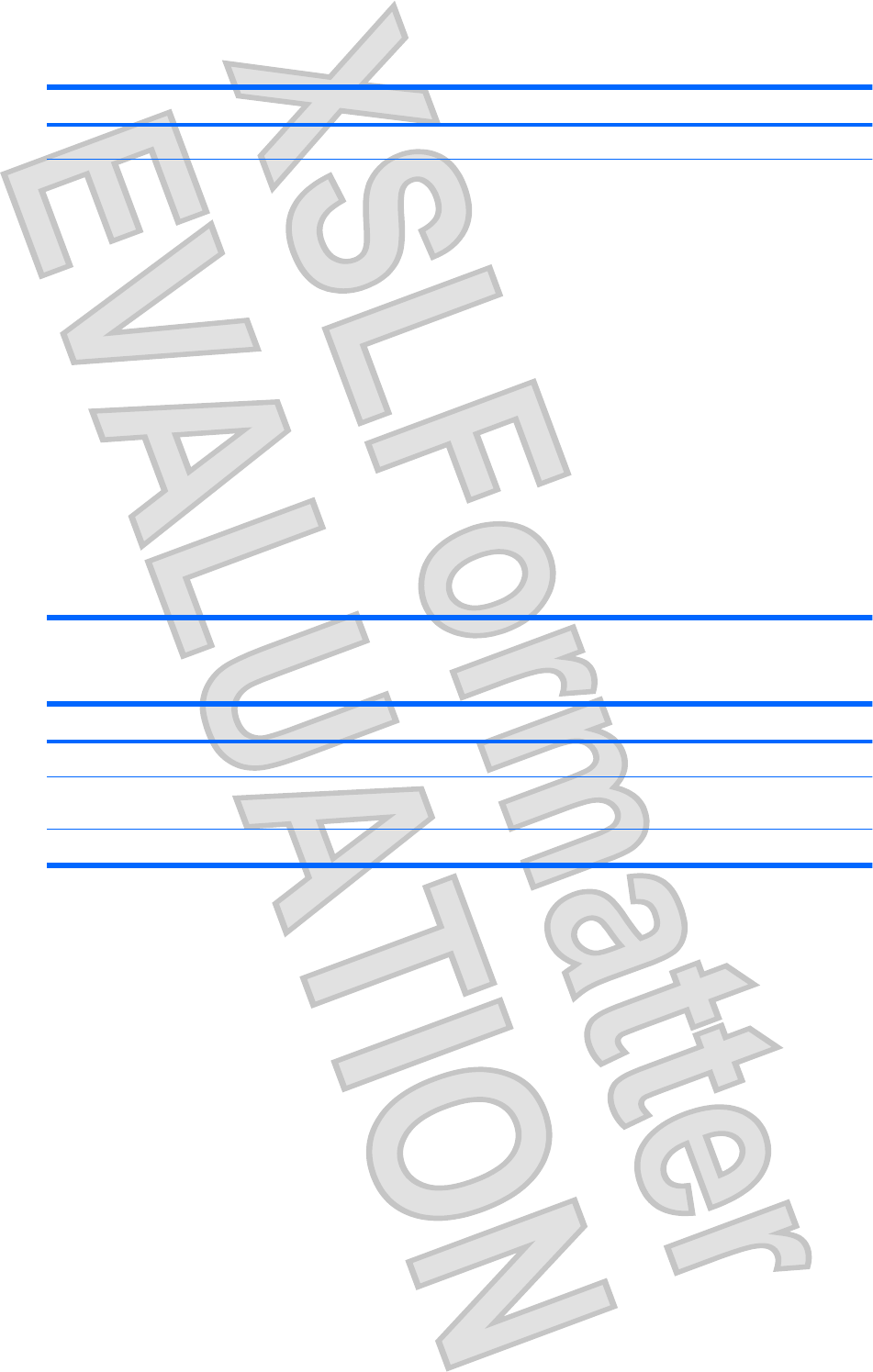
Select To do this
Action Key Mode Enable/disable the Action Key Mode.
Boot Options Set the following boot options:
łPOST Hot Key Delay (sec.)ʊSet the delay for the user to press hot
keys in intervals of 5 seconds each (0, 5, 10, 15, 20).
łHP QuickWeb—Enable/disable the HP QuickWeb Boot Menu during
Setup Utility. Set the delay for the user to start HP QuickWeb in
intervals of 5 seconds each (0, 5, 10, 15, 20).
łFloppy BootʊEnable/disable boot from diskette.
łNetwork Adapter BootʊEnable/disable boot from external Network
Adapter.
łBoot OrderʊSet the boot order for:
ŃNotebook Hard Drive
ŃUSB Diskette on Key/USB Hard Drive
ŃUSB CD/DVD ROM Drive
ŃUSB Floppy
ŃNetwork adapter
Diagnostics menu
Select To do this
Primary Hard Disk Self Test Run a comprehensive self-test on the primary hard drive.
Secondary Hard Disk Self Test (select models
only)
Run a comprehensive self-test on the secondary hard drive.
Memory Test Run a diagnostic test on the system memory.
Setup Utility menus 99
Antenna House XSL Formatter (Evaluation) http://www.antennahouse.com/
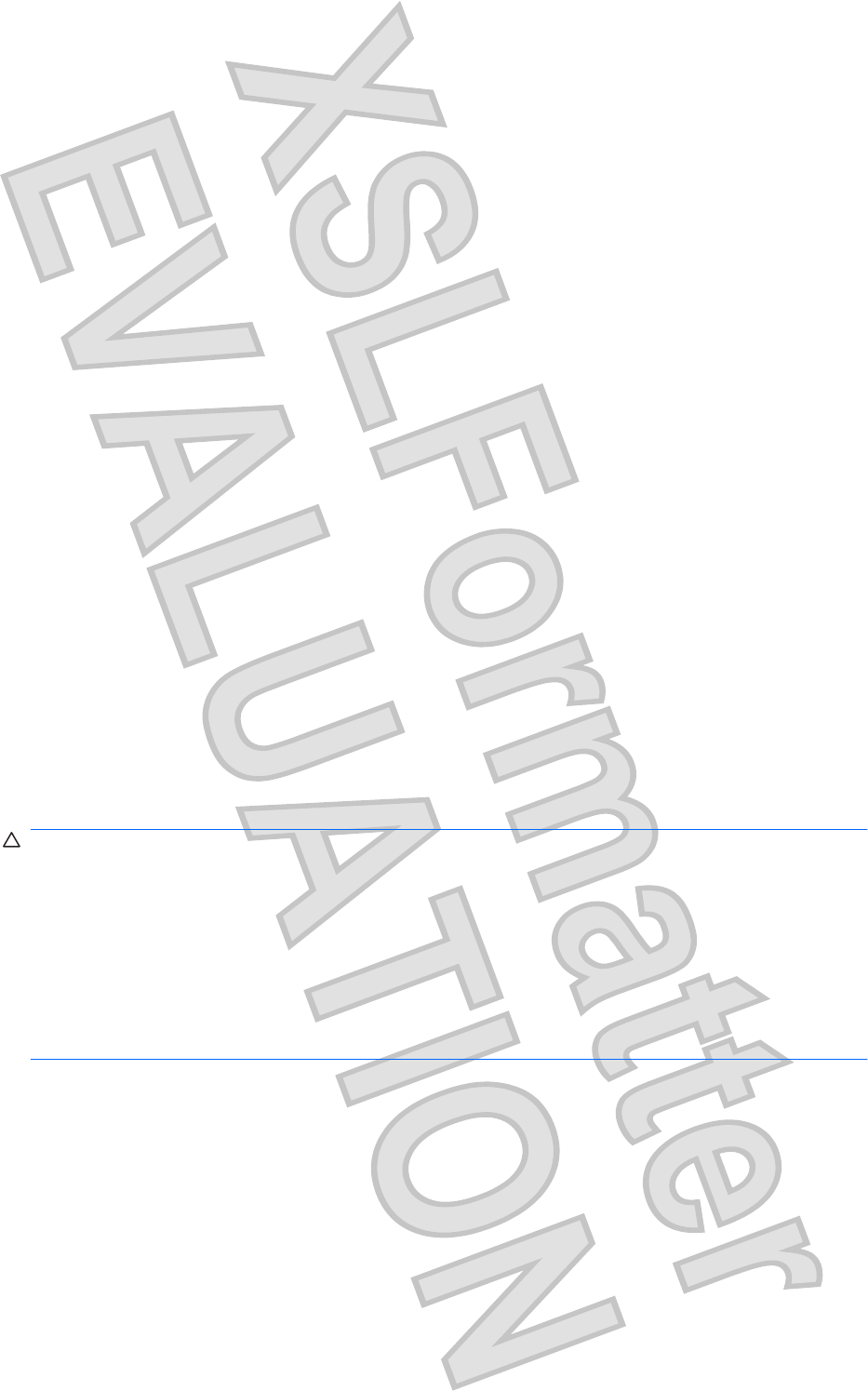
Updating the BIOS
Updated versions of the BIOS may be available on the HP Web site.
Most BIOS updates on the HP Web site are packaged in compressed files called SoftPaqs.
Some download packages contain a file named Readme.txt, which contains information regarding
installing and troubleshooting the file.
Updating the BIOS
Determining the BIOS version
To determine whether available BIOS updates contain later BIOS versions than those currently installed
on the computer, you need to know the version of the system BIOS currently installed.
BIOS version information (also known as ROM date and System BIOS) can be displayed by pressing
fn+esc (if you are already in Windows) or by opening Setup Utility.
To use Setup Utility for displaying BIOS information:
1. Open Setup Utility by turning on or restarting the computer. While the “Press the ESC key for
Startup Menu” message is displayed in the lower-left corner of the screen, press f10.
2. If Setup Utility does not open with the system information displayed, use the arrow keys to select
the Main menu.
When the Main menu is selected, BIOS and other system information is displayed.
3. To exit Setup Utility, use the arrow keys to select Exit > Exit Discarding Changes, and then press
enter.
Downloading a BIOS update
CAUTION: To prevent damage to the computer or an unsuccessful installation, download and install
a BIOS update only when the computer is connected to reliable external power using the AC adapter.
Do not download or install a BIOS update while the computer is running on battery power, docked in an
optional docking device, or connected to an optional power source. During the download and installation,
follow these instructions:
Do not disconnect power from the computer by unplugging the power cord from the AC outlet.
Do not shut down the computer or initiate Sleep or Hibernation.
Do not insert, remove, connect, or disconnect any device, cable, or cord.
100 Appendix A Setup Utility (BIOS)
Antenna House XSL Formatter (Evaluation) http://www.antennahouse.com/
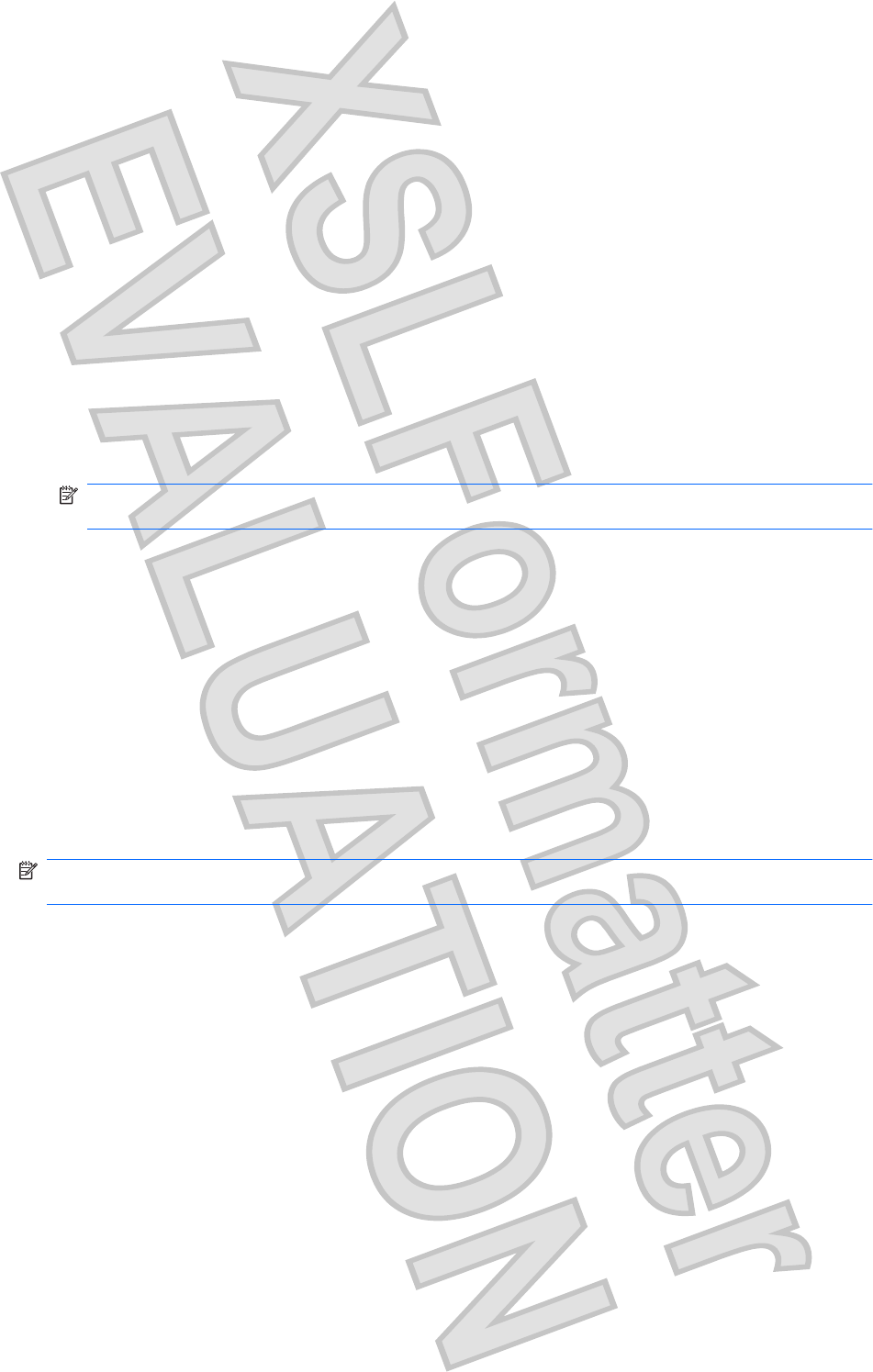
To download a BIOS update:
1. Access the page on the HP Web site that provides software for your computer:
Select Start > Help and Support > Maintain.
2. Follow the instructions on the screen to identify your computer and access the BIOS update you
want to download.
3. At the download area, follow these steps:
a. Identify the BIOS update that is later than the BIOS version currently installed on your
computer. Make a note of the date, name, or other identifier. You may need this information
to locate the update later, after it has been downloaded to your hard drive.
b. Follow the instructions on the screen to download your selection to the hard drive.
Make a note of the path to the location on your hard drive where the BIOS update will be
downloaded. You will need to access this path when you are ready to install the update.
NOTE: If you connect your computer to a network, consult the network administrator before
installing any software updates, especially system BIOS updates.
BIOS installation procedures vary. Follow any instructions that are displayed on the screen after the
download is complete. If no instructions are displayed, follow these steps:
1. Open Windows Explorer by selecting Start > Computer.
2. Double-click your hard drive designation. The hard drive designation is typically Local Disk (C:).
3. Using the hard drive path you recorded earlier, open the folder on your hard drive that contains the
update.
4. Double-click the file that has an .exe extension (for example, filename.exe).
The BIOS installation begins.
5. Complete the installation by following the instructions on the screen.
NOTE: After a message on the screen reports a successful installation, you can delete the downloaded
file from your hard drive.
Updating the BIOS 101
Antenna House XSL Formatter (Evaluation) http://www.antennahouse.com/
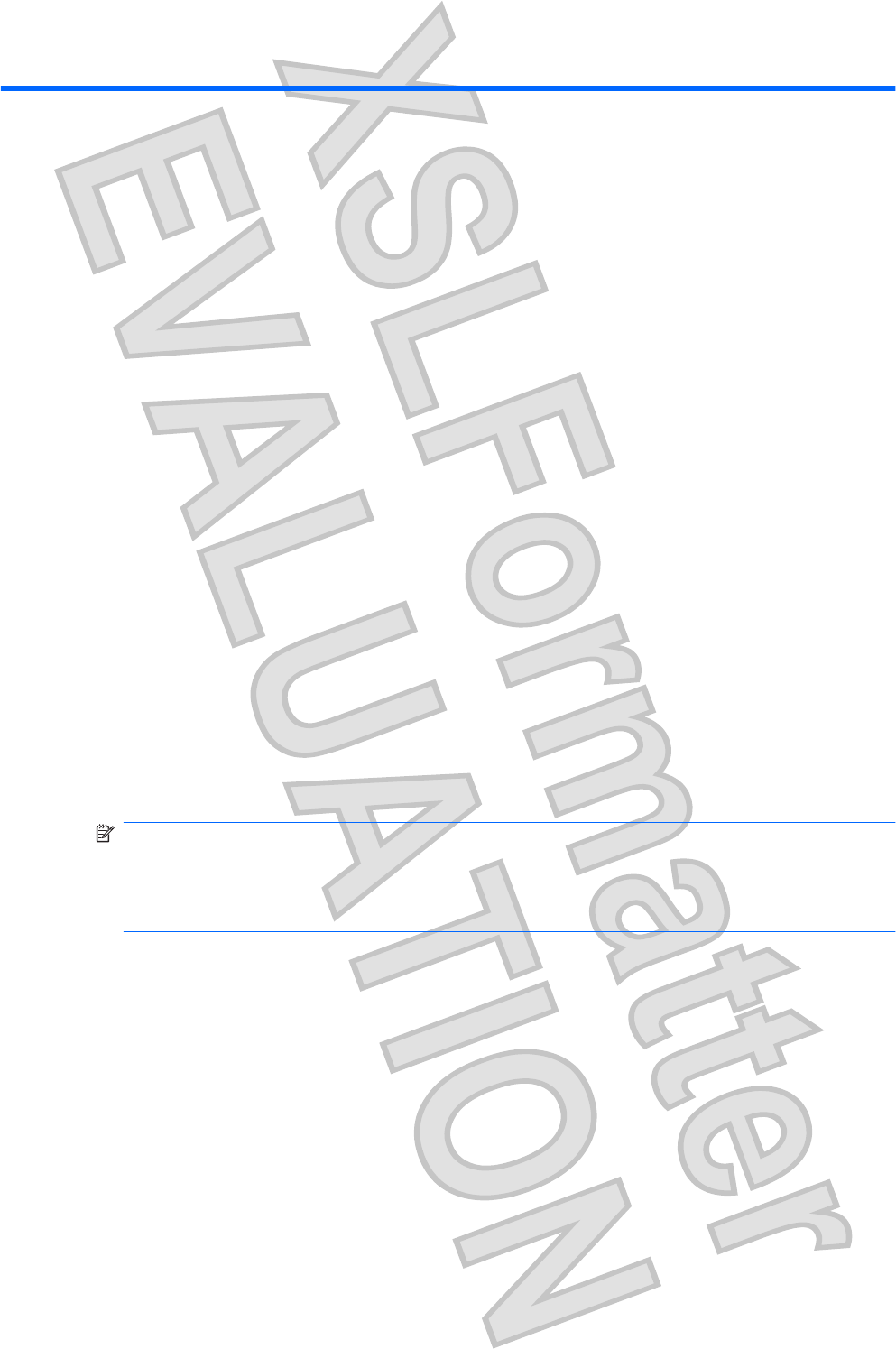
B Backup and recovery
Recovery after a system failure is as complete as your most current backup. HP recommends that you
create recovery discs immediately after software setup. As you add new software and data files, you
should continue to back up your system on a regular basis to maintain a reasonably current backup.
Tools provided by the operating system and HP Recovery Manager software are designed to help you
with the following tasks for safeguarding your information and restoring it in case of a system failure:
łCreating a set of recovery discs (Recovery Manager software feature). Recovery discs are used
to start up (boot) your computer and restore the operating system and software programs to factory
settings in case of system failure or instability.
łBacking up your information regularly to protect your important system files.
łCreating system restore points (operating system feature). System restore points allow you to
reverse undesirable changes to your computer by restoring the computer to an earlier state.
łRecovering a program or driver (Recovery Manager software feature). This feature helps you
reinstall a program or driver without performing a full system recovery.
łPerforming a full system recovery (Recovery Manager software feature). With Recovery Manager,
you can recover your full factory image if you experience system failure or instability. Recovery
Manager works from a dedicated recovery partition (select models only) on the hard drive or from
recovery discs you create.
NOTE: Computers with a solid-state drive (SSD) may not have a recovery partition. Recovery
discs have been included for computers that do not have a partition. Use these discs to recover
your operating system and software. To check for the presence of a recovery partition, select
Start, right-click Computer, click Manage, and then click Disk Management. If the partition is
present, an HP Recovery drive is listed in the window.
102 Appendix B Backup and recovery
Antenna House XSL Formatter (Evaluation) http://www.antennahouse.com/
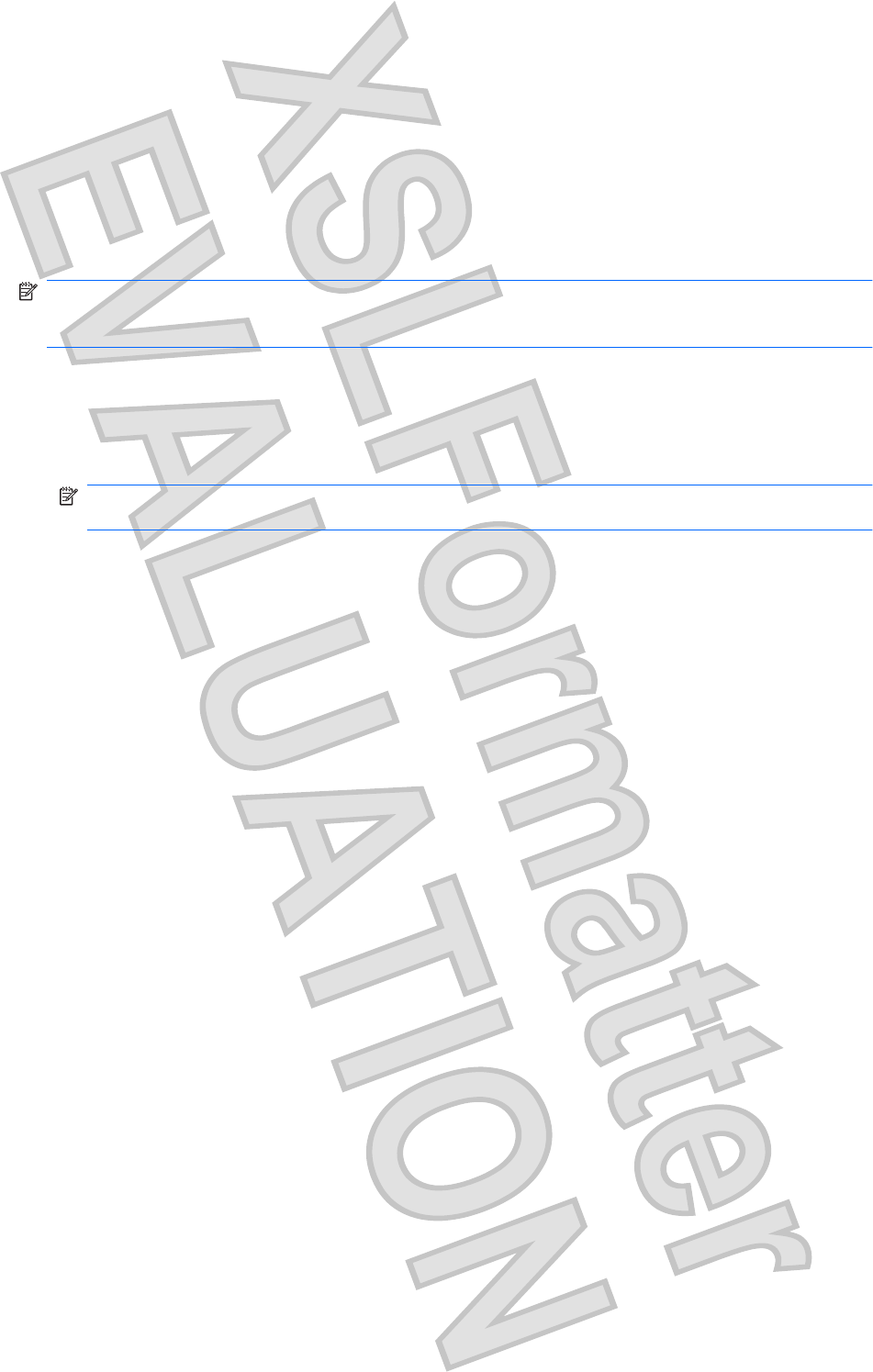
Creating recovery discs
HP recommends that you create recovery discs to be sure that you can restore your system to its original
factory state if you experience serious system failure or instability. Create these discs after setting up
the computer for the first time.
Handle these discs carefully and keep them in a safe place. The software allows the creation of only
one set of recovery discs.
NOTE: If your computer does not include an internal optical drive, you can use an optional external
optical drive (purchased separately) to create recovery discs, or you can purchase recovery discs for
your computer from the HP Web site.
Note the following guidelines before creating recovery discs:
łYou will need high-quality DVD-R, DVD+R, BD-R (writable Blu-ray), or CD-R discs. All these discs
are purchased separately. DVDs and BDs have a much higher capacity than CDs. If you use CDs,
up to 20 discs may be required, whereas only a few DVDs or BDs are required.
NOTE: Read-write discs, such as CD-RW, DVD±RW, double-layer DVD±RW, and BD-RE
(rewritable Blu-ray) discs, are not compatible with the Recovery Manager software.
łThe computer must be connected to AC power during this process.
łOnly one set of recovery discs can be created per computer.
łNumber each disc before inserting it into the optical drive.
łIf necessary, you can exit the program before you have finished creating the recovery discs. The
next time you open Recovery Manager, you will be prompted to continue the disc creation process.
To create a set of recovery discs:
1. Select Start > All Programs > Recovery Manager > Recovery Disc Creation.
2. Follow the on-screen instructions.
Creating recovery discs 103
Antenna House XSL Formatter (Evaluation) http://www.antennahouse.com/
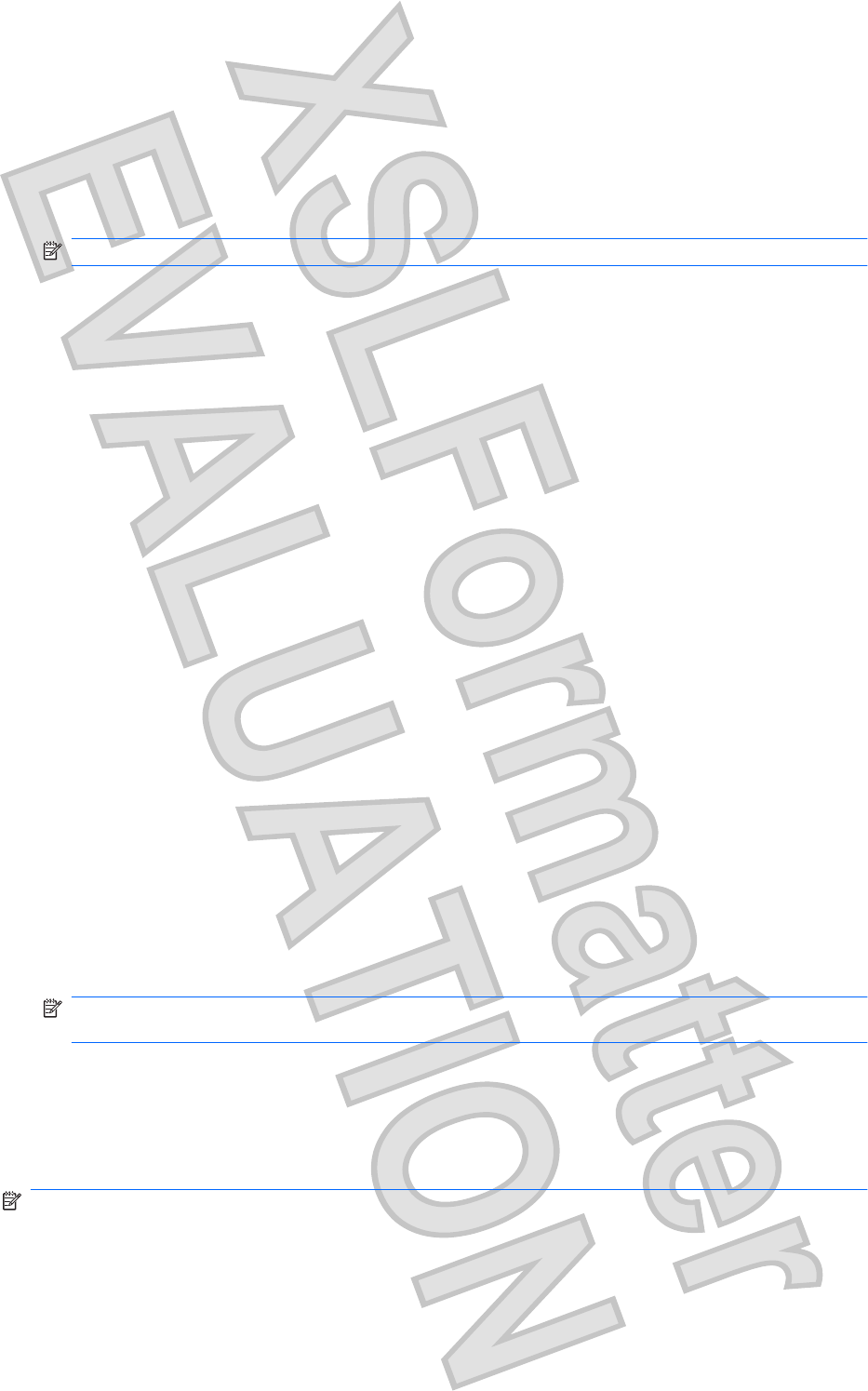
Backing up your information
As you add new software and data files, you should back up your system on a regular basis to maintain
a reasonably current backup. Back up your system at the following times:
łAt regularly scheduled times
NOTE: Set reminders to back up your information periodically.
łBefore the computer is repaired or restored
łBefore you add or modify hardware or software
Note the following when backing up:
łCreate system restore points using the Windows® System Restore feature, and periodically copy
them to disc.
łStore personal files in the Documents library and back up this folder periodically.
łBack up templates stored in their associated programs.
łSave customized settings in a window, toolbar, or menu bar by taking a screen shot of your settings.
The screen shot can be a time-saver if you have to reset your preferences.
To copy the screen and paste it into a word-processing document, follow these steps:
1. Display the screen.
2. Copy the screen:
To copy only the active window, press alt+prt sc.
To copy the entire screen, press prt sc.
3. Open a word-processing document, and then select Edit > Paste.
4. Save the document.
łYou can back up your information to an optional external hard drive, a network drive, or discs.
łWhen backing up to discs, use any of the following types of discs (purchased separately): CD-R,
CD-RW, DVD+R, DVD-R, or DVD±RW. The discs you use will depend on the type of optical drive
connected to your computer.
NOTE: DVDs store more information than CDs, so using them for backup reduces the number
of recovery discs required.
łWhen backing up to discs, number each disc before inserting it into the optical drive of the computer.
Using Windows Backup and Restore
To create a backup using Windows Backup and Restore, follow these steps:
NOTE: Be sure that the computer is connected to AC power before you start the backup process.
104 Appendix B Backup and recovery
Antenna House XSL Formatter (Evaluation) http://www.antennahouse.com/
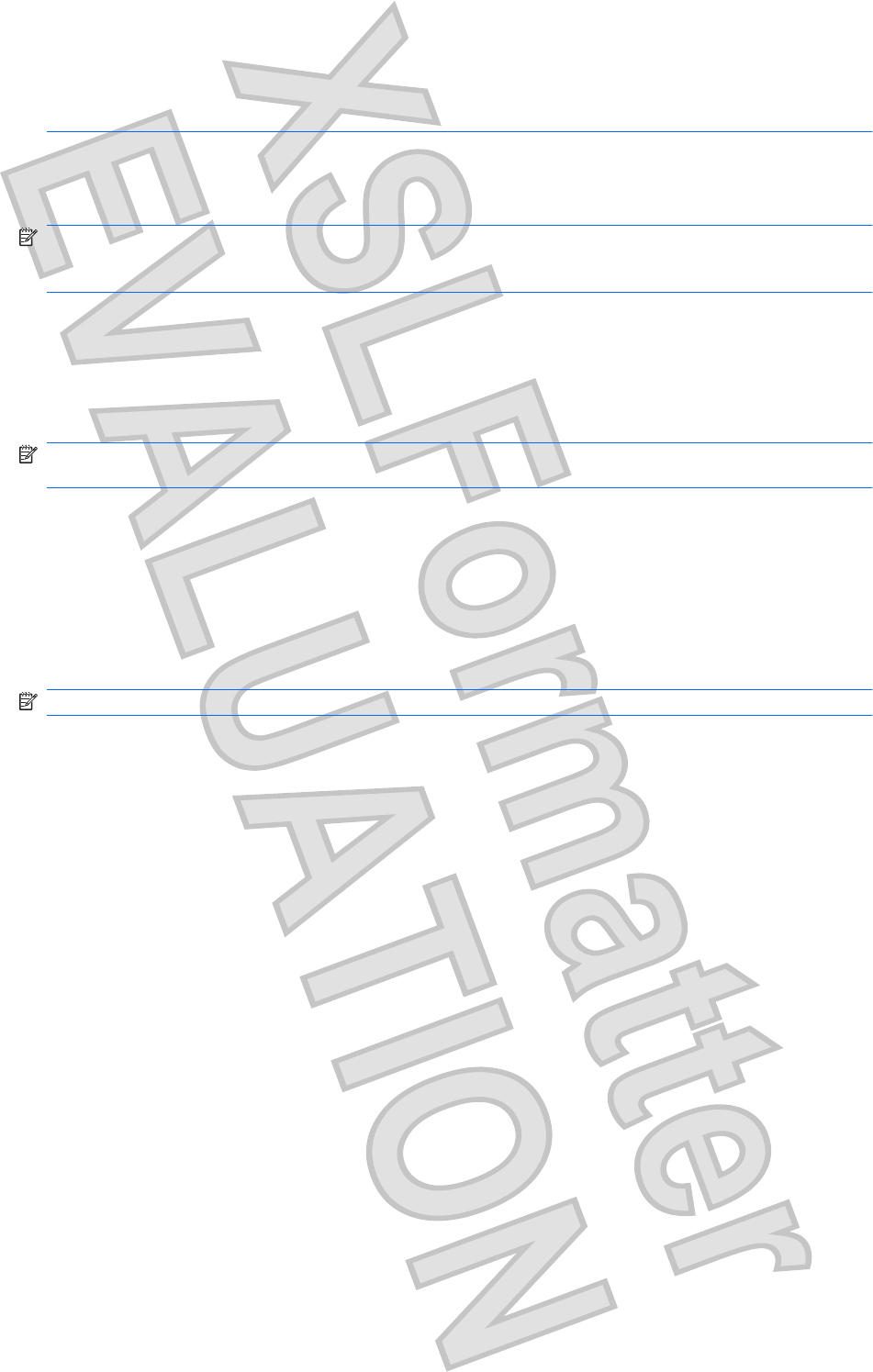
NOTE: The backup process may take over an hour, depending on file size and the speed of the
computer.
1. Select Start > All Programs > Maintenance > Backup and Restore.
2. Follow the on-screen instructions to set up and create a backup.
NOTE: Windows® includes the User Account Control feature to improve the security of your computer.
You may be prompted for your permission or password for tasks such as installing software, running
utilities, or changing Windows settings. Refer to Help and Support for more information.
Using system restore points
When you back up your system, you are creating a system restore point. A system restore point allows
you to save and name a snapshot of your hard drive at a specific point in time. You can then recover
back to that point if you want to reverse subsequent changes made to your system.
NOTE: Recovering to an earlier restore point does not affect data files saved or e-mails created since
the last restore point.
You also can create additional restore points to provide increased protection for your system files and
settings.
When to create restore points
łBefore you add or extensively modify software or hardware
łPeriodically, whenever the system is performing optimally
NOTE: If you revert to a restore point and then change your mind, you can reverse the restoration.
Create a system restore point
1. Select Start > Control Panel > System and Security > System.
2. In the left pane, click System Protection.
3. Click the System Protection tab.
4. Under Protection Settings, select the disk for which you want to create a restore point.
5. Click Create.
6. Follow the on-screen instructions.
Restore to a previous date and time
To revert to a restore point (created at a previous date and time), when the computer was functioning
optimally, follow these steps:
1. Select Start > Control Panel > System and Security > System.
2. In the left pane, click System protection.
3. Click the System Protection tab.
4. Click System Restore.
5. Follow the on-screen instructions.
Backing up your information 105
Antenna House XSL Formatter (Evaluation) http://www.antennahouse.com/
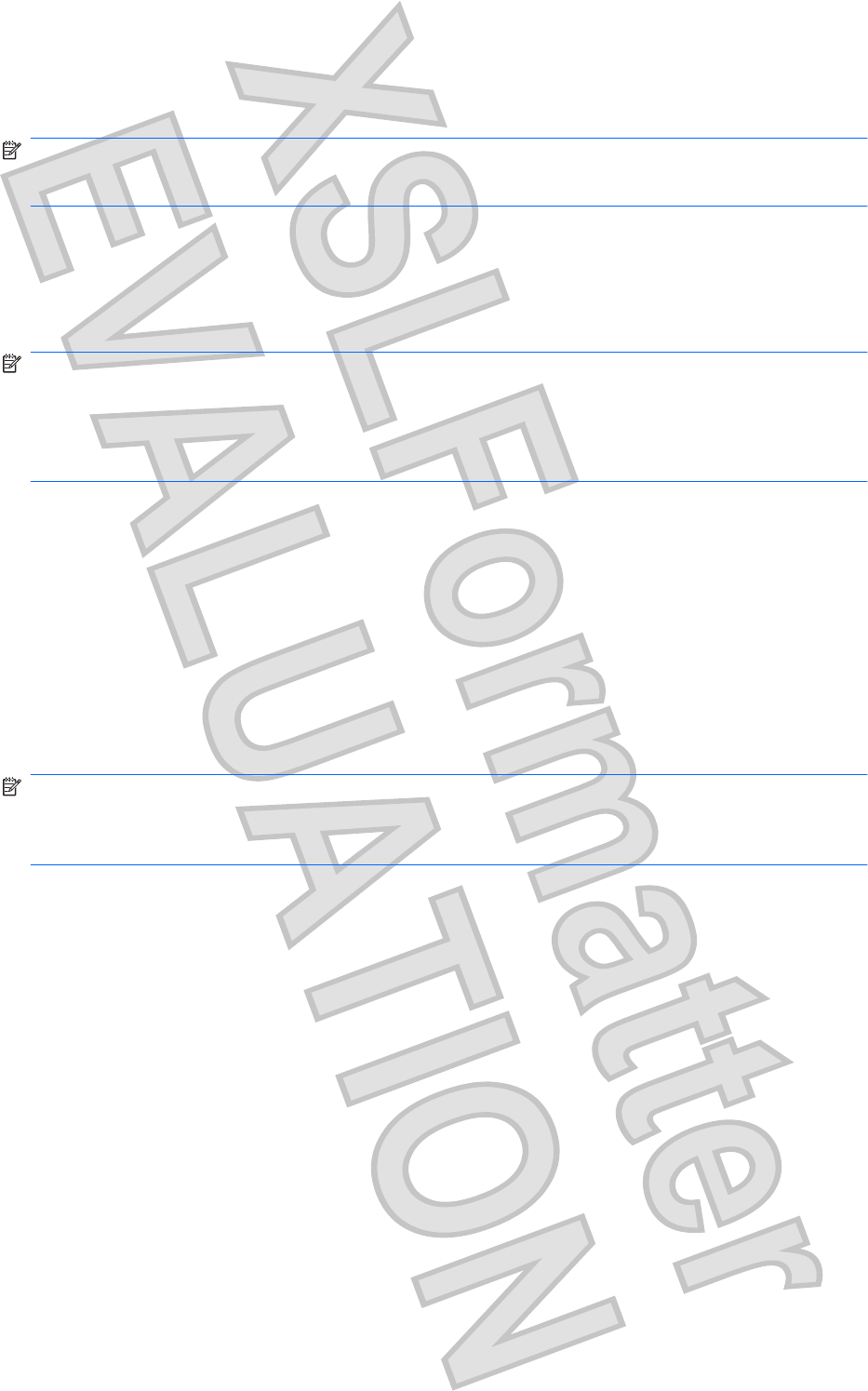
Performing a recovery
NOTE: You can recover only files that you have previously backed up. HP recommends that you use
HP Recovery Manager to create a set of recovery discs (entire drive backup) as soon as you set up
your computer.
Recovery Manager software allows you to repair or restore the system if you experience system failure
or instability. Recovery Manager works from recovery discs or from a dedicated recovery partition (select
models only) on the hard drive. However, if your computer includes a solid-state drive (SSD), you may
not have a recovery partition. If that is the case, recovery discs have been included with your computer.
Use these discs to recover your operating system and software.
NOTE: Windows has its own built-in repair features, such as System Restore. If you have not already
tried these features, try them before using Recovery Manager.
NOTE: Recovery Manager recovers only software that was preinstalled at the factory. Software not
provided with this computer must be downloaded from the manufacturer's Web site or reinstalled from
the disc provided by the manufacturer.
Recovering using the recovery discs
To restore the system from the recovery discs:
1. Back up all personal files.
2. Insert the first recovery disc into the optical drive and restart the computer.
3. Follow the on-screen instructions.
Recovering using the dedicated recovery partition (select models only)
NOTE: Computers with an SSD may not have a recovery partition. If the computer does not have a
recovery partition, you will not be able to recover using this procedure. Recovery discs have been
included for computers that do not have a partition. Use these discs to recover your operating system
and software.
On some models, you can perform a recovery from the partition on the hard drive, accessed by pressing
either the Start button or f11. This restores the computer to its factory condition.
To restore the system from the partition, follow these steps:
1. Access Recovery Manager in either of the following ways:
łSelect Start > All Programs > Recovery Manager > Recovery Manager.
– or –
łTurn on or restart the computer, and then press esc while the “Press the ESC key for Startup
Menu” message is displayed at the bottom of the screen. Then, press f11 while the “Press
<F11> for recovery” message is displayed on the screen.
2. Click System Recovery in the Recovery Manager window.
3. Follow the on-screen instructions.
106 Appendix B Backup and recovery
Antenna House XSL Formatter (Evaluation) http://www.antennahouse.com/
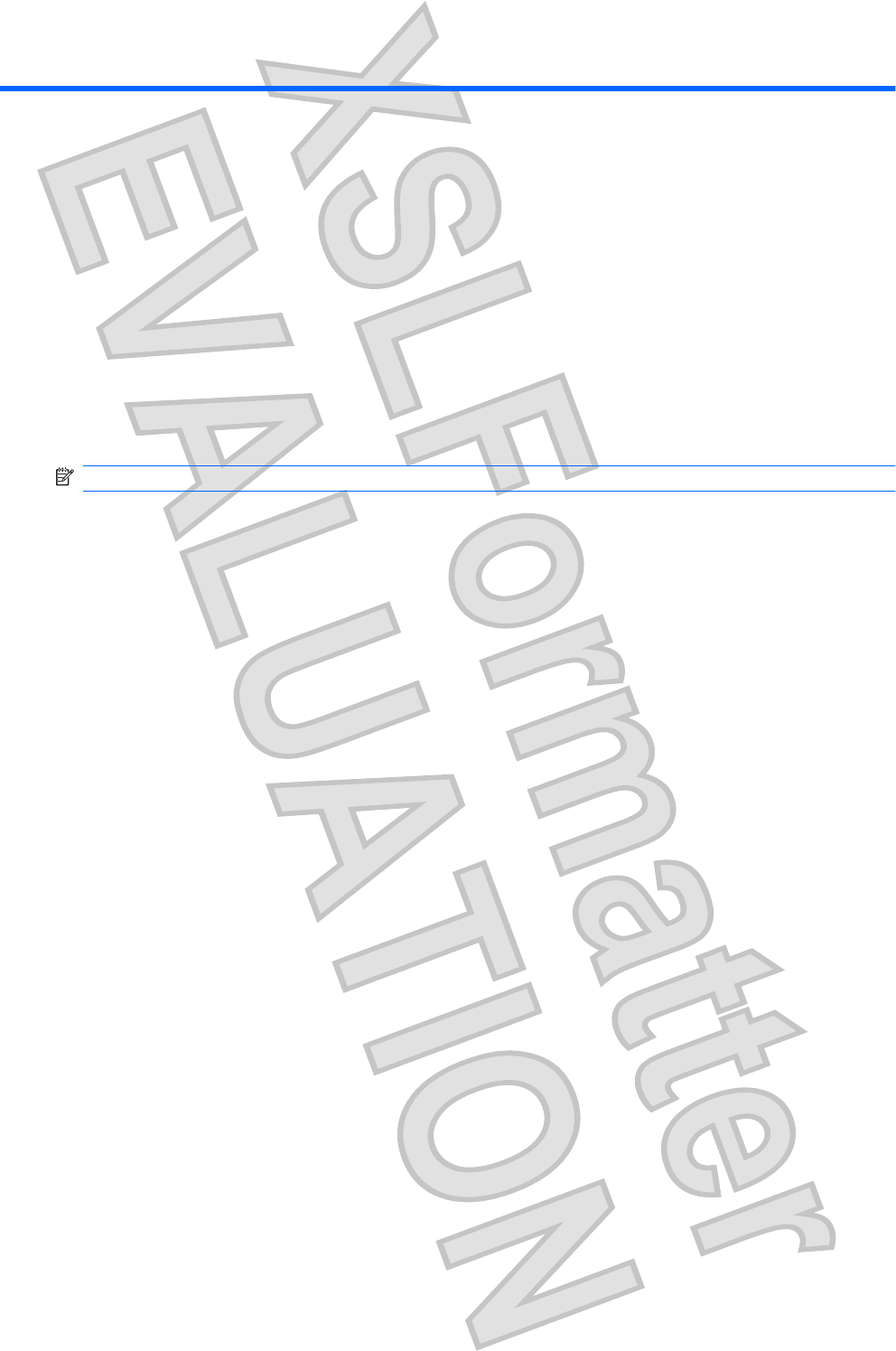
C RAID 0 (select models only)
Select computer models with two solid-state drives (SSDs) ship in a RAID 0 configuration. RAID benefits
users who frequently work with large files and want to improve the storage performance of their
computer. With RAID 0, data is distributed across both drives. This allows data, especially large files,
to be read faster because data is read simultaneously from both drives. However, RAID 0 offers no fault
tolerance, which means that the entire array fails if one drive fails.
NOTE: QuickWeb software is not supported on computers with two solid-state drives.
To enhance the write performance of RAID 0, Intel® Matrix Storage Manager software has implemented
a volume write-back cache. The volume write-back cache allows writes to be buffered and improves
coalescing. The cache is enabled by default and can be disabled or reenabled in the Intel® Matrix
Storage Console. An Uninterrupted Power Supply (UPS) is recommended for use if the cache is
enabled.
107
Antenna House XSL Formatter (Evaluation) http://www.antennahouse.com/
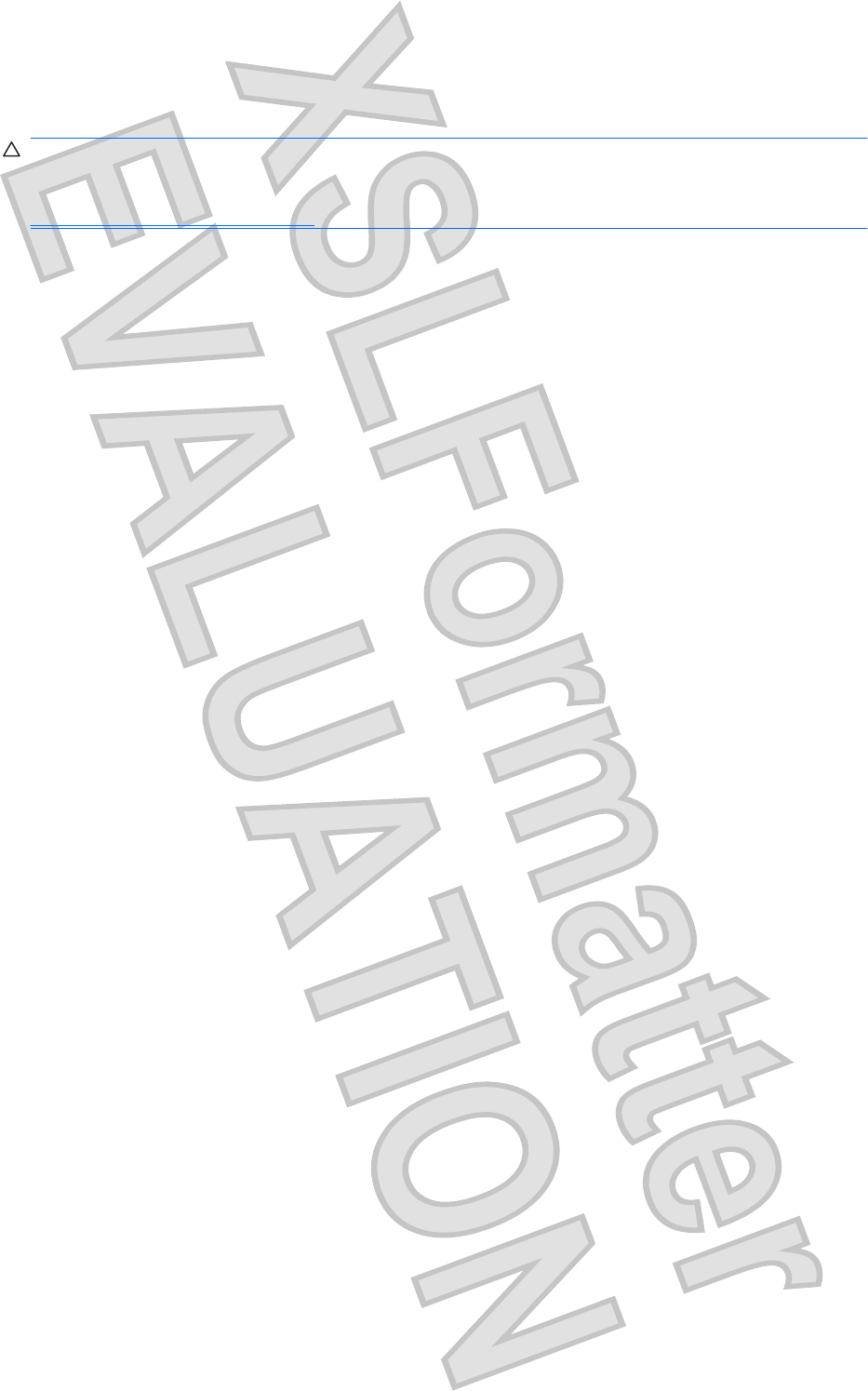
Disabling RAID 0
CAUTION: Disabling RAID 0 completely erases hard drive contents and reformats the hard drive. All
files you have created and any software installed on the computer are permanently removed. Before
you disable RAID 0, be sure to back up your information and create a set of recovery discs. Refer to
Backup and recovery on page 102 for additional information.
To disable RAID 0:
1. Back up all personal files.
2. Turn on or restart the computer.
3. When the POST screen opens, press ctrl+I to enter the configuration utility.
4. In the Main menu, use the up or down arrow key to select 3. Reset Disks to Non-RAID, and then
press enter. The Reset RAID Data window is displayed.
5. Press the space bar to select the first SSD drive, and then press the down arrow key and the space
bar to select the second SSD drive.
6. Press enter, and then press Y to confirm the selection.
7. Use the down arrow key to select 5. Exit.
8. Press enter, and then press Y to boot the system.
9. Restore the system from the recovery discs:
a. Insert the first recovery disc into an optional external optical drive and restart the computer.
b. Follow the on-screen instructions.
108 Appendix C RAID 0 (select models only)
Antenna House XSL Formatter (Evaluation) http://www.antennahouse.com/

Index
A
AC adapter
identifying 11
testing 53
AC power, connecting 52
accessory battery
components 59
inserting 59
removing 59
accessory battery charge
lights 59
accessory battery connector,
identifying 9
accessory battery fuel gauge 59
action key mode 99
action keys
adjusting volume 29
audio CD, DVD, or BD
controls 29
decreasing screen
brightness 29
Help and Support 29
identifying 6
increasing screen
brightness 29
muting speaker sound 30
QuickLock 30
switching screen image 29
using 29
volume 34
adaptive brightness, using 46
administrator password
creating 87
entering 87
managing 87
airport security devices 65
ambient light sensor
adaptive brightness 46
identifying 10
using 46
webcam IR light 46
antennas 10
antivirus software, using 89
audio devices, connecting
external 38
audio functions, checking 38
audio-in (microphone) jack,
identifying 8
audio-out (headphone) jack,
identifying 8
B
backing up
customized window, toolbar,
and menu bar settings 104
personal files 104
templates 104
battery
calibrating 61
charging 56
charging sequence 61
conserving power 50
discharging 57
disposing 62
Fast Charge Mode 61
inserting 55
low battery levels 57
removing 55
replacing 62
storing 62
battery bay, identifying 9
Battery Check 54
battery light 8, 56
battery lock, identifying 9
battery power 54
battery release latch 9, 55
battery temperature 62
BD drive 68
Beats Audio, using 39
BIOS, updating 100
Bluetooth device 15
Bluetooth label 12
Bluetooth wireless devices 21
boot options 99
boot order 99
buttons
left TouchPad 4
power 5
right TouchPad 4
TouchPad on/off 4
C
cables
eSATA 72
USB 71
calculator key, identifying 6
calibrating battery 61
caps lock light, identifying 4
CD drive 68
Certificate of Authenticity label 12
charging batteries 56
checking audio functions 38
cleaning, TouchPad and
keyboard 32
components
additional hardware 11
bottom 9
display 10
front 7
left-side 8
right-side 7
top 3
configuring HDMI 43
connection, external power 52
connector, power 8
conservation, power 50
cord, power 11
critical battery level 49, 57
Index 109
Antenna House XSL Formatter (Evaluation) http://www.antennahouse.com/

critical security updates,
installing 91
D
default settings, restoring 96
Diagnostics menu 99
digital card
inserting 73
removing 74
supported formats 73
Digital Media Slot, identifying 7
Disk Cleanup software 66
Disk Defragmenter software 65
diskette drive 68
display image, switching 29
drive light 9, 66
drive media 49
drives
boot order 99
connecting external 68
diskette 68
external 68
hard 68
optical 68
DVD drive 68
E
encryption 19
entering a power-on
password 88
entering an administrator
password 87
eSATA cable, connecting 72
eSATA devices
connecting 72
removing 72
eSATA port, identifying 8
esc key, identifying 7
external audio devices,
connecting 38
external drive 68
external optical drive 37
F
f11 106
fan always on 98
Fast Charge Mode 61, 98
firewall software 19, 90
fn key, identifying 6, 31
full system recovery 102
H
hard disk drive
external 68
hard drive
external 68
HP ProtectSmart Hard Drive
Protection 66
HDMI
configuring 43
connecting 42
HDMI port, identifying 8, 41, 42
headphone (audio-out) jack 8
Help and Support key 29
Hibernation
exiting 49
initiated during critical battery
level 57
initiating 49
high-definition devices,
connecting 42
hotkeys
description 31
display system information 31
using 31
HP HDMI to VGA Display Adapter
using 41
HP ProtectSmart Hard Drive
Protection 66
hubs 71
I
icons
network 15, 22
wireless 15
installed drives, identifying 65
integrated webcam light,
identifying 10
interference, minimizing 23
internal microphones,
identifying 10
Internet connection setup 18
J
jacks
audio-in (microphone) 8
audio-out (headphone) 8
RJ-45 (network) 8
K
keyboard hotkeys, identifying 31
keyboard, cleaning 32
keys
action 6
calculator 6
esc 7
fn 6
mail key 7
Media Launch 6
print options 6
volume mute 34
Web 6
Windows application 6
Windows logo 6
wireless 6, 16
L
labels
Bluetooth 12
Microsoft Certificate of
Authenticity 12
regulatory 12
service tag 12
wireless certification 12
WLAN 12
language support 98
latch, battery release 9
lights
battery 8
caps lock 4
drive 9, 66
mute 4
power 4
TouchPad 4
webcam 10
wireless 4
local area network (LAN)
cable required 24
connecting cable 24
low battery level 57
M
mail key, identifying 7
Main menu 98
maintenance
Disk Cleanup 66
Disk Defragmenter 65
managing a power-on
password 88
managing an administrator
password 87
media activity keys 34
110 Index
Antenna House XSL Formatter (Evaluation) http://www.antennahouse.com/

media controls, keys 29
Media Launch key, identifying 6
MediaSmart
starting 36
using 36
memory module
inserting 77, 81
removing 76, 79
memory module compartment,
identifying 9
memory test 99
microphone (audio-out) jack,
identifying 8
Microsoft Certificate of Authenticity
label 12
minimizing interference 23
monitor, connecting 41
mouse, external
setting preferences 26
multimedia software
installing 37
using 36
mute key
identifying 30
using 34
mute light, identifying 4
N
network (RJ-45) jack,
identifying 8
network cable, connecting 24
network icon 15, 22
network key 22
network security codes
network key 22
SSID 22
O
operating system
Microsoft Certificate of
Authenticity label 12
Product Key 12
optical drive
external 37, 68
sharing 37
P
passwords
administrator 86
power-on 87
set in Setup Utility 86
set in Windows 85
pinching TouchPad gesture 27
pointing devices
setting preferences 26
ports
eSATA 8
HDMI 8, 42
USB 8, 71
power
connecting 52
conserving 50
power button, identifying 5
power connector, identifying 8
power cord, identifying 11
power light, identifying 4
power-on password
creating 88
entering 88
managing 88
primary hard disk self test 99
print options key, identifying 6
Product Key 12
product name and number,
computer 12
programs, using 36
projector, connecting 41
Q
QuickLock 30, 84, 85
QuickWeb software 13
R
RAID 0 65
readable media 49
recovering a program or
driver 102
recovering using the dedicated
recovery partition 106
recovering using the recovery
discs 106
recovery discs 102, 103
Recovery Manager 102, 106
recovery partition 102
recovery, system 106
regulatory information
regulatory label 12
wireless certification labels 12
restore points 105
RJ-45 (network jack),
identifying 8
rotating TouchPad gesture 27
S
screen brightness keys 29
screen image, switching 29
scrolling TouchPad gesture 26
secondary hard disk self test 99
security cable slot, identifying 7
security cable, installing 92
Security menu 98
security, wireless 18
serial number, computer 12
service tag 12
setup of WLAN 18
Setup Utility
changing the language 95
displaying system
information 96
exiting 96
menus 98
navigating 95
passwords set in 86
restoring default settings 96
selecting 95
starting 94
shared drives 37
shutdown 63
Sleep
exiting 49
initiating 49
slots
Digital Media 7
memory 75
security cable 7
software
Disk Cleanup 66
Disk Defragmenter 65
MediaSmart 36
using 36
Wireless Assistant 17
solid-state drive (SSD) 65, 102,
106
storing battery 62
supported discs 103
System Configuration menu 98
system failure or instability 102
system information hotkey 31
Index 111
Antenna House XSL Formatter (Evaluation) http://www.antennahouse.com/

system information,
displaying 96, 98
system recovery 106
system restore points 102, 105
T
temperature 62
TouchPad
buttons 4
cleaning 32
gestures 26
identifying 3
using 26
TouchPad gestures
pinching 27
rotating 27
scrolling 26
zooming 27
TouchPad light, identifying 4
TouchPad on/off button 4
traveling with the computer 62
turning off the computer 63
U
unresponsive system 63
USB cable, connecting 71
USB devices
connecting 71
description 71
removing 71
USB hubs 71
USB ports, identifying 8, 71
using system restore 105
V
vents, identifying 7, 8, 9
Virtualization Technology 98
volume
adjust 34
keys 34
mute 34
volume keys, identifying 29
volume mute key 34
W
Web key, identifying 6
webcam
adjusting properties 44
identifying 10
tips 44
webcam infrared (IR) light,
identifying 10
webcam IR light, using 46
webcam light, identifying 10
Windows application key,
identifying 6
Windows logo key, identifying 6
Windows, passwords set in 85
wireless
protecting 18
set up 18
troubleshooting 22
wireless antennas 10
Wireless Assistant software 16,
17
wireless certification label 12
wireless controls
key 16
operating system 16
Wireless Assistant
software 16
wireless icon 15
wireless key
using 16
wireless key, identifying 6
wireless light 4, 16
wireless network (WLAN)
equipment needed 18
security 18
WLAN device 12, 15
WLAN label 12
writable media 49
Z
zooming TouchPad gesture 27
112 Index
Antenna House XSL Formatter (Evaluation) http://www.antennahouse.com/
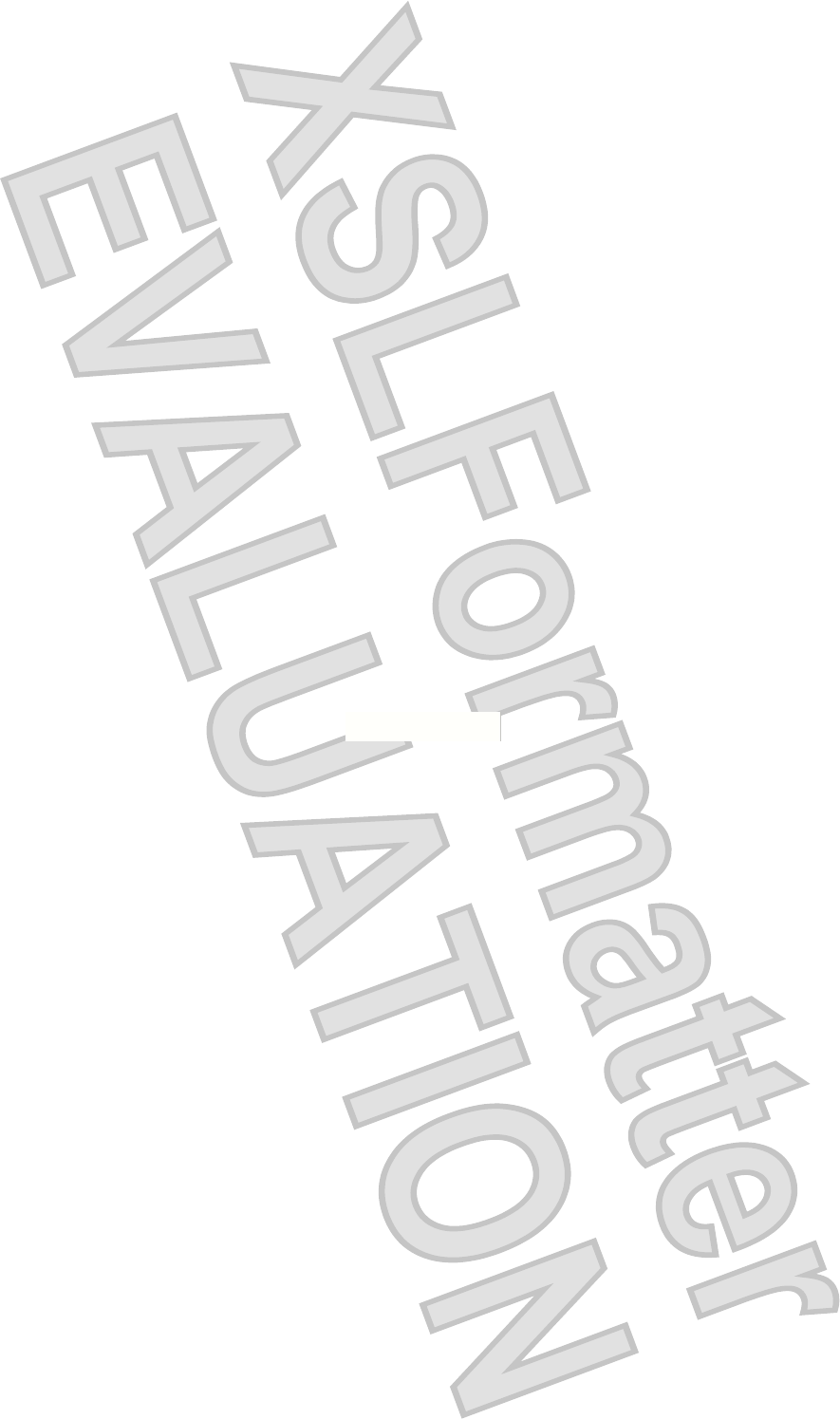
Antenna House XSL Formatter (Evaluation) http://www.antennahouse.com/